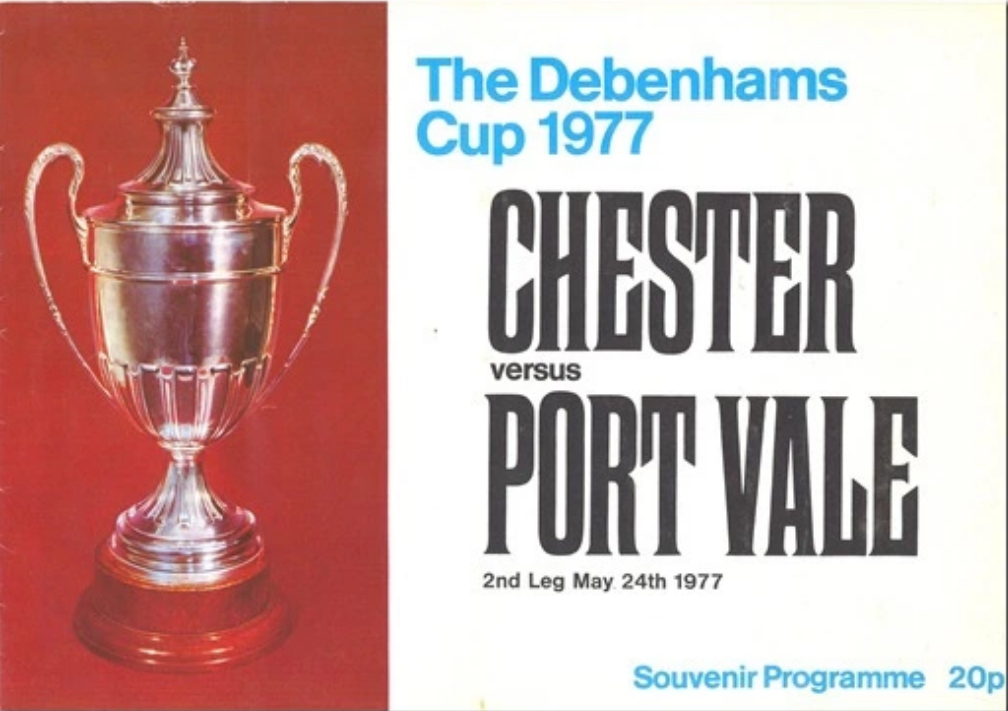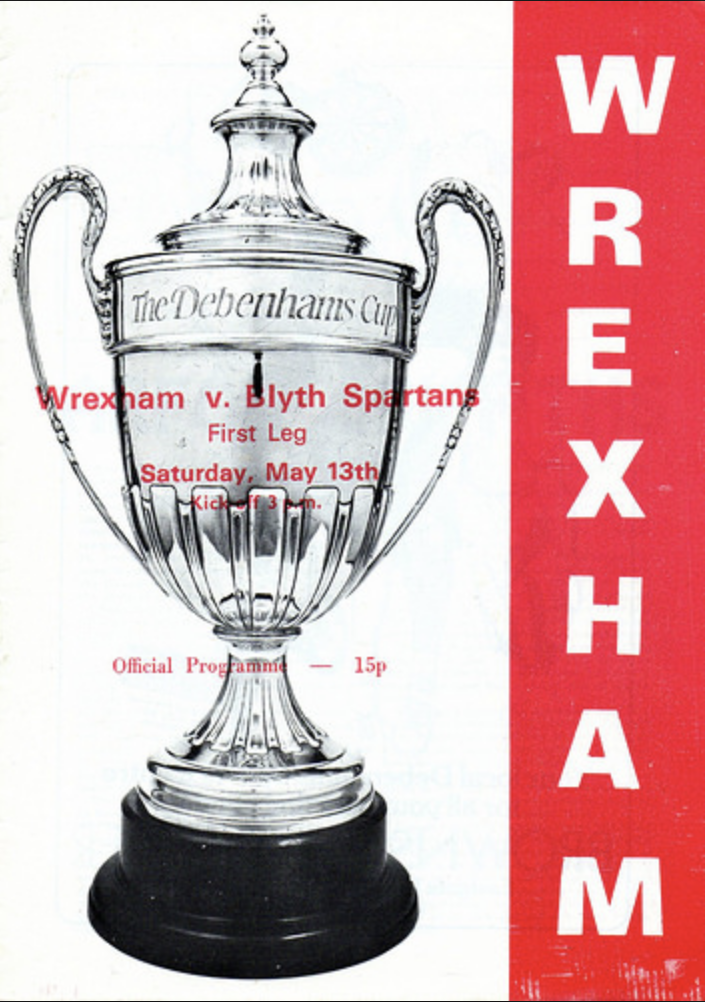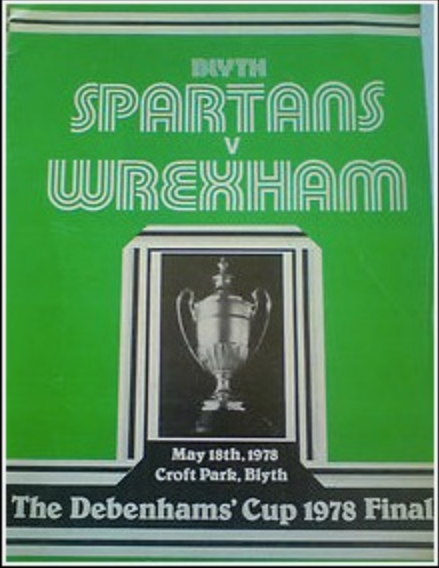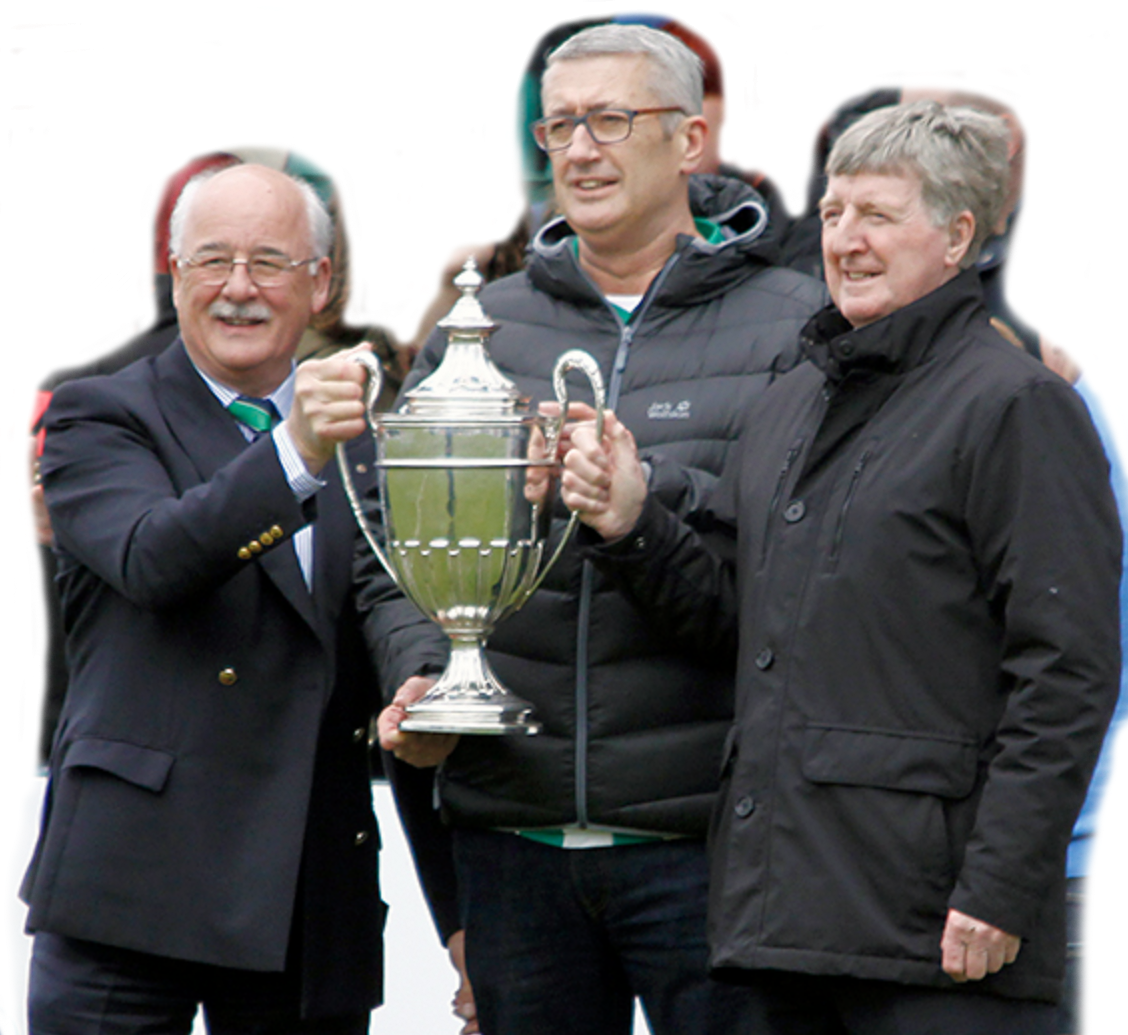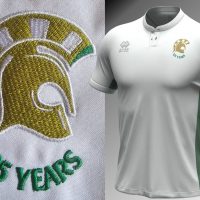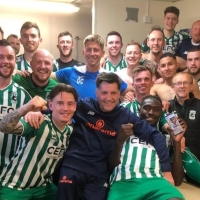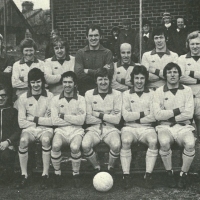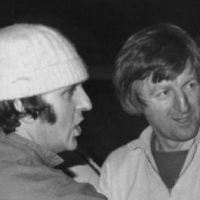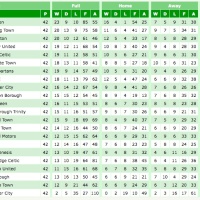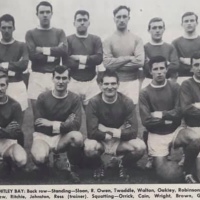This is a unique archive of all known official team photographs, line-up photos and team group images from throughout the club’s history.
Featuring rare and previously unseen images it ranges from 1901 through to the present day.
Showing the club’s fascinating shirt history, it is a pictorial record of the different styles worn through the years.
- This page is not claiming ownership or credit for any of the images that appear, it is purely an attempt to collate them in one place.
If the photographers or image owners are known they have been credited and acknowledged.
If you know whom took or owns an image and credit has been missed off please get in touch so it can be attributed.
If you know of any team photo’s/images that do not feature please get in touch so they can be added.
Also, if you know any of the missing/unknown names from the descriptions please get in touch so they can be added.
Contact – theblythspirit@hotmail.com
———–
2023/24 – L to R –
L to R –
Rhys Evans, Will McGowan, Jordan Hickey, Finn Cousin-Dawson, Elliot Forbes,
Alex Mitchell, Jack Bodenham, Nicky Deverdics, Jordan Cook, Joe Oliver, Zanda Siziba.
* Taken on Saturday 24th February 2024 before 2-2 NLN home draw with Boston Utd.
Was first game played under new ownership following takeover of club.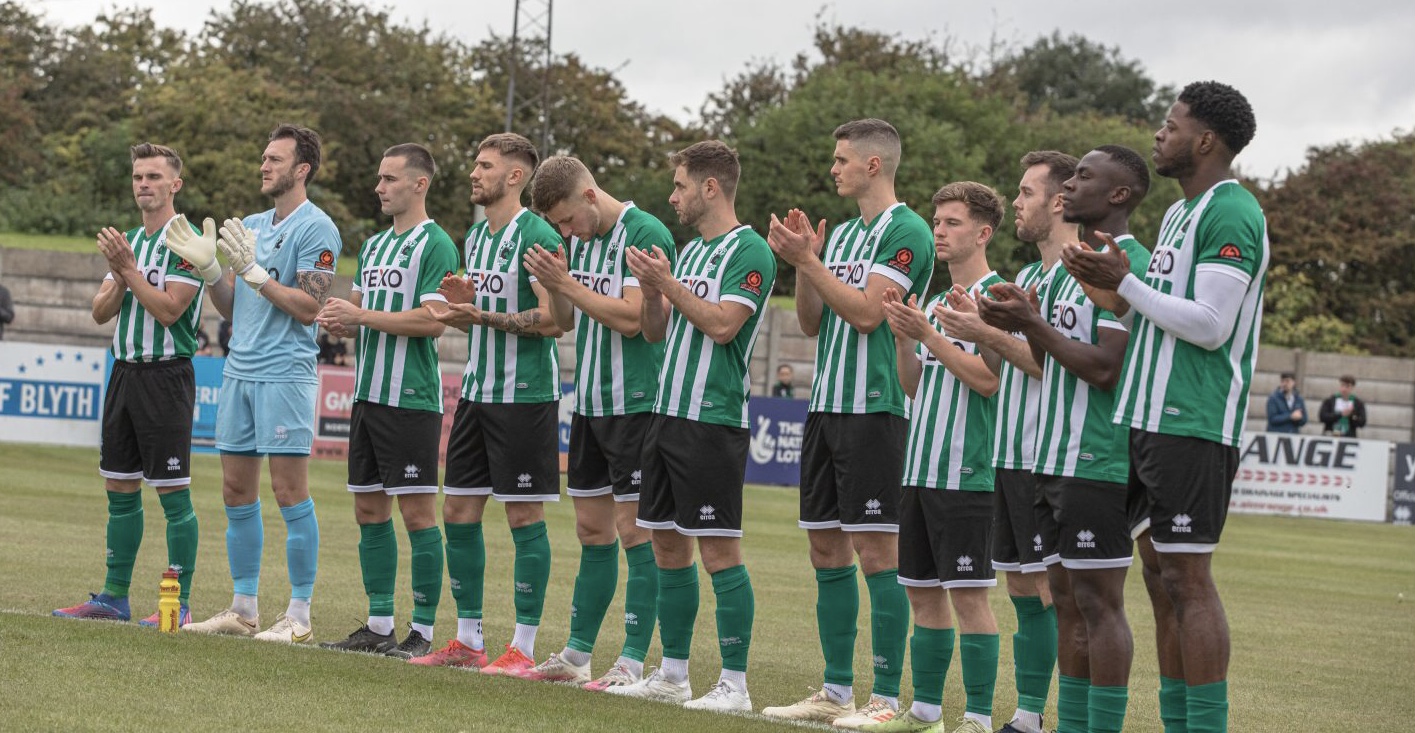
L to R –
JJ O’Donnell, Alex Mitchell, Joe Oliver, Finn Cousin-Dawson, Jack Bodenham,
Nicky Deverdics, Elliot Forbes, Will McGowan, Michael Liddle, Cedric Main, JJ Hooper.
* Taken on Saturday 23rd September 2023 before
1-3 NLN home defeat to Alfreton Town.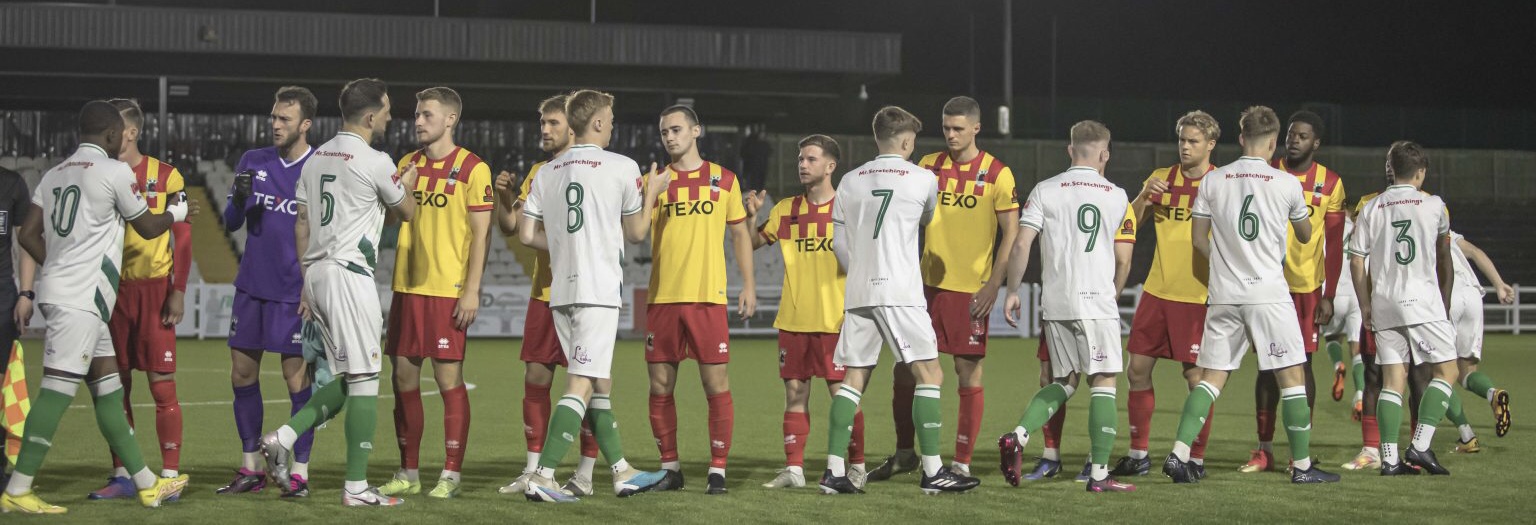
L to R –
JJ O’Donnell, Alex Mitchell, Jack Bodenham, Finn Cousin-Dawson, Joe Oliver,
Will McGowan, Elliot Forbes, Michael Liddle hidden by the No.9,
Harrison Clark, JJ Hooper.
* Taken on Monday 18th September 2023 before 3-1 FA Cup 2nd Q
Round Replay Extra Time win at Bradford (Park Avenue). L to R –
L to R –
JJ O’Donnell, Rhys Evans, Finn Cousin-Dawson, Alex Mitchell,
Will McGowan, Nicky Deverdics, Jordan Hickey, Curtis Round,
Jack Bodenham, Michael Liddle, JJ Hooper.
* Taken on Saturday 5th May 2023 before 4-2 NLN home win
over Gloucester City at Croft Park in opening game of 2023/24 season.
2022/23 –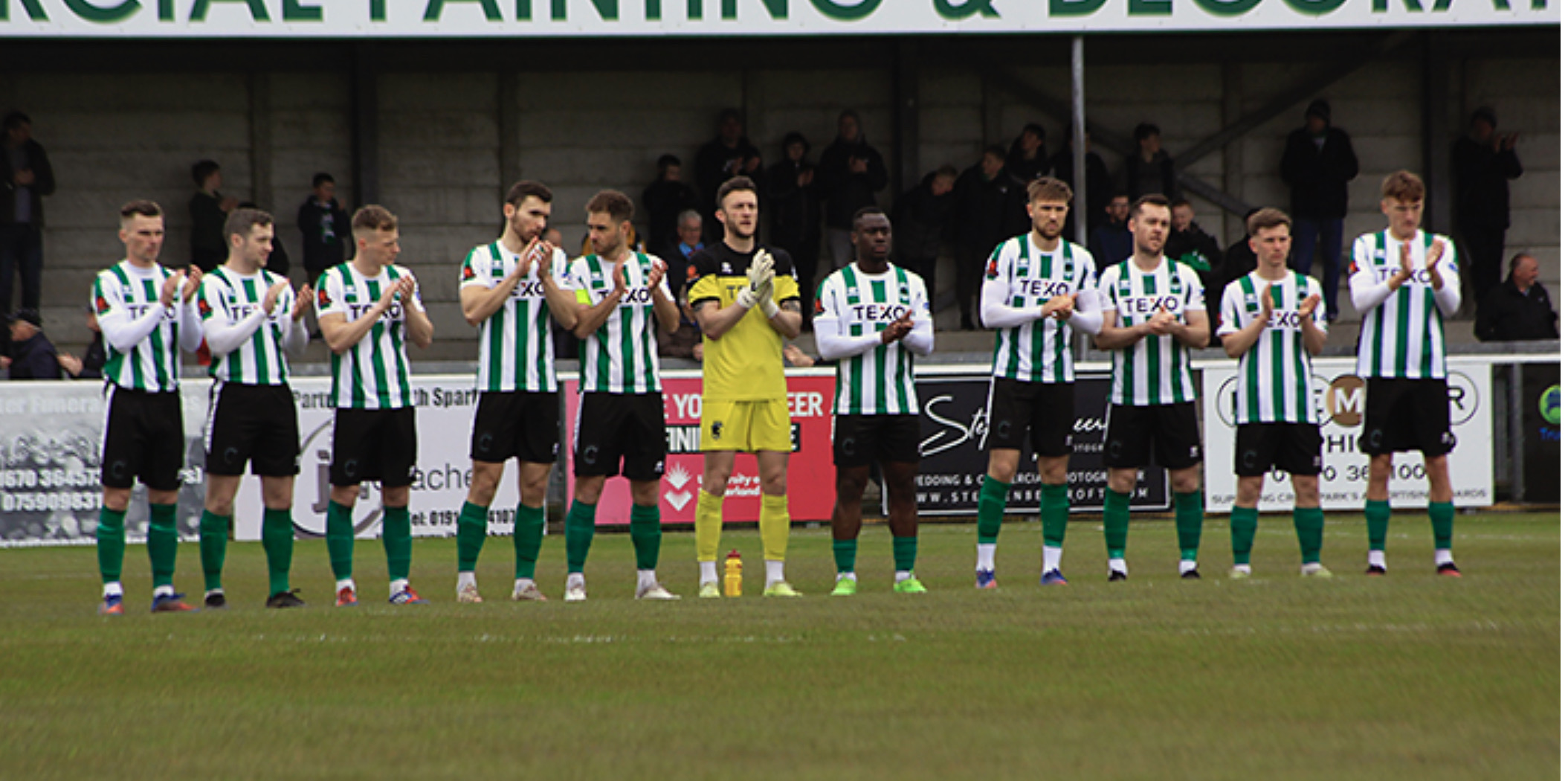
L to R –
JJ O’Donnell, Jordan Hickey, Rhys Evans, Toby Lees, Nicky Deverdics, Alex Mitchell,
Cedric Main, Finn Cousin-Dawson, Michael Liddle, Will McGowan, Michael Spellman.
* Taken on Saturday 29th May 2023 before 5-0 NLN home win
over Hereford in final to retain NLN status.
• No official team photo taken before 22/23 season so these are
only kind of team images available.
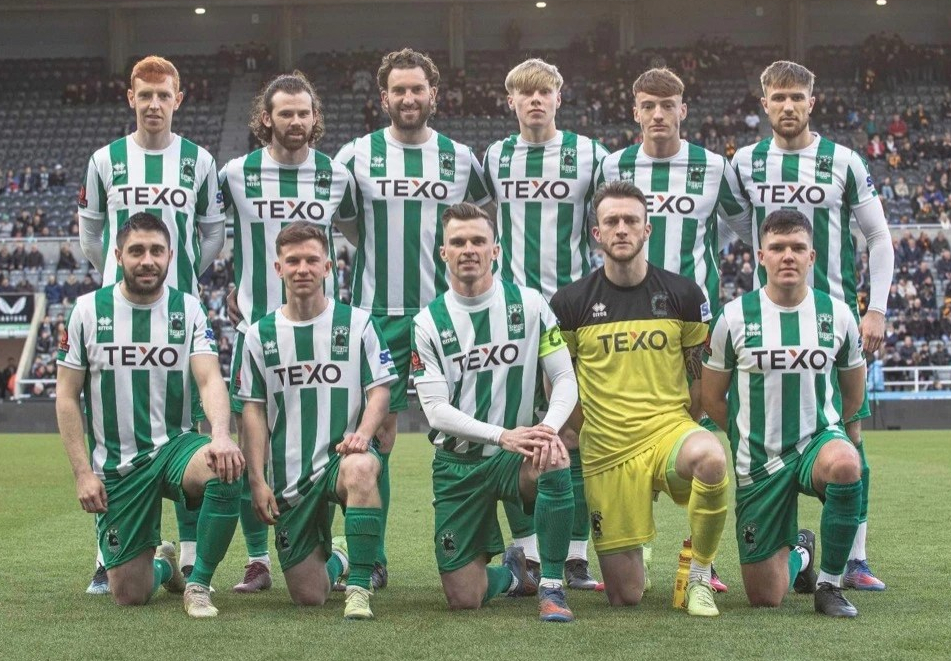
Back Row L to R –
Michael Richardson, Curtis Round, Matthew Elsdon, Jay Errington,
Michael Spellman, Finn Cousin-Dawson.
Front Row L to R –
Josh Gillies, Will McGowan, JJ O’Donnell, Alex Mitchell, Matthew Doopson.
* Taken on Tuesday 25th May 2023 before Northumberland Senior Cup Final
at St James’ Park, Newcastle, lost 0-2 to Morpeth Town.

Back Row L to R –
Will McGowan, Cedric Main, Rhys Evans, Alex Mitchell, Toby Lees,
Michael Spellman, Matthew Elsdon, Michael Liddle.
Front Row L to R –
JJ O’Donnell, Nicky Deverdics, Jordan Hickey.
* Taken on Tuesday 18th April 2023 before 2-0 NLN away win at Farsley Celtic.
• Only team photo with that seasons away kit, (organised by JJ O’Donnell to
show support to 4 year old Arthur Hoult who is suffering from Leukaemia).
L to R –
JJ O’Donnell partially hidden by macth official, Will McGowan, Rhys Evans,
Finn Cousin-Dawson, Alex Mitchell, Matthew Elsdon, Jordan Hickey,
Nicky Deverdics, Curtis Round, Troy Chiabi, Cedric Main.
*Taken on Saturday 25h March 2023 before 0-2 NLN defeat
by Chester at Croft Park.
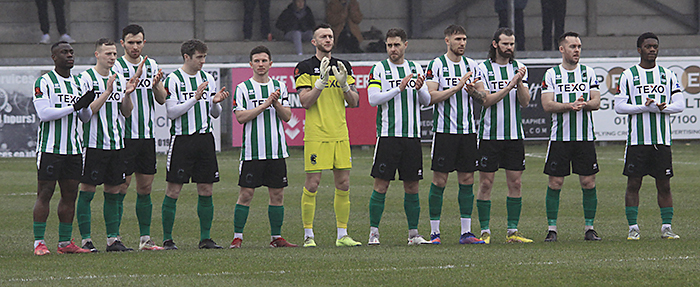 L to R –
L to R –
Cedric Main, Rhys Evans, Tony Lees, Jordan Hickey, Alex Mitchell, Nicky Deverdics,
Finn Cousin-Dawson, Curtis Round, Michel Liddle Troy Chiabi.
*Taken on Saturday 18th February 2023 before 1-0 NLN win
over Kettering Town at Croft Park.
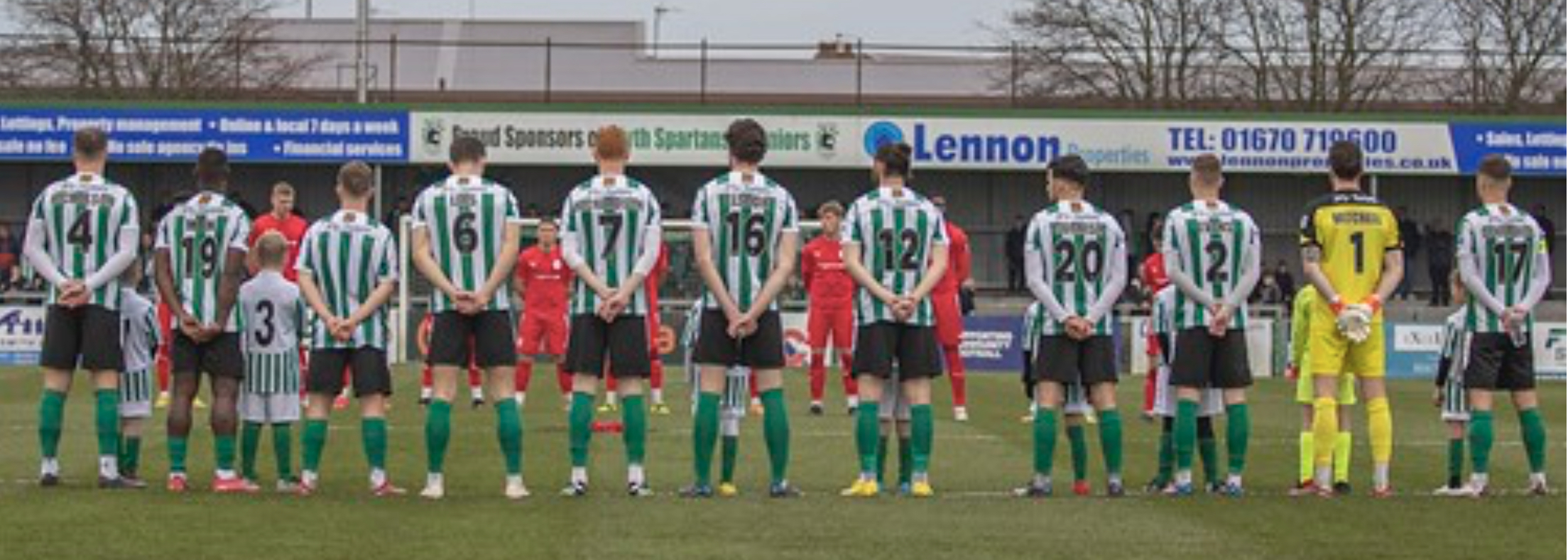 L to R –
L to R –
Alex Nicholson, Cedric Main, Will McGowan, Toby Lees, Michael Richardson,
Matthew Elsdon, Curtis Round, Matt Cornish, Rhys Evans, Alex Mitchell, Nicky Deverdics.
* Taken on Saturday 5th November 2022 before 3-0 NLN
home win over AFC Telford United.
• A rather unusual team photo taken by club photographer Paul Scott
as players marked Remembrance Day with minute silence
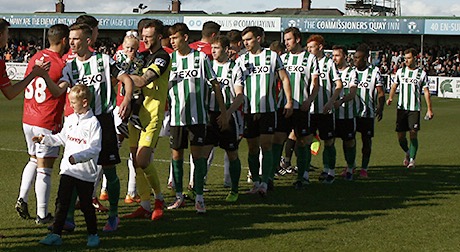 L to R –
L to R –
JJ O’Donnell, Alex Mitchell, Liam Ravenhill, Jordan Hickey, Toby Lees, Matthew Elsdon,
Michael Richardson, Michael Liddle, Cedric Main, Nicky Deverdics.
*Taken on Saturday 18th October 2022 before 1-1 FA Cup 4th Qualifying Round
draw with Wrexham at Croft Park.
October 2022 – L to R –
L to R –
Ian Mutrie, Rob Carney, Steve ‘Jos’ Jones, Terry Day, Keith Houghton, Brian Slane,
John ‘Eddie’ Alder, Dave Varty, Mick Dagless, Ron Guthrie.
* Taken on Saturday 18th October 2022 before FA Cup 4th Qualifying Round
tie with Wrexham at Croft Park.
• The players from 77/78 cup run were guests of honour at the game
45 years after club last faced Wrexham in that famous cup run.
L to R –
Alex Nicholson, Michel Richardson, Jordan Hickey, Lewis McNall,
JJ O’Donnell, Nathan Buddle, Nickey Deverdics, Alex Mitchell,
Matthew Elsdon, Danny Barlow Michael Liddle.
*Taken on Saturday 17th September 2022 before FA Cup 2nd Qualifying Round
2-0 win over Guiseley at Croft Park.
2021/22 –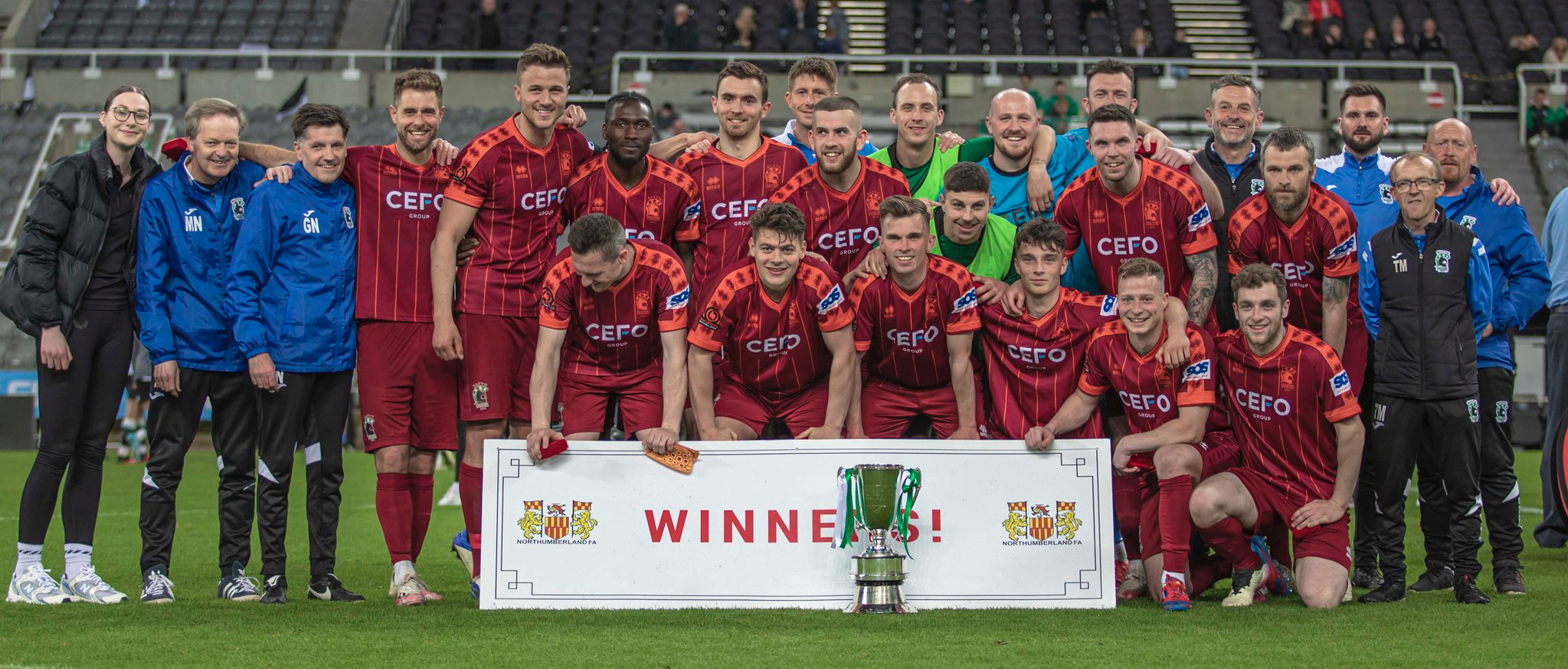 Back Row L to R –
Back Row L to R –
Holly ???, Sports Nutritionist, Jeff Young Fixture Secretary, Gary Neasham Physio,
Nicky Deverdics, Nathan Buddle, Sado Dajlo, Toby Lees,
Greame Coulson Assistant Manager, Patrick Almond, Sean Reid, Alex Curran,
Alex Mitchell behind Connor Thomson, Ian Aitken Goalkeeper Coach, Robbie Dale,
Rob Wark Physio, Terry Mitchell Manager, Peter Henderson Groundsman/Kitman.
Front Row L to R –
Dan Maguire, Lewis McNall, JJ O’Donnell, Jordan Watson, Corey McKeown,
Rhys Evans, Jordan Hickey.
* Taken on Thursday 5th May 2022 before 3-2 Northumberland Senior Cup Final
win over Newcastle United Under 23’s at St James’ Park.
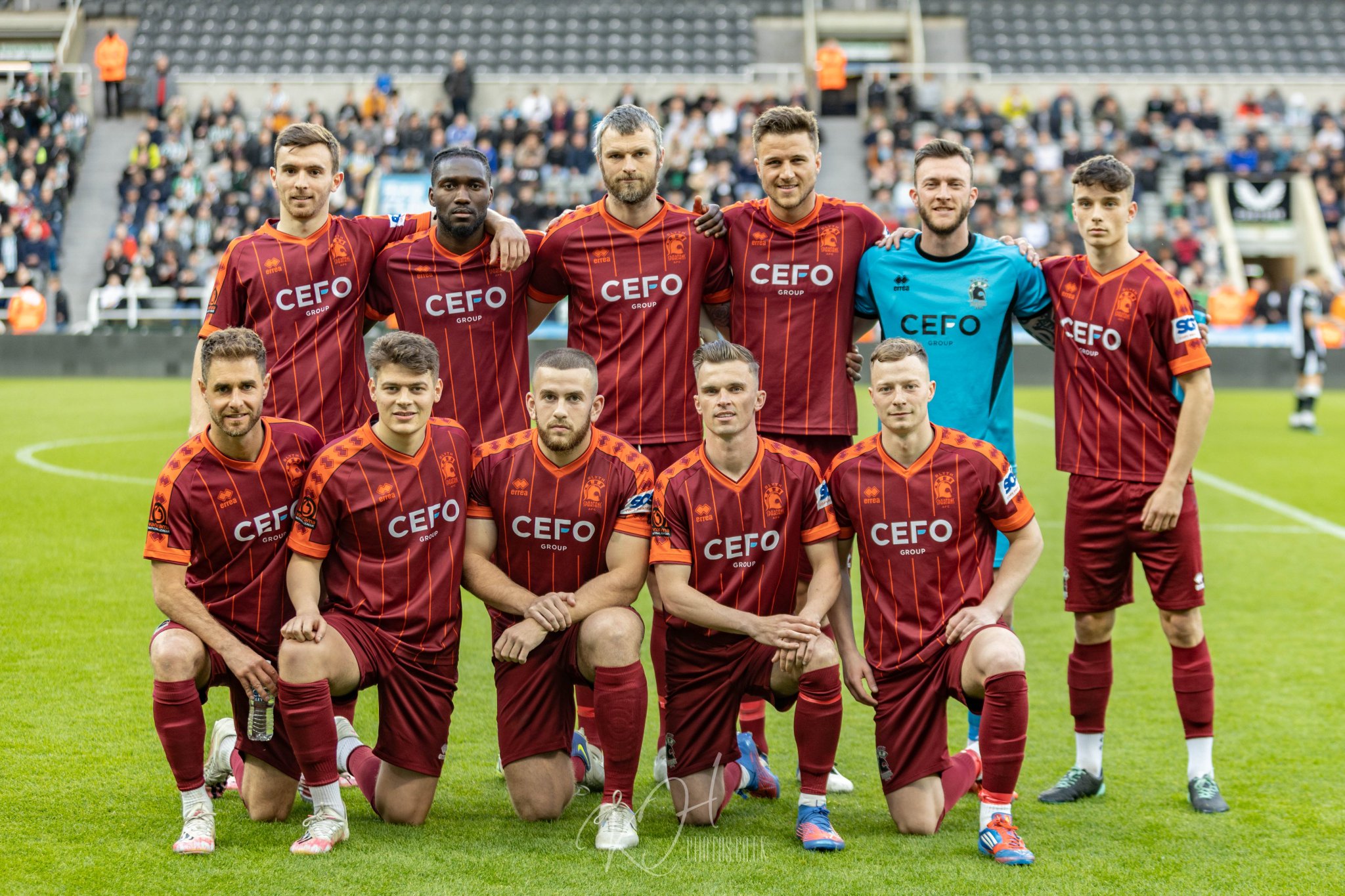 Back Row L to R –
Back Row L to R –
Toby Lees, Sado Dajlo, Robbie Dale, Nathan Buddle, Alex Mitchell, Corey McKeown.
Front Row L to R –
Nicky Deverdics, Lewis McNall, Patrick Almond, JJ O’Donnell, Rhys Evans.
* Taken on Thursday 5th May 2022 before Northumberland Senior Cup Final
at St James’ Park, Newcastle.
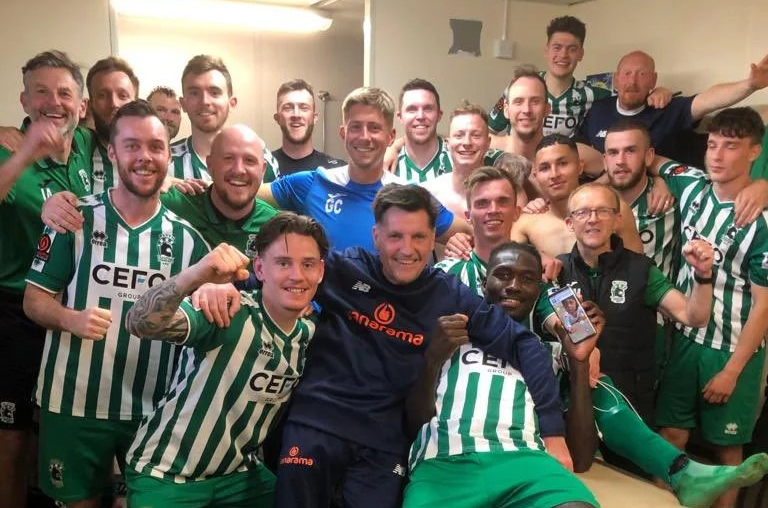
Back Row L to R –
Ian Aitken Goalkeeper coach, Josh Robson, Michael Liddle,
Robbie Dale partially hidden at back, Toby Lees, Alex Curran,
Alex Mitchell, Greame Coulson Assistant Manager,
Connor Thomson, Rhys Evans, JJ O’Donnell, Sean Reid, Angelo Cappello,
Lewis McNall right at back, Terry Mitchell Manager,
Peter Henderson Kitman at back with McNall,
Paddy Almond in front of Henderson, Corey McKeown.
Front Row L to R –
Danny Barlow, Gary Neasham Physio, Sado Dajlo.
* Taken on Saturday 30th April 2022 in changing room at
Brackley Town following 1-0 win that ensured NLN safety.
 L to R –
L to R –
Nathan Buddle, Alex Mitchell, Lewis McNall, Jordan Hickey, Corey McKeown,
Jordan Watson, Toby Lees, Michael Liddle, Dom Tear, Nicky Deverdics, JJ O’Donnell.
* Taken on Saturday 6th November 2021 before 0-2 NLN home defeat to Leamington.
• No official team photo taken before season started.
2019/20 –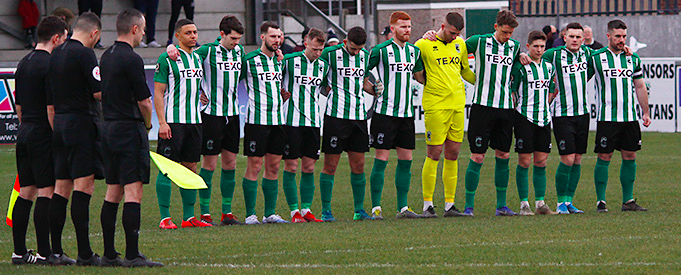
L to R –
Leighton McIntosh, Aaron Cunningham, Lewis Hawkins, Rhys Evans, Jack Hunter,
Tom Devitt, Zak Hemming, Kris Thackeray, Olly Scott,
Macauley Langstaff, Damon Mullen.
* Taken on Saturday 15th February 2020 before 0-3 NLN
home defeat to Altrincham.
• Was the final home game played before National League
suspended all football due to COVID-19.

L to R –
Callum Roberts, Jack Hunter, Jack Sanders, Scott Wilson, Kris Thackeray, Rhys Evans,
Lewis Hawkins, Michael Sweet, Damon Mullen, Zak Hemming, Robbie Dale.
* Taken on Tuesday 7th January 2020 before 1-3 NLN
defeat at Altrincham.
• Only known team image wearing that season’s all blue away kit.
 L to R –
L to R –
Callum Roberts, Jack Hunter, Lewis Ritson, Olly Scott, Anthony Callaghan, Lewis Hunter,
Michael Sweet, Mark Foden, Damon Mullen.
* Taken at Saturday 21st September 2019 before 4-4 FA Cup 2nd Qualifying Round
draw at Curzon Ashton.
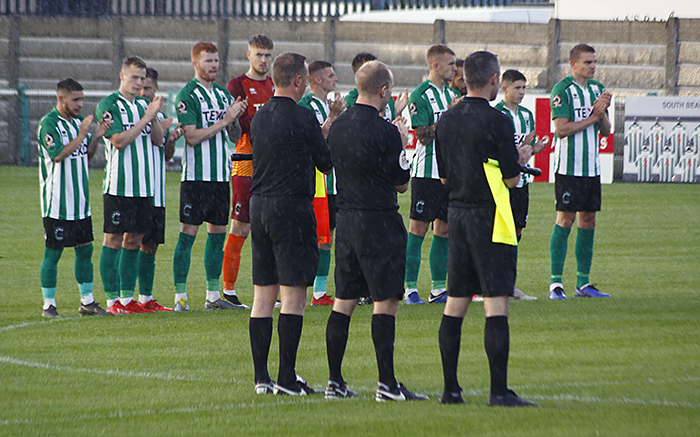
L to R –
Adam Wrightson, Rhys Evans, Jake Orrell, Tom Devitt, Nathan Harker,
Craig Spooner between match officials, Joe Robson hidden behidn referee, Dale Pearson,
Anthony Callaghan hidden by linsemans, Olly Scott, Ryan Hutchinson.
* Taken at Tuesday 13th August 2019 before 0-0 home NLN
defeat to York City.
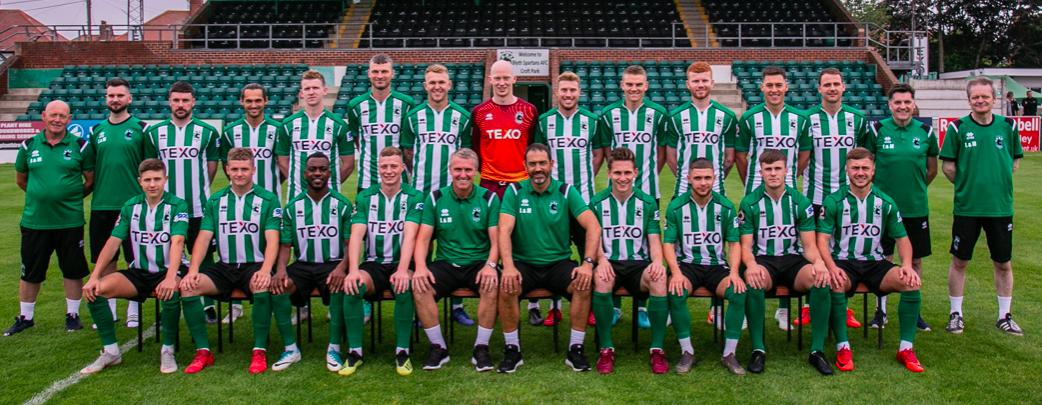 Back Row L to R –
Back Row L to R –
Peter Henderson Groundsman, Rob Wark Physio, Damon Mullen, Anthony Callaghan,
Josh Neary, Robbie Dale, Dale Pearson, Mark Foden, Michael Sweet,
Ryan Hutchinson, Tom Devitt, Scott Fenwick, Lewis Horner,
Gary Neasham Physio, Jeff Young Fixture Secretary/Kitman.
Front Row L to R –
Olly Scott, Craig Spooner, Ursene Mouanda, Rhys Evans, Lee Clark Manager,
Paul Stephenson Assistant Manager, Jack Butler, Adam Wrightson,
Joe Robson, Jake Orrell.
* Taken before start of 2019/20 NLN season.
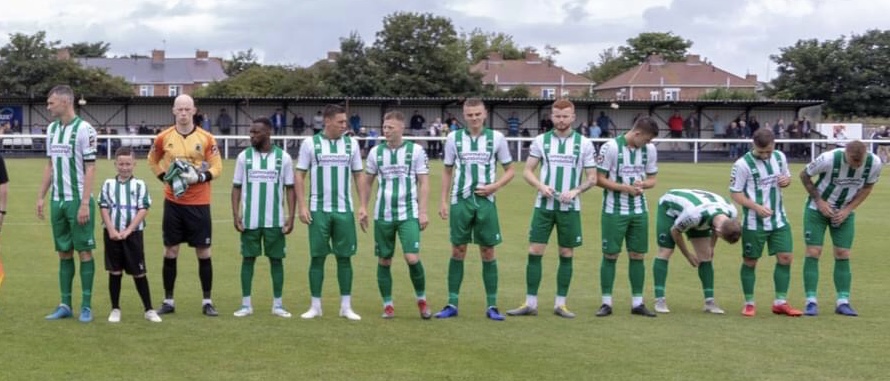 L to R –
L to R –
Robbie Dale, Mark Foden, Ursene Mounada, Scott Fenwick, Rhys Evans,
Ryan Hutchinson, Tom Devitt, Joe Robson, Josh Neary, Jake Orrell, Michael Sweet.
* Taken on Saturday 20th July 2019 at Ashington before 3-0 pre season friendly win.
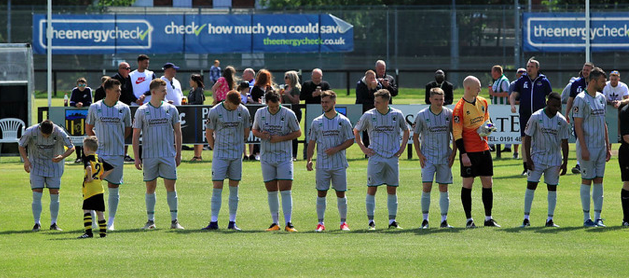
L to R –
Unknown Player, Scott Fenwick, Josh Neary, Tom Devitt, Lewis Horner, Jake Orrell,
Rhys Evans, Unknown Player, Mark Foden, Ursene Mouanada, Robbie Dale.
* Taken on Saturday 6th July 2019 at Hebburn Town before 2-1 pre season friendly win.
2018/19 –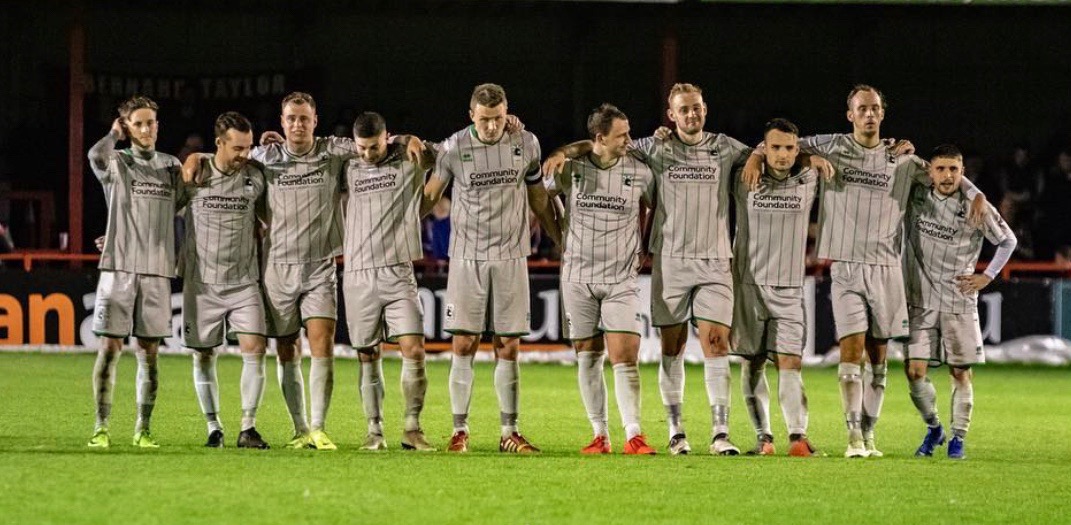
L to R –
Jarrett Rivers, Michael Liddle, Alex Nicholson, Jordan Watson, Nathan Buddle,
Lewis Horner, Louis Lang, David Atkinson, Sean Reid, Adam Wrightson.
Peter Jameson missing as he was facing a penalty.
* Taken on Wednesday 1st May 2019 during NLN Play Off Qualifier at Altrincham,
drew 2-2 but lost 6-7 on penalties AET.
• No official team photo taken before season started.
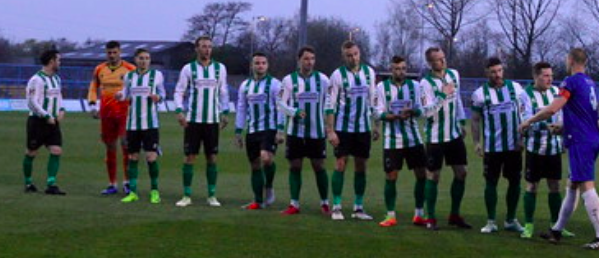
L to R –
Michael Liddle, Peter Jameson, Sean Reid, David Atkinson, Lewis Horner, Louis Lang,
Jamie Holmes, Kieran Green, Damon Mullen, Dan Maguire.
* Taken on Monday 1st April 2019 before 3-1 NLN win away at Curzon Ashton.
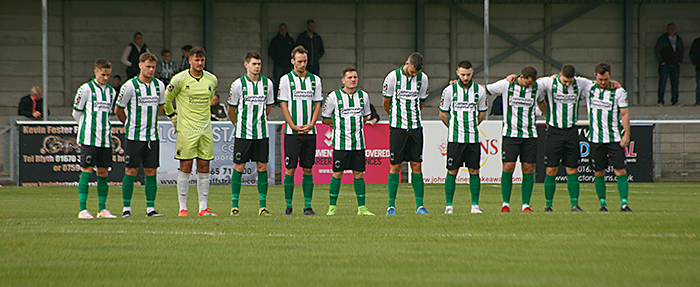
L to R –
Jarrett Rivers, Alex Nicholson, Peter Jameson, Aaron Cunningham, Sean Reid,
Dan Maguire, Robbie Dale, Bradley Fewster, Lewis Horner,
Jordan Watson, Micheal Liddle.
* Taken on Saturday 15th September 2018 before 0-2 NLN home defeat to Leamington.
2017/18 –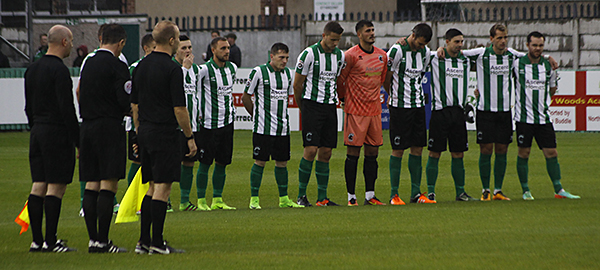 L to R –
L to R –
Ryan Hutchinson & Jarrett Rivers partially hidden by match officials, Macauley Langstaff,
Dale Hopson, Dan Maguire, Nathan Buddle, Ryan Hutchinson, Peter Jameson,
Robbie Dale, Jordan Watson, Lewis Horner, Michael Liddle.
* Taken on Tuesday 8th August 2017 before 0-2 NLN home
defeat to York City.
*No official team photo taken before season started.
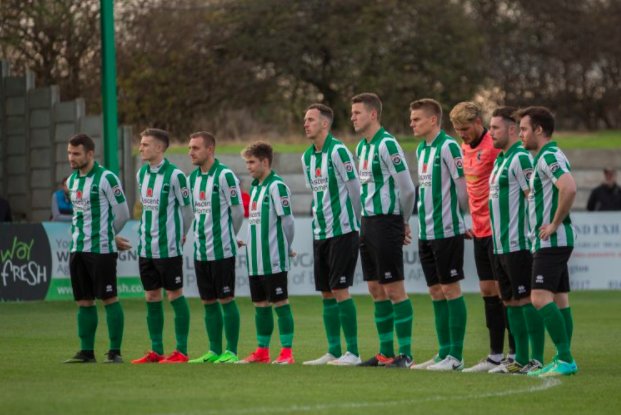 L to R –
L to R –
David Atkinson & Jarrett Rivers, Dale Hopson, Adam Wrightson,
Sean Reid, Nathan Buddle, Ryan Hutchinson, Peter Jameson,
Damon Mullen, Michael Liddle.
* Taken on Saturday 11th November 2017 during minutes silence to mark
Remembrance Day, before 1-0 NLN home game win over Leamington.
• No official team photo taken before season started.
2016/17 – Back Row L to R –
Back Row L to R –
Michael Liddle, David Atkinson, Richard Pell, Sean Reid, Andrew Cartwright in front of
Luke Armstrong, Robbie Dale with NPL Trophy, Doug Ramsey Volunteer, Jordan Laidler,
Dan Maguire with Senior Cup, Adam McHugh,
Jarrett Rivers, Matty Pattison, Ruan Hutchinsin, Dave McTiernan, Stephen Turnbull,
Alan Courtney supporter, Nathan Buddle.
Front Row L to R –
Paul Woolston, Jordan Watson, Adam Wrightson wearing cap, Damon Mullen.
* Taken on Friday 28th April 2017 at Croft Park Social Club at end of season
Presentation Night. Robbie Dale has NPL Championship trophy
and Dan Maguire has Northumberland Senior Cup.
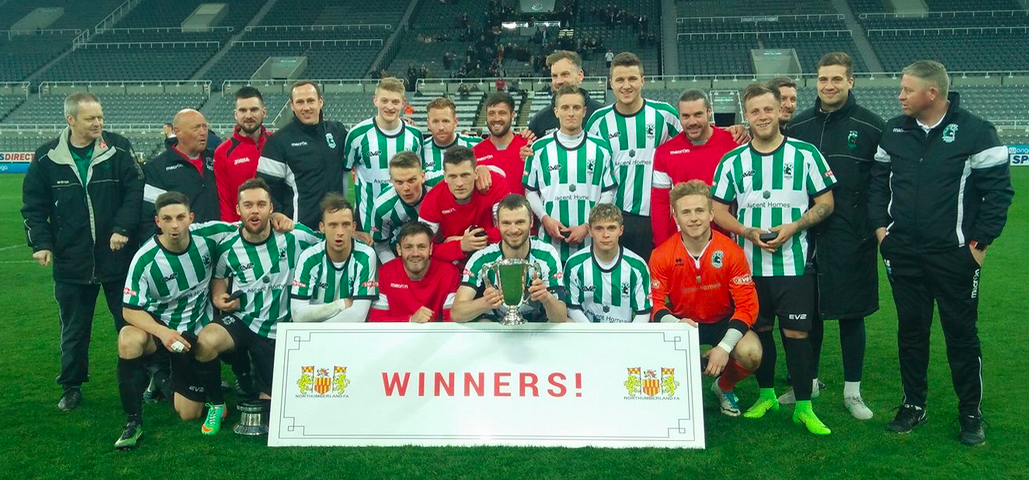 Back Row L to R –
Back Row L to R –
Jeff Young Kitman, Peter Henderson Groundsman, Rob Wark Physio,
Neal Hooks Assistant Manager, Luke Armstrong, Matty Pattison, Dave McTiernan,
Richard Pell behind Jarrett Rivers, Nathan Buddle, Damon Mullen, Jordan Lailder,
Darren Holloway Assistant Manager partially hidden,
Adam McHugh, Alun Armstrong Manager.
Front Row L to R –
Jordan Watson Micheal Liddle, Sean Reid, Ryan Hutchinson & Dan Maguire behind
Andrew Cartwright, Robbie Dale, Adam Wrightson, Paul Woolston.
* Taken on Wednesday 26th April 2017 at St James’ Park following
3-2 Northumberland Senior Cup Final win.

Back Row L to R –
Darren Holloway Assistant Manager, Nathan Buddle, Neal Hooks Assistant Manager,
Michael Liddle, Paul Woolston, Adam McHugh, Richard Pell, Matty Pattison, Sean Reid,
Luke Armstrong, Jarrett Rivers, Jordan Laidler, Andrew Cartwright,
Rob Wark Physio, Chris Bell Player/Physio, Dave McTiernan, Alun Armstrong Manager.
Front Row L to R –
David Atkinson, Jordan Watson, Damon Mullen, Ryan Hutchinson, Robbie Dale,
Dan Maguire, Adam Wrightson.
* Taken on Saturday 22nd April 2017 following final NPL game of season with
Champions trophy presented after 5-1 win at Croft Park.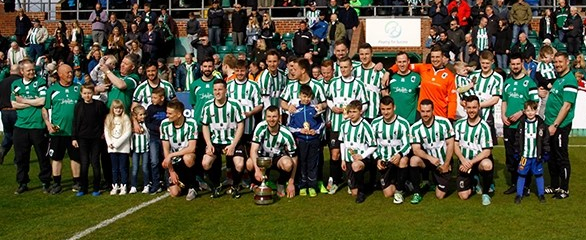
• This image of players and management with their families was taken facing the main stand.
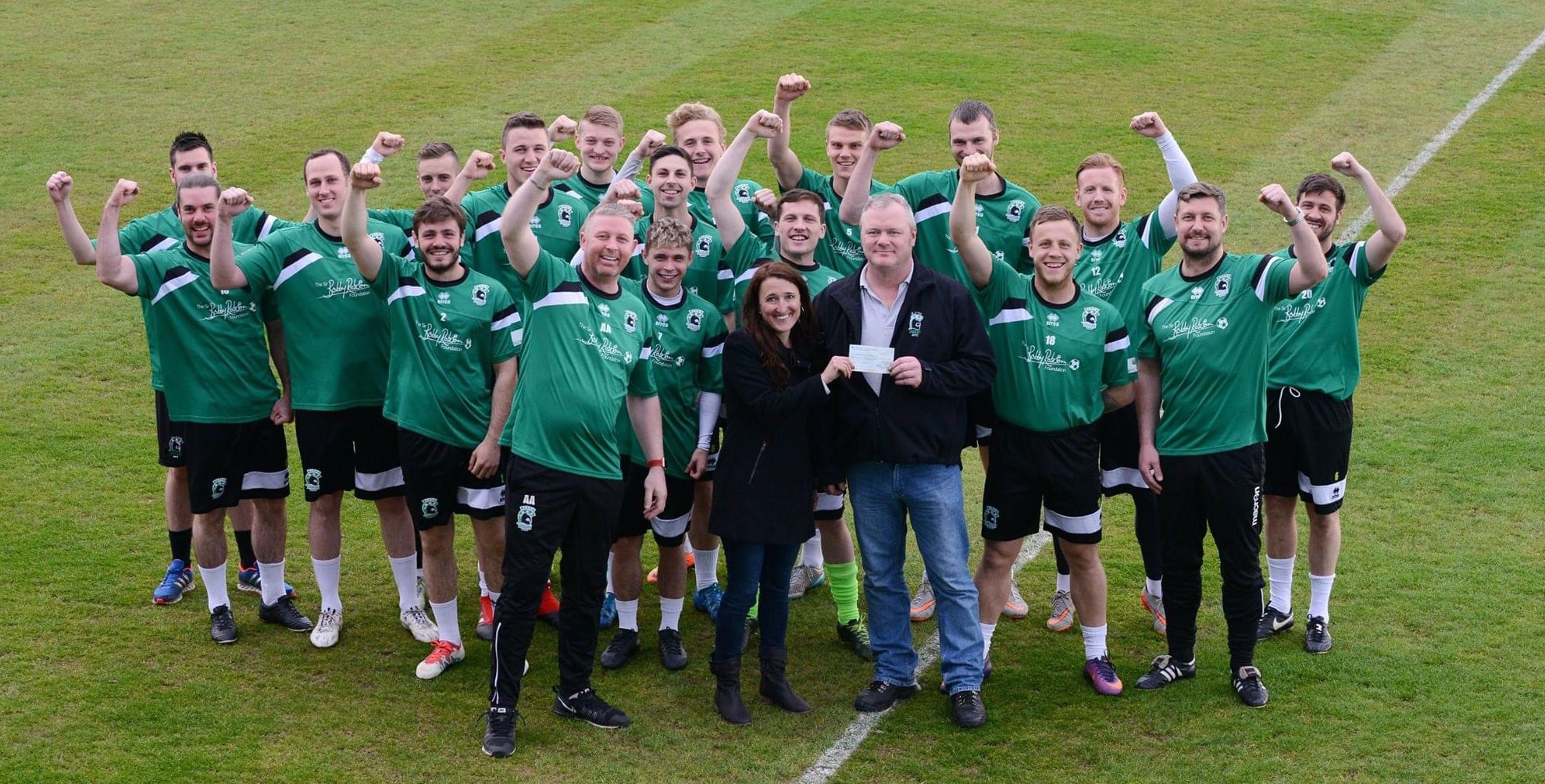 L to R –
L to R –
Rob Wark Physio behind Damon Mullen, Neal Hooks Assistant Manager/Player,
Jarrett Rivers behind Andrew Cartwright, Nathan Buddle, Luke Armstrong,
Adam Wrightson in front of Jordan Watson then Paul Wolston behind him,
Dan Maguire, Ryan Hutchinson, Robbie Dale,
Jordan Laidler, Matty Pattison,
Darren Holloway Assistant Manager, Dave McTiernan.
Alun Armstrong Manager at front.
* Taken on Thursday 20th April 2017 at Croft Park prior to training session.
John Parker of the Supporters Club presented Liz Luff of the
Sir Bobby Robson Foundation a cheque from the sale of the clubs
training tops (being worn in photo) that supported the Foundation.
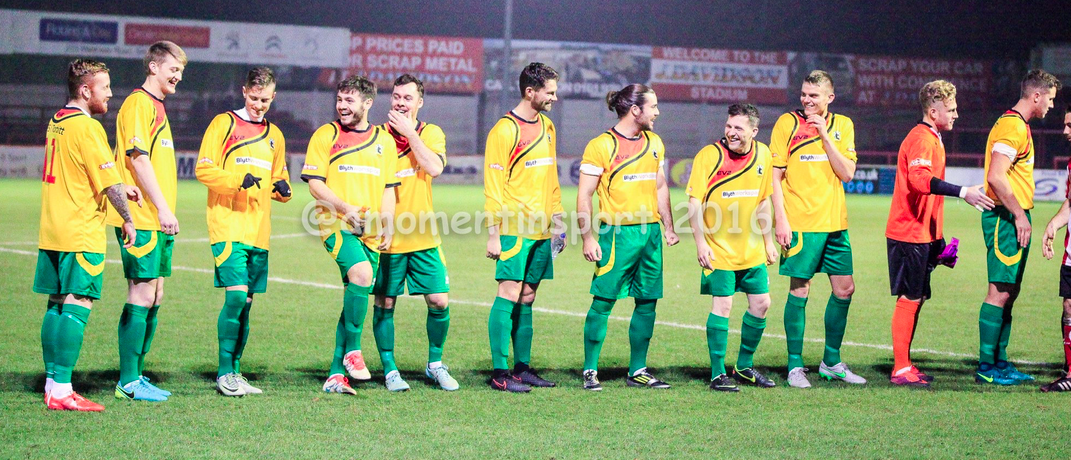 L to R –
L to R –
Matthew Pattison, Luke Armstrong, Jarrett Rivers, Andrew Cartwright, Michael Liddle,
Matthew Wade, Damon Mullen, Dan Maguire, Ryan Hutchinson,
Paul Woolston, Nathan Buddle.
* Taken on Tuesday 6th December 2016 before rearranged FA Trophy
3rd Qualifying Round tie at Altrincham.
• Only team photo that exists of that away top which was
worn with previous seasons away shorts
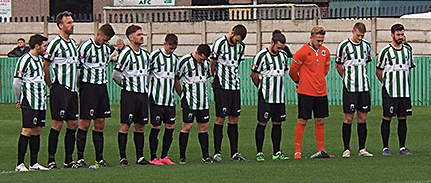 L to R –
L to R –
Andrew Cartwright, Richard Pell, Nathan Buddle, Stephen Turnbull, Jarrett Rivers,
Dan Maguire, Damon Mullen, Paul Woolston, Luke Armstrong, Chris Bell.
* Taken on Saturday 12th November 2016 at Croft Park before 4-3 FA Trophy
2nd Qualifying Round win over Halesowen Town as player pay their
respects in minutes silence for Remembrance Day.
2015/16 –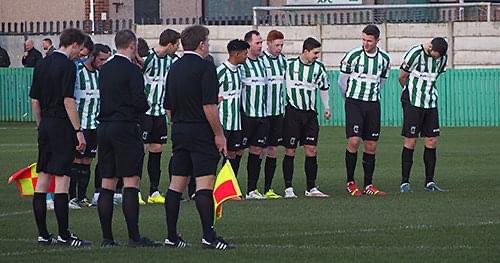 L to R –
L to R –
Adam McHugh partially hidden by linesman, Damon Mullen, Dillon Morse hidden by referee,
Arran Wearmouth, Matthew Wade hidden by linesman, Wilson Kneeshaw, Neal Hooks,
Micahel Richardson, Jordan watson, Nathan Buddle, Robbie Dale.
* Taken on Saturday 30th January 2016 at Croft Park before
1-0 NPL win over Grantham Town. Back Row L to R –
Back Row L to R –
Chris Bell Player/Physio, Ryan Hutchinson, Stuart Bramley, Danny Parker, Neal Hooks,
Arran Wearmouth, Fabien Otto, Nick Thomson, Adam McHugh, Robbie Dale, Sean Reid,
Matthew Wade, Michael Richardson, Tom McNamee, Barry Davidson Physio.
Front Row L to R –
Georgi Kostadinov Fitness Coach, Peter Henderson Groundsman, Paul Robinson,
Dillon Morse, Andrew Cartwright, Dan Maguire, Lee Picton Assistant Manager,
Tom Wade Manager, Damon Mullen, Stephen Turnbull, Jordan Watson,
Alex Nicholson, Jeff Young Fixture Secretary/Kitman, Prince Monga.
* Taken before start of 2015/16 Northern Premier League season,
trophy is Northumberland Senior Cup won in 2014/15
2014/15 –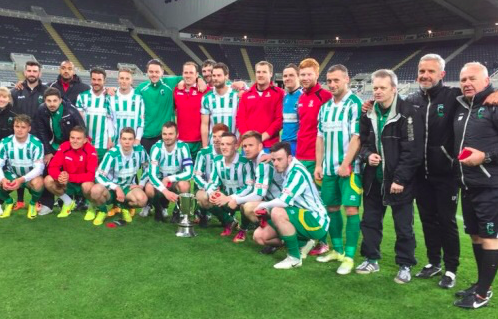 Back Row L to R –
Back Row L to R –
Chris Bell Player/Physio, Ash Davies, Damon Mullen, Jarrett Rivers,
Stuart Bramley, Neal Hooks, Danny Parker, Matthew Wade, Peter Jeffries,
Nick Thomson, Ryan Cummings, Dan Hawkins,
Jeff Young Kitman, Lee Picton Assistant Manager, Tom Wade Manager.
Front Row L to R –
Alex Nicholson, Jordan Watson (leaning forward), Ryan Hutchinson, Arran Wearmouth,
Robbie Dale, Michael Richardson, Dan Maguire, Stephen Turnbull, Craig Lynch.
* Taken on Monday 27th April 2015 at St James’ Park following
Northumberland Senior Cup Final 2-0 win over Morpeth Town.
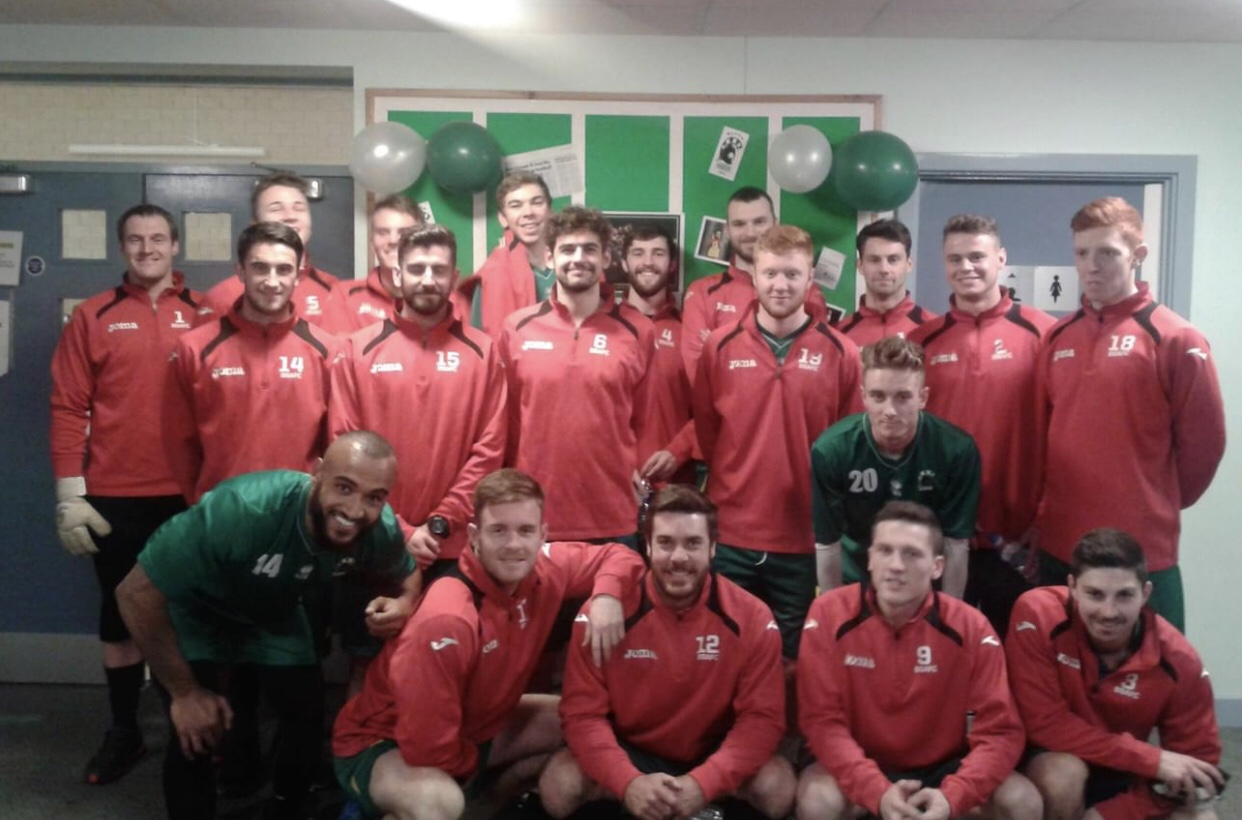
Back Row L to R –
Peter Jeffries, Nathan Buddle, Ryan Hutchinson, Arran Wearmouth,
Danny Parker, Robbie Dale Matthew Wade.
Middle Row L to R –
Unknown Bulgarian Trialist, Chris Bell, Joel Dixon, Ryan Cummings,
Jarrett Rivers leaning forward, Alex Nicholson, Michael Richardson.
Front Row L to R –
Ash Davies, Stephen Turnbull, Damon Mullen, Dan Maguire, Jordan Watson.
* Taken on Monday 29th December 2014 at training session ahead of
FA Cup 3rd Round home tie with Birmingham City in Saturday 3rd January 2015.
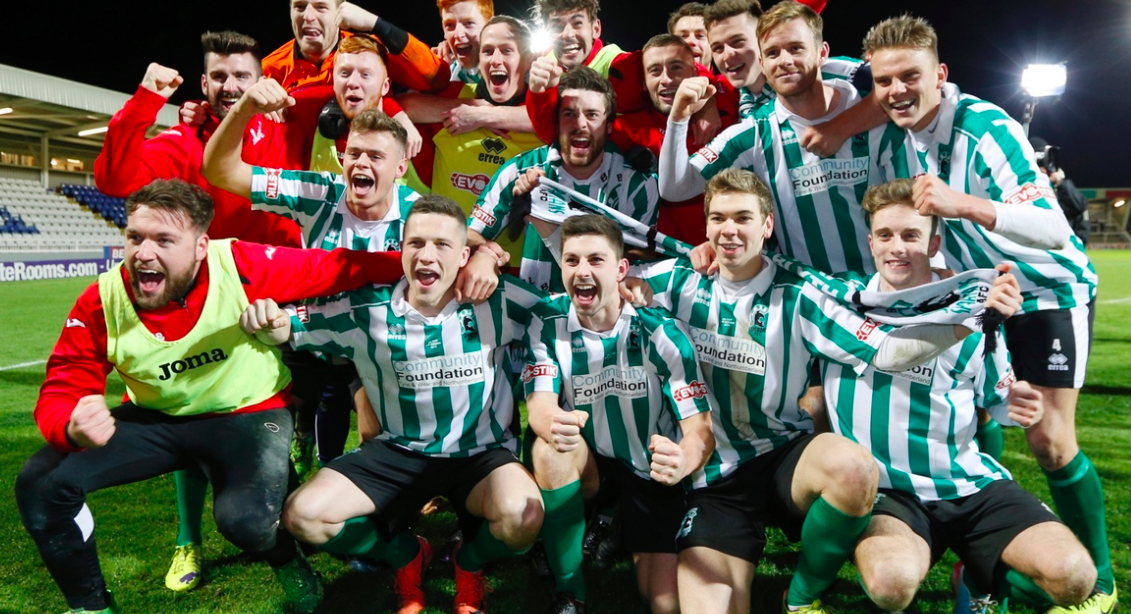
Back Row L to R –
Chris Bell Player/Physio, Peter Jeffries, Ryan Cummings, Michael Richardson,
Neal Hooks, Joel Dixon with Damon Mullen below him, Dan Hawkins,
Matthew Wade, Nathan Buddle, Stephen Turnbull, Ryan Hutchinson.
Front Row L to R –
Niall Harrison, Alex Nicholson, Dan Maguire, Jordan Watson,
Arran Wearmouth, Jarrett Rivers.
* Taken on Friday 3rd December 2014 following 2-1 win at Hartlepool United in
FA Cup 2nd Round. Game shown live on BBC One’s Match of the Day that night.
• Below version includes Alan Shearer who was MOTD pundit being interviewed live.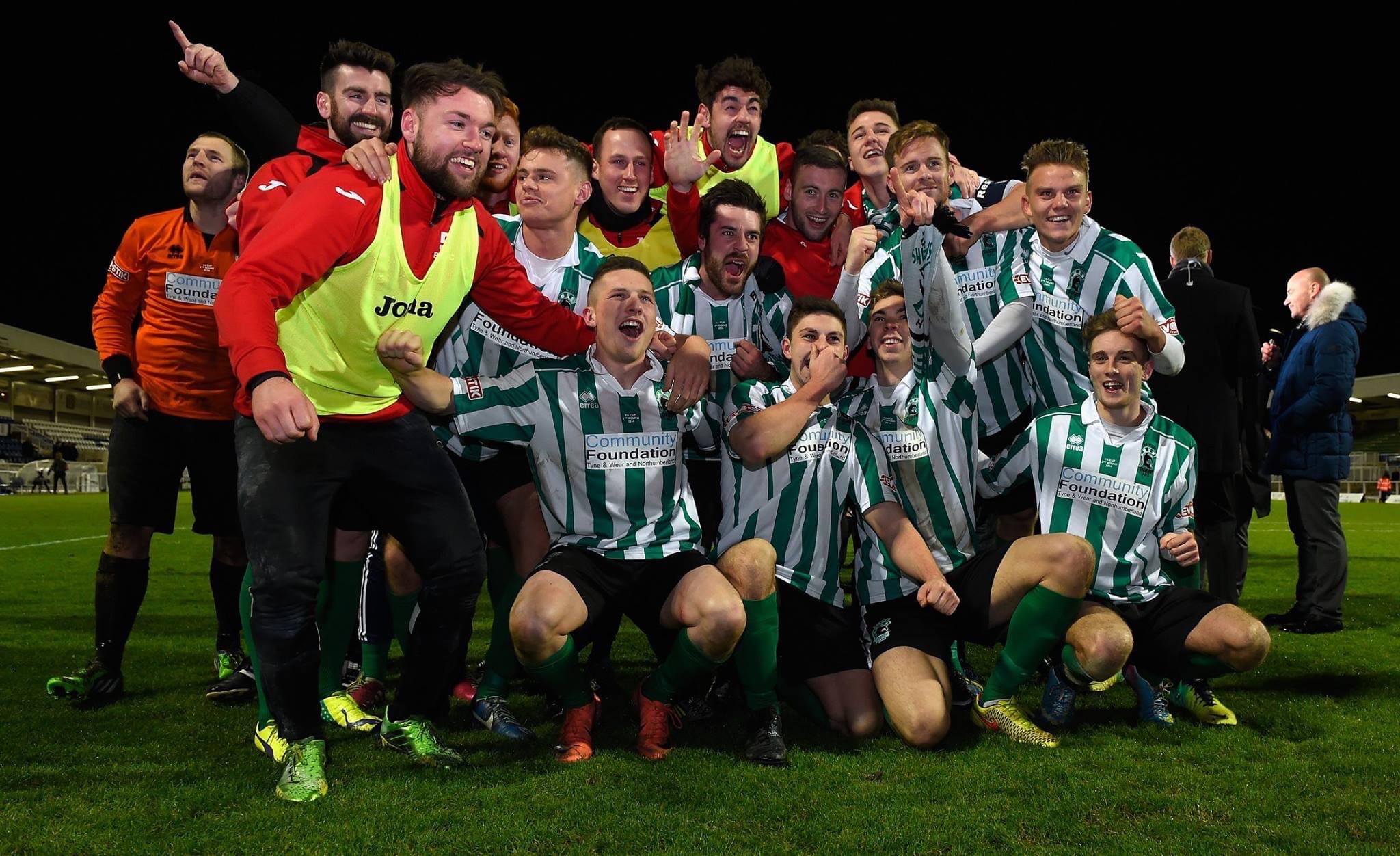
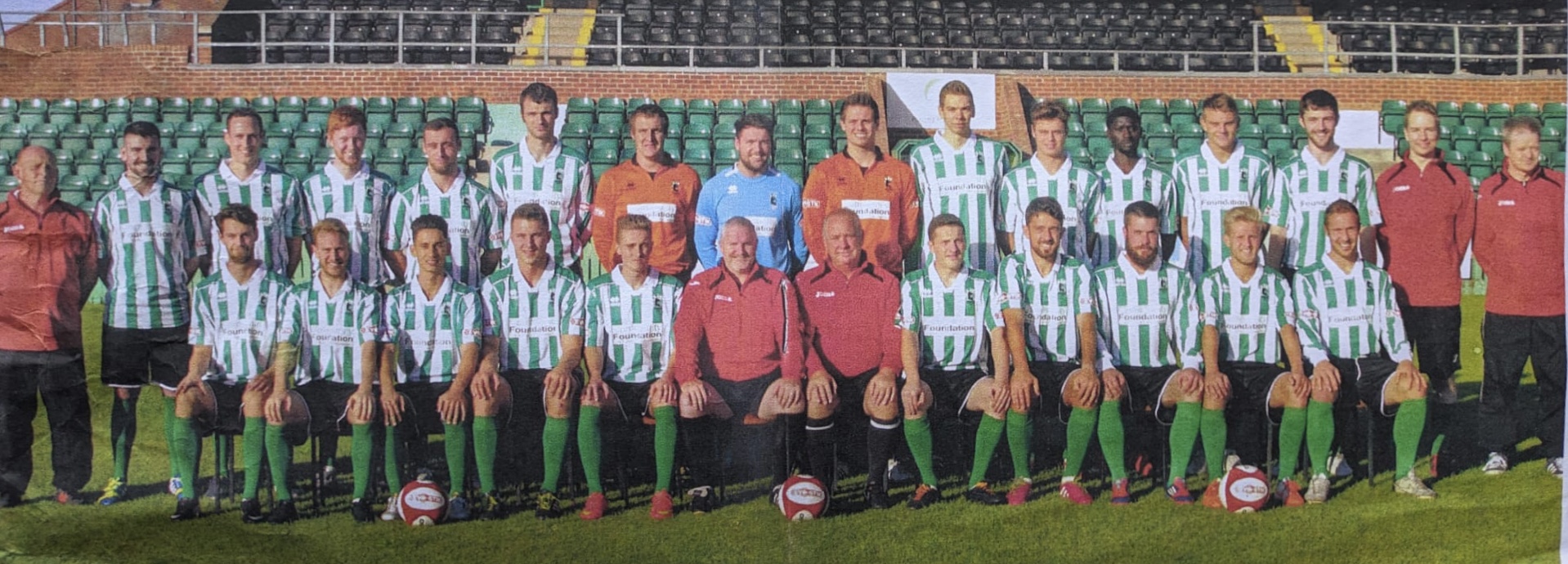
Back Row L to R –
Peter Henderson Groundsman/Kitman, Chris Bell, Neal Hooks,
Ryan Cummings, Dan Hawkins, Robbie Dale, Peter Jeffries,
Naill Harrison, OF Connor Grant, Arran Wearmouth, Alex Nicholson,
Prince Monga, Ryan Hutchinson, Danny Parker
Jeff Young Kitman/ Match Secretary, Brian Davison Physio.
Front Row L to R –
Matthew Wade, Ian Watson, Sammy Perez, Nathan Buddle, Jarrett Rivers,
Colin Myers Assistant Manager, Tom Wade Manager, Dan Maguire,
Paul Robinson, Damon Mullen, Ben Sayer, Chris Moore.
* Taken before start of 2014/15 Northern Premier League season.
• Below version was a parody of the Ashley Cole AS Roma team photo
that made news at the time and was copied by loads of clubs.
Ian Watson took up role of Ashley Cole looking in on team photo.
2013/14 –
L to R –
Lewis Horner, Nathan Buddle, Danny Parker, Connor Grant, Dan Maguire,
Matthew Wade, Arran Wearmouth, Paul Fairclough FA Team Manager.
* Taken on Tuesday 25th March 2014 at Bishop Auckland,
• Not a Blyth teams as such but of the 7 Blyth players who were selected
for a FA XI representative side to play a Northern League XI
to mark the finale of the league’s 125th anniversary celebrations.
2012/13 –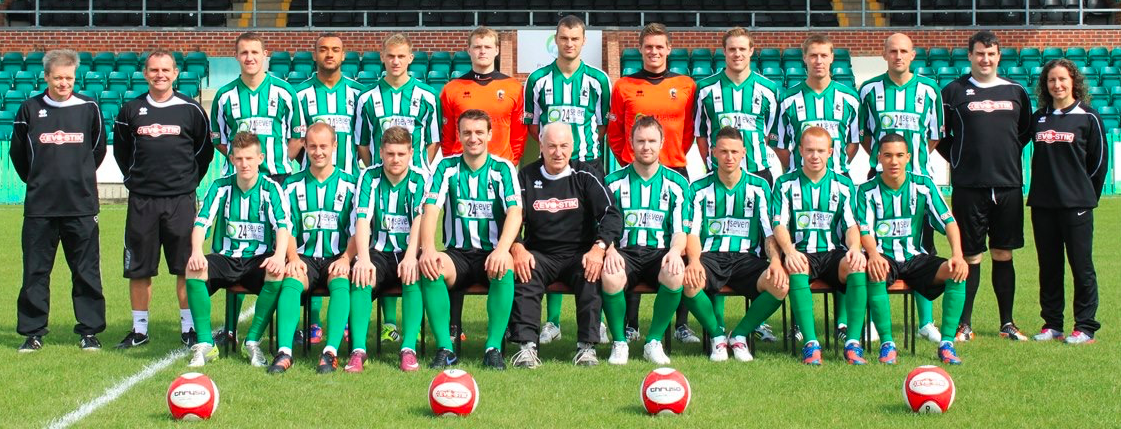 Back Row L to R –
Back Row L to R –
Jeff Young Kitman, Paddy Atkinson Assistant Manager, Jordan Mellish, Ash Davies,
Matty Crook, Robbie Dale, Connor Grant, Scott Blanford, Carl Jones, Craig Farrell,
Carl King Goalkeeper Coach, Susan Coates Physio.
Front Row L to R –
Jake Turnbull, Shaun Vipond, Lee Mason, Wayne Buchanan, Tommy Cassidy Manager,
Joe Kendrick, Phil Airey, Shaun Utterson, Tom Berg.
* Taken before start of 2012/12 Northern Premier League season.
May 2012 –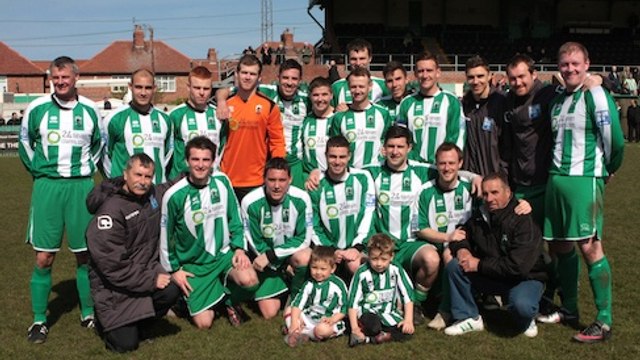
Back Row L to R –
Richie Bond, Adrian Webster, Robert Birdsall, Peter Snowden, Martin Peace,
Craig Price with Robbie Dale behind him, Andrew Leeson, Chris McCabe,
Alex Gildea, Dale Crawford, Richard Forster.
Front Row L to R –
Harry Dunn Manager, Ged Dalton, Jamie McGlen, Shaun Reay,
Gareth Williams, Andrew Wright, Tony Kennedy Kitman.
Mascots unknown.
* Taken 6th May 2008 after a Scott Bell Benefit match between Blyth Spartans XI
and a Bedlington Terriers XI, which saw ex-Spartans turning out for both sides
to support Scott and help to raise money for the Scott Bell MND fund.
2011/12 –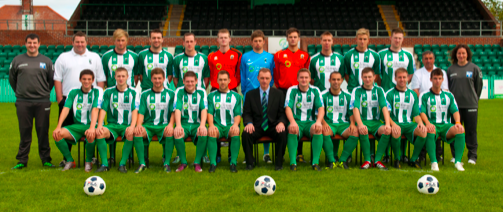 Back Row L to R –
Back Row L to R –
Carl King Goalkeeper coach, Gavin Fell Assistant Manager, Liam Atkin,
Wayne Buchanan, Neal Hooks, Matty Crook, Max Johnson, Matt Hunter,
Carl Jones, Glen Taylor, Dave Coulson, Susan Coates Physio.
Front Row L to R –
Dan Groves, Michael Pearson, Dylan Purvis, Lee Mason,
Chris Emms, Steve Cuggy Manager, Graeme Armstrong, Wayne Phillips,
Richie Slaughter, Phil Bannister, Phil Cave.
* Taken before start of 2011/12 Conference North season.
• This clearer version appeared in the match day programme at start of the season.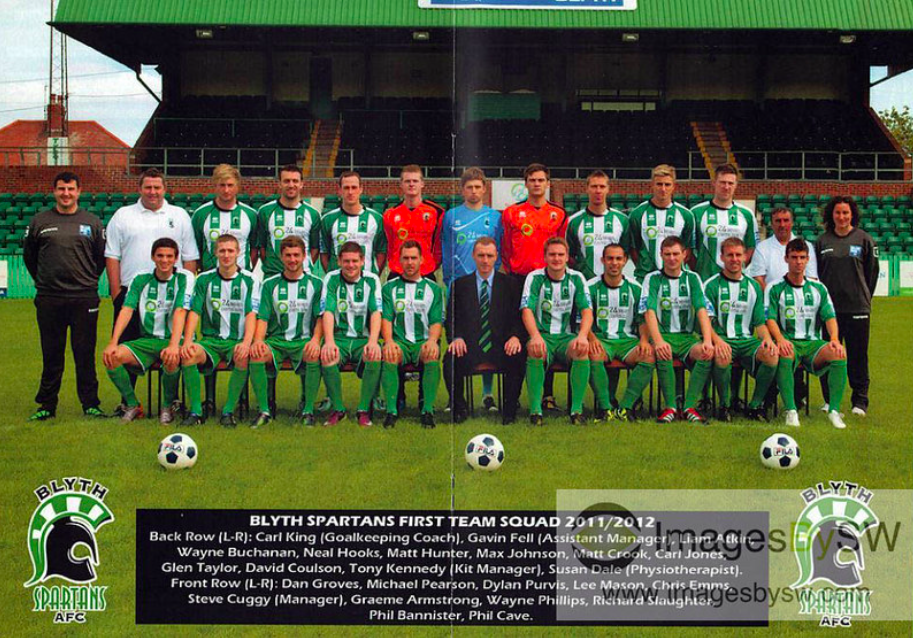
2010/11 –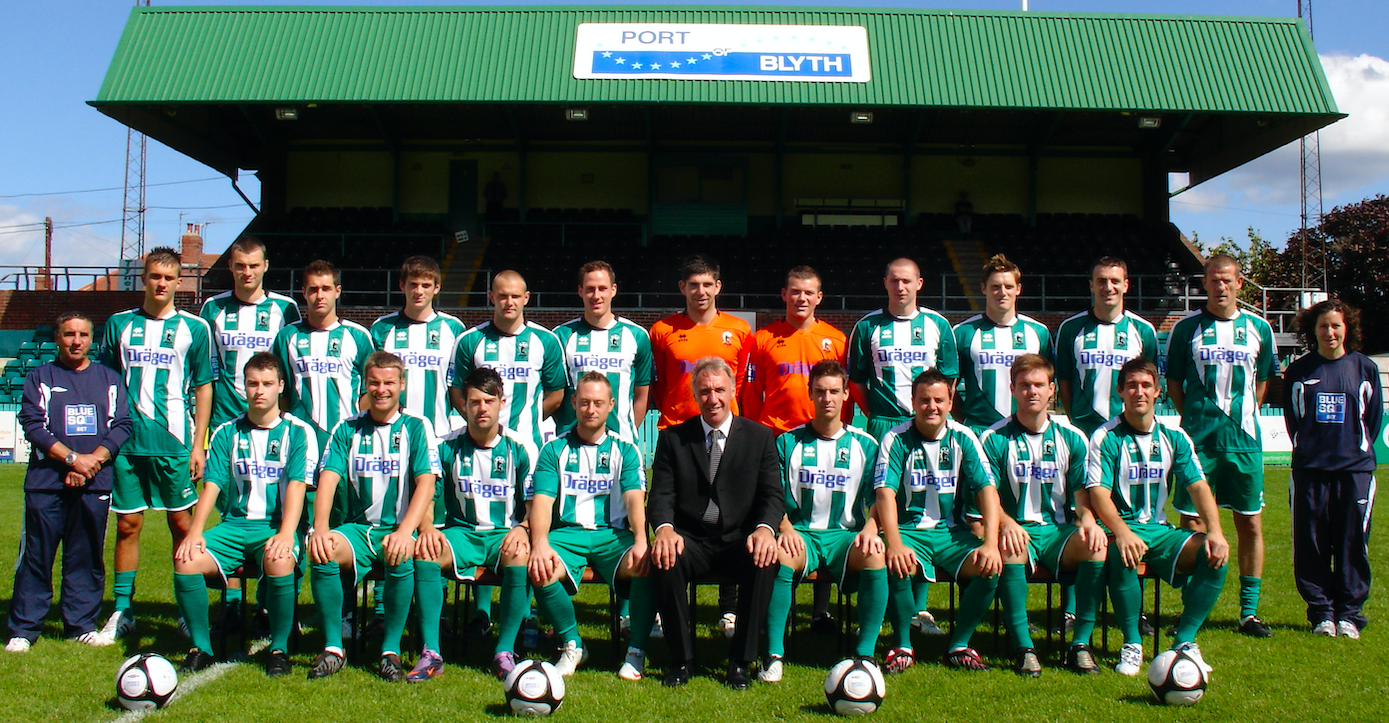 Back Row L to R –
Back Row L to R –
Tony Kennedy Kitman, Michael Simm, Robbie Dale, Nicky Deverdics, Danny Groves,
John Alexander, Neal Hooks, Jake Cunningham, Sam Grievson,
Callum Morris, Calvin Smith, Wayne Buchanan,
Chris Swailes Player/Assistant Manager, Susan Coates Physio.
Front Row L to R –
Eoin Ridley, Stephen Harrison, Liam O’Mahoney, Ian Graham,
Mick Tait Manager, Phil Cave, Paul Brayson, Stephen Turnbull, Michael Tait.
* Taken before start of 2010/11 Conference North season.
2009/10 – L to R –
L to R –
Darren Craddock, John Brackstone, John Alexander, Ian Graham, Neal Hooks, Robbie Dale,
Micahel Tait, Paul Brayson, Tony Kennedy Kitman, Gareth Williams, Stephen Turnbull,
Stephen Harrison, Steven Foster, Mark Bell.
*Taken in late April 2010 at end of season awards in Croft Park Social Club.
Players made a special award to long serving kit man Tony Kennedy.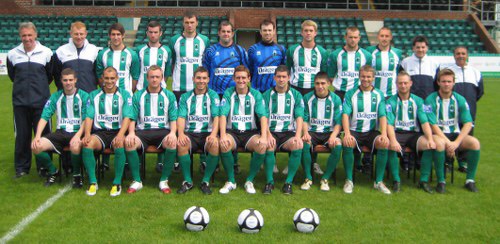 Back Row L to R –
Back Row L to R –
Mick Tait Manager, Adam Sadler Assistant Manager, Michael Tait, Simon Todd,
Robbie Dale, Mark Bell, Jack Norton, Kenny Boyle, John Alexander,
Darren Craddock, Gary Neasham Physio, Tony Kennedy Kitman.
Front Row L to R –
Shaun Reay, Adrian Webster, John Brackstone, Andrew Leeson, Chris McCabe,
Gareth Williams, Josh Gillies, Stephen Harrison, Ian Graham, Stephen Turnbull.
* Taken before start of 2009/10 Conference North season.
2008/09 –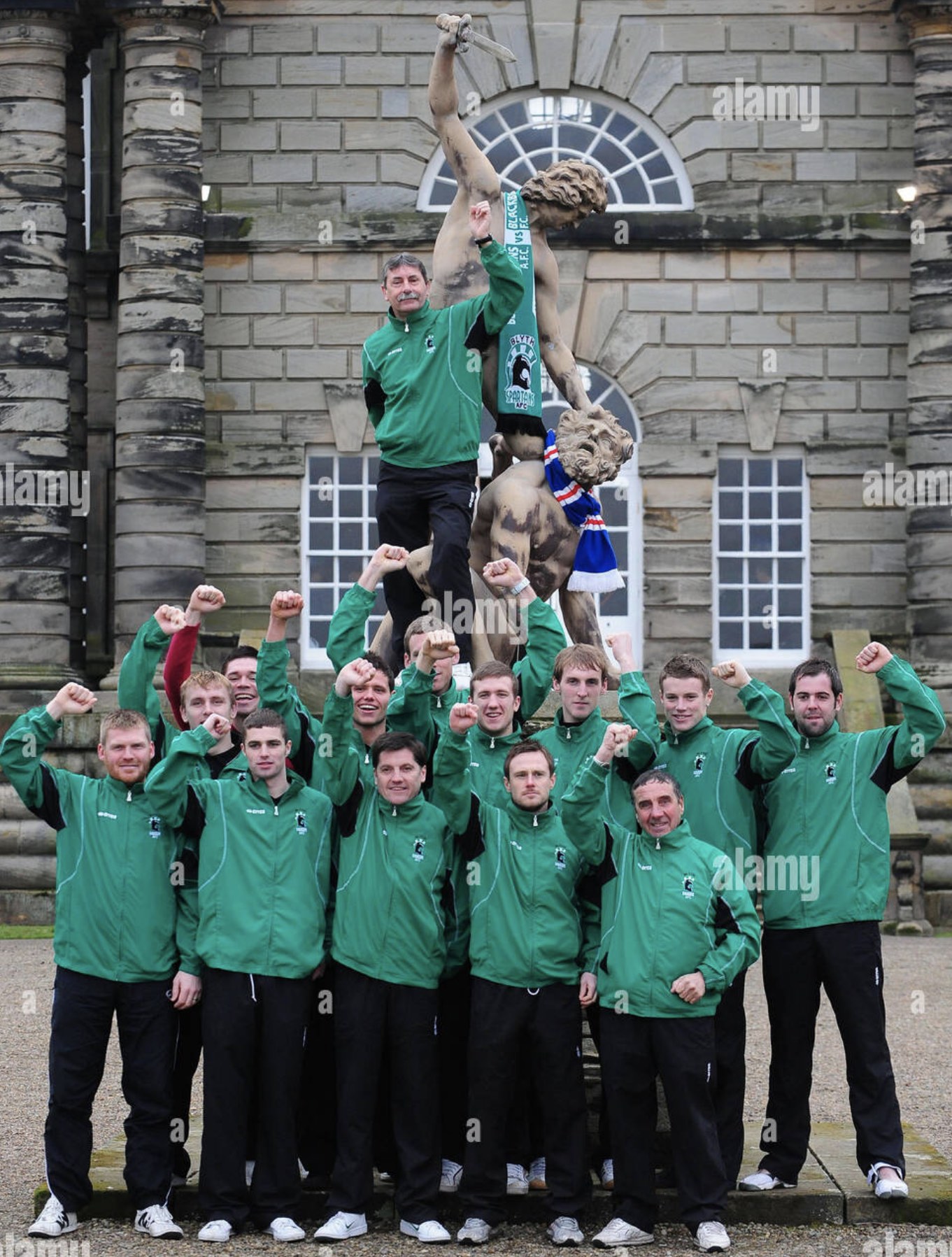
Manager Harry Dunn on statue.
Back Row L to R –
Karl Richards, Jamie Poole, Paul Watson, Richard Pell partially hidden,
Anthony Hume, Gary Brown, Paul Farman, Mark Bell.
Front Row L to R –
Graham Fenton Assistant Manager/Player, Shaun Reay,
Gary Neasham Physio, Andrew Wright, Tony Kennedy Kitman.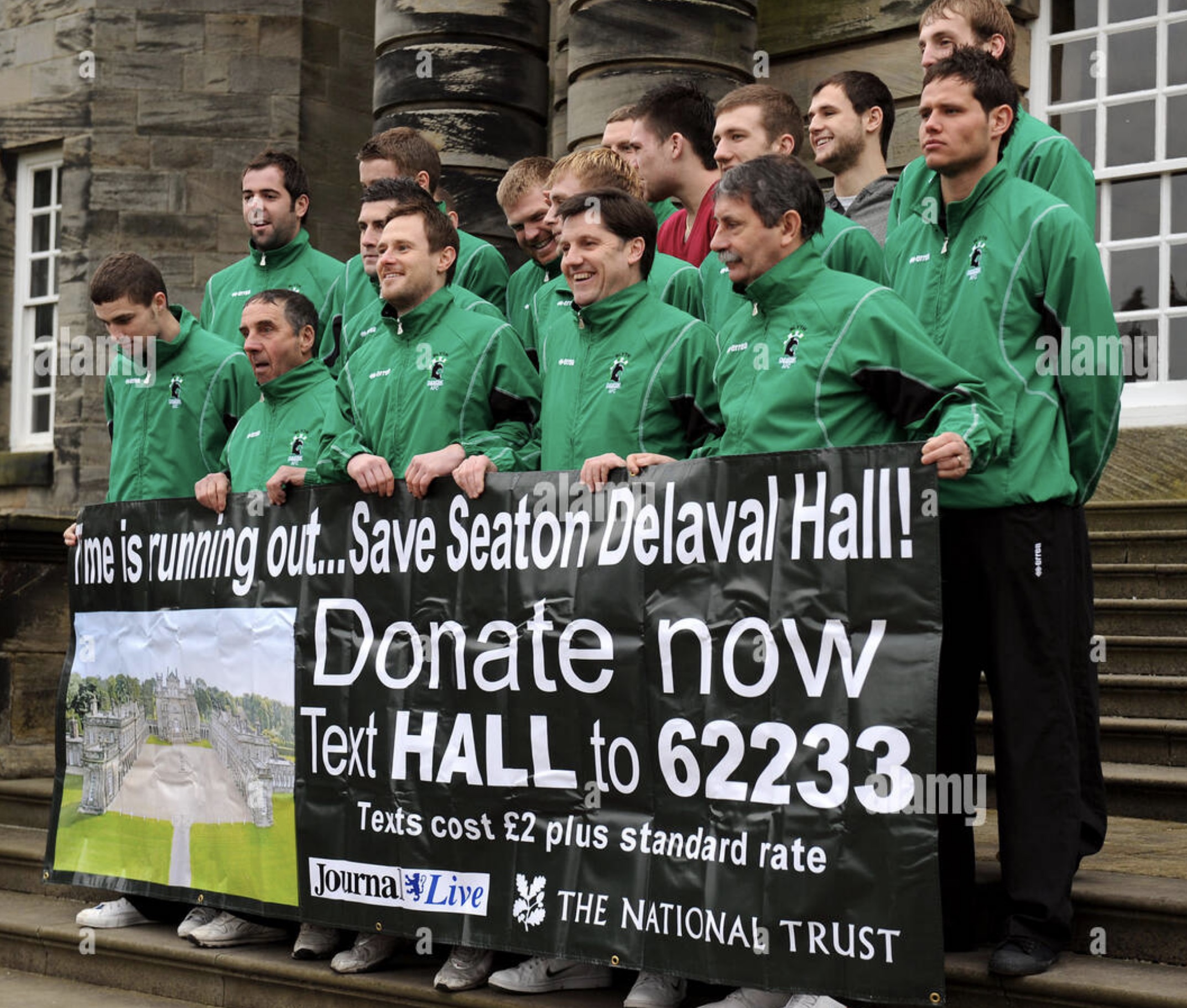
* Taken on 30th December 2008 at Seaton Delaval Hall in build up to
FA Cup 3rd Round home tie with Blacburn Rovers.
Photo shoot was publicity for cup tie and also promote the fight
to save Seaton Delaval Hall.
Alex White (back row grey top) appears in this image but not the previous one.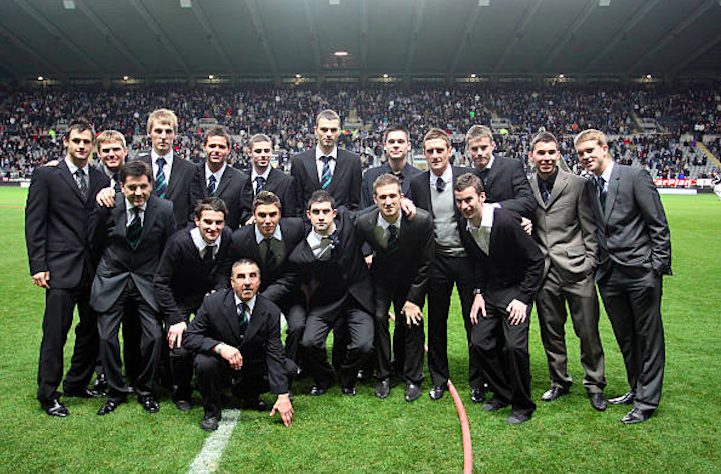
Back Row L to R –
Alex White, Graham Fenton Player/Assistant Manager, Gary Brown,
Paul Watson, Shaun Reay, Robbie Dale, Jamie Poole, Chris McCabe,
Paul Farman, Andrew Leeson, Kenny Boyle.
Front Row L to R –
Gary Neasham Physio, Ged Dalton, Tony Kennedy Kitman kneeling,
Alex Gildea, Gareth Williams, Anthony Hume, Simon Todd.
* Taken at St James’ Park on Sunday 21st December 2008 before
Newcastle United beat Spurs 2-1 in Premier League.
• Players were guests of honour at game and presented to the crowd on the pitch
following 1-0 FA Cup 2nd Round win over AFC Bournemouth on 16th December.
 Back Row L to R –
Back Row L to R –
Tony Kennedy Kitman, Graham Fenton Player/Assistant Manager, Daniel Robinson,
Anthony Hume, Gary Brown, Richard Pell, Mark Bell, Robbie Dale, Phil Bell,
Peter Snowden, Paul Watson, Gary Neasham Physio, Harry Dunn Manager.
Front Row L to R –
Paul Watson, Simon Todd, Andrew Leeson, Chris McCabe,
Gareth Williams, Daniel Hindmarsh, Ged Dalton, Andrew Wright.
* Taken before start of 2008/09 Conference North season.
2007/08 –
Back Row L to R –
Graham Fenton Player/Assistant Manager, Susan Coates Physio, Michael Hedley,
Andrew Thompson, Robbie Dale, Adam Bartlett, Peter Snowden, Richard Forster,
Michael Coulthard, Gary Neasham Physio, Harry Dunn Manager, Tony Kennedy Kitman.
Front Row L to R –
Michael Maidens, Andrew Leeson, Ben Christensen, Chris McCabe, Scott Bell,
Gareth Williams, Christian Graham, Richard Hodgson, Kenny Boyle.
*Taken before start of 2007/08 Conference North season.
2006/07 –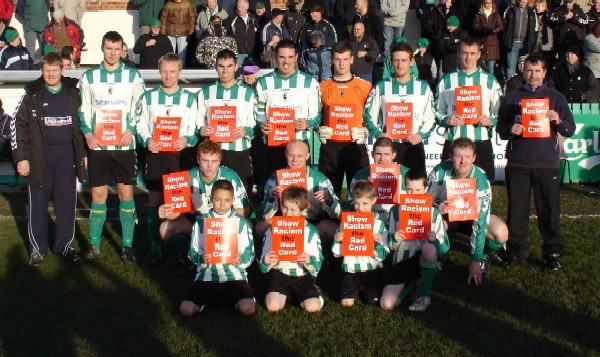
Back Row L to R –
Graham Fenton Player/Assistant Manager, Robbie Dale, Christian Graham,
Andrew Leeson, Peter Snowden, Adam Bartlett, Chris McCabe,
Matthew Moffat, Harry Dunn Manager.
Front Row L to R –
Ben Christensen, Scott Bell, Gareth Williams, Richard Forster.
Mascots Unknown.
*Taken on Saturday 27th January 2007 at Croft Park before 2-2 Conference North
draw with Worcester City as part of Show Racism the Red Card Campaign.
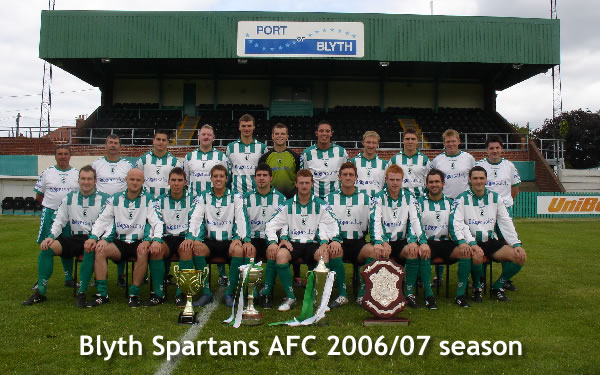 Back Row L to R –
Back Row L to R –
Tony Kennedy Kitman, Harry Dunn Manager, Liam Gildea, Richard Forster,
Robbie Dale, Adam Bartlett, Peter Snowden, Christian Graham,
Alex Gildea, Graham Fenton Player/Assistant Manager, Gary Neasham Physio.
Front Row L to R –
Dale Crawford, Scott Bell, Andrew Leeson, Simon Hanlon, Gareth Williams,
Craig Price, Chris McCabe, Ben Christensen, Anth Lowther, Paul Catto.
*Taken before start of 2006/07 season showing trophies won in previous 2005/06
Northern Premier League season – L to R – NPL Fair Play winners,
Premier League Champions trophy, NPL Challenge Cup & Peter Swales Memorial Shield.
2005/06 –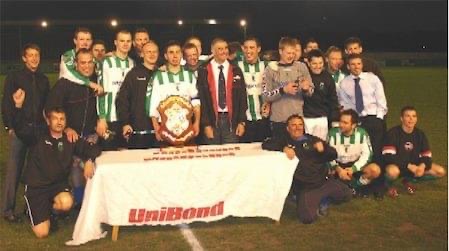 Back Row L to R –
Back Row L to R –
Simon Hanlon, Darren Cunningham Fitness Coach, Craig Price above him, Liam Gildea,
Robbie Dale, Brian Smith, Scott Bell, Andrew Leeson, Chris McCabe, NPL Official,
Peter Snowden, Craig Turns, Richard Forster partially hidden, Richard Addison behind
Gary Newsham Physio, Christian Graham, Simon Hanlon behind Martin Peace.
Front Row – L to R –
Harry Dunn Manager, Tony Kennedy Kitman, Anth Lowther, Paul Wintrip.
* Taken on Thursday 9th May 2006 following 1-0 win over Farrey Celtic at Croft Park
which sealed NPL Peter Swailes Memorial Shield which sealed a treble of NPL trophies.
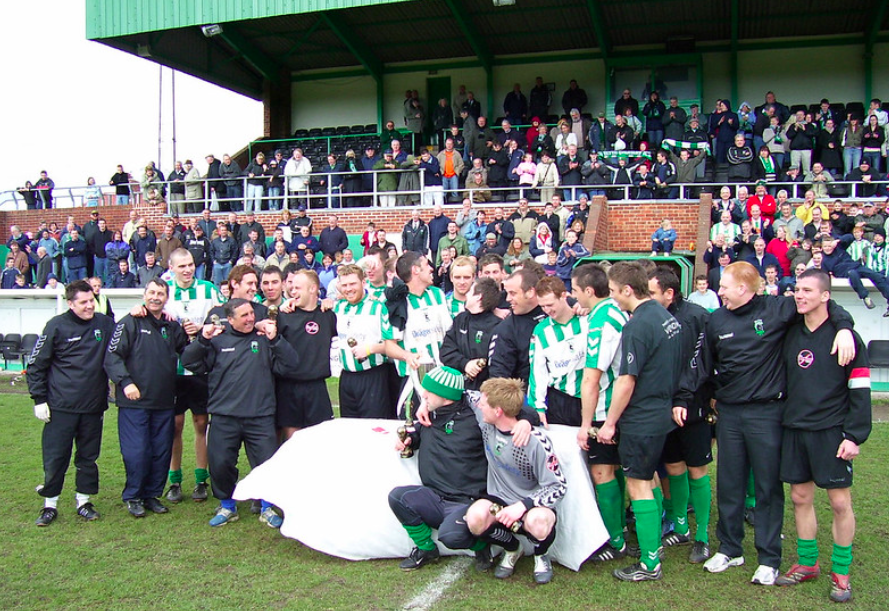 L to R –
L to R –
Gary Neasham Physio, Harry Dunn Manager, Robbie Dale,
Tony Kennedy Kitman in front of Chris McCabe, Andrew Leeson,
Richard Addison partially hidden by Scott Bell, Graham Fenton,
Peter Snowden, Andy Appleby, Martin Peace, Simon Hanson,
Darren Cunningham Fitness Coach, Craig Price, Liam Gildea, Alex Gildea,
Anth Lowther, Darren Wylam, Paul Wintrip, Gareth Williams, Craig Turns.
* Taken on Monday 1st May 2006 following 2-0 win over Ossett Town at
Croft Park which sealed NPL Challenge Cup.
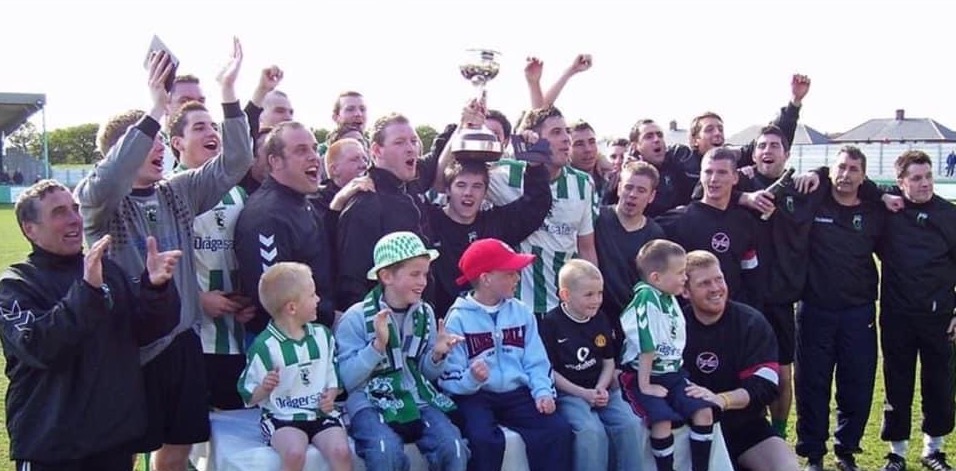
 L to R –
L to R –
Tony Kennedy Kitman, Craig Turns, Liam Gildea,
Brian Smith partially hidden behind him, Chris McCabe hidden behind
Darren Cunningham Fitness Coach, Robbie Dale above him, Darren Wylam,
Craig Price above him, Richard Forster, Martin Peace, Jamie McGlen partially
hidden by trophy, Peter Snowden, Andrew Leeson, Alex Gildea partially hidden
by Anth Lowther, Simon Hanlon, Paul Wintrip, Gareth Williams,
Harry Dunn Manager, Gary Neasham Physio.
Front end row with children Graham Fenton Player/Assistant Manager,
* Taken on Saturday 29th April 2006 following 3-0 home win over
Wakefield-Emley which sealed NPL Premier Division title.
2003/04 – Senior team in Back Row L to R –
Senior team in Back Row L to R –
Michael Manghan Physio in blue, Jamie Burt, Ian Dixon,
Andrew Leeson, Chris Bell, Gareth Williams,
Stephen Richardson, Craig Turns, Paul Baker Manager, Michael Walker,
Graham Fenton, Anthony Woodhouse, Mark Atkinson, Christian Graham,
Richard Forster, Gareth McAlindon, Ian Crutwell,
Lee George, John Curran, Tony Kennedy Kitman &
Tom Wade Assistant Mananger both in blue.
*Taken at Croft Park in March 2004 showing the sides affiliated with club.
Features mens senior team and all junior teams players
and their managers & coaches.

Back Row L to R –
Michael Manghan Physio, Jamie Burt, Ian Dixon, Richard Forster, Colin Morton,
Anthony Woodhouse, Craig Turns, Michael Laws, Christian Graham,
Chris Bell, Tony Kennedy Kitman.
Front Row L to R –
Graham Fenton, Stephen Richardson, Andrew Leeson, Ian Crutwell,
Paul Baker Manager, Tom Wade Assistant Manager, Gareth Williams,
Gareth McAlindon, Mark Atkinson, Wayne Phillips.
*Taken in November 2003 after squad received new Nike tracksuits.
 Back Row L to R –
Back Row L to R –
Paul Baker Manager, Wayne Phillips, Chris Bell, Andrew Leeson, Ian Dixon,
Colin Morton, Anthony Woodhouse, Craig Turns, Richard Forster,
Michael Laws, Christopher Joyce, Kris Robertson behind Tony Kennedy Kitman,
Michael Mangan Physio,
Front Row L to R –
Ian Crutwell, Graham Fenton, Gareth McAlindon, Stephen Richardson,
Christian Graham, Mark Atkinson, Gareth Williams.
*Taken on Saturday 16th August 2003 before 2-0 home win over
Ashton United in opening game of NPL season.
March 2003 –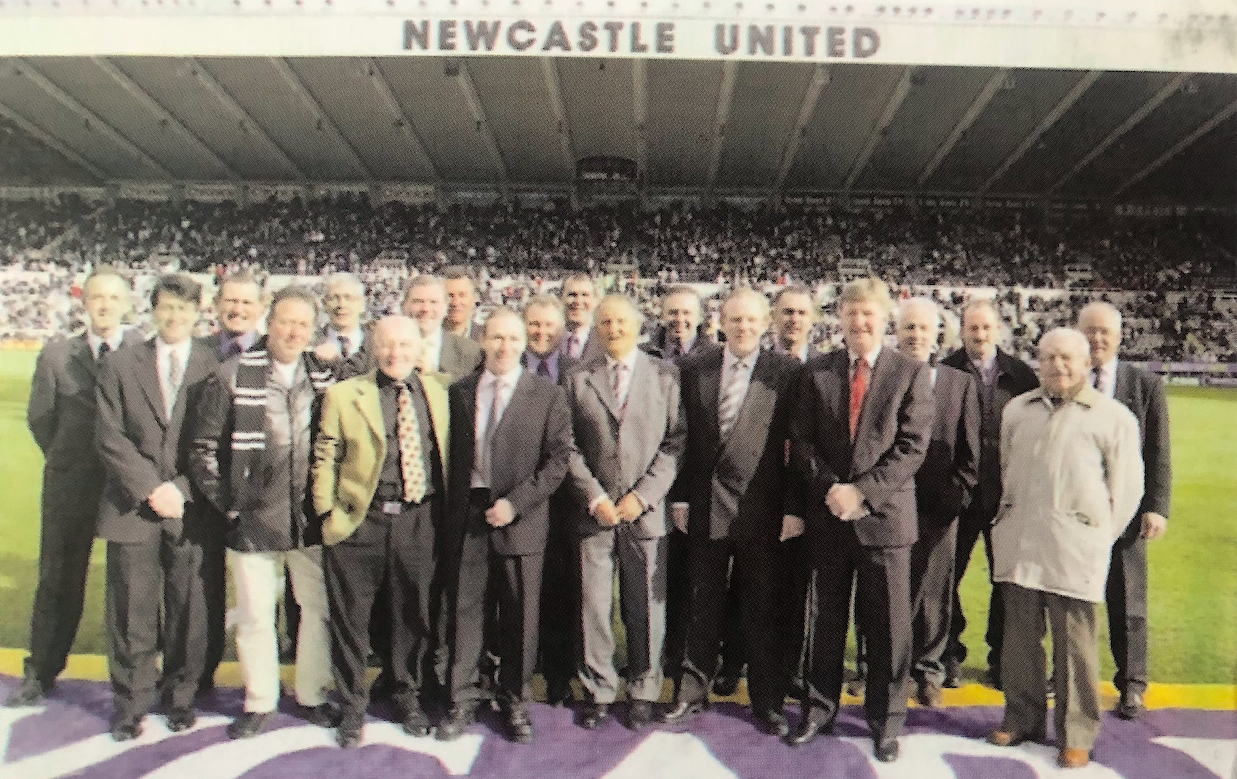
L to R –
Phil Castiaux current Media Manager, Dave Varty, John Waterson, Terry Johnson,
Ronnie Scott, John ‘Eddie’ Alder, Ron Guthrie, Keith Houghton, Alan Shoulder,
Dave Clarke, Ian Mutrie, Jackie Marks Coach, Dave Addison, Tommy Dixon,
Steve ‘Jos’ Jones, Brian Slane Player/Manager, Mick Dagless, Gerry Day,
Billy Fenwick Trainer, Tony Platten current Chairman.
*Taken on Saturday 1st March 2003 at St James’ Park before Newcastle United’s
home game with Chelsea.
• To mark the 25th Anniversary of 77/78 FA Cup NUFC invited players & officials
to be guest of honour and presented them to crowd on pitch before kick off.
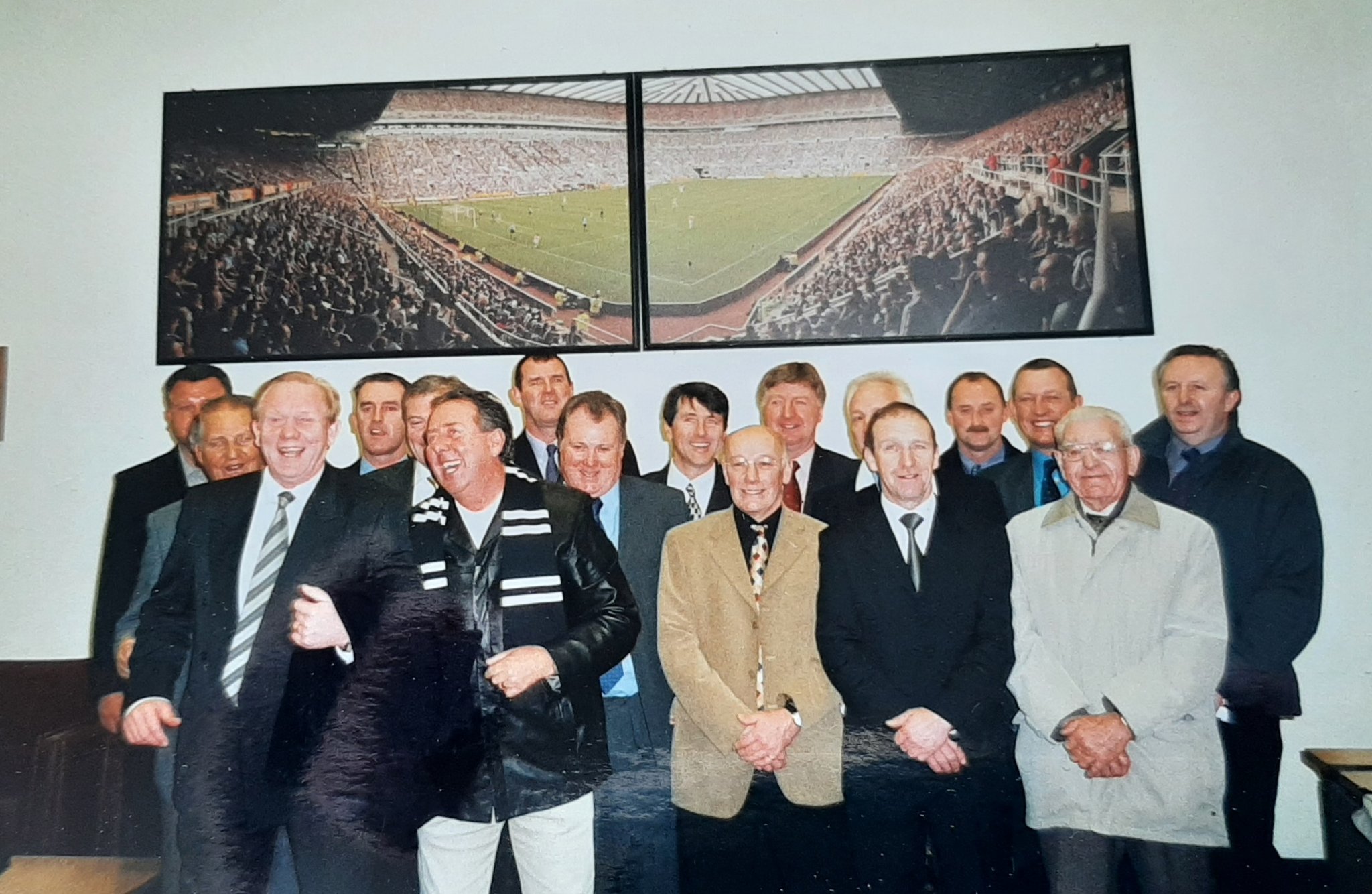 L to R –
L to R –
Keith Houghton behind Jackie Marks, Tommy Dixon, Steve ‘Jos’ Jones,
Ron Guthrie behind Terry Johnson, Ian Mutrie, Dave Clarke, Dave Varty,
John ‘Eddie’ Alder, Brian Slane, Mick Dagless behind Alan Shoulder,
Gerry Day, John Waterson, Billy Fenwick Trainer, Dave Addison.
2001/02 –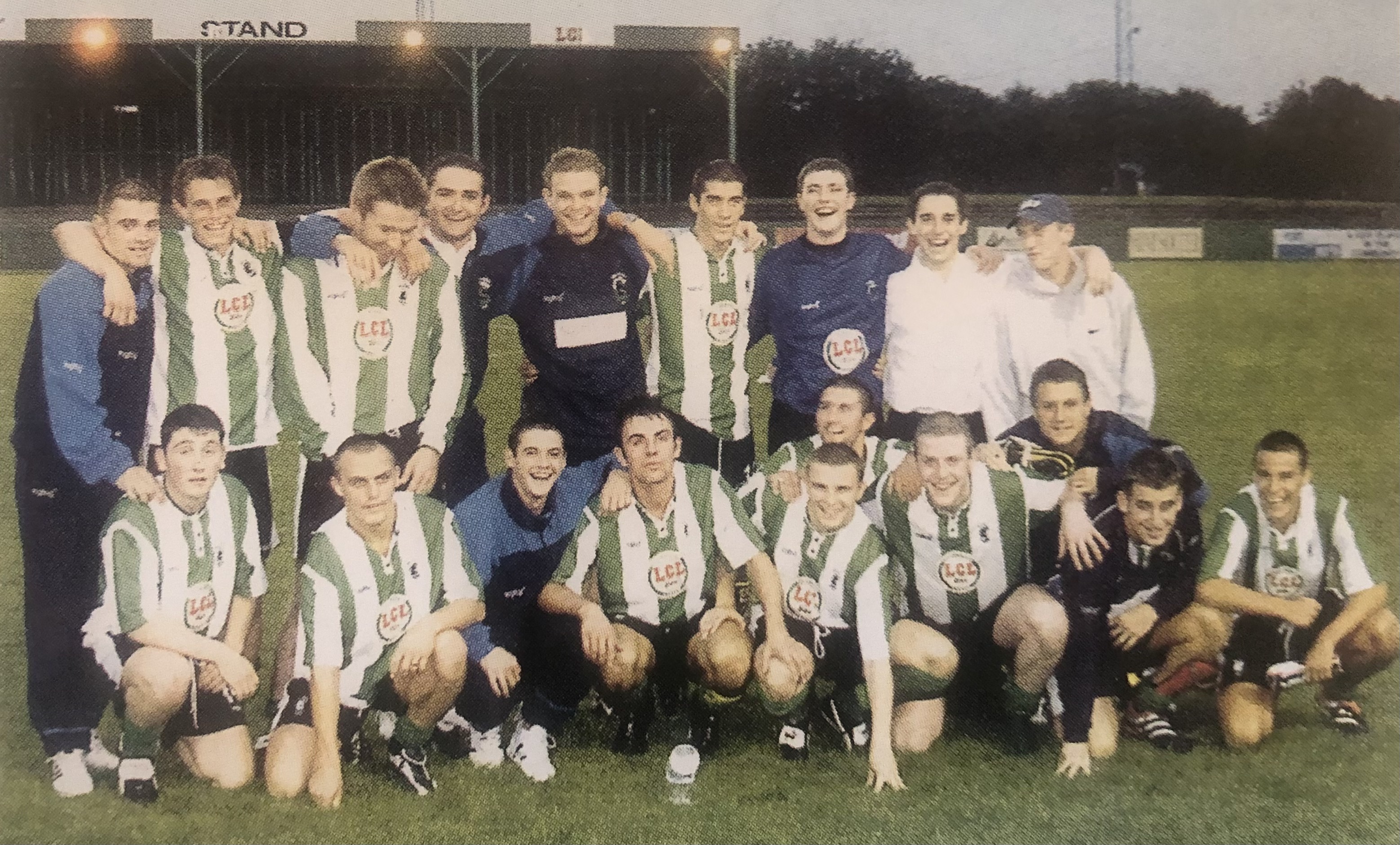
Back Row L to R –
Gary Innes, Carl Pepper, Andy Martin, Justin Keegan, Paul Gilmore, Colin Morton,
Craig Cotterill, Graham Pepper, Stephen Stewart.
Front Row L to R –
Lee Scroggins, Paddy Little, Glen Robson, Ian Dixon, Gareth Williams behind
Scott Emmerson, Richard Forster, Michael Boddy, Craig Myhill, Craig Perry.
*Taken on Monday 16th July 2002 after a pre season friendly
1-1 home draw with Ayr United.
2000/2001 –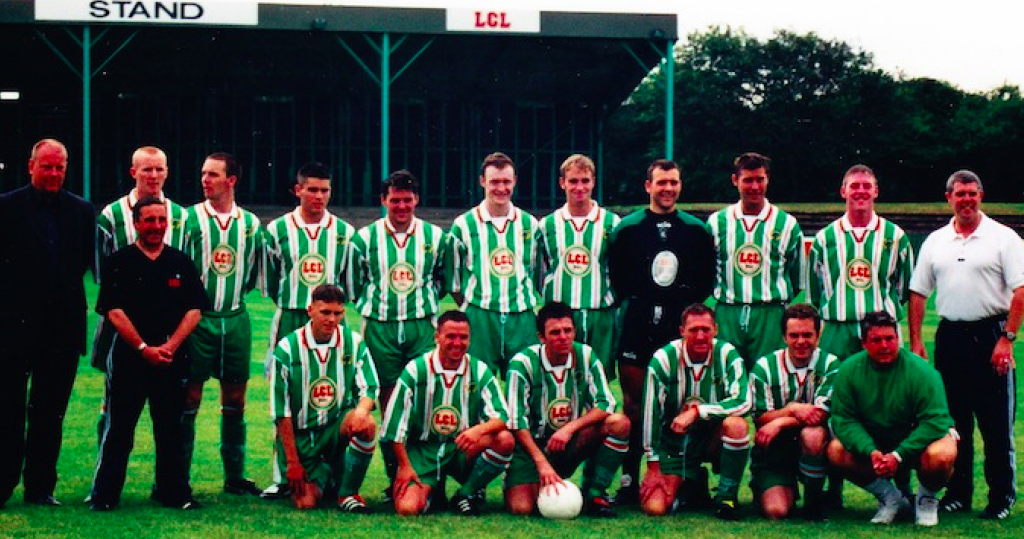
Back Row L to R –
John Charlton Manager, Tony Kennedy Kitman in front of Unknown Player,
Unknown Player, Unknown Player, Brian Rowe, Unknown Player, Andy Hay,
Terry Burke, Ian Chandler, Richard Forster, Glen Martin Physio.
Front Row L to R –
Unknown player, Anthony Skedd, Ian Dixon, Willie Moat,
Unknown player, Graeme Clark Assistant Manager.
*Taken on Saturday 5th August 2000 before 1-2 pre season
home friendly defeat to Dunston Federation.
1999/2000 –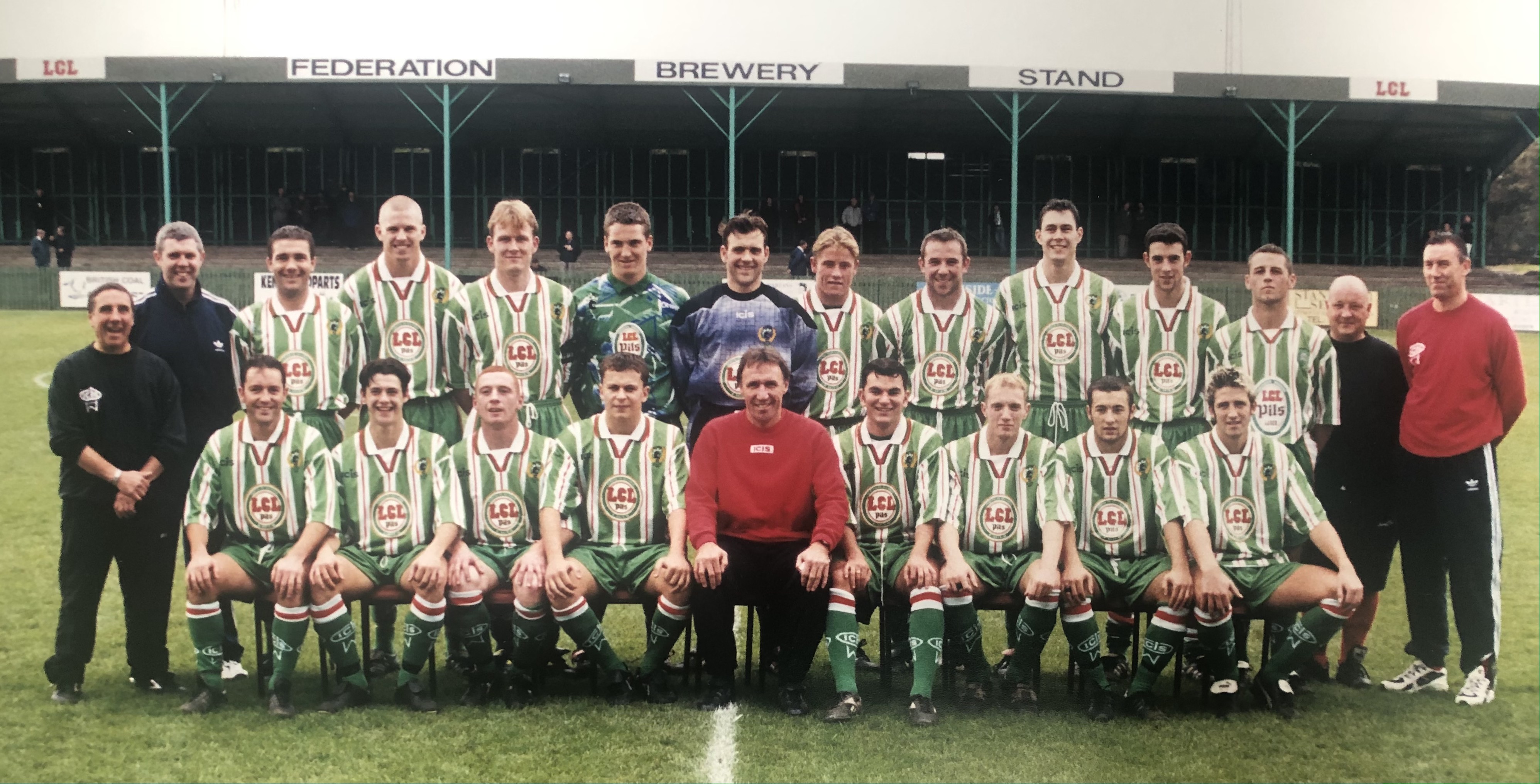
Back Row L to R –
Tony Kennedy Kitman, Glen Martin Physio, Stephen Locker, Matty Hysen, Craig Melrose,
Andrew Grainger, Terry Burke, Kris Leighton, Andy Blower, Ross Lumsden,
Derek Attwell, Nicky Evans, Lawrence Fox Trainer, Peter Harrison Assistant Manager.
Front Row L to R –
Michael Farrey, Glen Robson, Wayne Edgecumbe, Steve Hutchinson,
Mick Tait Manager, David Burt, Stephen Stewart, Graeme Hog, Richie Pitt.
*Taken on Thursday 12th August before 1-1 home pre season
friendly defeat with a Leeds United XI.
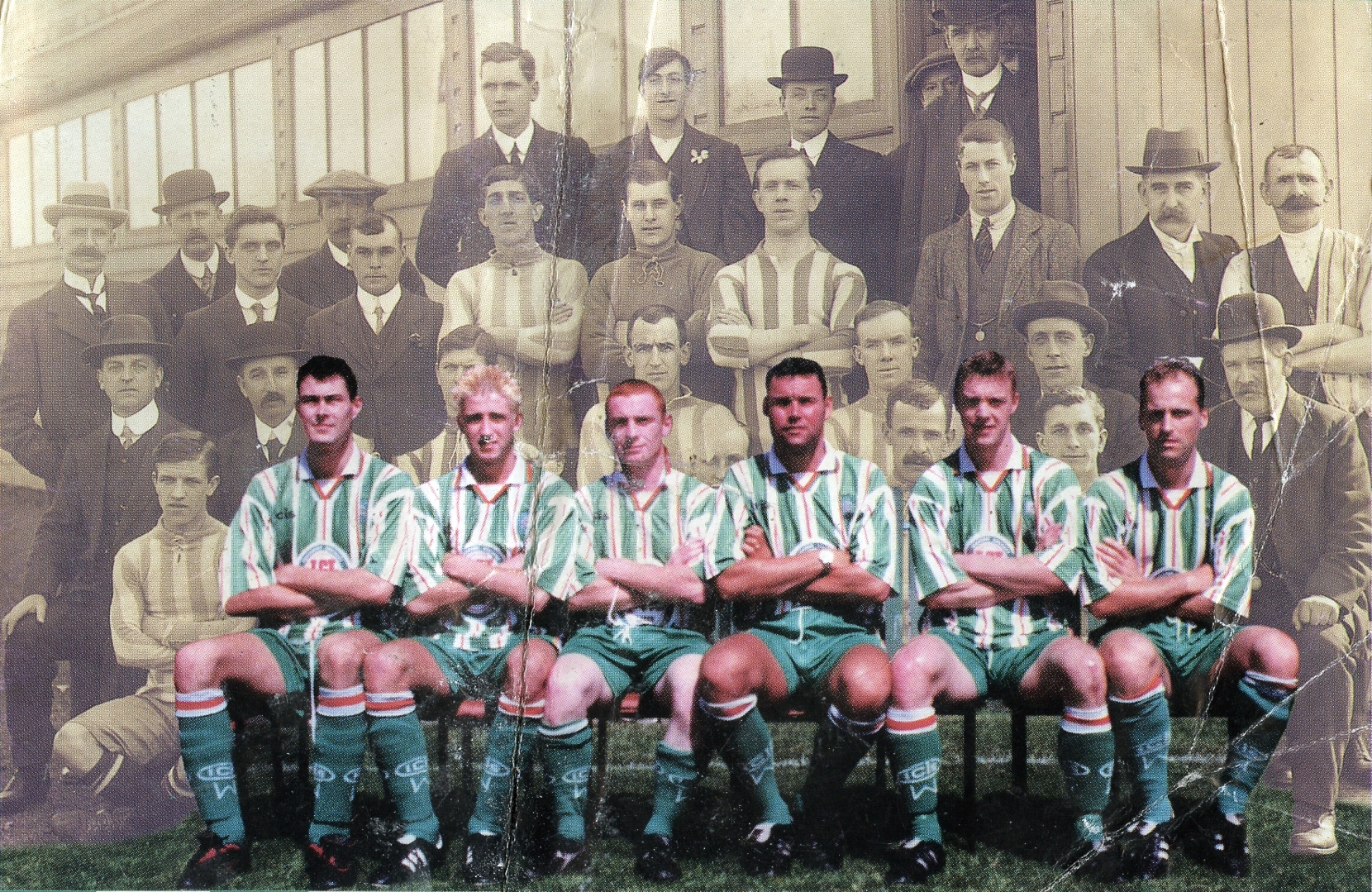 Front Row L to R –
Front Row L to R –
Ross Lumsden, Richie Pitt, Wayne Edgecumbe, John Gamble,
Jon Atkinson, Lawrie Pearson.
*This unique image of present day players was super imposed onto the 1913/14 team
photo and used on the front cover of the 1999/2000 season match day programmes.
Present day players photo was taken in summer of 1999.
• If you know of a full squad version of the 1999 team photo please
get in touch via email so it can be added to this archive –
theblythspirit@hotmail.com
1998/99 –
Back Row L to R –
Glen Martin Physio, Steve Locker Ross Lumsden, Matty Hysen, Terry Burke,
Willie Moat, Andrew Rose, Nicky Peverill, John Gamble,
Tony Kennedy Kitman, Lawrence Fox Trainer.
Front Row L to R –
Michael Farrey, Steve Hutchinson, Anthony Skedd, Wayne Edgecumbe,
Michael Murr, Richie Pitt, Gary O’Hara, Ian Irving, Jon Atkinson.
Mascots unknown.
*Taken on Wednesday 5th May 1999 before Northumberland Senior Cup Final
at St James’ Park, lost 1-2 to Newcastle United Reserves.
Back Row L to R –
Tony Kennedy Kitman, John Gamble, Jon Atkinson, Ross Lumsden,
Matty Hysen, Terry Burke, Willie Moat, Peter Gamble, Glen Martin Physio.
Front Row L to R –
Ian Irving, Gary O’Hara, Steve Hutchinson, Wayne Edgecumbe, Michael Farrey,
Michael Murr, Stephen Locker, Tony Skedd, Richie Pitt.
*Taken on Saturday 17th April 1999 before 1-1 NPL home draw with Runcorn.
Taken from main stand at Croft Park showing the sides affiliated with club,
mens senior team and all junior teams players with their managers & coaches.
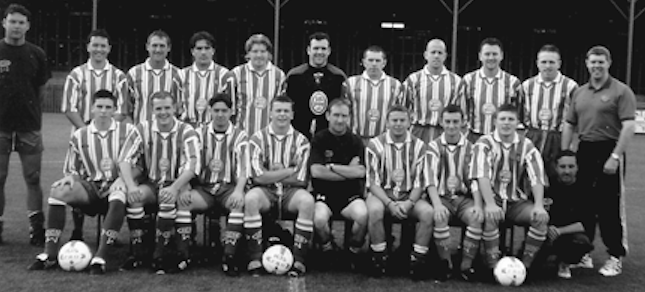 Back Row L to R –
Back Row L to R –
John Gamble Player/Assistant Manager, Michael Farrey, Willie Moat, Steve Locker,
Kevin McGarrigle, Terry Burke, John Tinkler, Michael Casey, Anth Cole,
Allan Colledge, Glen Martin Physio.
Front Row L to R –
Mark Lee, Ian Irving, John Ramsey, Steve Hutchinson, Alan Shoulder Manager,
Steve Walker, Anthony Simpson, Mark Pattison, Tony Kennedy Kitman.
*Taken on Saturday 2nd August 1998 before 1-0 home win
over Lancaster City in opening game of NPL season.
1997/98 –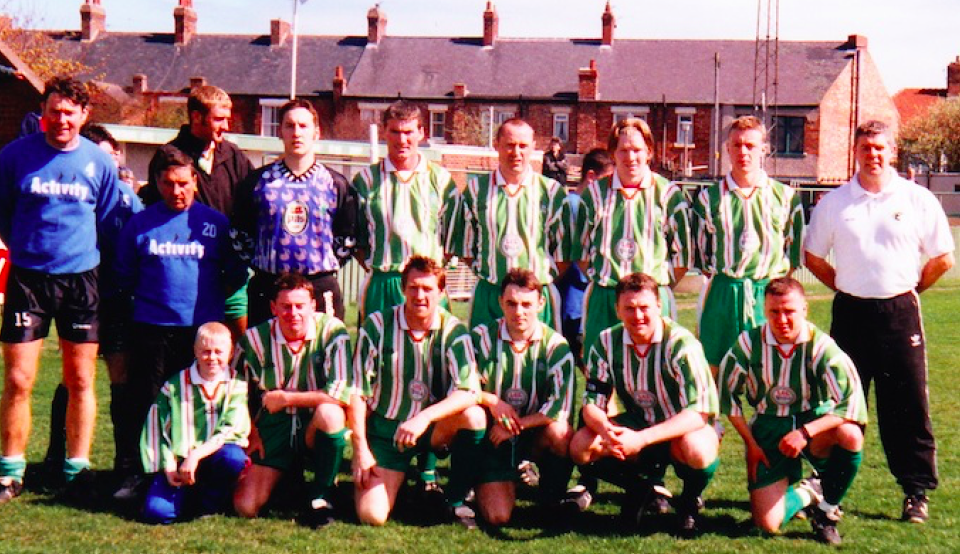 Back Row L to R –
Back Row L to R –
John Gamble, Tony Kennedy Kitman, Stephen Dann, Steve Jones, Willie Wilson,
Martin Pike, Kevin McGarrigle, Jon Atkinson, Glen Martin Physio.
Front Row L to R –
Unknown Mascot, Steve Walker, Willie Moat, Glen Renforth, Anth Cole Athony Skedd.
*Taken on Saturday 2nd May 1998 before final NPL game of the season,
a 1-1 home draw with Bamber Bridge.
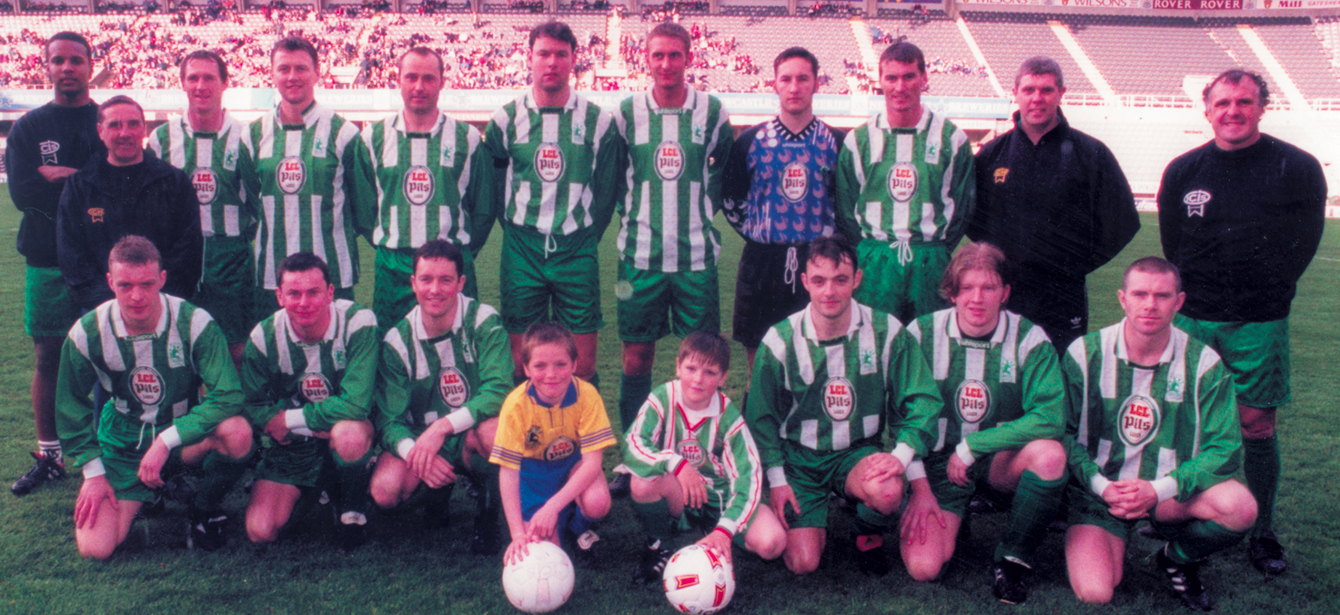 Back Row L to R –
Back Row L to R –
Kona Hislop, Tony Kennedy Kitman, Willie Moat, Anth Cole, Martin Pike,
John Gamble, Stephen Dann, Steve Jones, Willie Wilson,
Glen Martin Physio, John Burridge Player/Manager,
Front Row L to R –
Jon Atkinson, Steve Walker, Michael Farrey, Mascots unknown,
Glen Renforth, Kevin McGarrigle, John Tinkler.
*Taken on Monday 27th April 1998 before Northumberland Senior Cup Final
at St James’ Park, lost 0-2 to Bedlington Terriers.
1996/97 – 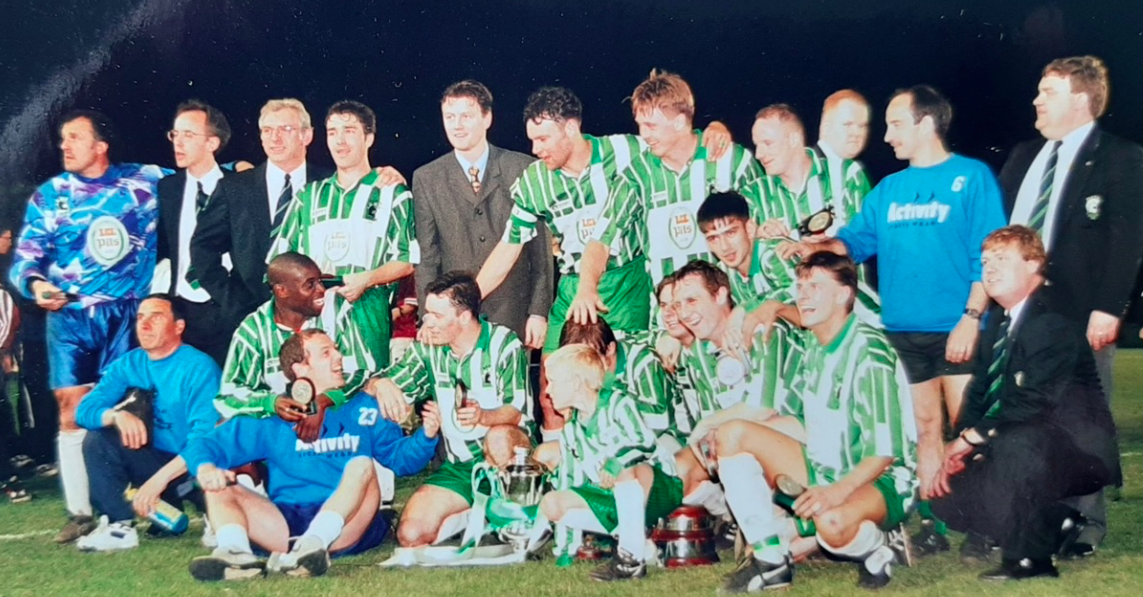
Back Row L to R –
John Burridge Player/Manager, Phil Castiaux Press Officer, Mike Mitchell Chairman,
Stephen Locker, Anth Cole, John Gamble, Damian Henderson, Steve Adams,
Scott Sawyer Club Official, Paul Sanderson Physio, Bob Cotterill Club Official.
Front Row L to R –
Tony Kennedy Kitman, Don Page, Mark Todd, Michael Farrey, Stephan McGargle
behind mascot Matthew Biarrick, Steve Walker partially hidden by Willie Moat,
Joey McGiven, Richie Bond, John Broadhead Club Official.
*Taken on Thursday 1st May 1997 following 3-2, 2nd Leg home win over Runcorn in
NPL Presidents Cup Final at Croft Park that sealed a 4-2 aggregate victory.
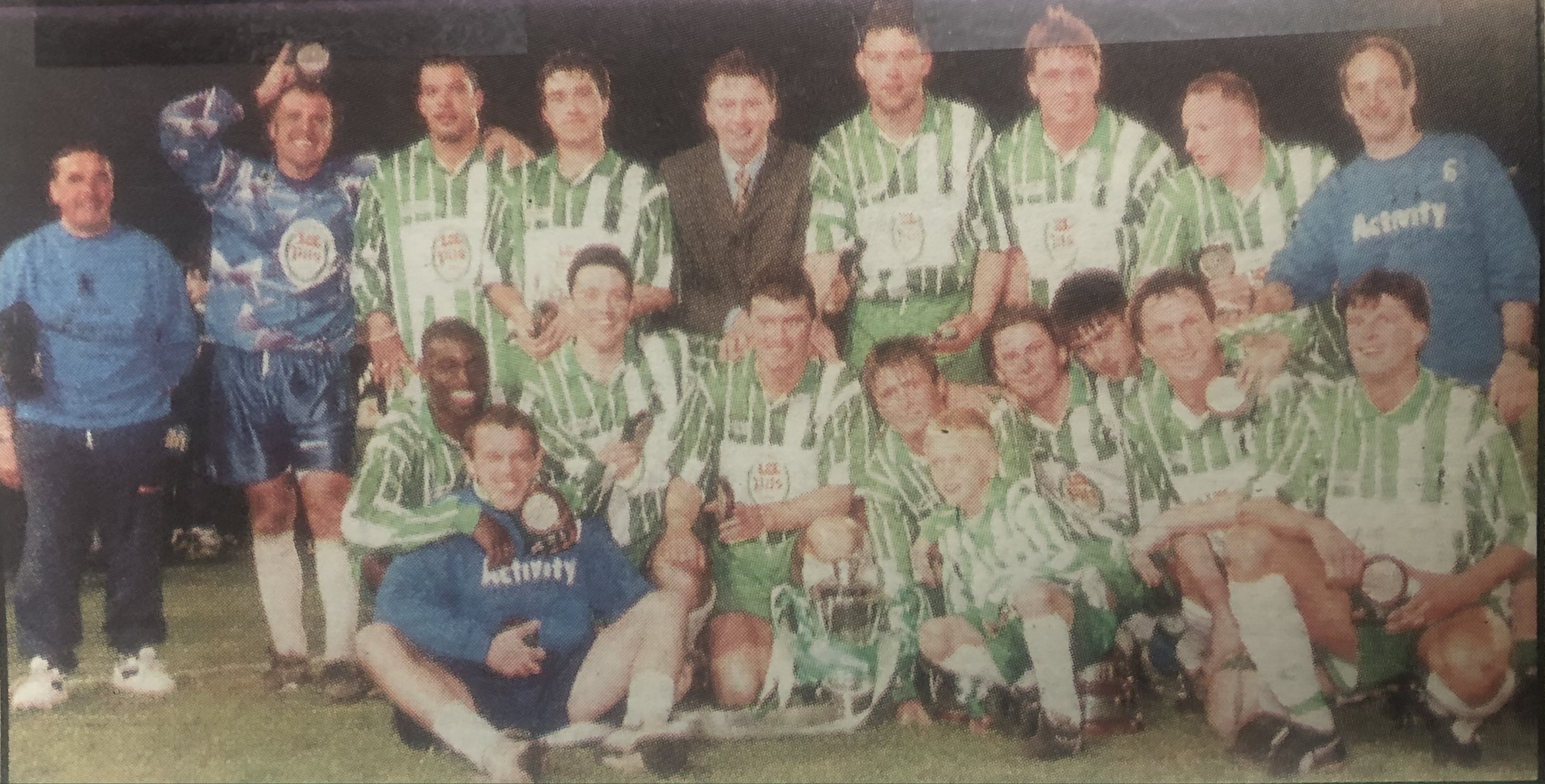 • This version which appeared in the local weekly Courier newspaper contains
• This version which appeared in the local weekly Courier newspaper contains
Keith Fletcher (back row next to John Burridge) and Willie Wilson
(front row next to Michael Farrey) both were missing in other photo.
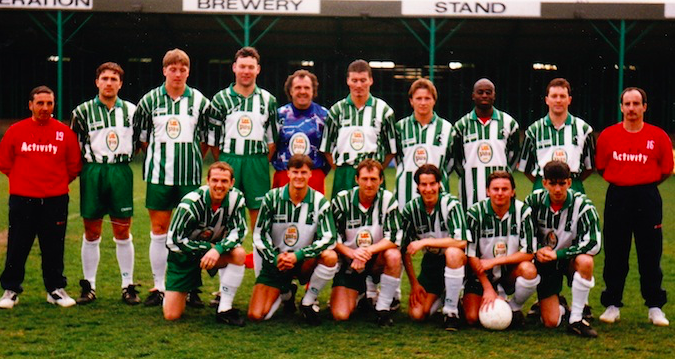 Back Row L to R –
Back Row L to R –
Tony Kennedy Kitman, Stephen Locker, Damian Henderson, John Gamble,
John Burridge Player/Manager, Willie Wilson, Stephan McGargle, Don Page,
Michael Farrey, Paul Sanderson Physio.
Front Row L to R –
Mark Todd, Richie Bond, Willie Moat, Peter Kirkham, Steve Walker, Joey McGiven.
*Exact date of photo is unknown but was after February 1997
because Don Page signed in early February.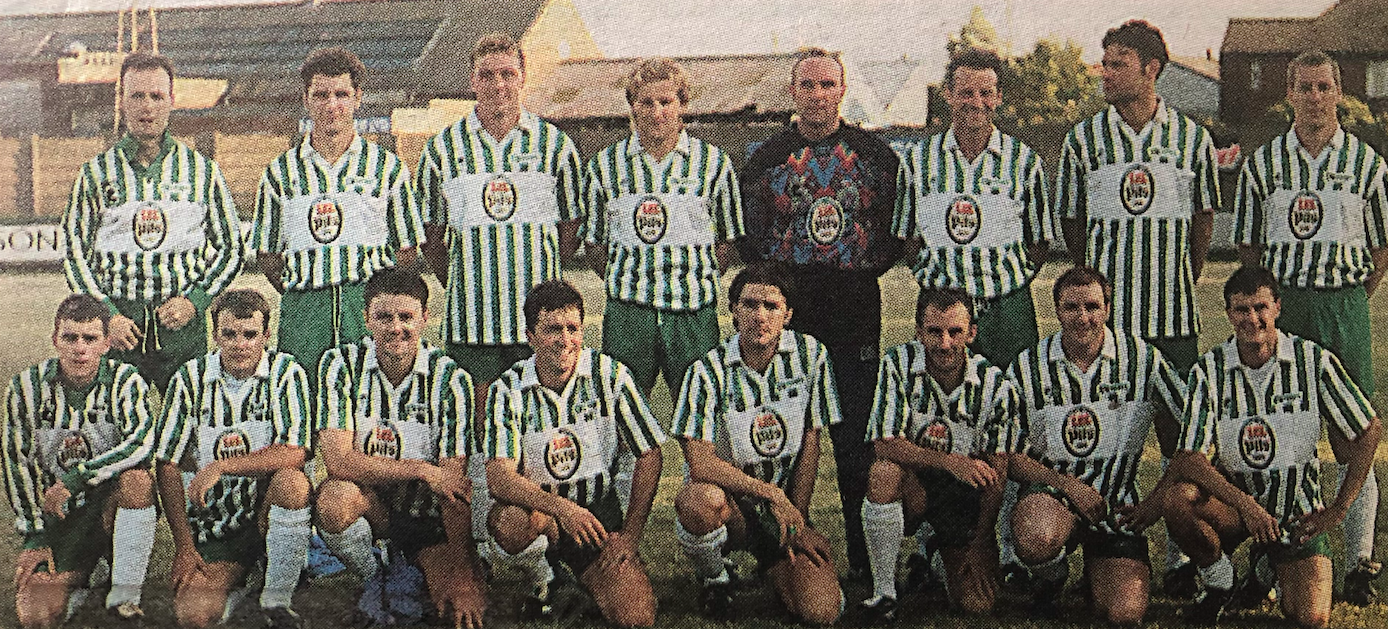 Back Row L to R –
Back Row L to R –
Graham Curry, Stuart Young, Damian Henderson, Unknown Player, Damien Boyd,
Peter Kirkham, John Gamble, Stephen Raffell.
Front Row L to R –
Unknown Player, Michael Bean, Anth Cole, Michael Farrey, Stephen Locker,
Steve Pyle, Darren Nicholls, Richie Bond.
*Taken on Tuesday 1st August 1996 at Whitely Bay before pre season friendly.
1995/96 –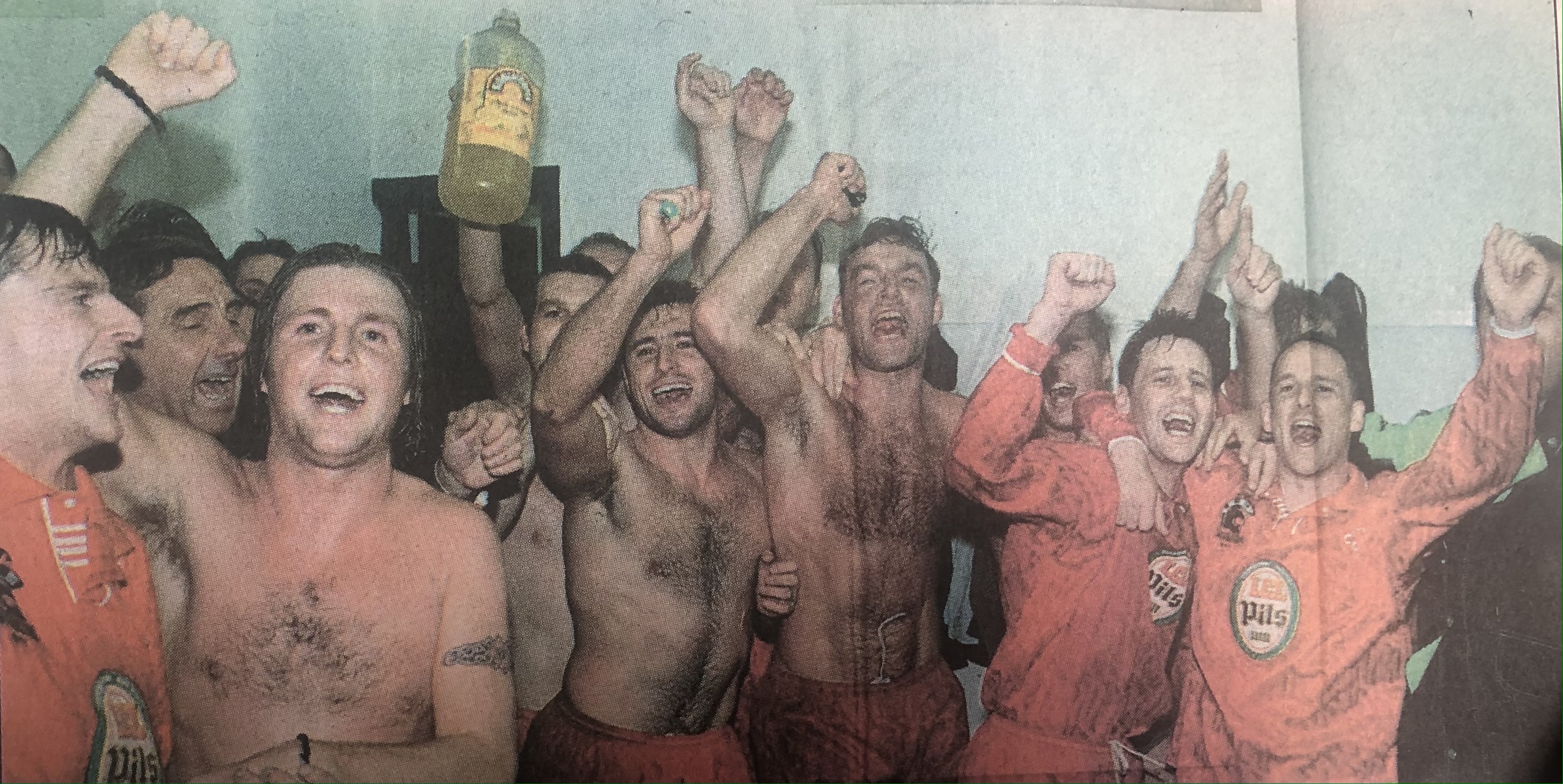 L to R –
L to R –
Richie Bond, Tony Kennedy Kitman, Steve Walker hidden behind Mark Telford,
Warren Teasdale holding juice bottle behind Paul O’Connor who is partially hidden by
Gary Hays arm, Tommy Ditchburn partially hidden by John Gamble’s arm,
Stephen Raffell partially hidden by John Sokoluk’s arm, Steve Adams
with Graham Curry hidden behind him.
*Taken on Saturday 11th November 1995 in away team changing room
following 0-2 FA Cup win away at 3rd Division Bury. 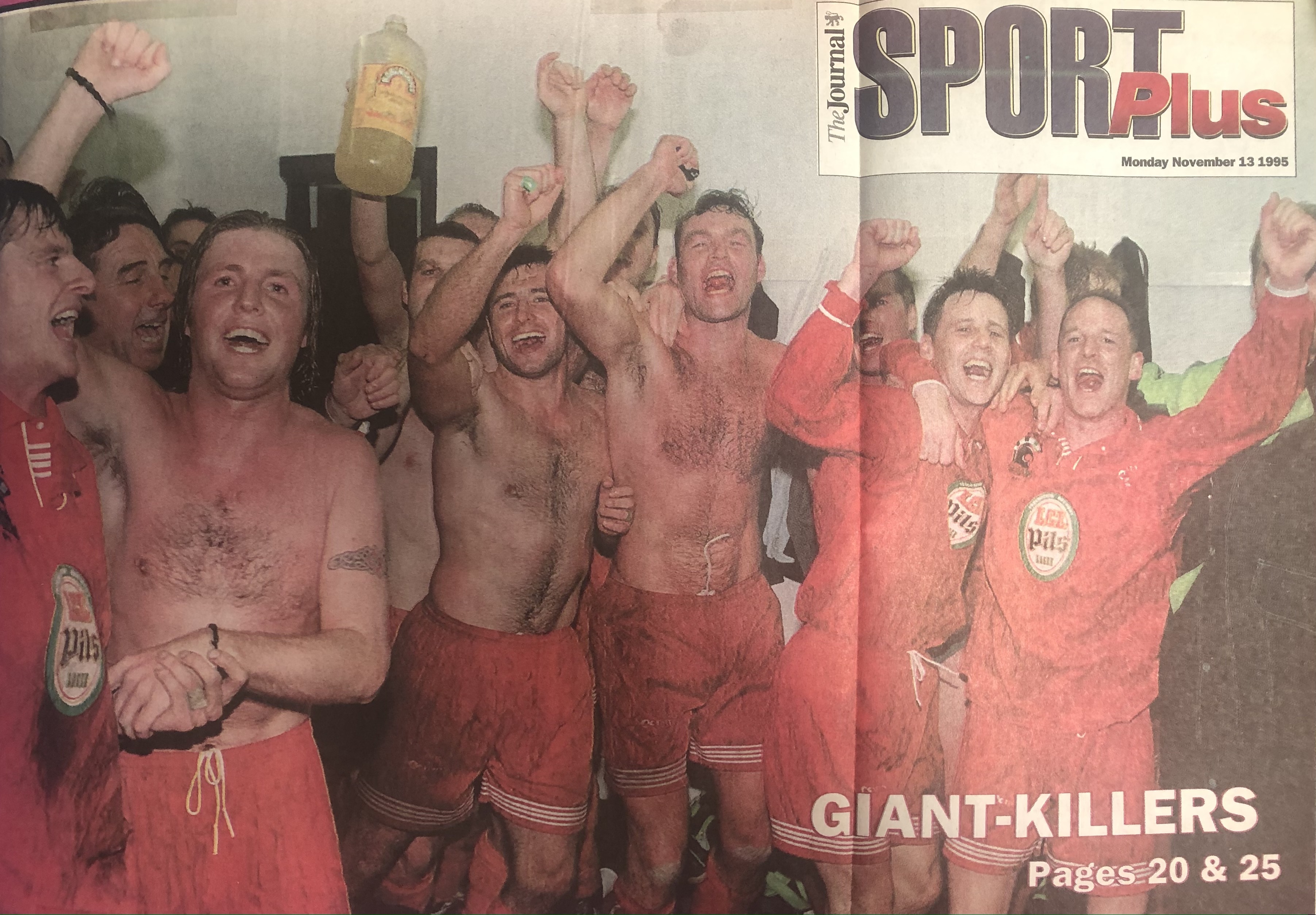
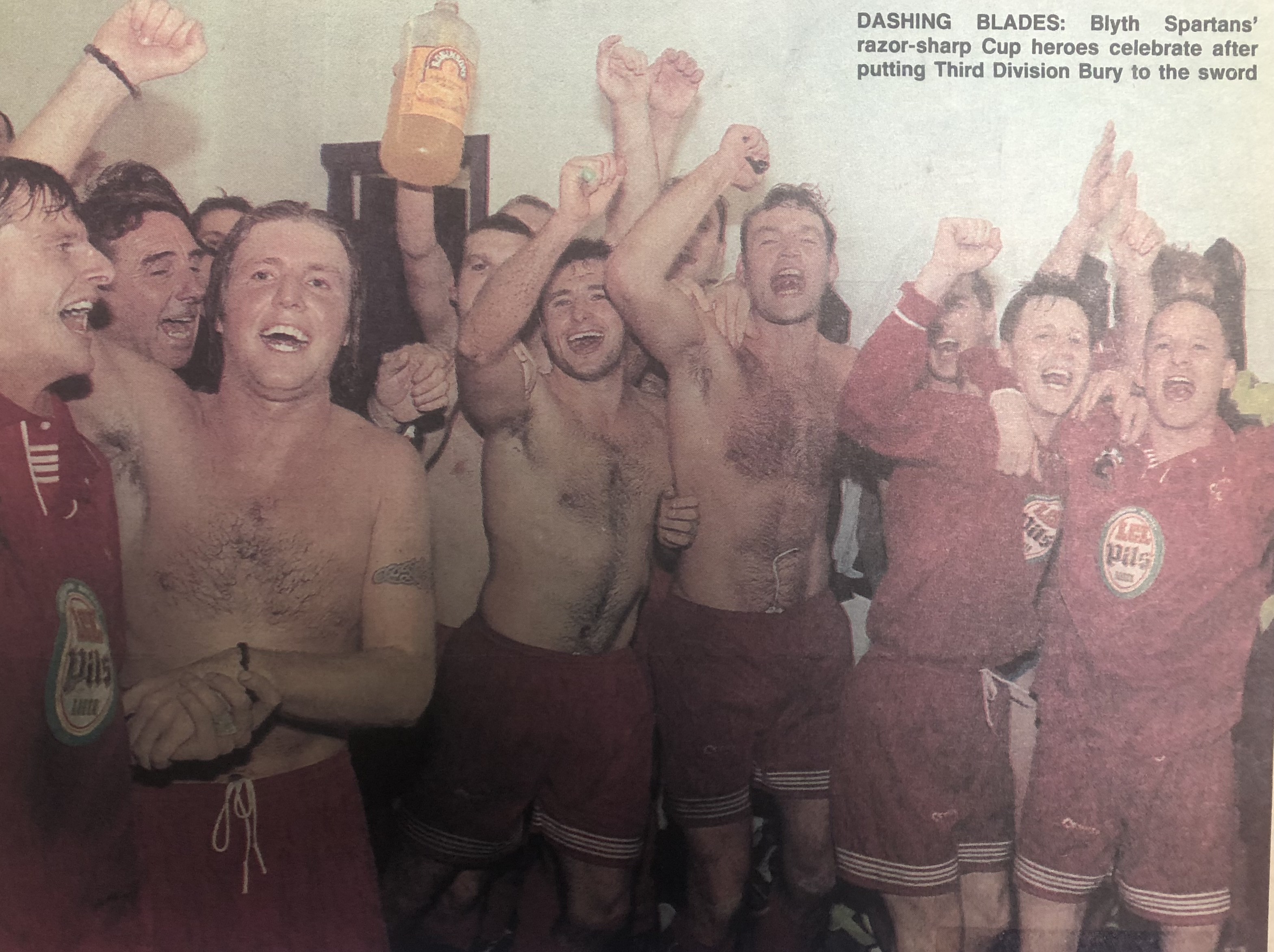
• Several version of this image appeared in local & national newspapers
the nextday following Blyth’s latest FA Cup giant killing.
1994/95 –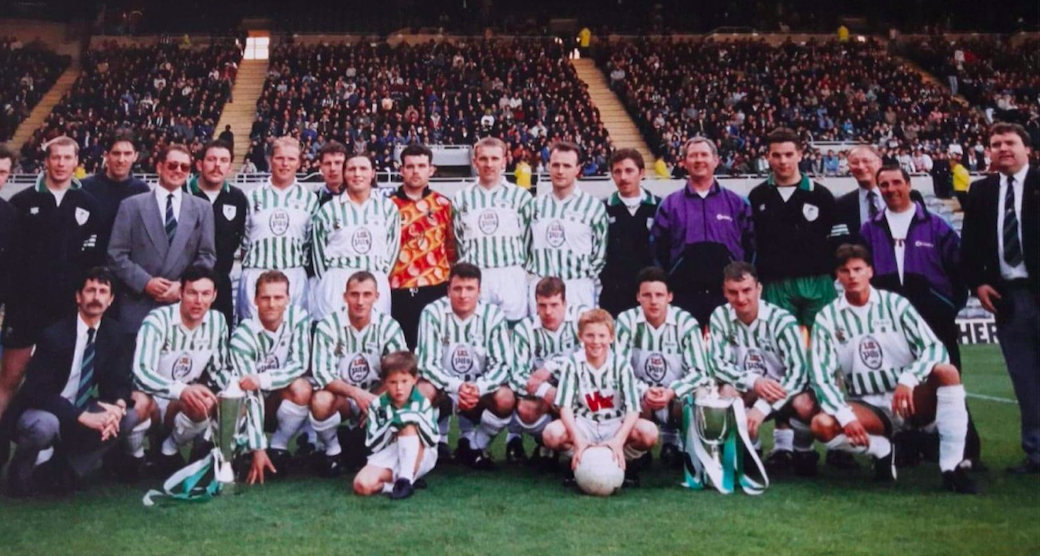
Back Row L to R –
James Bratt Senior Sales Rep for Unibond partially cropped out, Stephen Raffell,
Shaun Dunn, Jim Telford Chairman, Kevin Wolfe, Tommy Ditchburn, Peter Gardener,
Mark Telford, Paul Connor, Warren Teasdale, Graham Curry, Steve Houlden,
Dave Robertson Assistant Manager, Jason Jones,
Unknown NPL Official, Tony Kennedy Kitman, Bob Cotterill Official.
Front Row L to R –
Harry Dunn Manager, John Gamble, Lawrie Pearson, Steve Pyle, Gary Hays,
Steve Harkus, John Sokoluk, Paul Cooper, Richie Bond.
Mascots unknown – trophies NPL First Division title & NPL First Division Cup.
*Taken on Monday 15th May 1995 before the Northumberland Senior Cup Final
at St James’ Park, lost 2-6 to Newcastle United Reserves.
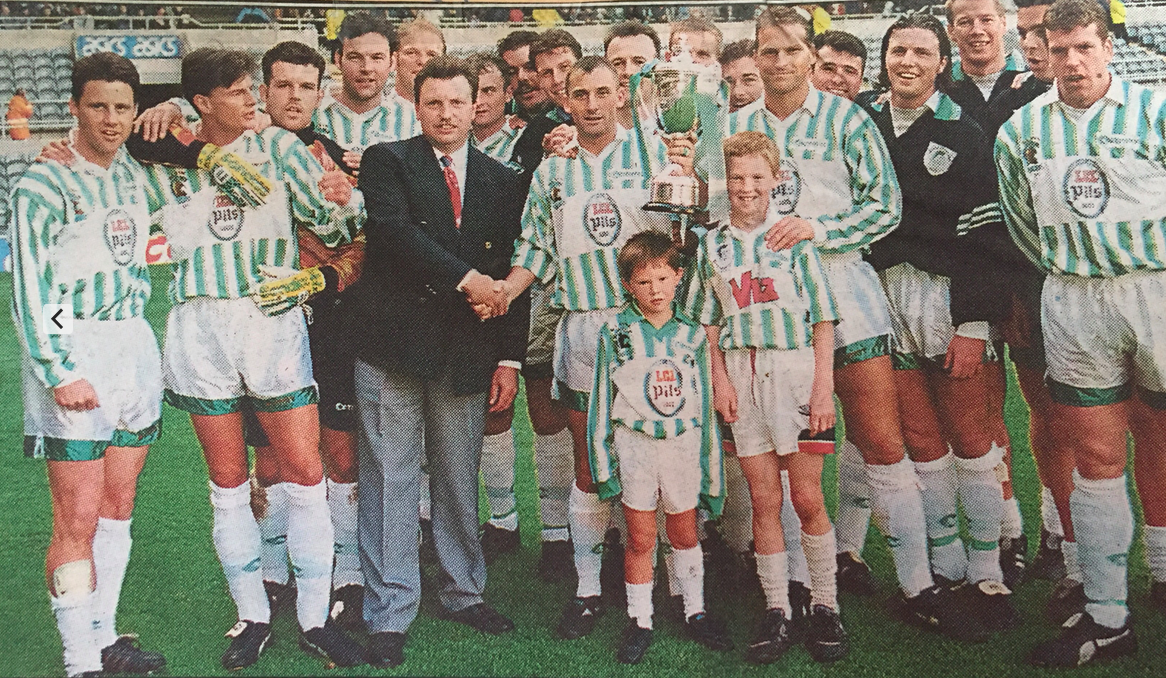 L to R –
L to R –
John Sokoluk, Richie Bond, Paul O’Connor, John Gamble, Tommy Ditchburn,
James Bratt Senior Sales Rep for Unibond, Paul Cooper, Kevin Wolfe, Peter Gardner,
Steve Pyle, Graham Curry, Warren Teasdale partially hidden by trophy, Steve Houlden,
Laurie Pearson, Gary Hays, Mark Telford, Stephen Raffell, Jason Jones, Steve Harkus.
Mascots unknown.
*Taken on Monday 15th May 1995 before Northumberland Senior Cup Final at
St James’ Park where team was presented with the NPL First Division trophy
following league title win at Harrogate Town on Saturday 6th May.
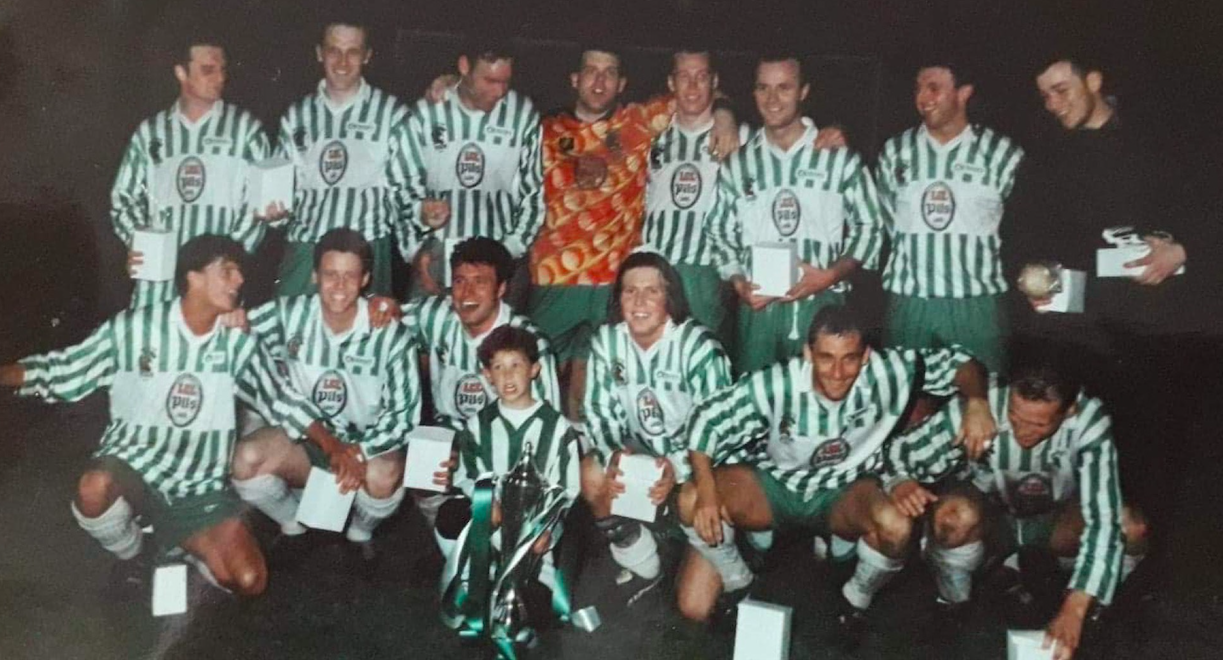 Back Row L to R –
Back Row L to R –
Paul Cooper, Warren Tesdale, John Gamble, Paul O’Connor, Stephen Raffell,
Graham Curry, Mark Cameron, Jason Jones.
Front Row L to R –
Richie Bond, John Sokoluk, Gary Hays, Mark Telford, Steve Pyle, Laurie Pearson.
Mascot with trophy is unknown.
*Taken on Wednesday 3rd May 1995 following home 4-2 win in 2nd Leg of
NPL First Division League Cup which sealed a 5-2 aggregate victory.
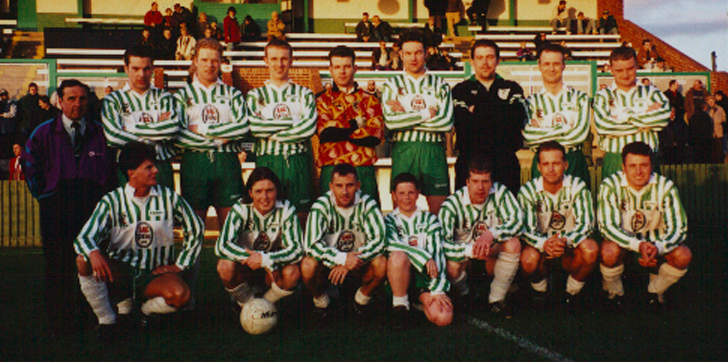 Back Row L to R –
Back Row L to R –
Tony Kennedy Kitman, Jason Jones, Tommy Ditchburn, Warren Teasdale,
Paul O’Connor, John Gamble, Kevin Wolfe, Graham Curry, Paul Cooper.
Front Row L to R –
Richie Bond, Mark Telford, Steve Pyle, unknown mascot, Steve Harkus,
Laurie Pearson, Gary Hays.
*Taken on Saturday 25th March 1995 before the 3-0
home NPL win over Fleetwood.
 Back Row L to R –
Back Row L to R –
Tony Kennedy Kitman, Dave Robertson Physio, Stephen Raffell, Warren Teasdale,
John Gamble, Paul O’Connor, Tommy Ditchburn, Kevin Wolfe, Jason Jones,
Steve Harkus, Graham Curry, Paul Cooper, Harry Dunn Manager,
Gerry Jones Unibond League Referee’s Secretary.
Front Row L to R –
James Bratt Senior Sales Rep for Unibond, Richie Bond, Glen Maxwell Mascot,
Steve Pyle, Laurie Pearson Gary Hays, Steve Houlden.
*Taken on Saturday 22nd April 1995 before the 2-1 home NPL win over
Workington, presentation made for being March team of the Month.
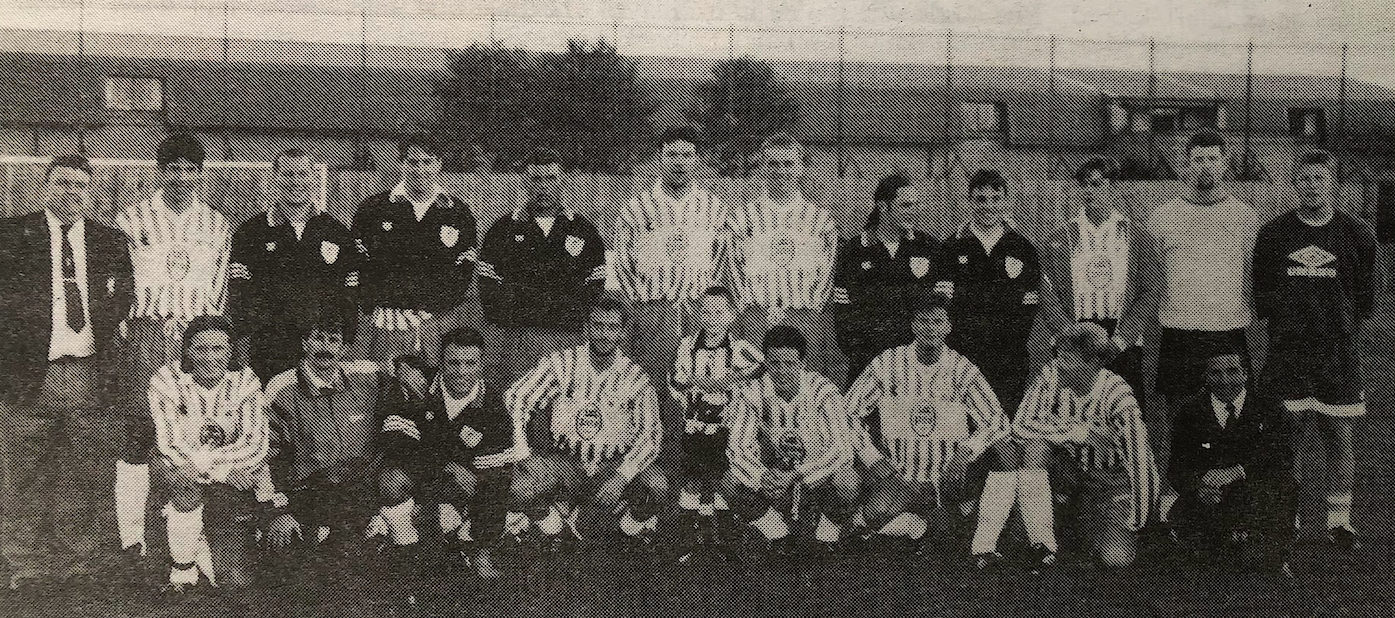 Back Row L to R –
Back Row L to R –
John Broadhead club official, Unknown player, Stephen Raffell, Shaun Dunn,
Unknown player, John Gamble, Warren Teasdale, Stephen Plaskett, Glen Renforth,
Paul Gough, Unknown player, Simon Smith.
Front Row L to R –
Mark Telford, Harry Dunn Manager, Gary Hays, Steve Pyle, unknown mascot,
John Sokoluk, Richie Bond, Don Peattie, Tony Kennedy Kitman.
*Taken on Saturday 30th July 1994 following 0-1 home defeat
to Hamilton Academicals in pre season friendly.
1993/94 –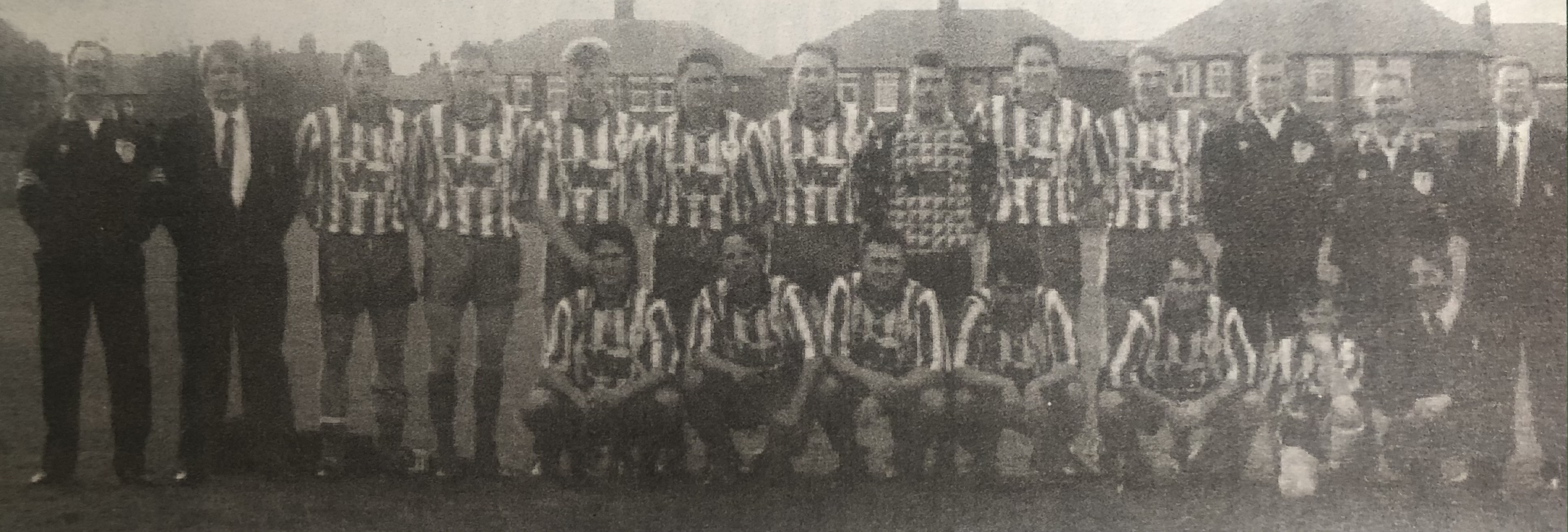 Back Row L to R –
Back Row L to R –
Dave Robertson Physio, Dave Holland Club Official, Keith Mills, Craig Liddle,
Don Peattie, John Holvey, Dave Hallam. Paul O’Connor, Shaun Dunn, Warren Teasdale,
Steve Raffell, Peter Feenan Manager, Jim Telford Chairman.
Front Row L to R –
Kevin Caizley, Mickey English, Gary Hays, Tony Burgess, Steve Pyle,
Unknown mascot, Tony Kennedy Kitman
*Taken on Tuesday 26th April 1994 at Croft Park before 1-0 win
over Blue Star in Northumberland Senior Cup Final. Back Row L to R –
Back Row L to R –
Tommy Hedley Official, Thomas Halliday Official, Dave Robertson Assistant Manager,
Keith Mills, Mark Cameron, Warren Teasdale, Steve Raffell, Paul Connor, Craig Liddle,
Dave Hallam, Gary Hays, Unknown Physio, Tony Kennedy Kitman, Bob Cotterill Official.
Front Row L to R –
Mickey English, Jim Harland Club Media Official, Gary Middleton, Mark Telford,
Dave Holland Official, Peter Feenan Manager, Jim Telford Chairman, Don Peattie,
Steve Pyle, Tony Burgess, Darren Palmer.
*Taken before 1993/94 Northern League started, shield is from Beamish Tournament
played during the summer at the museum featuring local sides.
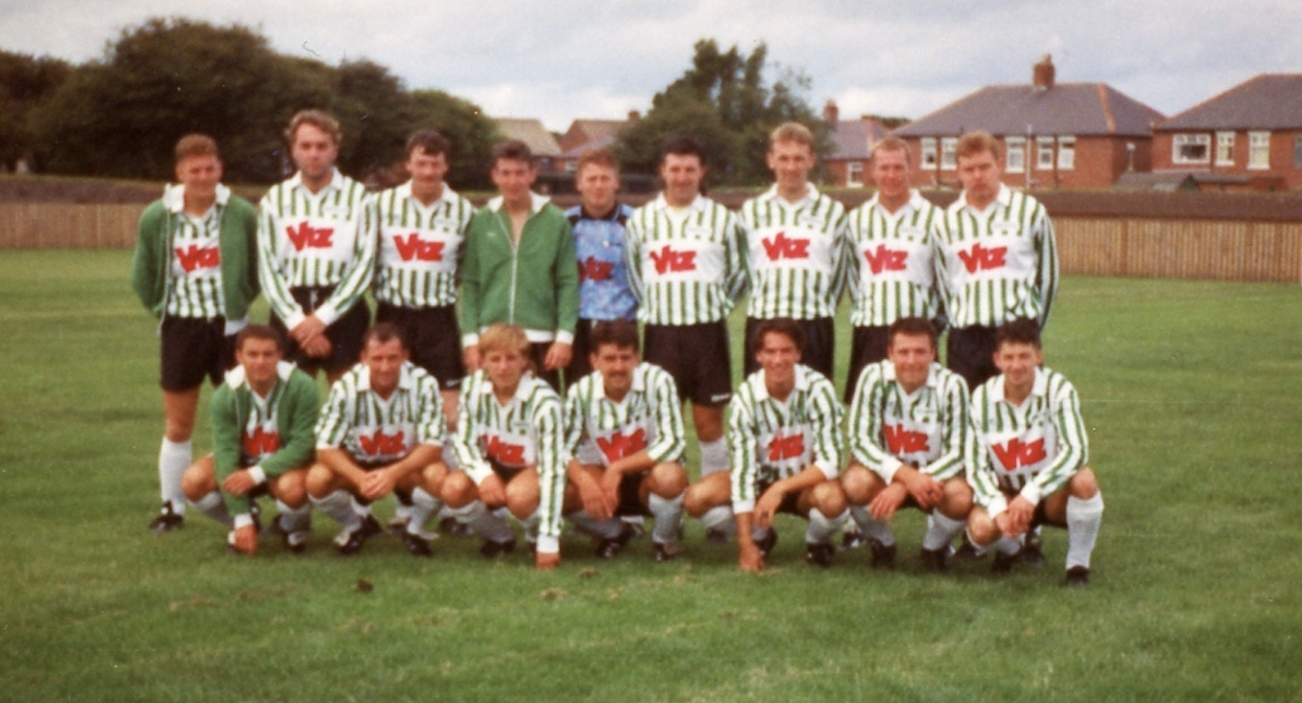 Back Row L to R –
Back Row L to R –
Unknown player wearing tracksuit top, Dave Hallam, Keith Mills,
Unknown player wearing tracksuit top, Unknown goalkeeper, Mark Cameron,
Warren Teasdale, Stephen Raffell, Craig Liddle.
Front Row L to R –
Unknown player wearing tracksuit top, Steve Pyle, Michael English, Tony Burgess,
Gary Middelton, Gary Hays, Graham McDonald.
*Taken on Saturday 25th July 1983 before 1-1 draw with Airdrieonians
in pre season friendly at Croft Park.
1992/93 –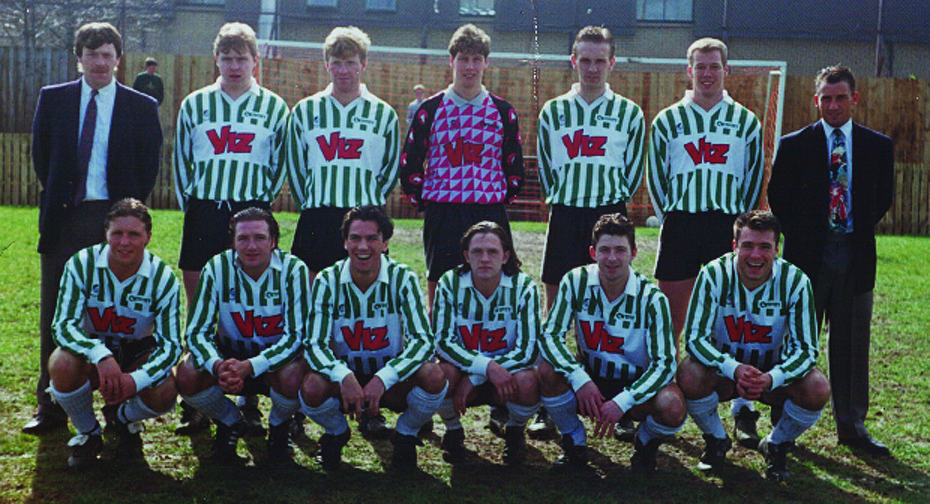 Back Row L to R –
Back Row L to R –
Keith Mills, Craig Liddle, Don Peattie, Peter Gardener, Warren Teasdale,
Stephen Raffell, Steve Pyle.
Front Row L to R –
Mark Telford, Darren Nicholls, Gary Middleton, Stephen Plaskett,
Graham McDonald, Gary Hays.
*Taken Saturday 10th April 1993 before 4-2 Northern League
home win over Chester-le-Street.
1993 –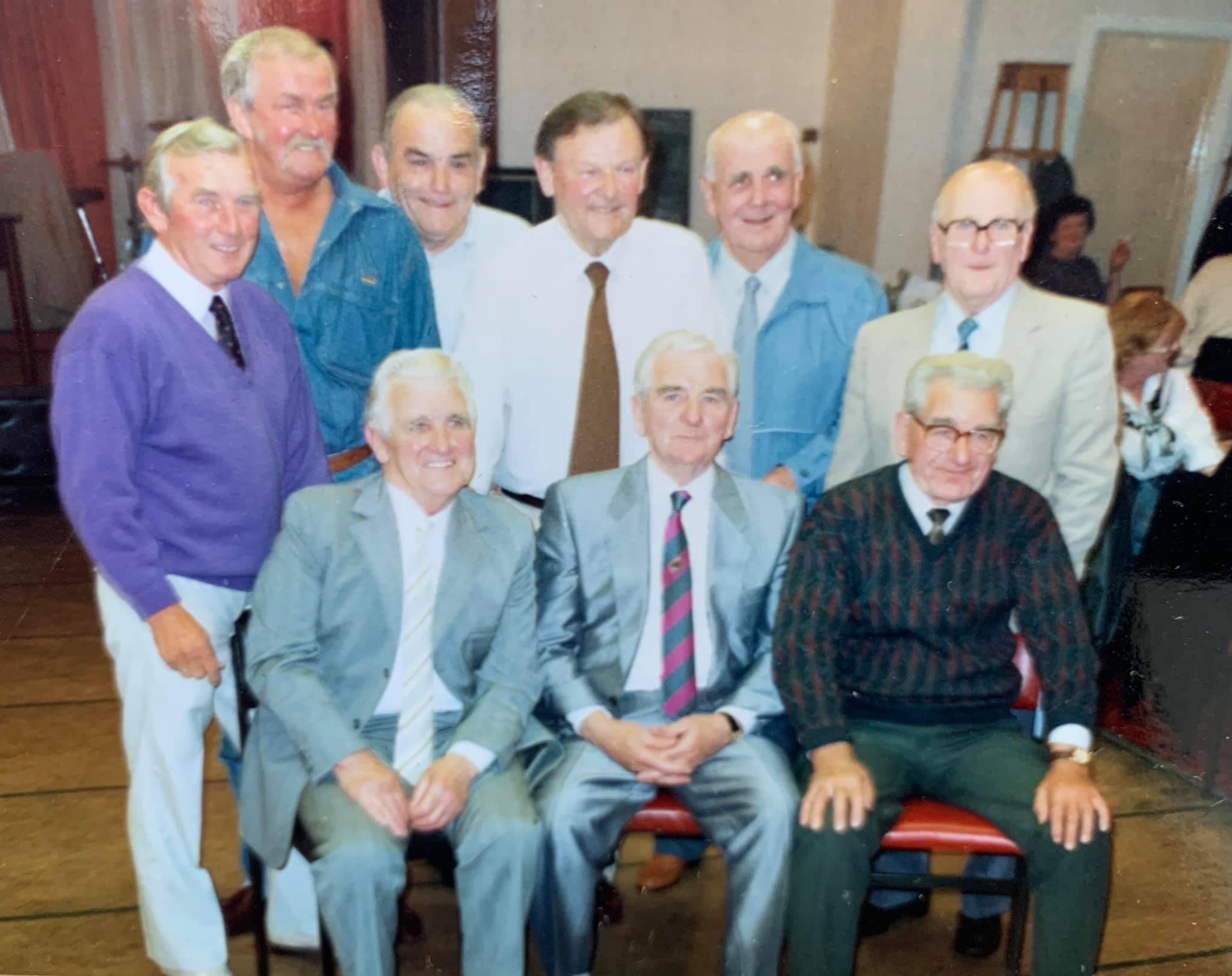
Back Row L to R –
Eddie Turney, Tommy Reay, Jackie Hogg, Arthur Sowden,
Eddie Ramsey, Norman Penrose.
Front Row L to R –
Jackie Turney, Jimmy Turney, Billy Fenwick.
*Taken at a reunion for the 1950’s Blyth players.
 Back Row L to R –
Back Row L to R –
Dave Robertson Asstant Manager/Physio, Ronnie Walton Manager, Stephen Raffell,
Warren Teasdale, Danny Wheatley, Peter Gardener, Craig Liddle, Paul Leavey,
Kieth Mills, Steve Pyle, Nigel Walker Player/Assistant Manager.
Front Row L to R –
Graham McDonald, Gary Hays, Gary Middleton, Neil Howie, Stephen Plaskett,
Darren Nichols, Phil Mason, Don Peattie.
*Taken Saturday 7th November 1992 before 2-1 Northern League home win
over West Auckland. Taken ahead of FA Cup 1st Round game to be used in
local paper feature on the game.
April 1992 – Back Row L to R –
Back Row L to R –
Gerry Day, John ‘Eddie’ Alder, Steve Carney, Dave Clarke, Ronnie Scott,
David Varty, John Waterson, Keith Houghton, Paul Ross.
Front Row L to R –
John Evans, Terry Johnson, Steve ‘Jos’ Jones, Alan Shoulder, Mick Dagless,
Ian Mutrie, Rob Carney.
*Taken on Thursday 30th April 1992 at Croft Park.
A Blyth 77/78 XI beat a Select XI 3-1 in a Memorial/Charity match for
the late former Spartan Dave Mitchenson. Game was organised by Les Mutrie.
1992/93 –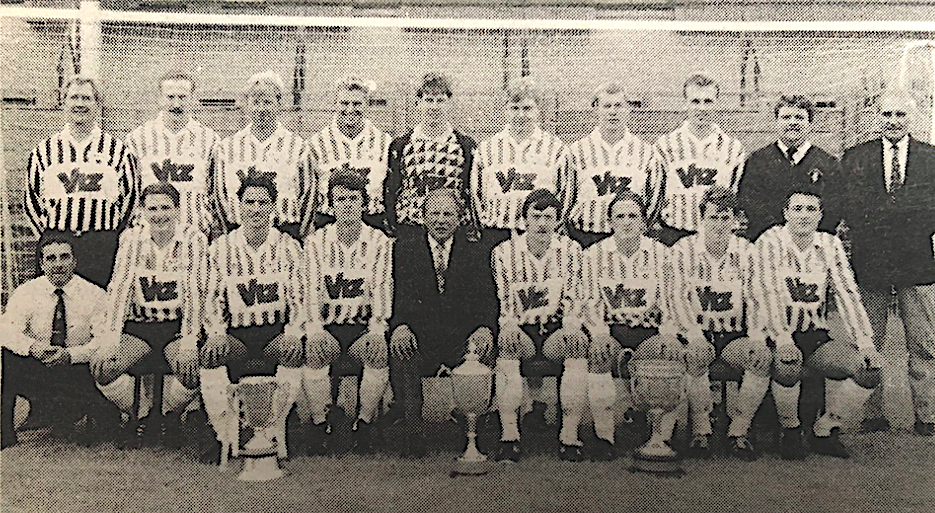
Back Row L to R –
Dave Robertson Assistant Manager/Physio, Nigel Saddington, Don Peattie, Paul Jeffries,
Peter Gardener, Craig Liddle, Stephen Raffell, Warren Teasdale,
Bob Cotterill club official, Bill Lowery club official.
Front Row L to R –
Tony Kennedy Kitman, Darren Nicholls, Gary Middleton, Nigel Walker,
Ronnie Walton Manager, Keith Mills, Stephen Plaskett, David Scope, Gary Hays.
*Taken Saturday 15th August 1992 before 2-1 Northern League home win over
Brandon United. Trophies are JR Cleator Cup won 12/8/1992, Northern League Cup
& Northumberland Senior Cup won the previous 91/92 season.
1987/88 –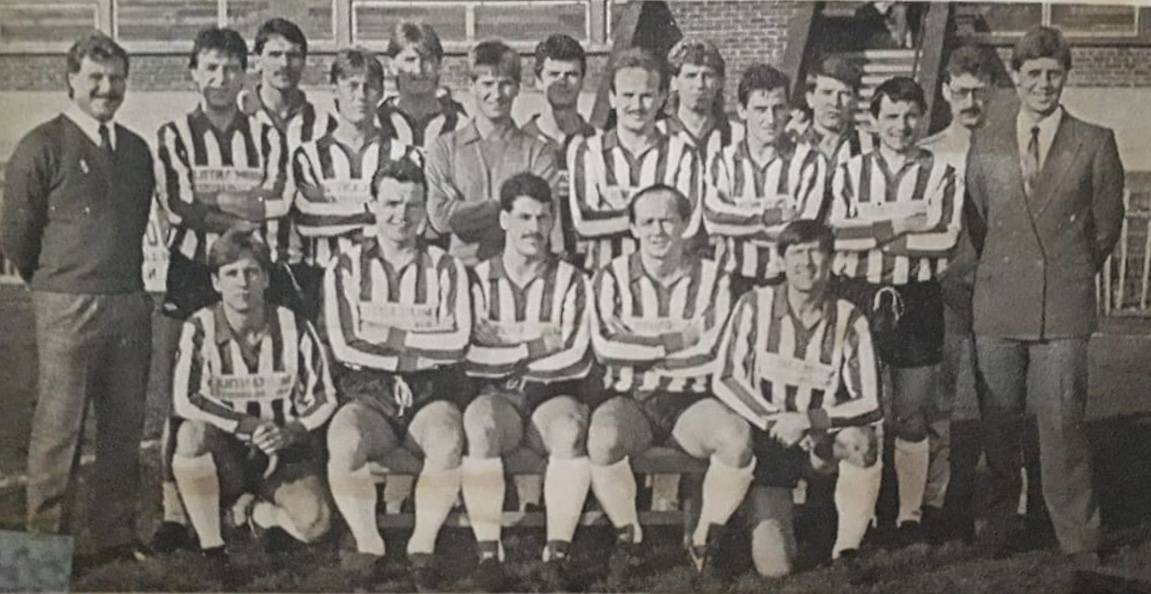
Back Row L to R –
Dave Clarke Assistant Manager/Player, Steve Carney, Jimmy Harrison, Gary Nicholson,
Kevin Berry, Brian Hayes, Nigel Walker, Craig Mordue, Alan Walker, Steve Pyle,
Phil Leaver, Peter Cartwright, Chris Tate Physio, Jim Pearson Manager.
Front Row L to R –
Neil Howie, Steve Baxter, Tony McFadden, Paul Walker, Dave Varty.
*Taken before the 1987/88 Northern League season started.
1986/87 –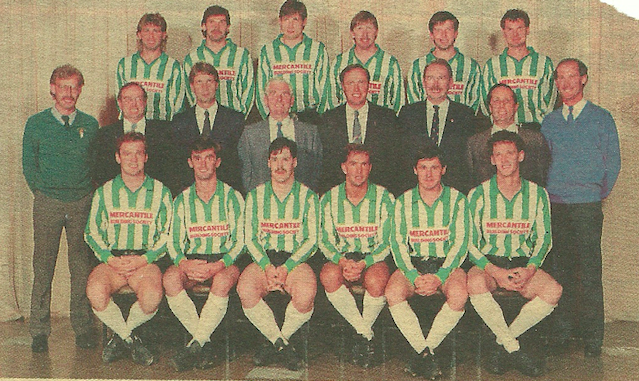 Back Row L to R –
Back Row L to R –
Alan Walker, Jimmy Harrison, Chris Scott, John Brownlie, Phil Leaver, Ray Blackhall.
Front Row L to R –
Chris Tate Physio, Mike Turnbull Club Development Manager, Jim Pearson Manager,
Jim Turney Chairman, G. Robinson Chief Executive Mercantile BS,
J. Dickson Development Manager Mercantile BS,
George Watson Club Secretary, Fred Turnbull Assistant Manager.
Front Row L to R –
Steve Baxter, Steve ‘Jos’ Jones, Tony McFadden,
Tony Dawson, Peter Cartwright, Ronan Liddane.
*Taken during the 1986/87 as publicity for the club new shirt
sponsorship deal with Mercantile Building Society.
• Photo taken by Margaret Eagle of Tynephoto, Bedlington in the Croft Park
Social Club, only ever appeared in the local Courier Newspaper.
 Back Row L to R –
Back Row L to R –
Fred Turnbull Assistant Manager, Tony McFadden, John Brownlie, Tony Dawson,
Ronan Liddane, Phil Leaver, Paul Walker, Kevin Berry, Peter Cartwright,
Chris Scott, Jim Pearson Manager.
Front Row L to R –
Dave Clarke, Gary Middleton, Ray Blackhall, Steve ‘Jos’ Jones,
Alan Walker, Steve Baxter, Richard Hartiss.
*Taken before the 1986/87 Northern League season started.
1985/86 – Back Row L to R –
Back Row L to R –
Phil Leaver, Tony Dawson, Ronan Liddane, Dave Clarke, Alan Walker,
Kevin Berry, Jimmy Harrison, John Brownlie.
Front Row L to R –
Steve Baxter, Dave Buchanan, Tony McFadden, Ray Blackhall,
Peter Cartwright, Paul Walker.
*Taken Saturday 8th April 1986 before 3-0 Northern League
home win over Crook Town.
• Image only ever appeared on the Coal News, a National Coal Board
magazine which featured an article on Blyth players and officials
who worked in the Coal industry.
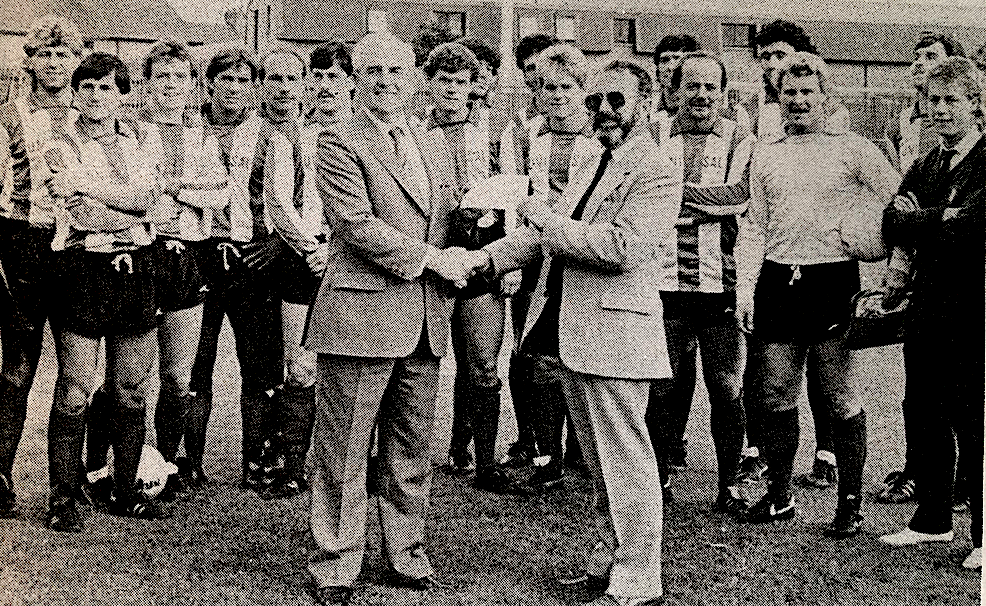 L to R –
L to R –
Alan Walker, Peter Cartwright, Steve Baxter, Tony Dawson, Paul Hedley, Tony McFadden,
Jim Turney Chairman, Ray Blackhall, Warren Pearson partially hidden by Blackhall,
Ronan Liddane partially hidden by Mickey Taylor,
Tony Wilder Universal Building Society, Chris Guthrie partially
hidden by Paul Walker, Unknown partially hidden by Dave Clarke,
Jimmy Harrison, Dave Buchanan (arms folded).
*Taken Tuesday 6th August 1985 before 0-4 home pre season
friendly defeat by Northampton Town.
• Chairman Jim Turney received sponsorship cheque from
Tony Wilder Universal Building Society General Manager
having renewed their deal for a fourth successive year.
1984/85 –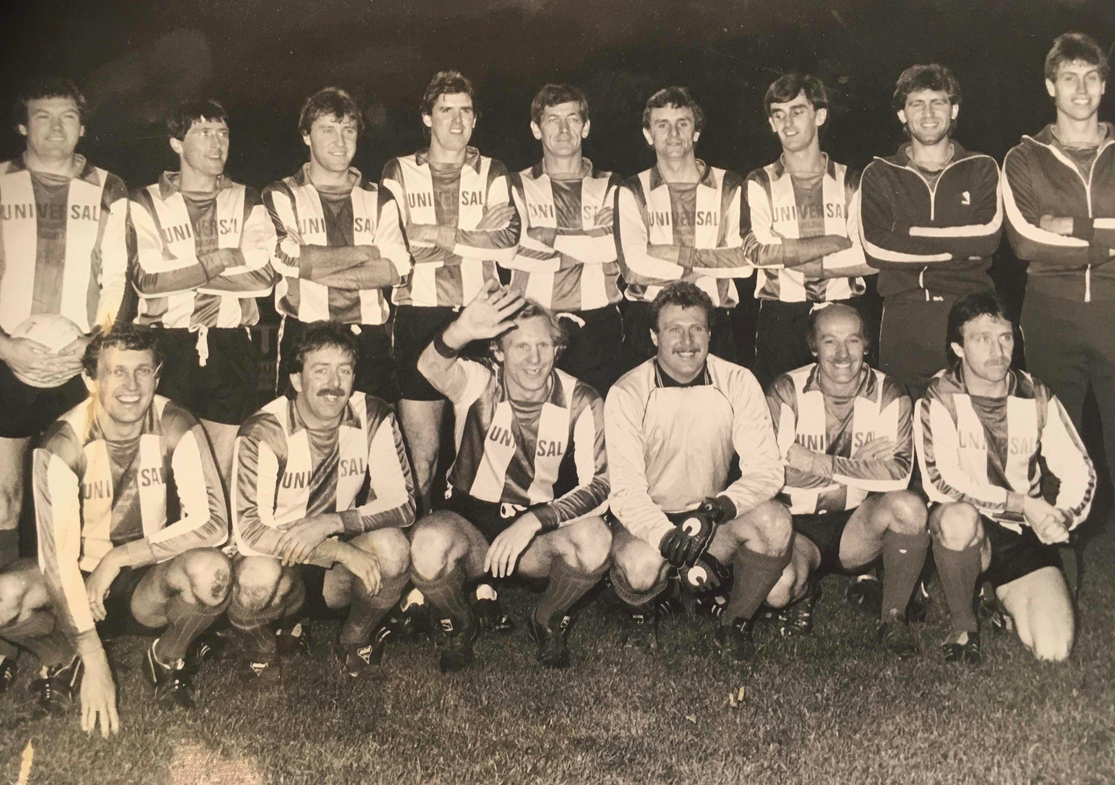
Back Row L to R –
Ron Guthrie, Dave Varty, Steve Carney, Ian Mutrie, Ronnie Scott, Rob Carney,
Steve ‘Jos’ Jones, Alan Walker, Dave Mitchenson.
Front Row L to R –
John Waterson, Terry Johnson, Tommy Dixon, Dave Clarke,
John ‘Eddie’ Alder, Alan Shoulder.
*Taken on Tuesday 6th November 1984 before Tommy Dixon’s Testimonial
game against Newcastle United XI.
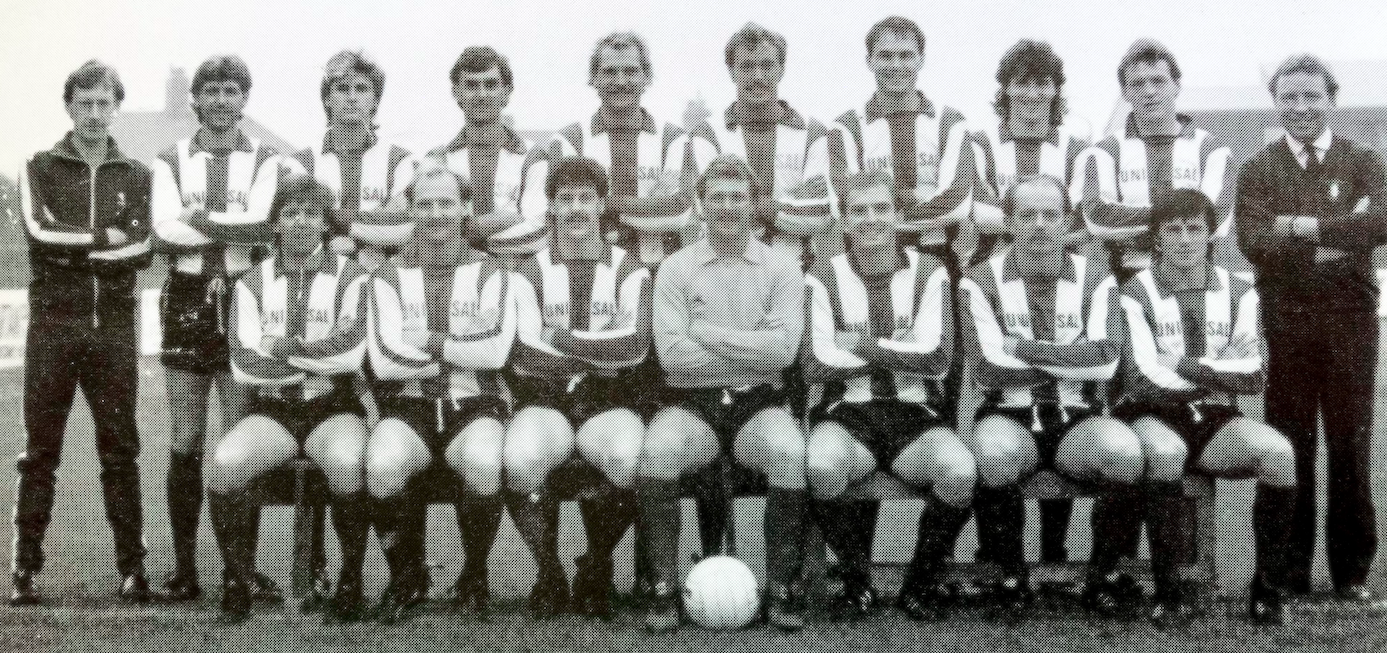 Back Row L to R –
Back Row L to R –
Chris Tate Physio, Alan Walker, Paul Grigg, Steve Jones, Bobby Scaife, Dave Dixon,
Peter Robinson, Dave Callaghan, Steve Baxter, Peter Feenan Manager.
Front Row L to R –
John Stirk, Colin Chambers, Tony McFadden, Dave Clarke,
Geoff Hart, Paul Walker, Peter Cartwright.
*Taken before start of the 1984/85 Northern League season.
1983/43 –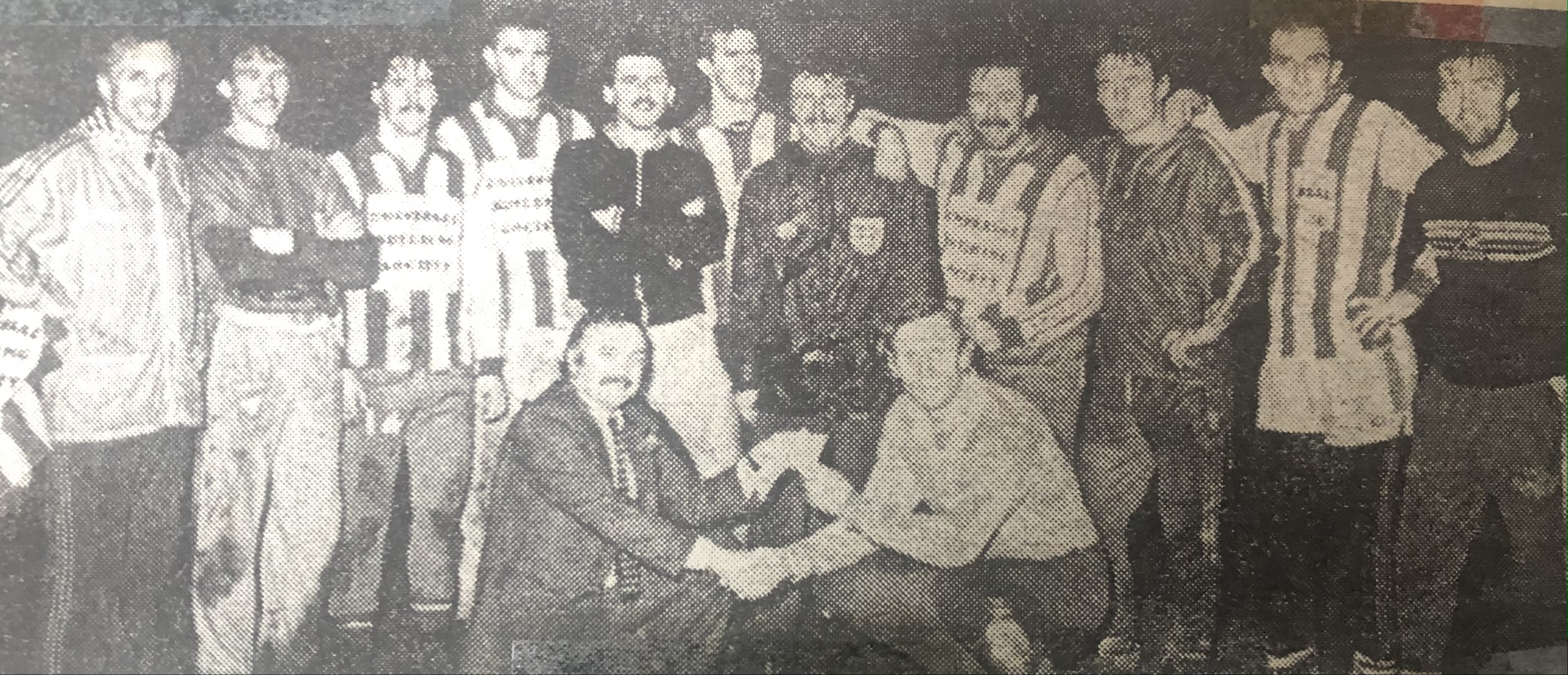
Back Row L to R –
Mick Dagless Manager, Ian Chester, Tony McFadden, Peter Robinson, Alan Walker,
Ian Mutrie, Dave Clarke, Terry Johnson, Steve Baxter, Geoff Hart, John Stirk.
Front Row L to R –
Unknown Dryboroughs official, Tommy Dixon
*Taken on Tuesday 22nd November 1983 at Croft Park training session where team
captain Tommy Dixon was presented with cheque from Northern League
sponsors Dryboroughs Brewery. League ran a goalscoring reward scheme which
Blyth won for the 6-2 home win over Gretna 3 days earlier.
1982/83 –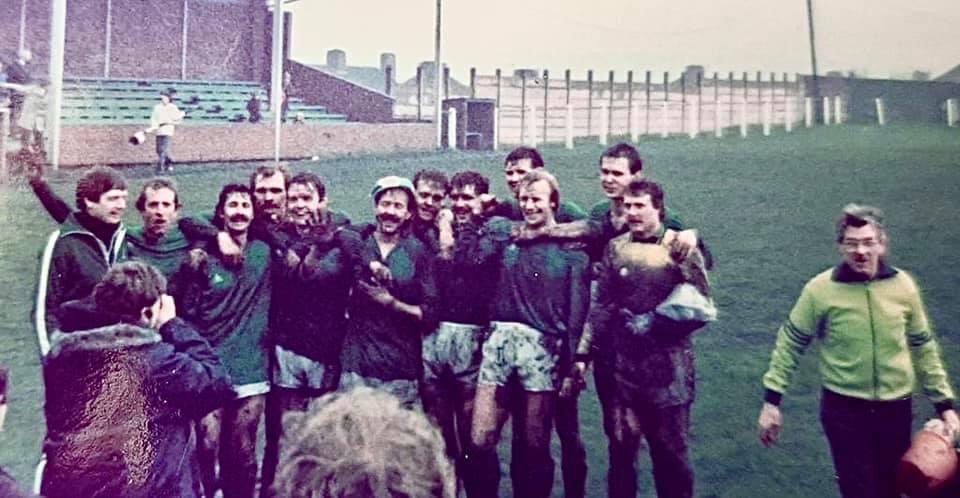
Left to Right –
Tony Britt Assistant Manager, John Connolly Player/Manager, Harry Dunn,
Bobby Scaife, Steve Baxter, Terry Johnson, Ian Chester, Alan Walker, Ian Mutrie,
Tommy Dixon, Peter Robinson, Dave Clarke, Pat Smith Physio.
*Taken on Saturday 30th April 1983 at Ironworks Ground, Tow Law.
• This unique image captures the players, officials & fans celebrating winning
a 4th consecutive Northern League title with an empathic 9-1 win.
 Back Row L to R –
Back Row L to R –
John Connolly Player Manager, Tony Britt Assistant Manager, Bobby Scaife, Alan Walker
Dave Clarke, Ian Mutrie, Dave Mitchenson, Peter Robinson, Pat Smith Physio.
Front Row L to R –
Phil Robson, Tommy Dixon, Geoff Hart, Harry Dunn, Steve Baxter, Terry Johnson.
*Taken on Saturday 29th January 1983 before 1-0 Northumberland Senior Cup
Quarter Final home win over Ashington.
 Back Row L to R –
Back Row L to R –
Brian Lintern, Jeff Peters, Peter Robinson, Paul Ross, Dave Clarke,
Dave Mitchenson, Bobby Scaife, Ian Mutrie, Geoff Hart, Don Robson.
Front Row L to R –
Keith Brown, Harry Dunn, Bob Elwell Manager, Tommy Dixon,
Paul Walker, Alan Walker.
*Taken on Tuesday 18th September 1982 before 0-0 home Northern League
draw with Consett. Trophies are JR Cleator Cup, Northern League title,
Northern League Cup & Northumberland Senior Cup.
 Back Row L to R –
Back Row L to R –
Paul Ross, Tommy Dixon, Dave Mitchenson, Geoff Hart, Alan Walker,
Bobby Scaife, Dave Clarke.
Front Row L to R –
John Duncan, Kevin Pugh, Terry Johnson, Harry Dunn, Jamie Scott, Keith Brown.
*Taken Thursday 29th July 1982 before pre season friendly
1-3 home defeat by Hearts of Midlothian.
1981/82 –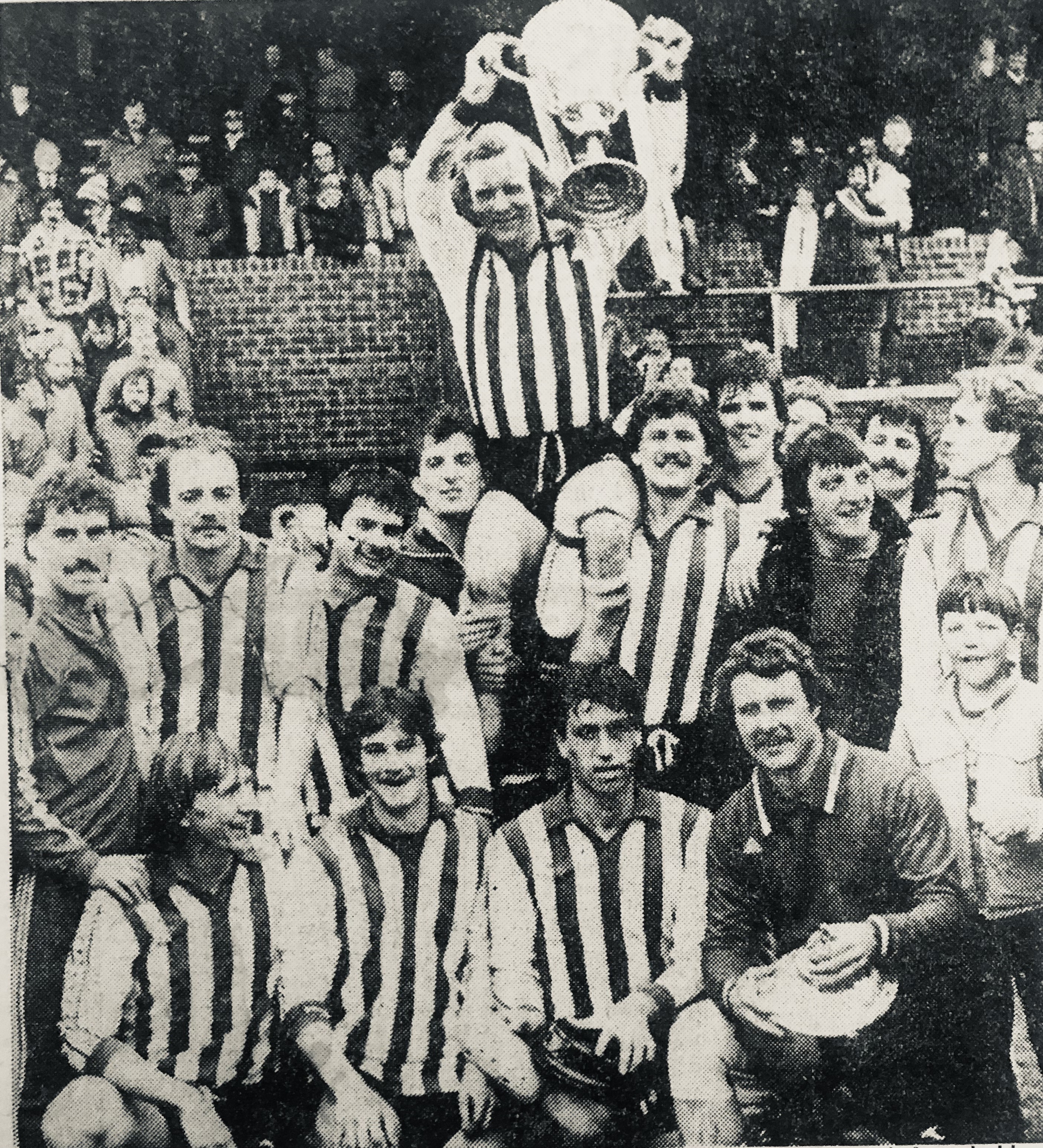 Back Row L to R –
Back Row L to R –
Brian Phillips, Paul Walker, Jeff Peters, Geoff Hart, Tommy Dixon with trophy,
Alan Walker, Ian Mutrie, unknown supporter, Harry Dunn, Paul Hedley,
Front Row L to R –
Keith Brown, Brian Lintern, Dave Mitchenson, Dave Clarke, unknown supporter.
*Taken Saturday 1st May 1982 at Croft Park following 4-1 win over
Whitley Bay which sealed a 3rd consectutive Northern League title.
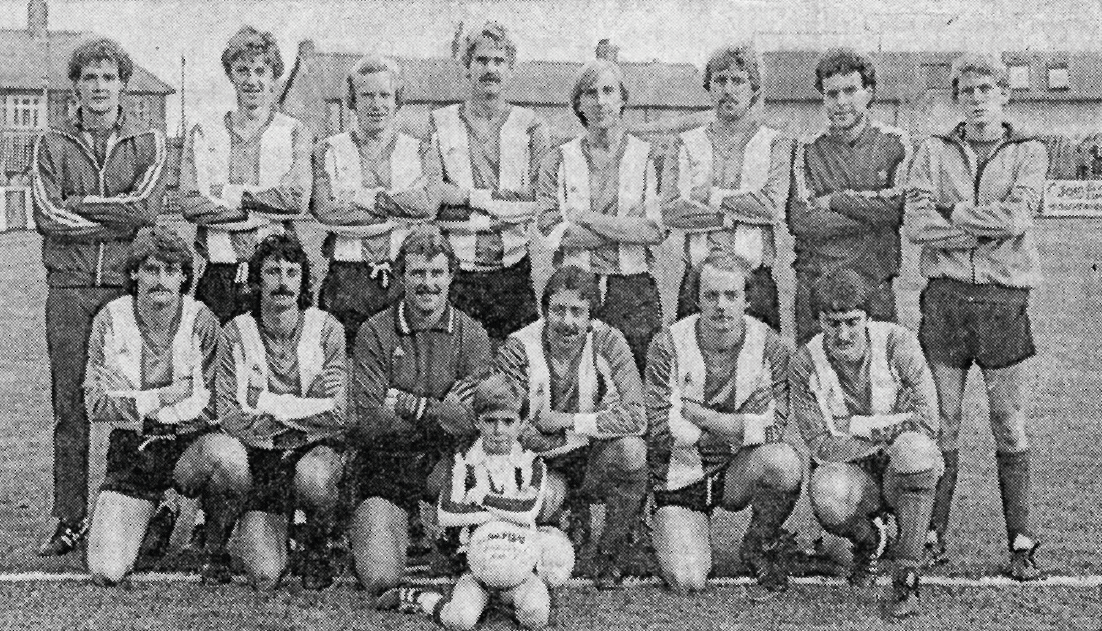
Back Row L to R –
Stephen Grierson, Paul Ross, Tommy Dixon, Mickey Anderson, Keith Brown,
Alan Walker, Brian Coulson, Peter Embleton.
Front Row L to R –
Bill Rafferty, Harry Dunn, Dave Clarke, Unknown mascot, Terry Johnson,
Paul Walker, Jimmy Cochrane.
*Taken Tuesday 1st September 1981 before first home league
game of the new season, 0-0 draw with Crook Town.
• Players wearing new the Le Coq Sportif kit for that season.
 Back Row L to R –
Back Row L to R –
Ron Guthrie, Peter Manners, Tommy Dixon, Paul Ross,
Dave Mitchenson, Alan Walker, Paul Walker, Keith Brown.
Front Row L to R –
Jimmy Cochrane, Terry Johnson, Dave Clarke with unknown mascot,
Billy Rafferty, Alan Barker, Harry Dunn.
*Taken Tuesday 28th July 1981 before home friendly
with Hearts of Midlothian, lost 1-3.
1980/81 –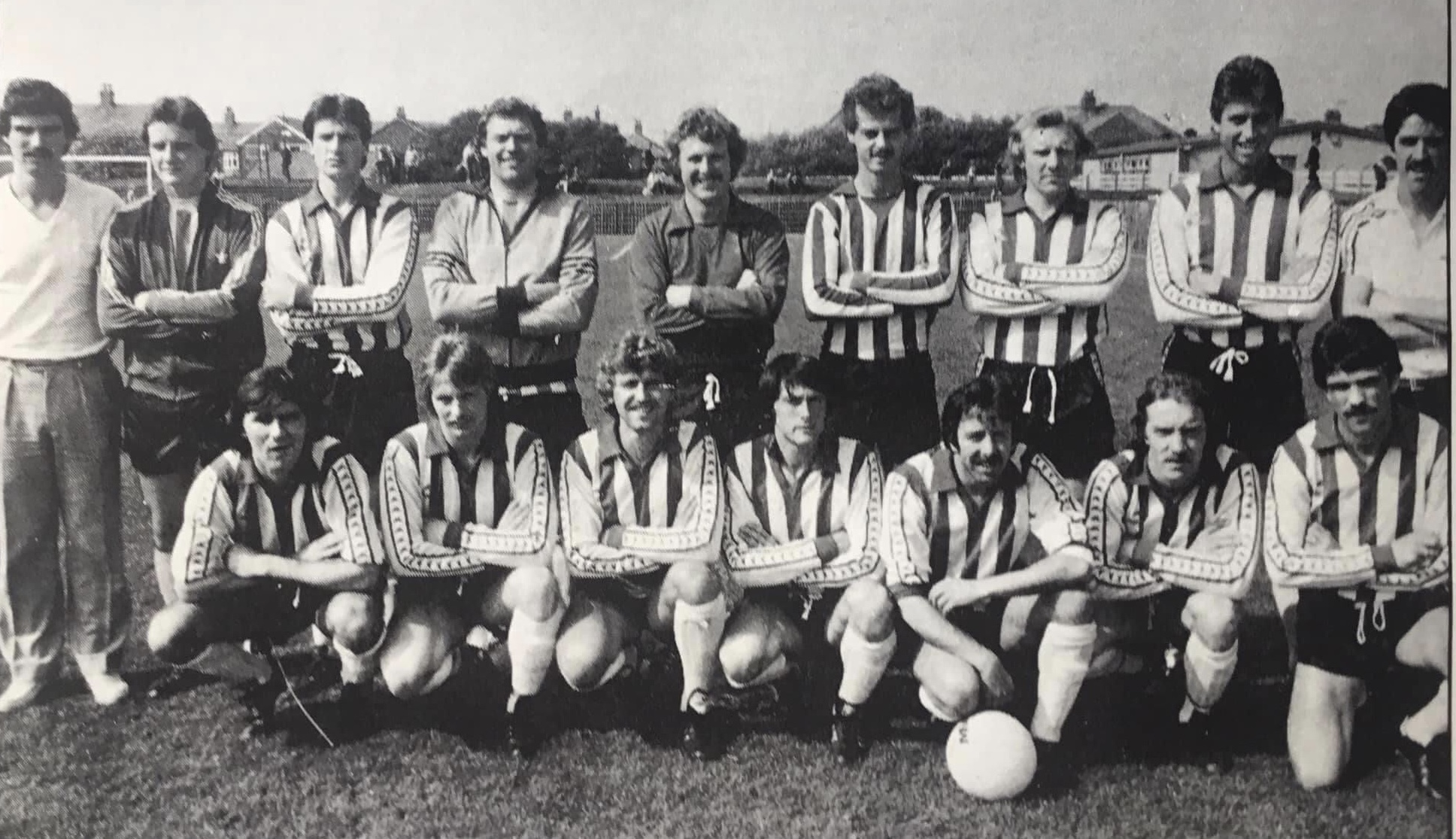
Back Row L to R –
Gerry Hogan, Stuart Greison, Gordon Larkin, Ron Guthrie, Dave Clarke,
Stephen Golightly, Dave Mitchenson, Terry Boylan.
Front Row L to R –
Les Mutrie, Geoff Fell, Alan Walker, Dave Varty, Terry Johnson,
Tommy Waugh, Alan Barker.
*Taken on Saturday 16th August 1980 before opening game of
Northern League season, a 0-2 home defeat by Consett.
1979/80 –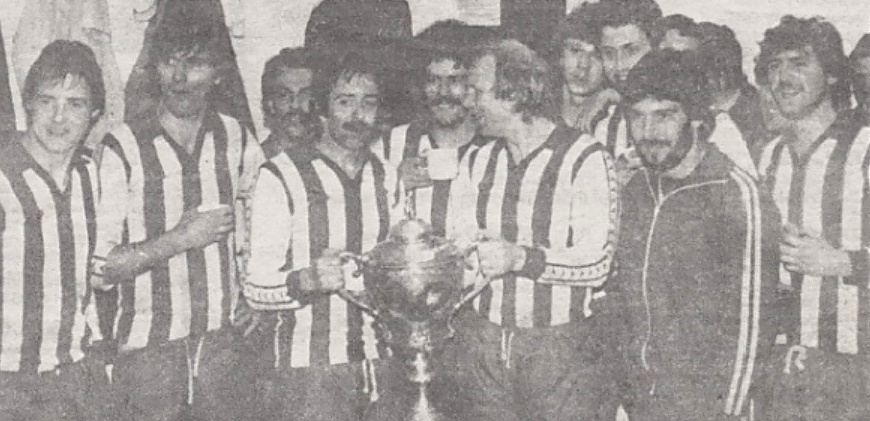
L to R –
Stuart Grierson, Les Mutrie, Ian Diamond, Terry Johnson, Jimmy Nesbitt,
Tommy Dixon, Paul Ross, Dave Mitchenson, Peter Davies, Alan Walker.
*Taken on Tuesday 29th April 1980 in Croft Park changing room following
2-1 win over West Auckland that sealed the Northern League title
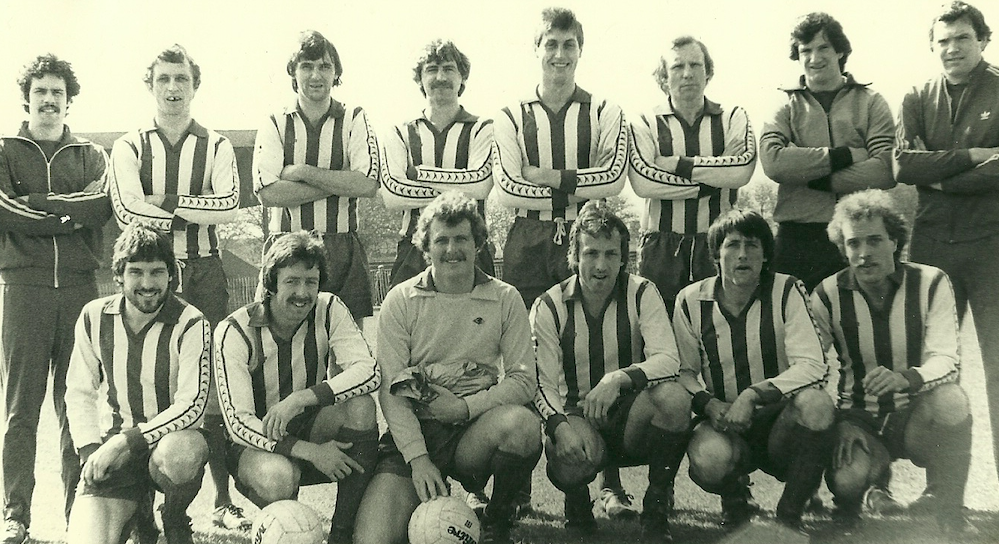 Back Row L to R –
Back Row L to R –
Jimmy Nesbitt, John Waterson, Les Mutrie, Alan Walker, Dave Mitchenson,
Tommy Dixon, Ray Young, Ron Guthrie.
Front Row L to R –
Peter Davies, Terry Johnson, Dave Clarke, Mick Dagless, Dave Varty, Brian Burlinson.
*Taken Saturday 19th April 1980 before 1-0 home win
over North Shields in Northern League.
 Back Row L to R –
Back Row L to R –
John Waterson, Tommy Dixon, Alan Walker, Les Mutrie, Dave Mitchenson,
Paul Ross, Ray Young.
Front Row L to R –
Peter Davies, Ron Guthrie, Brian Burlinson, Jimmy Nesbitt, Dave Clarke,
Mick Dagless, Ian Diamond, Dave Varty.
*Taken Saturday 5th April 1980 before 6-1 Northern League home
win over North Shields.
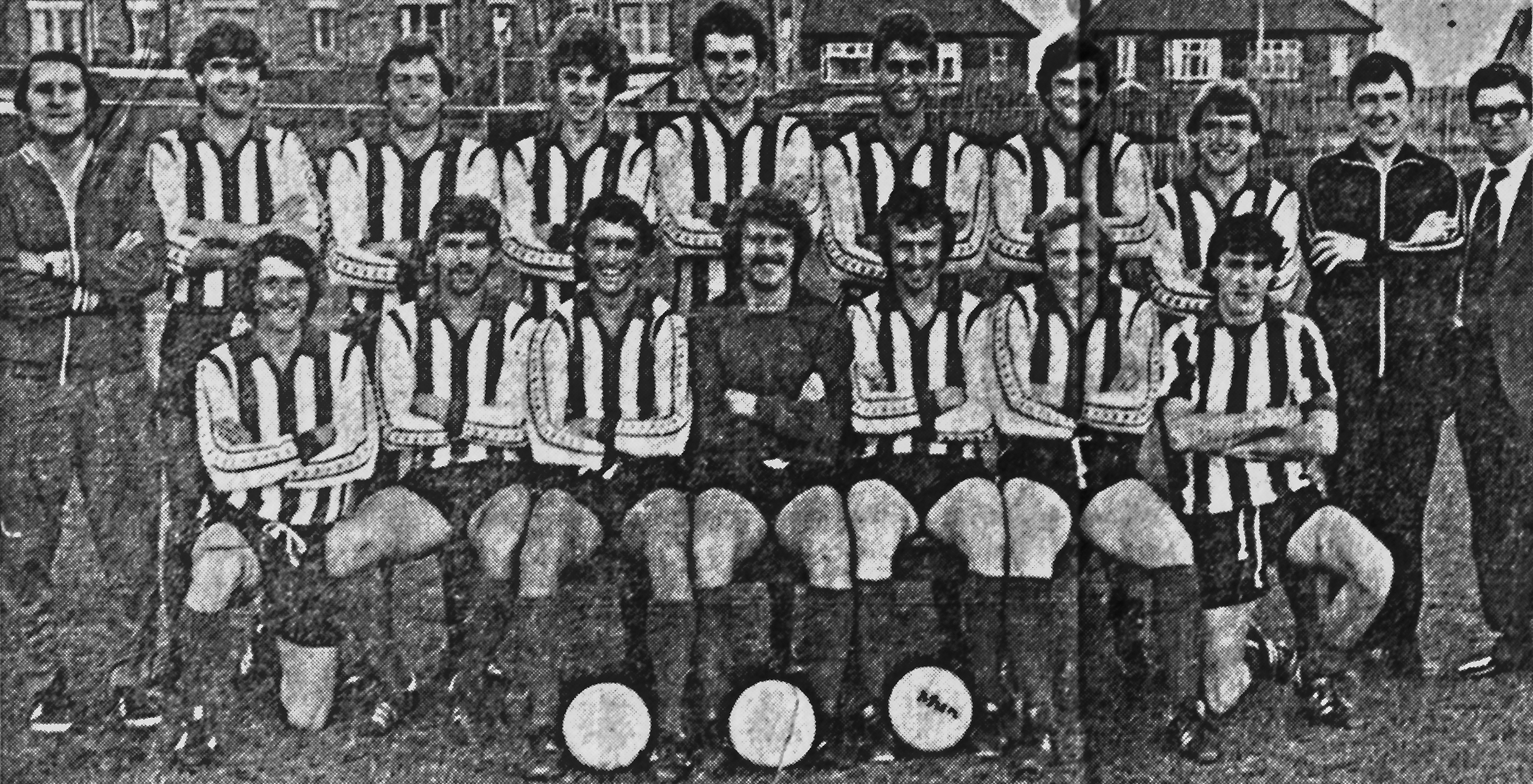 Back Row L to R –
Back Row L to R –
Jackie Marks Manager, Les Mutrie, Ron Guthrie, Paul Ross, Keith Houghton,
Dave Mitchenson, Ray Young, Peter Faulkener,
Peter Flaherty Assistant Manager, Pat Smith Physio.
Front Row L to R –
Dave Varty, Alan Walker, John Waterson, Dave Clarke, Mick Dagless,
Tommy Dixon, Steve Carney.
*Taken in September 1979 just before Steve Carney joined Newcastle United.
 Back Row L to R –
Back Row L to R –
Dave Varty, Paul Ross, Keith Houghton, Les Mutrie,
Dave Mitchenson, Alan Walker.
Front Row L to R –
Bobby Doig, Rob Hulse, Dave Clarke, Mick Dagless, Peter Faulkener.
*Taken Saturday 11th August 1979 before 2-0 home win over
Maidstone United in pre season friendly.
1978/79 –
L to R –
Dave Clarke, Alan Walker, Mick Dagless, Paul Ross, Les Mutrie, Jackie Marks Manager,
Terry Johnson, Peter Davies, John Waterson, Dave Varty, Steve Carney.
*Taken in Social Club on Tuesday 1st May 1979, with players & manager showing
the trophies and awards won over the 77/78 & 78/79 seasons.
Dave Clarke is holding his prize as Non League Goalkeeper of the Year.
Other trophies include Debenhams Cup, Northern League Cup, Northern League Runners Up Cup,
Non League Team of the Team, Highest Scorers Trophy, Vaux Team of the Year, Tyne Tees Team of the Year, FA Team of the Year, an FA Cup Award, plus pennants saluting the run to 5th Round of FA Cup.
1977/78 –
Back Row L to R –
J.W Chandler Mayor of Blyth, Terry Day, Dave Varty, Gregg Heron,
Dave Clarke, Ian Mutrie, Terry Johnson, Steve ‘Jos’ Jones, Rob Carney,
Pat Smith Physio, Ron Guthrie (partially hidden), Billy Fenwick Trainer,
Brian Slane Player/Manager, Ronnie Scott.
Front Row L to R –
John Waterson, Tommy Dixon, Dave Addison, Alan Shoulder, Mick Dagless.
*Taken 7th March 1978 at the Coronation Club, Blyth during a Civic Reception
held by Borough of Blyth Valley in recognition of achievements in 77/78 FA Cup.
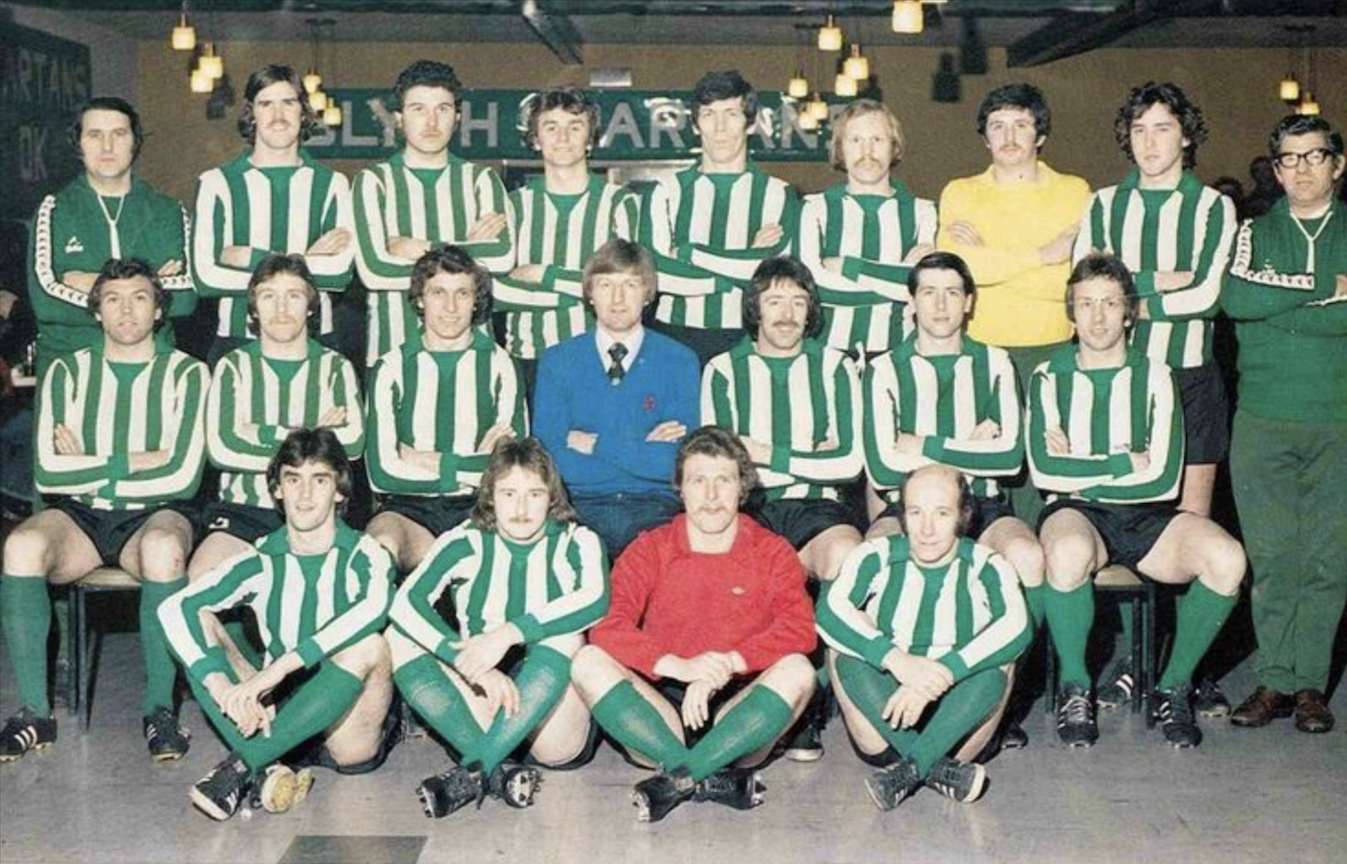 Back Row L to R –
Back Row L to R –
Jackie Marks Coach/Assistant Manager, Ian Mutrie, Keith Houghton, Rob Carney,
Ronnie Scott, Tommy Dixon, Dave Addison, Steve Carney, Pat Smith Physio.
Middle Row L to R –
Ron Guthrie, Alan Shoulder, John Waterson, Brian Slane Player/Manager,
Terry Johnson, Dave Varty, Mick Dagless.
Front Row L to R –
Steve ‘Jos’ Jones, Terry Day, Dave Clarke, John ‘Eddie’ Alder.
*Taken during the cup run inside Croft Park’s Social Club.
* Probably the most famous and well known colour team photo. Picture appeared
in the programme for the FA Cup 5th Round Replay at James’ Park.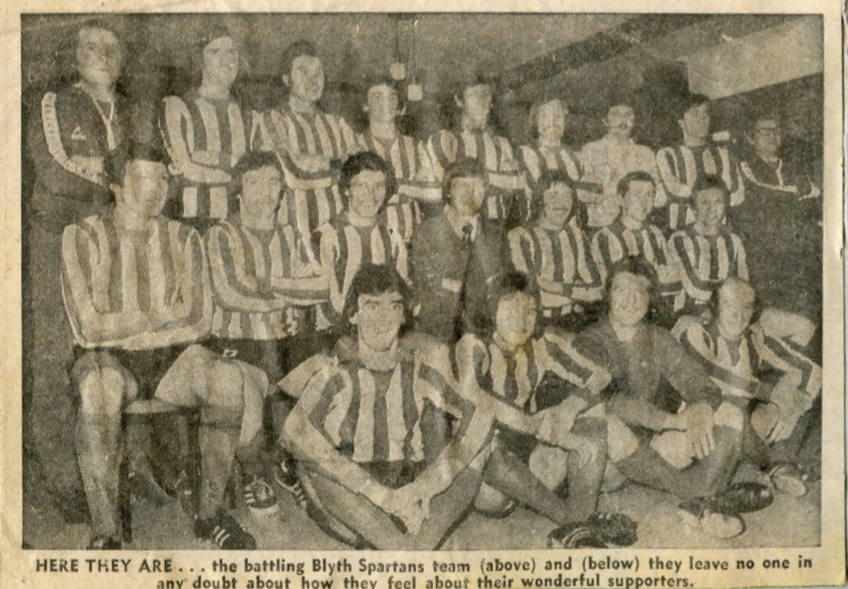 • This version taken at the same time but from an angle appeared in the
• This version taken at the same time but from an angle appeared in the
Evening Chronicle in the build up to the 5th Round Replay at St James’ Park.

• The image was also used on a Carlsberg billboard advert outside St James’ Park in 2000
attempting to draw Newcastle United supporters to Blyth games when Newcastle were playing away.
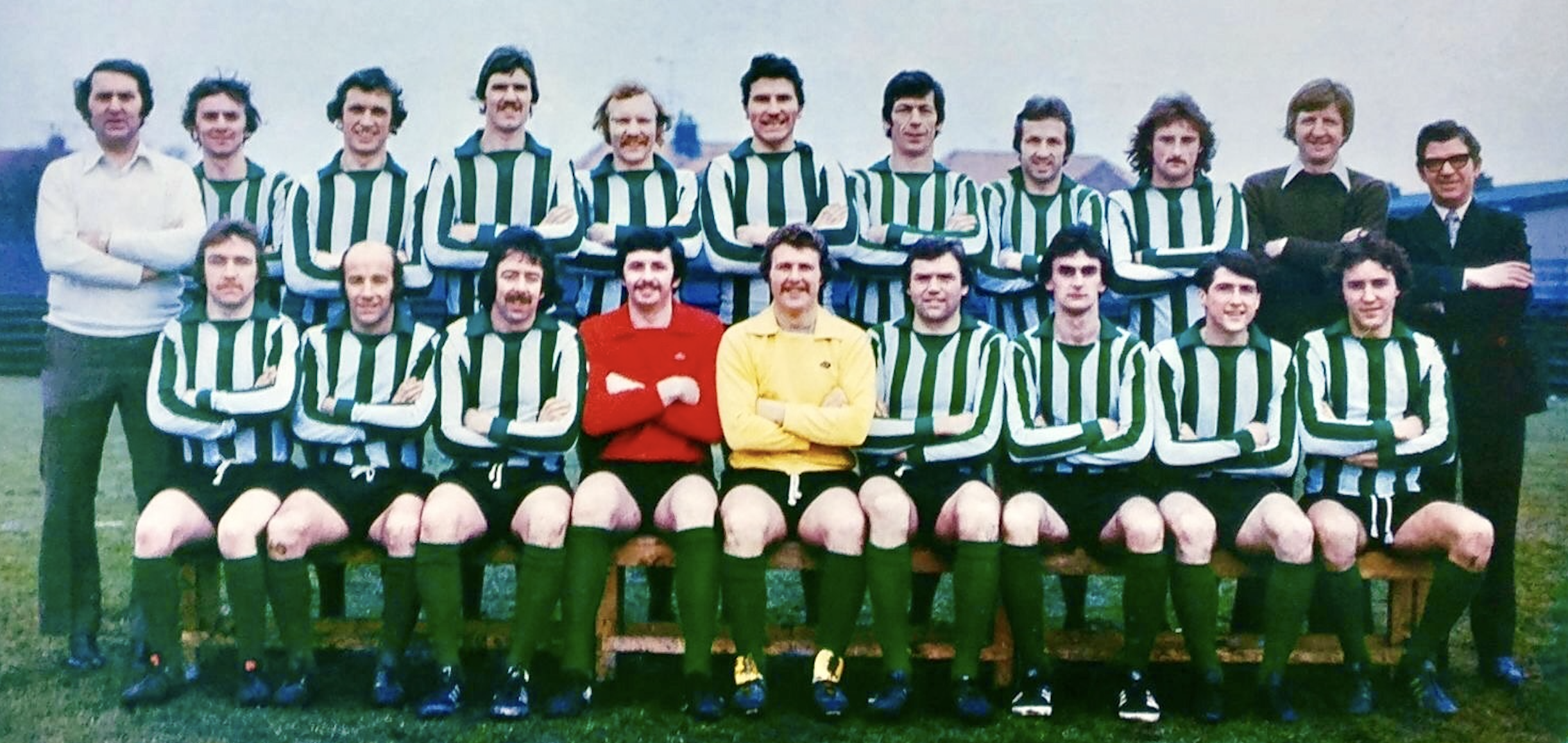 Back Row L to R –
Back Row L to R –
Jackie Marks Coach/Assistant Manager, Rob Carney, Ian Mutrie, Tommy Dixon,
Keith Houghton, Ronnie Scott, Mick Dagless, Terry Day,
Brian Slane Player/Manager, Pat Smith Physio.
Front Row L to R –
Alan Shoulder, John ‘Eddie’ Alder, Terry Johnson, Dave Addison, Dave Clarke,
Ron Guthrie, Steve ‘Jos’ Jones, Dave Varty, Steve Carney.
*Taken during the cup run on Croft Park pitch.
• This image was used on the Blyth Spirit LP that was made to celebrate the cup run.
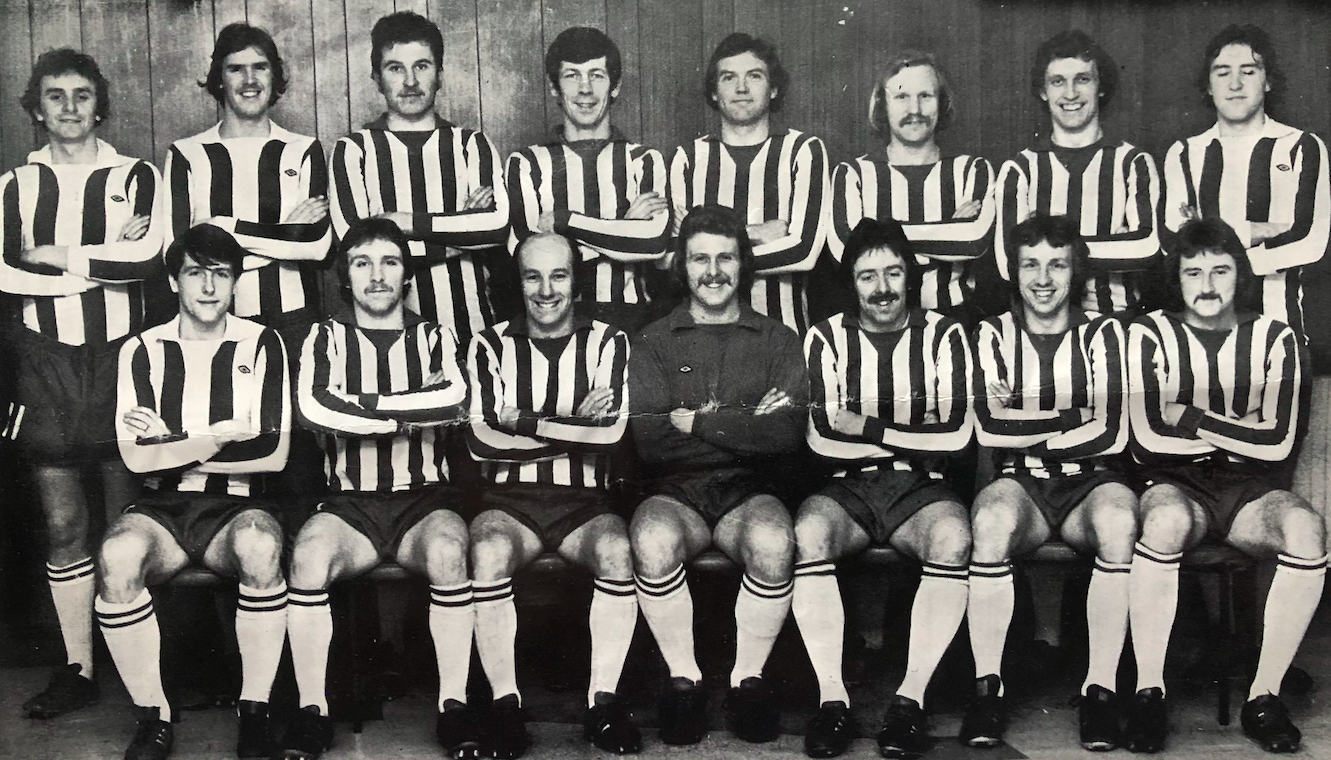 Back Row L to R –
Back Row L to R –
Rob Carney, Ian Mutrie, Keith Houghton, Ronnie Scott, Ron Guthrie,
Tommy Dixon, John Waterson, Steve Carney.
Front Row L to R –
Dave Varty, Alan Shoulder, John ‘Eddie’ Alder, Dave Clarke,
Terry Johnson, Mick Dagless, Terry Day.
* Taken during the cup run inside the Croft Park Social Club.
• Image appeared in the Stoke City FA Cup 4th Round match programme.
 Back Row L to R –
Back Row L to R –
John ‘Eddie’ Ader, Steve Carney, Dave Clarke, Ronnie Scott,
Dave Varty, John Waterson.
Front Row L to R –
Steve ‘Jos’ Jones, Alan Shoulder, Mick Dagless,
Ian Mutrie, Rob Carney.
*Taken Saturday 10th December 1977 before 1-0 Northern League
home win over Durham City.
• Game was Alan Shoulder’s club debut and
he scored the winner.
1976/77 –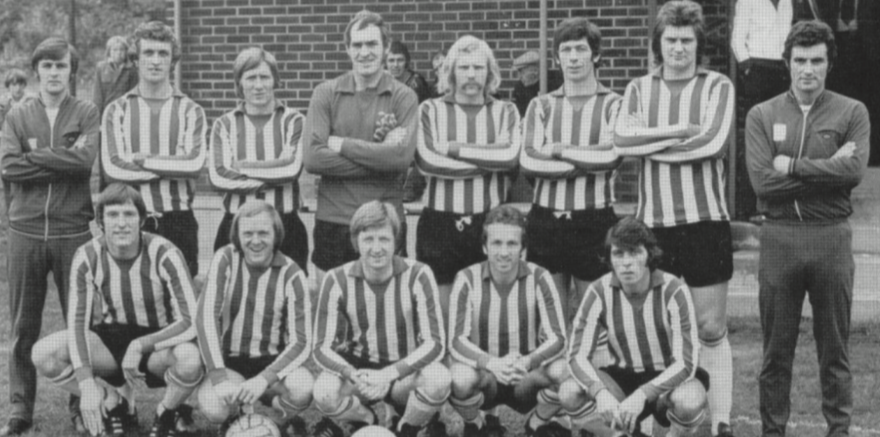 Back Row L to R –
Back Row L to R –
Stuart Leeming, John Waterson, Tony Smith, Mick Morgan, Tommy Dixon,
Ronnie Scott, John Tones, Dave Murray.
Front Row L to R –
Micky Pink, Alan Gauden, Brian Slane, Mick Dagless, Ron Young.
*Taken Saturday 18th September 1976 before 3-3 Northern League
draw away at Evenwood.
1975/76 – Back Row L to R –
Back Row L to R –
Alan Cruddace Assistant Player/Manager (partially cropped out), Kevin Wilson,
Stuart Leeming, Ronnie Scott, John Waterson, Tommy Dixon, Ian Harrison,
Mick Morgan, Gordon Smith, John Tones, Pat Smith Physio,
John ‘Eddie’ Alder, Graham Binks, Allan O’Neill Manager (partially cropped out).
Front Row L to R –
Micky Pink, Alan Gauden, Brian Slane, Mick Dagless, Tony Smith.
* Taken on Monday 3rd May 1976 at St James’ Park before 1-1
draw with North Shields in Northumberland Senior Cup Final.
• Image only ever appeared in the Rothmans Football News 1976 Annual. L to R –
L to R –
Pat Smith Physio, Allan O’Neill Manager, Mick Dagless, Micky Pink, John Waterson,
Tommy Dixon, Ian Nixon partially hidden, Ian Harrison, Mick Morgan behind
John ‘Eddie’ Alder, Alan Gauden, Tony Smith (above Gauden),
John Tones, Gordon Smith, Brian Slane.
*Taken on Wednesday 28th April 1976 in Croft Park dressing
after Northern League title had been retained for
with 4-0 win over Durham City.
1974/75 – Back Row L to R –
Back Row L to R –
Allan O’Neill Manager, Billy Fenwick Trainer, Alan Cruddace Player/Assistant Manager,
Ronnie Phillipson, Tommy Dixon, Mick Morgan, Ronnie Scott, Micky Pink,
Ian Nixon, Tony Smith, Pat Smith Physio.
Front Row L to R –
Micky Pink, Gerry Donoghue, Brian Slane, John ‘Eddie’ Alder,
Mick Dagless, Gordon Smith.
*This rare colour team photo was taken before the final home game
and shows both trophies won that season.
• Image only ever appeared on the cover of the 1st 1975/76
Rothmans Football News Annual magazine.
 Back Row L to R –
Back Row L to R –
Alan Cruddace Player/Assistant Manager, Ronnie Phillipson, Tony Smith, Gordon Smith,
Mick Morgan, John ‘Eddie Alder’, Ronnie Scott, Tommy Dixon. Allan O’Neill Manager.
Front Row L to R –
Pat Smith Physio, Mick Lister, Gerry Donoghue, Brian Slane, Mick Dagless, Micky Pink.
*Taken on Saturday 29th march 1975 at Willington’s Hall Lane Ground
before 1-0 win on Easter Saturday.
• Taken by County Durham based Galdon Photographers, only ever
appeared in the Rothmans Football News magazine.
 Back Row L to R –
Back Row L to R –
Dave Burowski, Alan Cruddace, John Lang, Ronnie Phillipson, Micky Pink,
Mick Third, Ronnie Scott, Alan O’Neill Manager.
Front Row L to R –
Mick Lister, Gordon Smith, John ‘Eddie’ Alder, Brian Slane, Mick Dagless,
Ian Nixon, Inset Gerry Donoghue.
*Taken Saturday 10th August 1974 before home friendly with Hartlepool United,
featured in the Preston North End FA Cup replay programme.
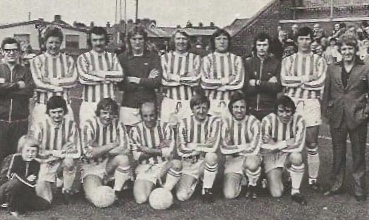 • This version was taken from a slightly different angle and included Physio Pat Smith on the left
• This version was taken from a slightly different angle and included Physio Pat Smith on the left
of back row and an unknown ball boy in front row.
1971/72 –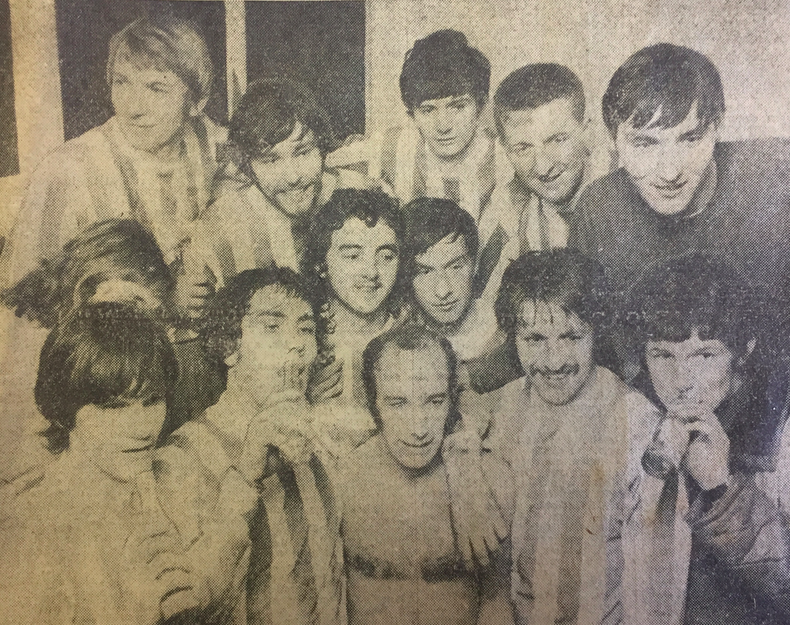
Back Row L to R –
Ronnie Phillipson, Gordon Atkinson, Mick Lister, Brian Slane, Bobby Varvill.
Middle Row L to R –
Robin Fallon partially hidden, Dave McMemeny, Alan Watson.
Frot Row L to R –
Des Jardine, Ian Nixon John ‘Eddie’ Alder, Gordon Smith, Alan Young.
*Taken on Saturday 15th January 1972 in Croft Park dressing room
following 2-2 FA Cup 3rd Round draw over Reading.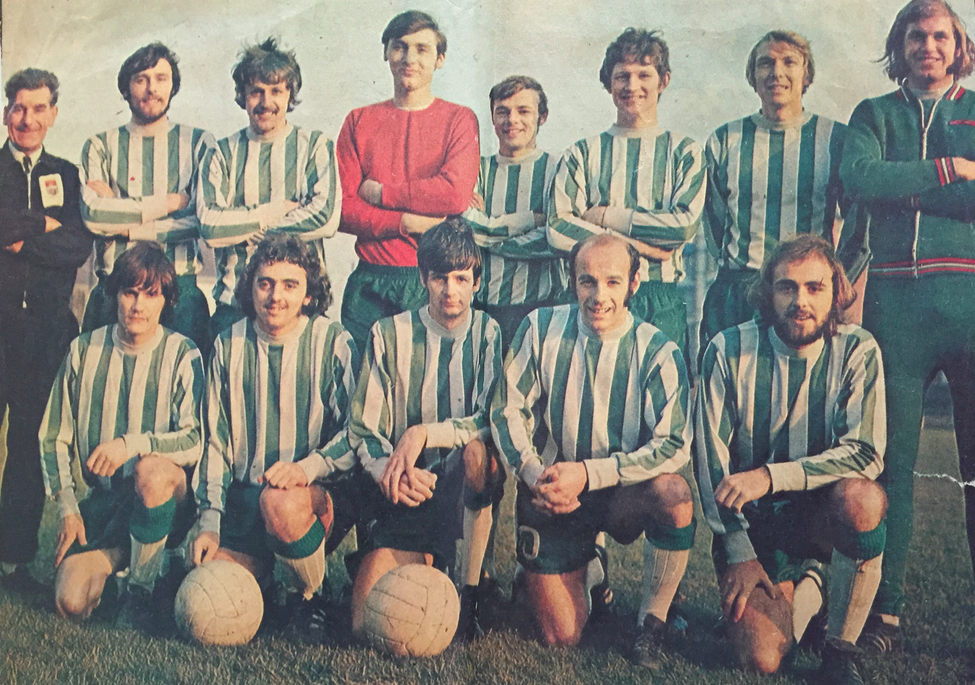 Back Row L to R –
Back Row L to R –
Billy Fenwick Trainer, Gordon Atkinson, Gordon Smith, Bob Varvill, Billy Romaines,
Allan Young, Ronnie Phillipson, Robin Fallon.
Front Row L to R –
Des Jardine, Dave McMenemy, Mickey Lister, John ‘Eddie’ Alder, Alan Taylor.
*Taken on Saturday 18th December 1971 at Whitby Town before
2-1 Northern League Cup 2nd Round replay win.
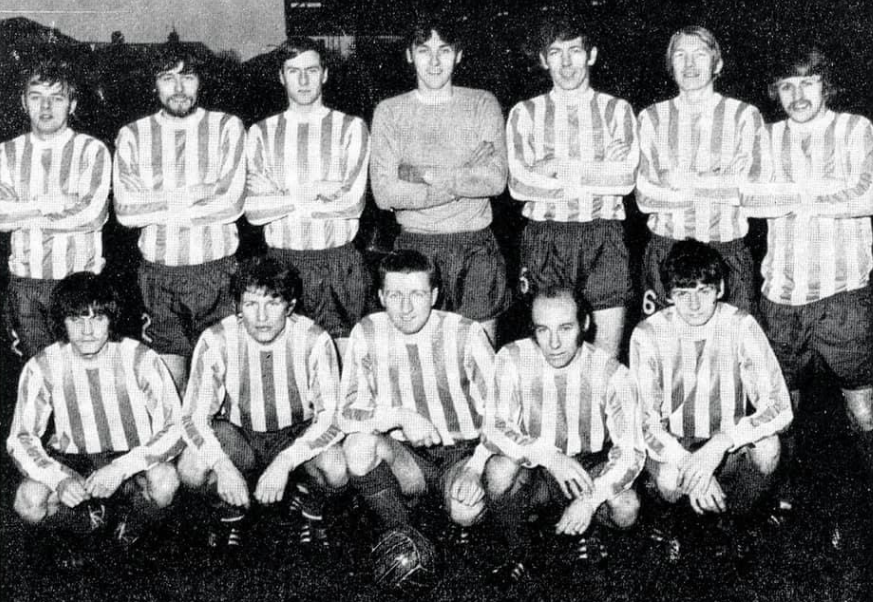 Back Row L to R –
Back Row L to R –
Billy Romanies, Gordon Atkinson, Alan Watson, Bobby Varvill, Ronnie Scott,
Ronnie Phillipson, Gordon Smith.
Front Row L to R –
Des Jardine, Allan Young, Brian Slane, John ‘Eddie’ Alder, Micky Lister.
*Taken on Wednesday 13th October 1971 before 1-1 home draw with
Gateshead in Vaux Floodlight League game.
• Image appeared in the Reading away FA Cup 3rd Round Replay match programme.
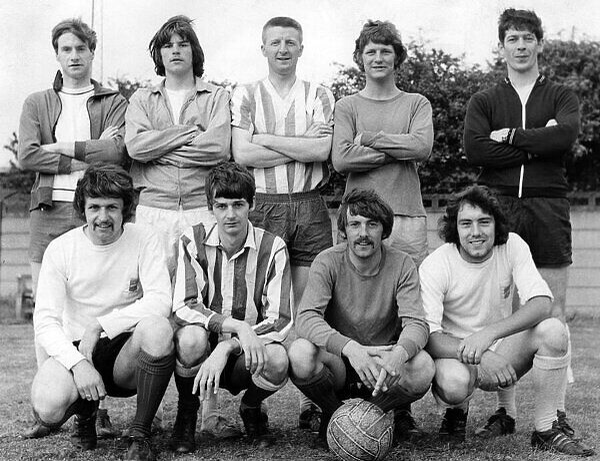 Back Row L to R –
Back Row L to R –
Alan Watson, Tony Short, Brian Slane, Allan Young, Ronnie Scott.
Front row L to R –
Ian Nixon, Michael Lister, John Evans, Gordon Smith.
*Taken on Saturday 16th July 1971 at Croft Park during pre season
training for the forthcoming new season.
1970/71 –
Back Row L to R –
Gordon Atkinson, Ronnie Scott, Brian O’Hara, John Robson, Harry Workman,
Jimmy Robson, Ronnie Phillipson.
Front row L to R –
Des Jardine, Allan Young, Brian Slane, John ‘Eddie’ Alder, Micky Lister.
*Taken on Saturday 22nd August 1970 at Croft Park before 3-2 win
over Willington in opening game of Northern League season.
1969/70 –
Back Row L to R –
Micheal Hind, Tom Ray, Alan Auld, Dick Patterson, Ronnie Scott, Ian Nixon,
Gordon Atkinson, Jackie Marks Manager.
Front Row L to R –
Ken Storey, John Robson, Peter Feenan Jnr, Des Jardine, Gordon Smith
*Taken at Croft Park before start of 69/70 Northern League season. • This better quality version taken from an angle appeared in Newcastle Football Pink.
• This better quality version taken from an angle appeared in Newcastle Football Pink.
1968/69 –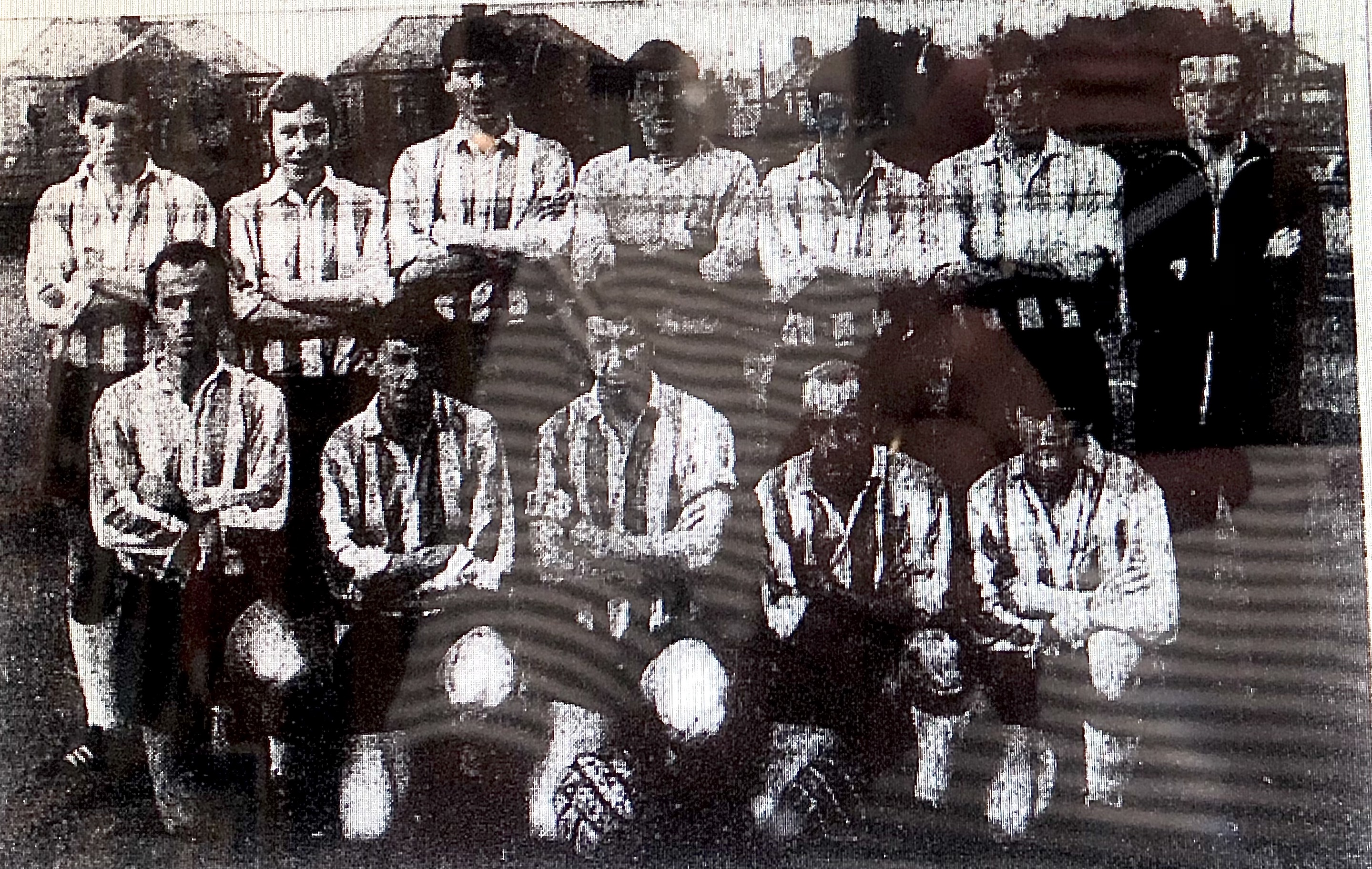 Back Row L to R –
Back Row L to R –
Bill Oakley, Peter Feenan Jnr, Ronnie Scott, Mike Ingoe, George Little,
Neil Hetherington, Ian Watts.
Front Row L to R –
Michael Hind, John Evans, Ken Duffell, John ‘Eddie’ Alder, Des Jardine.
*Taken Saturday 7th September 1968 before 0-2 Northern League
home defeat to Shildon.
• Not the best quality image but only one from this season.
If you know of a better quality image please get in touch
via email so it can be added to this archive –
theblythspirit@hotmail.com
1967/68 – Back Row L to R –
Back Row L to R –
Tony Knox Player/Manager, Alf Cleeve, Doug Bell, Peter Feenan Jnr.
Front Row L to R –
Tommy Orrick, Malcolm Peel, George Little.
*Taken in August 1967 at Croft Park following clubs win at the Annual
Whitley Bay Scottish Gala Week Five-a-Side competition.
Blyth Spartans Reserves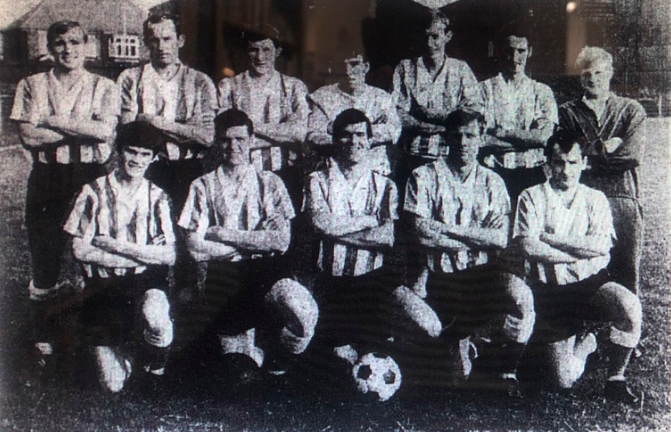 Back Row L to R –
Back Row L to R –
Neil Hetherington, Ken Dodd, Tom Spence, N. Hunter, J. Turnbull,
Albert Aiston, D. Hailes.
L to R –
Des Jardine, Anthony Britt, Nigel Cairns, B. King, J. Hogg.
*Taken at Croft Park on Monday 29th August 1967 before 1-0
Northern Combination League win over Shankhouse.
1966/67 – Back Row L to R –
Back Row L to R –
John ‘Eddie’ Alder, Stewart Graham, Jackie Embleton, Malcom Peel,
Jimmy Dees, George Little, Neil Hetherington.
Front Row L to R –
Tommy Orrick, Doug Bell, Peter Flaherty, John Evans, Gordon Smith.
*Taken at Croft Park on Saturday 20th August 1966 before 1-5
Northern League defeat to Tow Law on opening day of season.
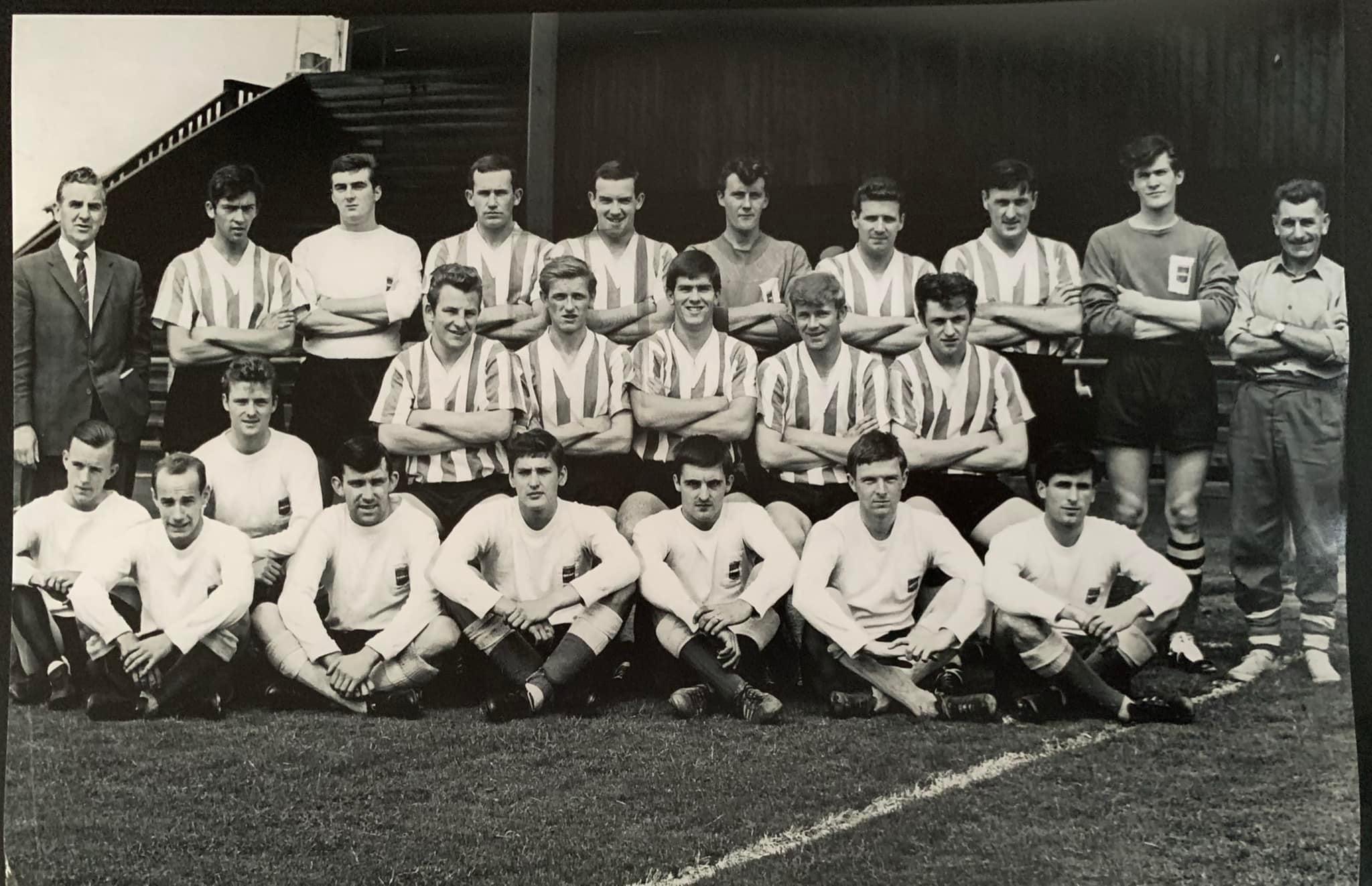 Back Row L to R –
Back Row L to R –
Jim Turney Manager, Miller, Holliday, Ken Dodd, Stewart Graham, Malcolm Peel,
George Little, Alf Cleave, Dick Waters, Billy Fenwick Trainer.
Middle Row L to R –
Brian Doughty, Tommy Orrick, Cairns, Ray Smith, Gordon Smith.
Front Row L to R –
Spry, John ‘Eddie’ Alder, Tulip, Jackie Embleton, Hodgson, Easton, Thompson, Roll.
*Taken at Croft Park on Saturday 8th August 1966 before annual
Green v. Whites pre season practise match.
Blyth Spartans Reserves
Back Row L to R –
Tom Spence, Ian Craggs, Peter Feenan Jnr, Alan Saunders, Anthony Britt, B. Halliday.
Front Row L to R –
Jackie Embleton, Slade, Albert Aiston, Over, John ‘Eddie’ Alder.
*Taken at Croft Park, before 3-0 North Combination win over
North Shields on Saturday 19th November 1966.
1965/66 –
Blyth Spartans Reserves
Back Row L to R –
Neil Hetherington, B. Halliday, Tom Ray, Alf Cleave, A. Frisby, Michael Hind, C. Oliver.
Front Row L to R –
Slade, Ken Dodd, Brian Turnbull, A. Wall, Albert Aiston.
*Taken at Croft Park, date unknown, several first team players featured for
the Reserves that day. Reserves played in the Northern Combination League.
Blyth Spartans First team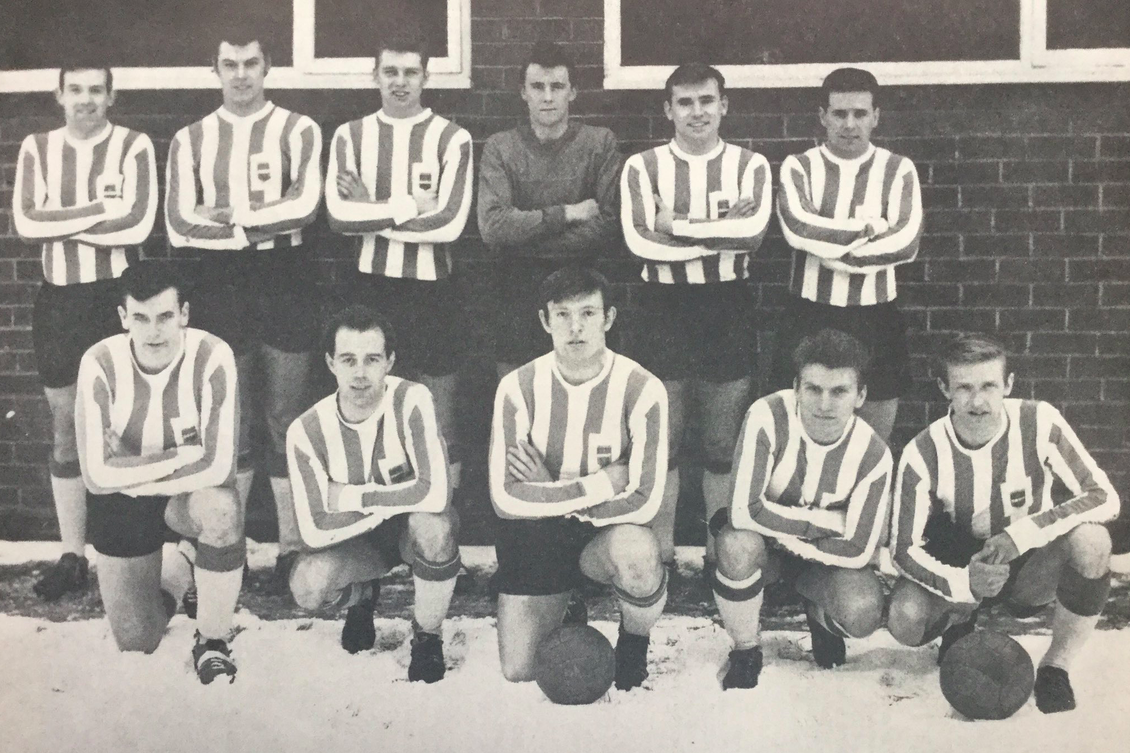
Back Row L to R –
Stewart Graham, Ian Craggs, Tom Baird, Malcolm Pell, Neil Hetherington, George Little.
Front Row L to R –
Eddie Hewitt, Michael Hind, Mickey Pink, Doug Bell, Tommy Orrick.
*Unknown when & where this photo was taken but it appeared in the
March 1966 edition of the Northern Football Magazine.
1964/65 – Back Row L to R –
Back Row L to R –
J. Simpson, Jackie Embleton, Edwin Kelly, Mike Ingoe,
J. Thompson, Neil Hetherington.
Front Row L to R –
A. Easton, Jim Campbell, Ken Duffell, W. Emmerson, D. Dixon.
*Taken at Croft Park on Saturday 2nd January 1965 before 3-2 Northern League
win over Shildon, only 2nd home win of season and 3rd in league so far!
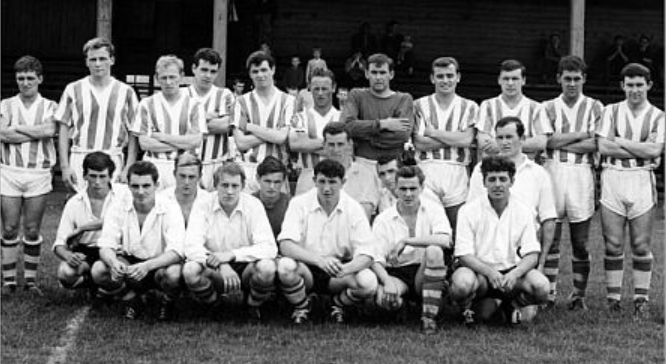 Back Row L to R –
Back Row L to R –
T. Atkins, B. King, D. Nixon, J. Simpson, D. Peterson, G. Nicholls, Mike Ingoe,
Neil Hetherington, J. Bell, N. Smith, Jackie Embleton.
Front Row L to R –
D. Ancrum, A. Easton, A. Simmons, A. White, J. Robson, Ken Duffell, A. McCarton,
B. Davison, R. Writson, R. Thompson, Ken Dodd.
*Taken at Croft Park on Saturday 10th August 1964 before annual
Green v. Whites pre season practise match
Blyth Spartans Reserves Back Row L to R –
Back Row L to R –
J. Bell, J. Potts, Talbot, F. Kidd, A. Gray, R. Watts
Front Row L to R –
B. Megson, J. Slater, M. Pink, K. Dodd, A. Hodgson.
*Taken at Croft Park on October 1964, no other information is known.
1963/64 –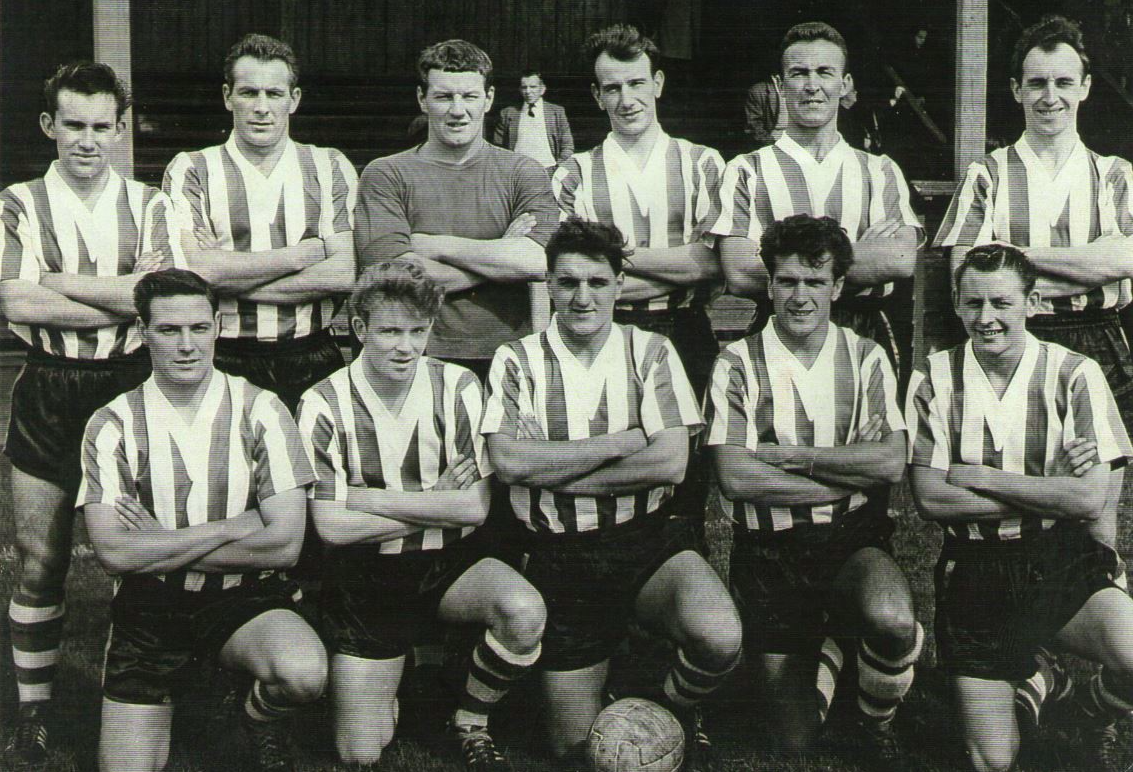 Back Row L to R –
Back Row L to R –
Jackie Embleton, Stephen Reay, Ray Whitehead, Watson, James Cain, Robson Shields,
Front Row L to R –
Lew Nainby, Ray Smith, Don Robson, Alan Smith, Ron Laverick
*Taken at Croft Park on Saturday 24th August 19643 before 4-4 draw
in opening game of new North Eastern League season.
1962/63 –
Back Row L to R –
Jackie Embleton, William Brown, Les Oliver, Ray Whitehead, Eric Raffo, James Cain
Front Row L to R –
B. Glendenning, Harry Clark, Don Robson, Alan Smith, Jackie Hogg.
*Taken at Croft Park on Saturday 18th August 1962 before 1-3
Nothern Eastern League defeat to Consett on opening day of the season.
1961/62 –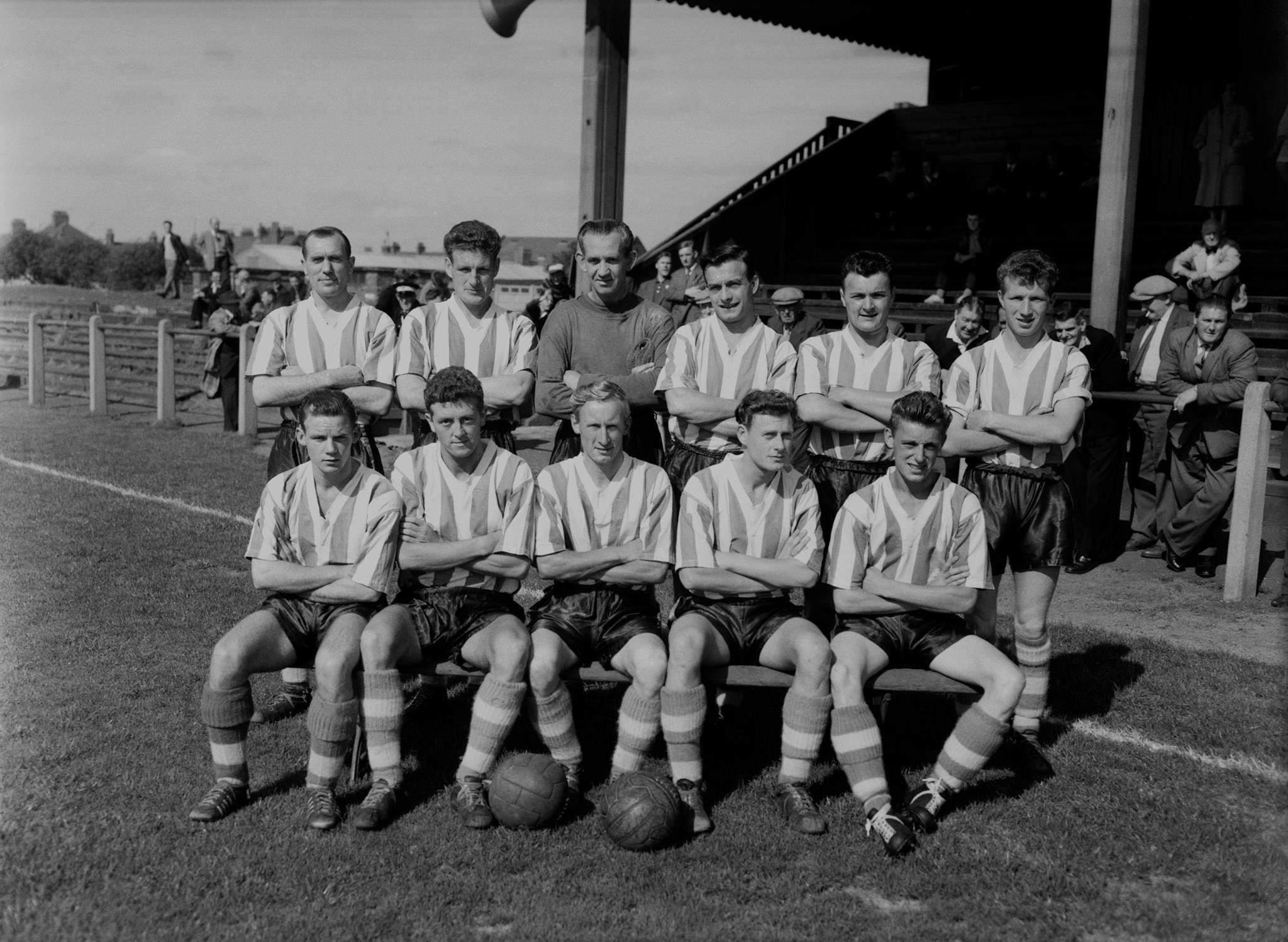
Back Row L to R –
Frank Stamper, Bill Brown, Harry Mills, Gordon Davis, Ray Ovington, Ralph Pringle
Front Row L to R –
Turner, Harry Clark, Brian Harbertson, Moody, Spence
*Taken at Croft Park on Saturday 26th August 1961 before 2-2
Northern Counties League draw with Horden Colliery Welfare.
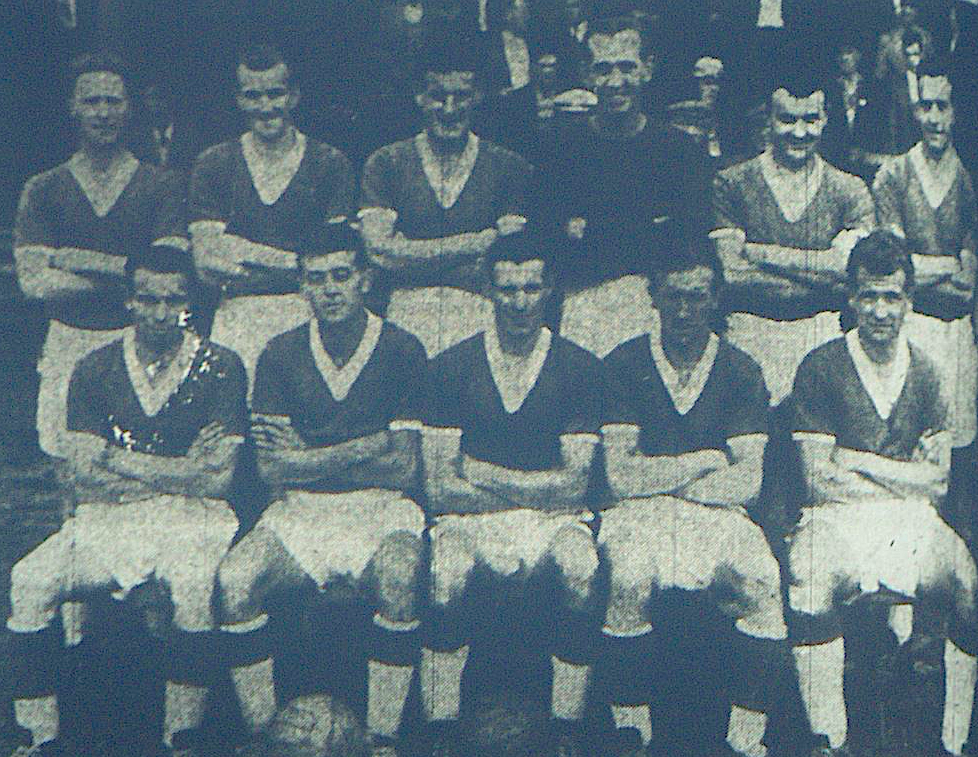
Back Row L to R –
Paddy McNally, Tommy Reay, Bill Brown, Harry Mills, Ray Ovington, Gordon Davis.
Front Row L to R –
Norman Mitchell, Harry Clark, George Willis, Frank Turney, Bob Nickalls.
*Taken at Croft Park on Saturday 26th August 1959 before 2-2
Northern Counties League draw with Horden Colliery Welfare.
1959/60 –
Blyth Spartans Reserves Back Row Lto R –
Back Row Lto R –
Brian Carolin, Alan Simmons, Neil Hethrington, John Hunter,
Jackie Hindmarsh, Clarrie Turney.
Front Row L to R –
Louis Nainby, Frank Turney, Brian Harbertson, Eddie Kelly, Jackie Hogg.
*Taken at Croft Park but exact date is unknown. Reserves played in the Northern Alliance.
1958/59 –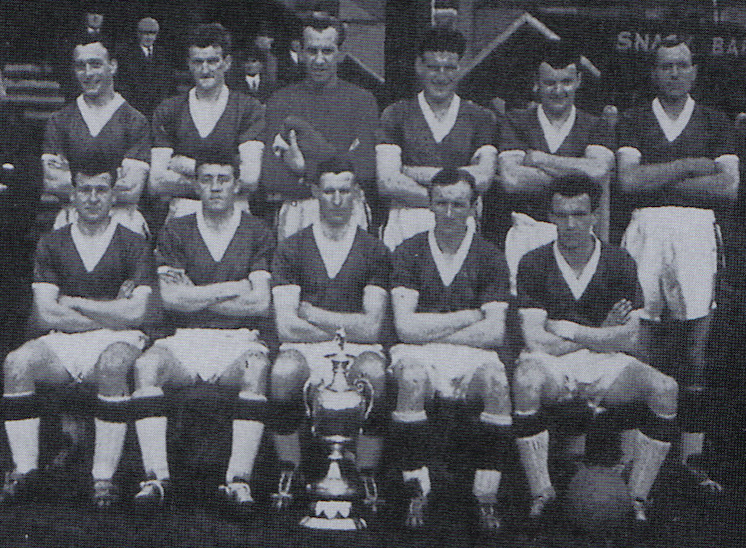
Back Row L to R –
Gordon Davis, Tommy Reay, Harry Mills, Ray Ovington, Bill Brown Frank Stamper.
Front Row L to R –
Norman Mitchell, Harry Clark, George Willis, Frank Turney, Bob Nickalls.
* Taken at Croft Park on Wednesday 29th April 1959 before 3-0 Midland League
win over Stockton in final game of season.
4 days earlier had won Northumberland Senior Cup
at SJP hence team photo with cup.
• I have seen a colour version of this photo but still trying to track it down.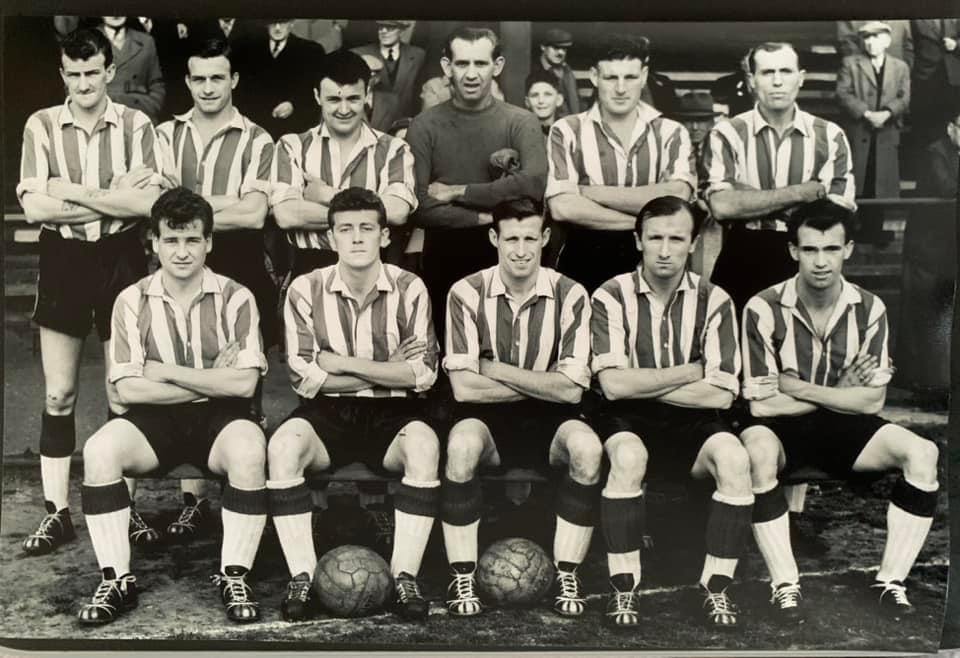
Back Row L to R –
Tommy Reay, Gordon Davis, Ray Ovington, Harry Mills, Bill Brown, Frank Stamper.
Front Row L to R –
Bob Nickalls, Harry Clark, George Willis, Frank Turney, Bill Haley.
*Taken at Croft Park on Thursday 1st January 1959 before 2-2
Northern Counties League draw with Ashington.
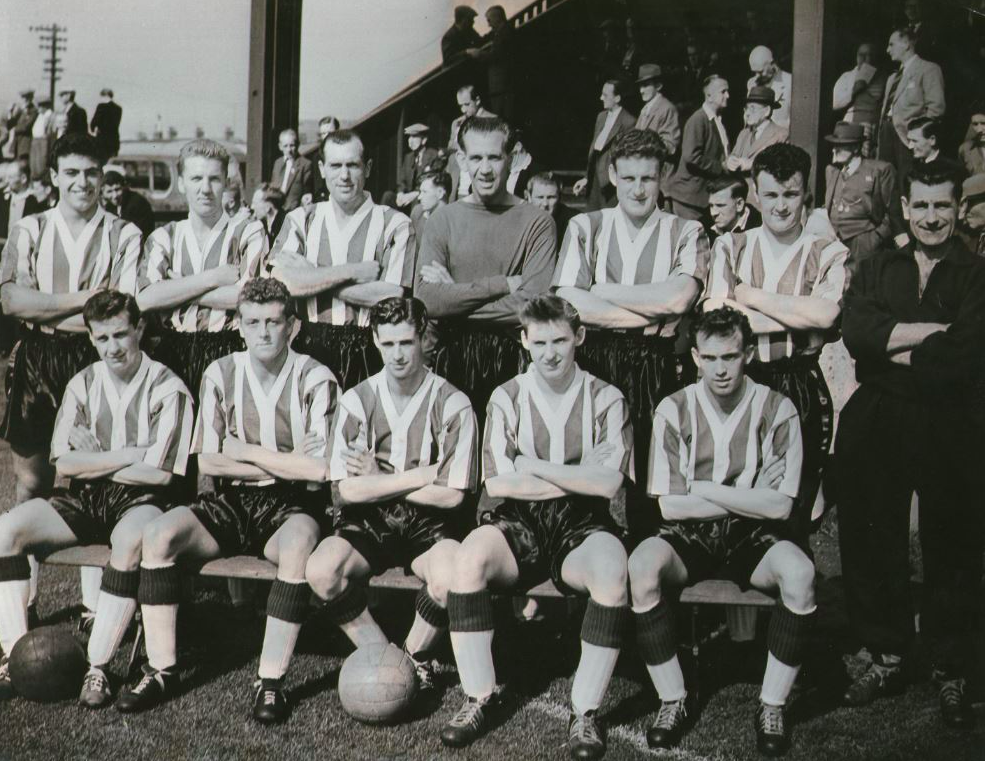
Back Row L to R –
Eric Rafflo, George Bell, Frank Stamper, Harry Mills, Bill Brown, Billy Fenwick Trainer.
Front Row L to R –
George Anderson, Harry Clark, Tommy Hogan, Edwin Kelly, William Haley.
*Taken at Croft Park on Saturday 30th August 1958 before 3-0
Midland League win over Denaby Town.
1955/56 – Back Row L to R –
Back Row L to R –
Eddie Ramsey, Tommy Reay, Dougie Wright, George Tubman,
Ray ‘Dickie’ Ovington, George Sharp.
Front Row L to R –
Harry Scott, Johnny Langland, Gavin Gair, Eddie Turney, William Haley.
*Taken at Croft Park on Boxing Day 1955 before 5-2 North Eastern League win over Ashington.

Back Row L to R –
J. Lynn, Eddie Ramsey, Arthur Sowden, John Inglis, Ray ‘Dickie’ Ovington, Tommy Reay.
Front Row L to R –
Billy Linacre, Johnny Langland, M. Emmerson, J. McHale, William Haley.
*Taken at Croft Park on Saturday 1st December 1956 before 2-4 North Eastern League
defeat to Middlesbrough Reserves. Unknown why black arm bands were worn.
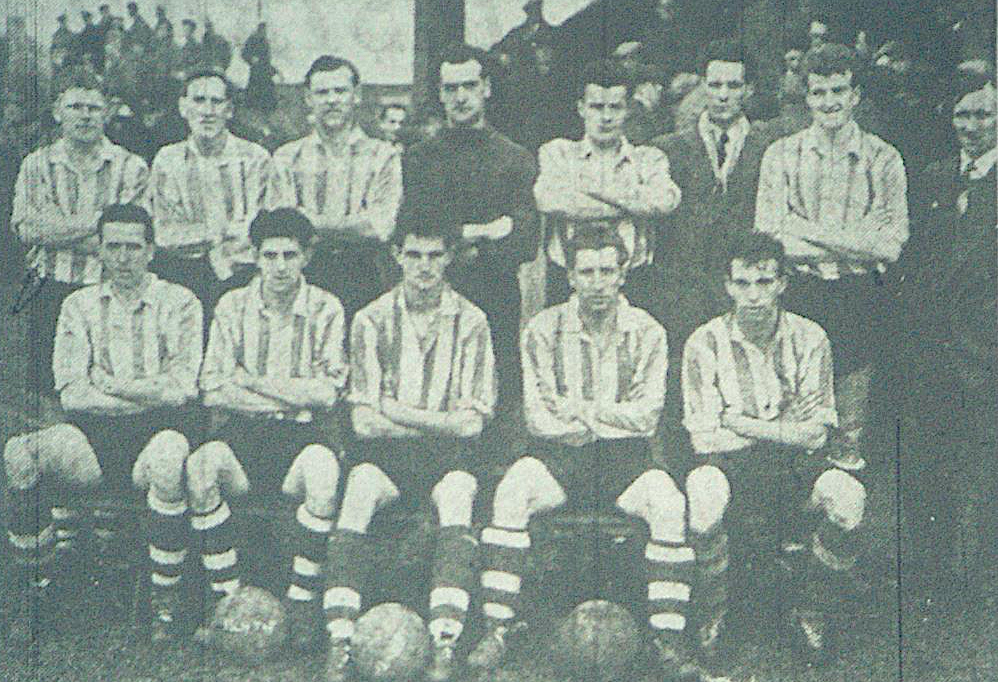
Back Row L to R –
Eddie Ramsay, J. Lynn, Arthur Sowden, John Inglis, Dickie Ovington,
Dougie Wright Secretary/Manager, Tommy Reay, Frank Turney.
Front Row L to R –
Billy Linacre, Johnny Langland, M. Emmerson, J. McHale, William Haley.
*Taken at Croft Park on Saturday 13th October 1956 before 0-0
North Eastern League draw with Darlington Reserves.
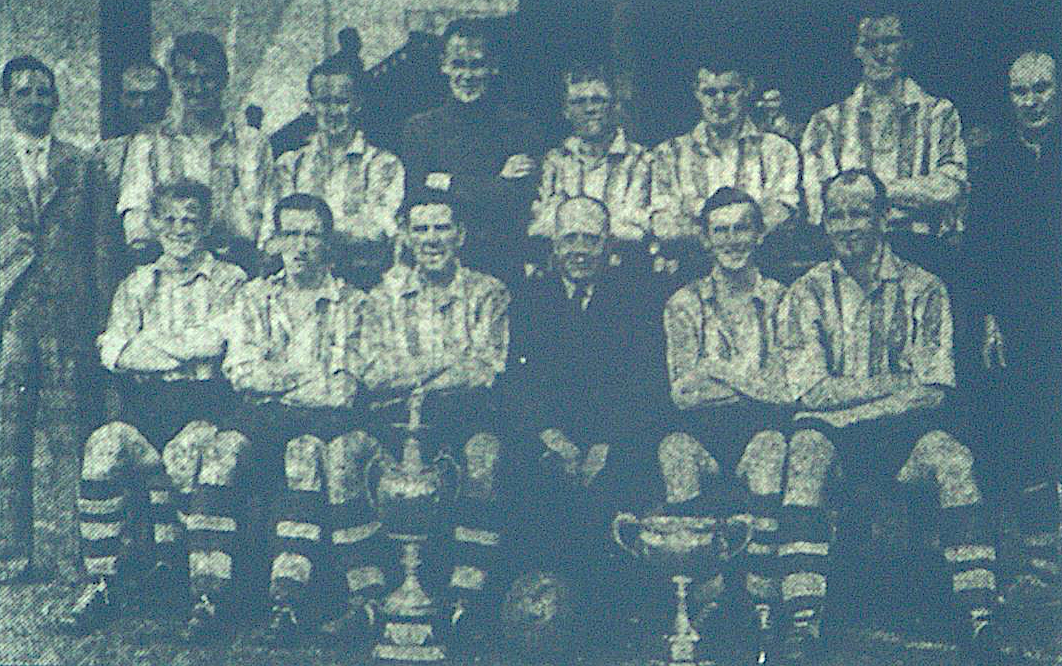
Back Row L to R –
Jim Turney, J. Evans Kitman, Tommy Reay, George Sharp, John Clark, Eddie Ramsay,
Dickie Ovington, Dougie Wright, R. Roberts Trainer.
Front Row L to R –
M. Johnson, Frank Turney, Peter Feenan Snr, Bob Middleton Chairman,
Eddie Turney, Gavin Gair.
*Taken at Croft Park on Saturday 3rd September 1955 before 2-3
North Eastern League defeat to North Shields.
• Photo taken to display the NEL Challenge Cup that had been
won 3 days earlier. Beat Spennymoor United 4-0 at home in
2nd leg of Final to win Trophy with 4-1 aggregate.
Final was held over from the previous season,
the trophy on left is the Northumberland Senior Cup won in 54/55.
1954/55 –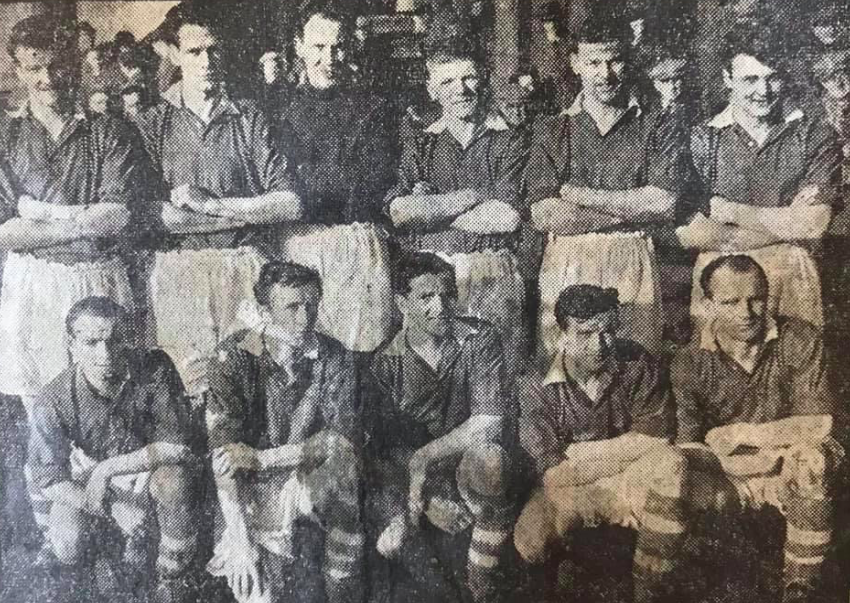 Back Row L to R –
Back Row L to R –
Tommy Reay, Dougie Wright, John Clark, Eddie Ramsey,
Arthur Sowden, Dickie Ovington.
Front Row L to R –
R. Wilson, Frank Turney, Jimmy Turney, Eddie Turney, Gavin Gair.
*Taken at Croft Park on Saturday 19th March 1955 before 5-2
home win over Sunderland Reserves in North Eastern League.
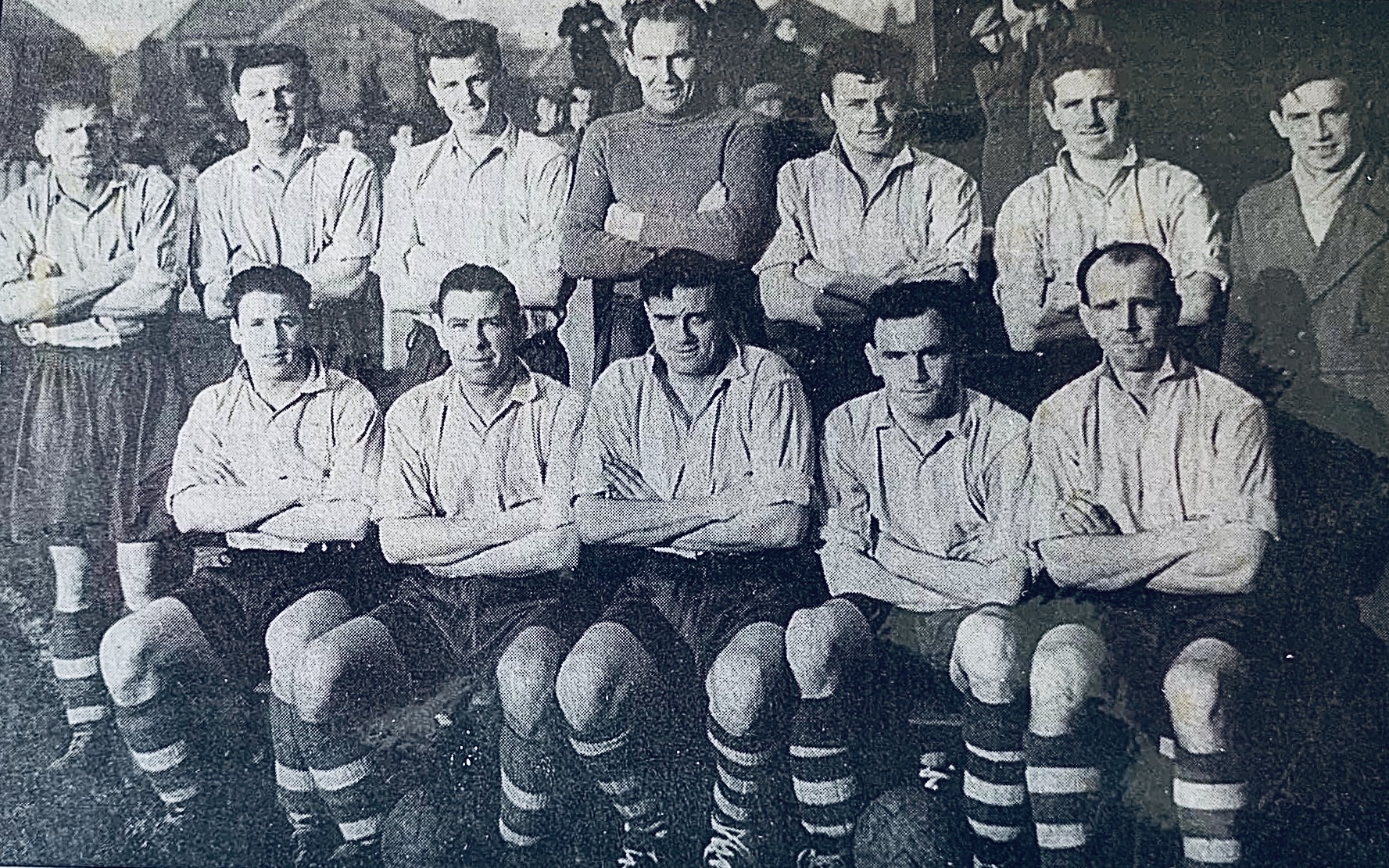 Back Row L to R –
Back Row L to R –
Eddie Ramsey, Arthur Sowden, Tommy Reay, John Clark, Dickie Ovington,
Jimmy Turney, Eddie Turney (wearing coat).
Front Row L to R –
Harry Scott, Peter Feenan Snr, Jack Hogg, Charlie Weatherspoon, Gavin Gair.
*Taken at Croft Park on Saturday 4th December 1954 before 4-3
North Eastern League win over Carlisle United Reserves.
1952/53 –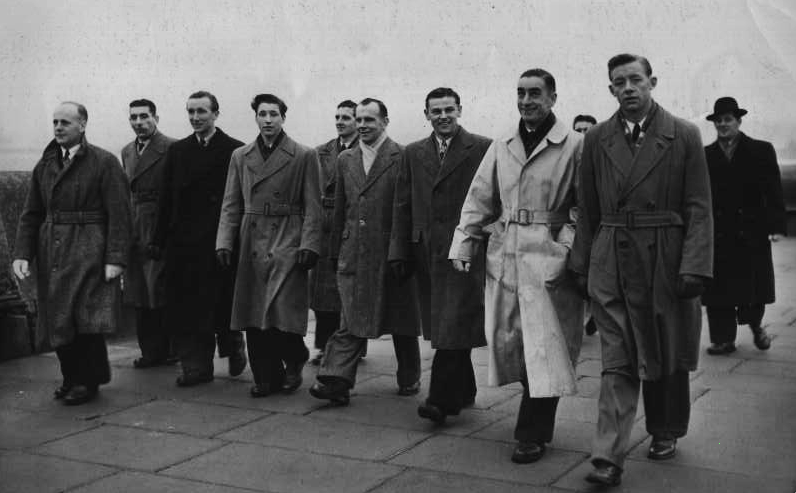
L to R-
Norman Penrose, Billy Fenwick, Frank Turney, Harry Scott,
Jim Turney, Gavin Gair, Arthur Sowden, Sammy McLaughlin,
John Allison, Charlie Ferguson Coach in hat.
*Taken on Wednesday 19th December 1952 on Birkenhead promenade as players
take a walk before that nights FA Cup round Replay at Tranmere Rovers.
Back Row L to R –
Jimmy Turney, John Allison, Frank Turney, Eddie Turney,
Sammy McLaughlin, Arthur Sowden, James Kerr.
Front Row L to R –
Matt Middleton, Norman Penrose, Lloyd, Arthur Sowden (hands grasped),
George Sharp, Gavin Gair, Kerr, Harry Scott, Billy Fenwick.
Coach Charlie Ferguson with back to players.
*Taken at on Friday 14th December 1952 at 56 William Street, Blyth.
The house was owned by the club and used as it’s base for team meetings etc.
• That night coach Charlie Ferguson give a team talk before the next days
FA Cup 2nd Roud tie with Tranmere Rovers at Croft Park.
(From April 1950 until May 1953 the team was picked
by the commititee and the coach trained the players).
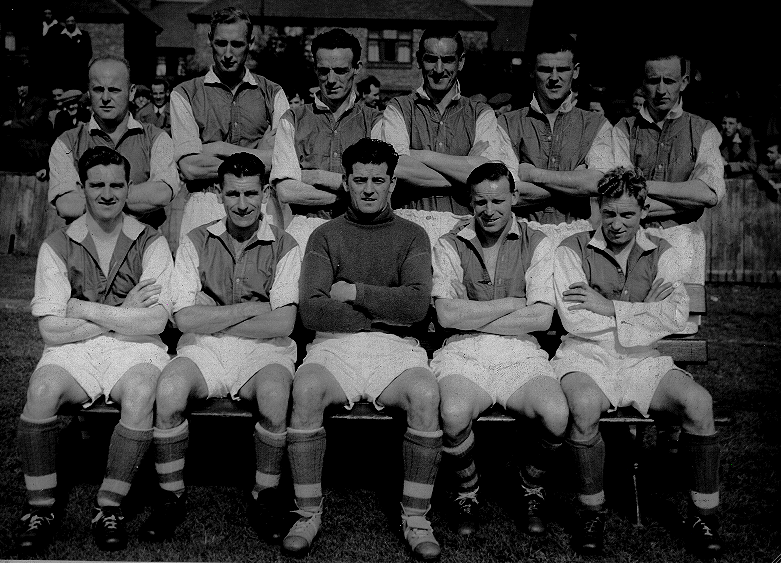
Back Row L to R –
Norman Penrose, Ken Hirst, John Allison, Sammy McLachlan,
Arthur Sowden, James Kerr.
Front Row L to R –
Jim Turney, Billy Fenwick, Matt Middleton, R.W Kerr, Gordon Luke.
*Taken at Croft Park on Saturday 23rd August 1952 before 3-0 North Eastern League
win over Consett in opening game of season.
1951/52 –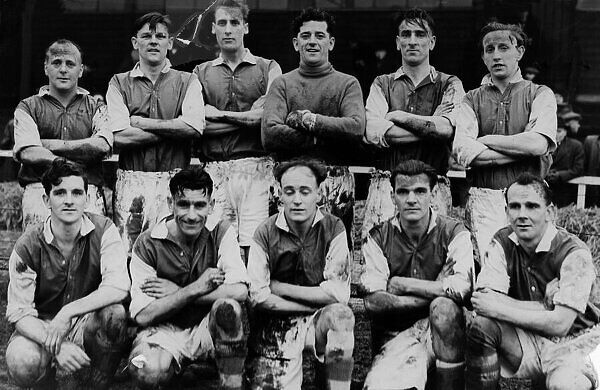 Back Row L to R –
Back Row L to R –
Norman Penrose, Arthur Sowden, Ken Hirst, Matt Middleton,
Sammy McLachlan, George Sharp.
Front Row L to R –
Jim Turney, Billy Fenwick, Thomson, Lloyd, Gavin Gair.
*Taken at Portland Park, Ashington on Saturday 1st March 1952 following
Northumberland Senior Cup Semi Final draw with Ashington.
1953/54 –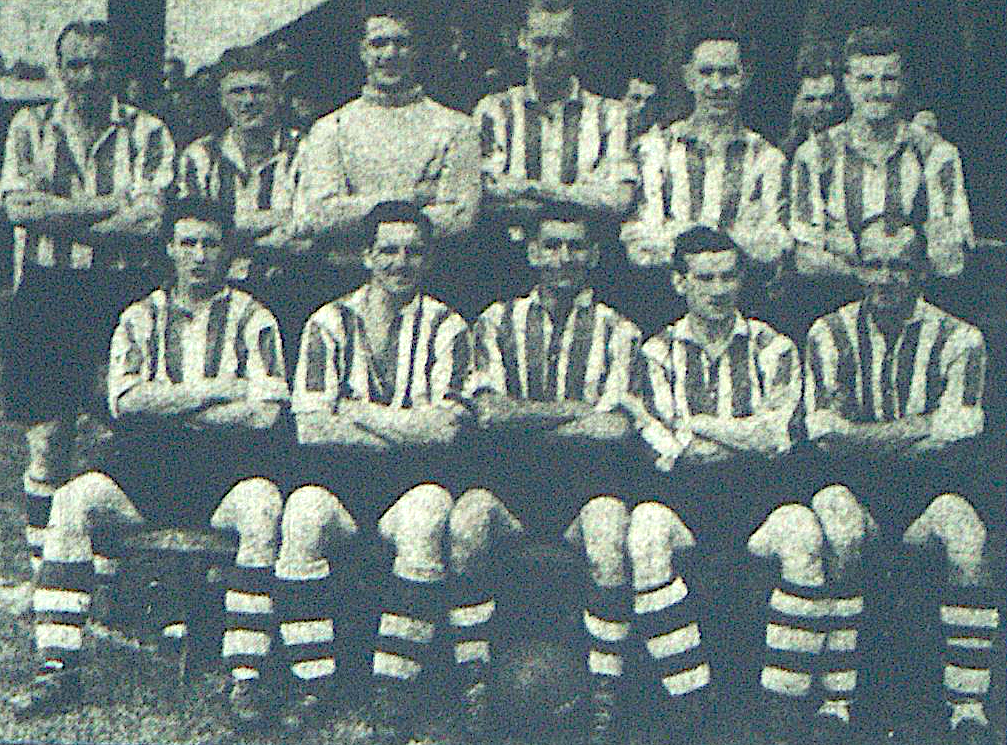 Back Row L to R –
Back Row L to R –
Tom Blenkinsop Player/Manager, Eddie Ramsay, A. Carter, Ken Hirst,
K. Finlay, Tommy Reay.
Front Row L to R –
Harry Scott, Jim Turney, Billy Fenwick, Eddie Turney, Gavin Gair
*Taken at Croft Park on Saturday 26th September 1953 before 2-1 win
over Gateshead Reserves in a North Eastern League game.
1949/50 –
Back Row L to R –
White, Joe Wilson, Joe Thompson, Norman Robson, Law, Tommy Reay.
Front Row L to R –
George Harvey, Norman Penrose, Ramsey, Proudlock, Gavin Gair
* Taken on Saturday 5th May 1950 following 3-3 North Eastern League draw at
Middlesbrough Reserves in final league game of season.
• Team wore the green & white quarter shirts first worn after club reformed for 1946/47,
also used same shirts in 47/48 before returning to stripes for the 48/49 season.
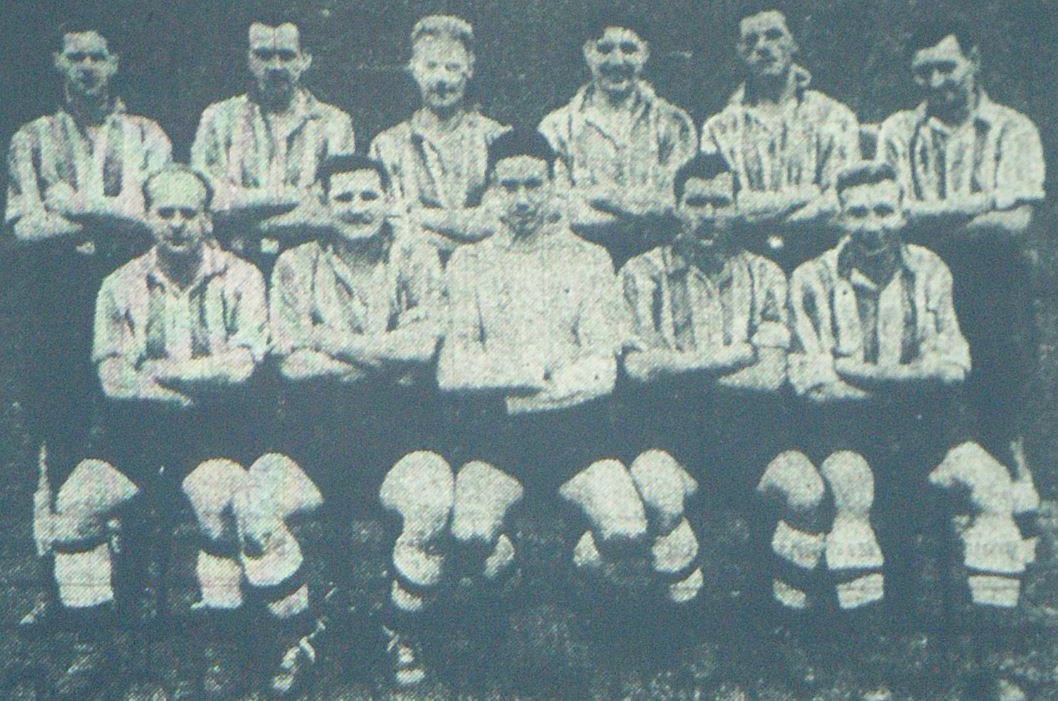 Back Row L to R –
Back Row L to R –
J.T. Leonard, George Harvey, J. Holliday, R. Ramsay, H. Hawkins, R. Farington.
Front Row L to R –
Norman Penrose, Jimmy Clough, Bob Anderson, T. White, Gordon Luke.
*Taken at Croft Park on Saturday 27th August 1949 before 6-1
North Eastern League win over Annfield Plain.
1948/49 –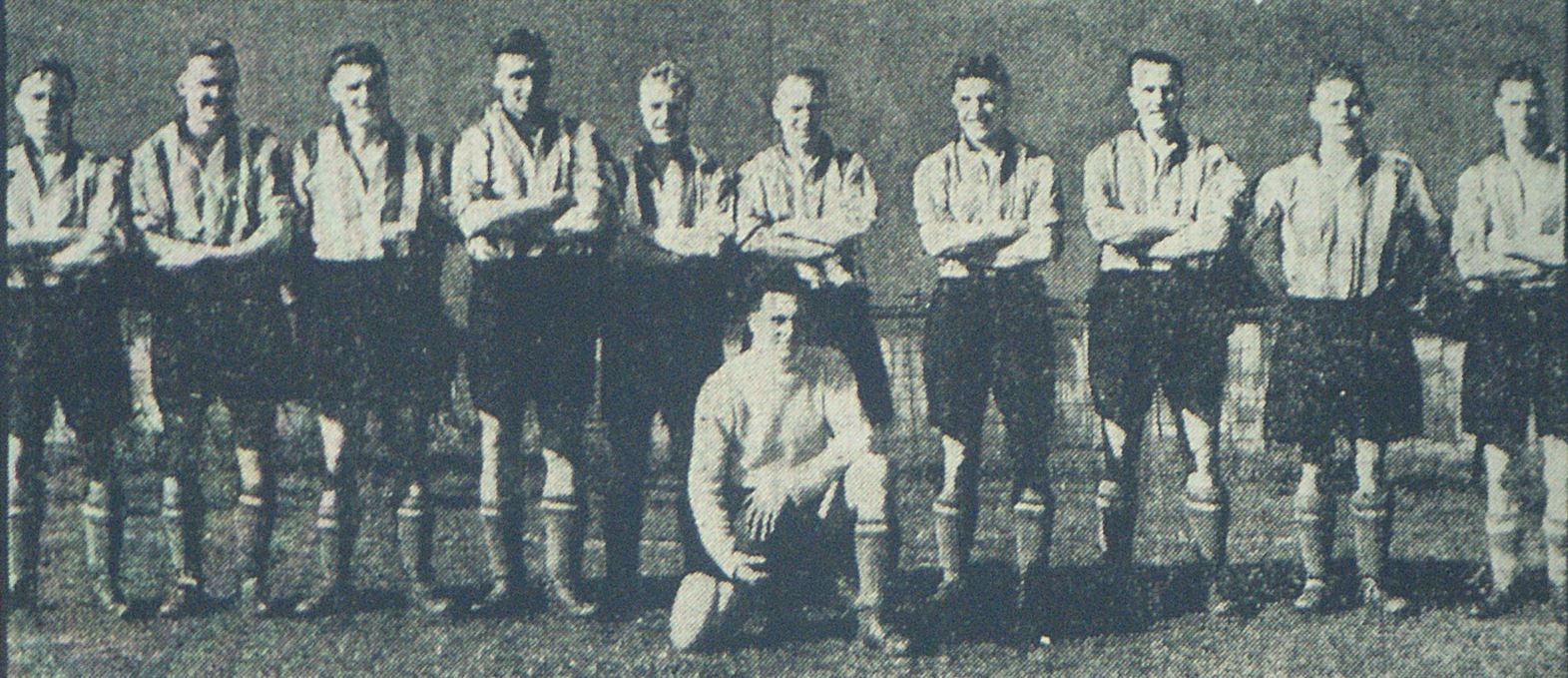 Back Row L to R –
Back Row L to R –
E. Appleby, J. Allison, J. Clough, J. Wilson, J. Holliday, K. Blake, R. Ramsay,
G. Harvey, R. Millard, J. Leonard.
Front –
Norman Robson
*Taken at Croft Park on Saturday 21st August 1948 before 3-0
North Eastern League win over Horden Colliery Welfare in
opening game of new season.
1947/48 –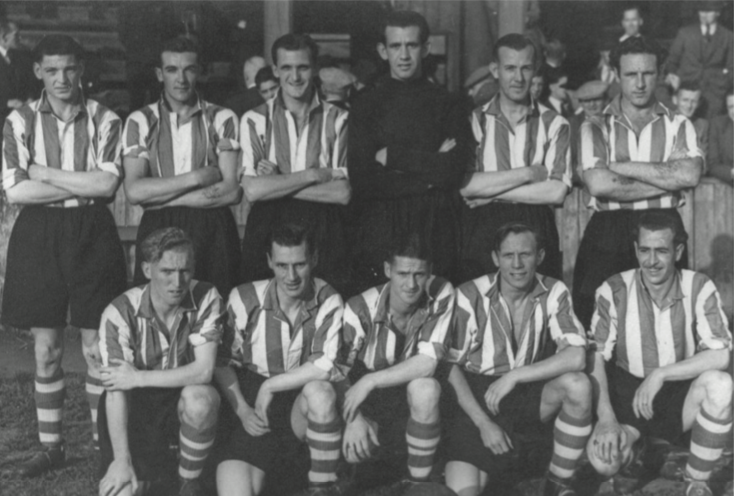
Back Row L to R –
J. Barnes, J. Liddell, R. Gardner, Harry Mills, G. Tapkin, G. Hall.
Front Row L to R –
Norman Roddam, Eddy Barber, T. Leonard, E. Appleby, J. Robson.
*Taken at Croft Park on Wednesday 27th August 1947 before 1-1
North Eastern League draw with North Shields.
1939/40 –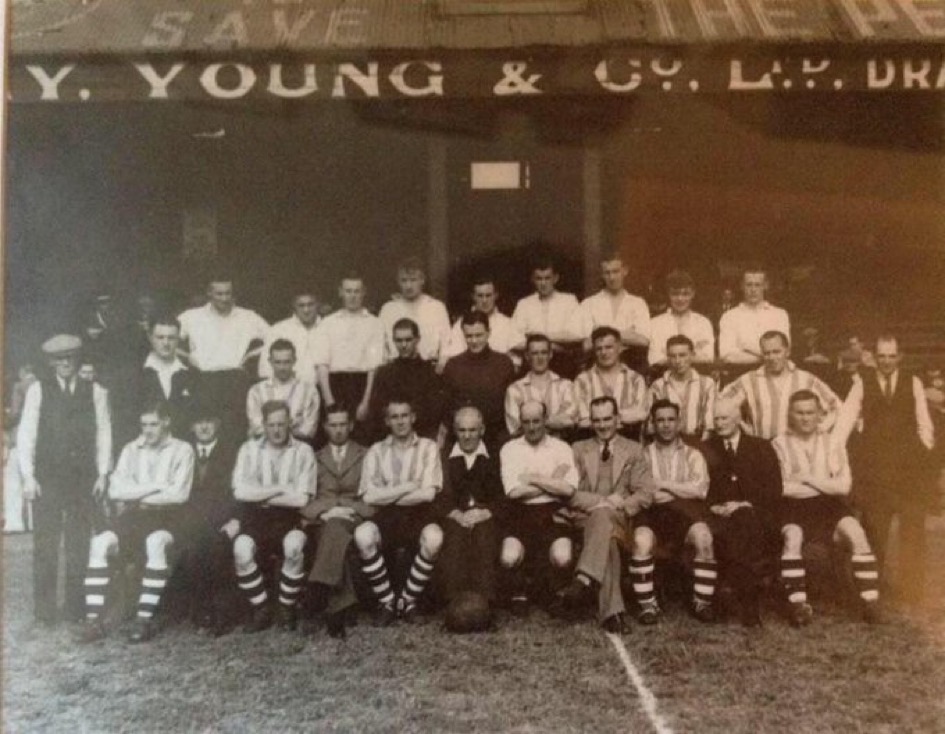 *Taken at Croft Park in front of main stand in August 1393 before
*Taken at Croft Park in front of main stand in August 1393 before
annual pre season Green v. Whites game.
• Only 3 people are identified; long serving former player and club trainer
Billy Lawton on far left of middle row wearing the hat.
Opposite end to him, far right, is Committee man George Oliver.
3rd from left of front row is defender Ken Rochester.
• Please get in touch via email if you can identify any players or officials in this photo –
theblythspirit@hotmail.com
1935/36 –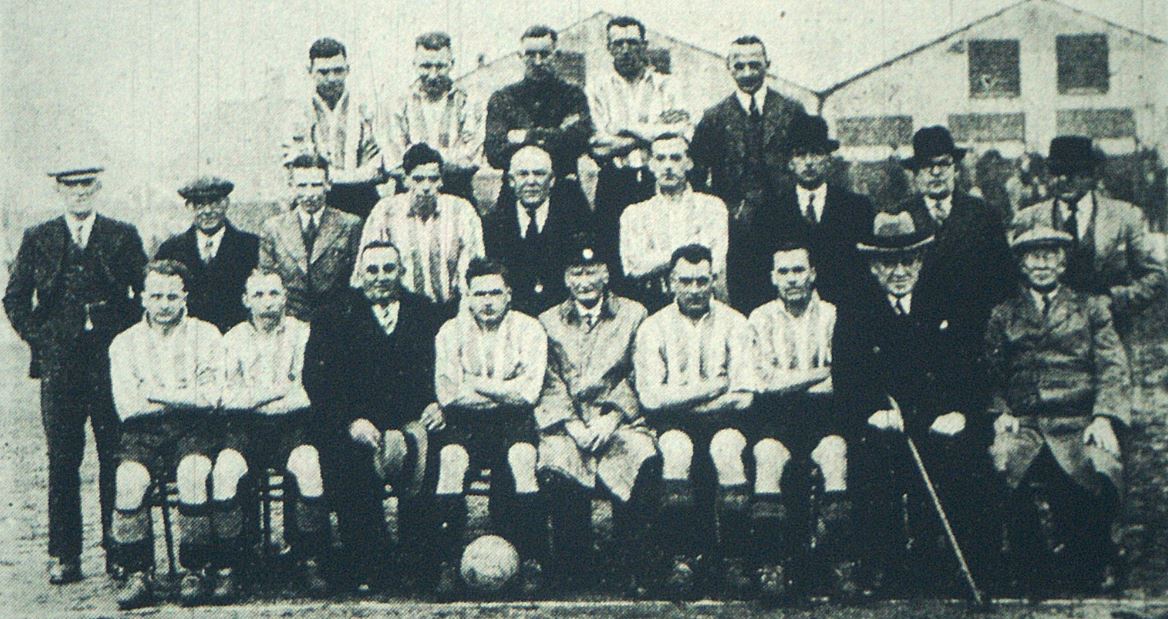
Back Row L to R –
Tom Carnaby, Charlie Metcalfe, George Wolf, Tom Freeman, William Laidler
Middle Row L to R –
W. Lawton Trainer, T. Yorston Director, Robert Turner, John Knox,
Capt J.W. Heatley Director, Emanuel ‘Manny’ Sharpless, M. Wood Director,
Councillor J.W. Clark Director, Ernie Hoffman Manager.
Front Row L to R –
George Hickman, Ernie Park, W. Allen Vice-chairman, William Readman,
E. Wright Chairman, Jack Kennedy, William Dexter,
Councillor T. Stephenson Director, Councillor W. Marshall Director.
*Taken on Saturday 9th May 1936 to mark the winning of the North Eastern League title,
before the Senior Cup Final Replay at Croft Park in which Blyth beat North Shields
2-1 to seal the double. No photo exisits of club with the NEL trophy.
 Back Row L to R –
Back Row L to R –
Charlie Metcalfe, John Knox, Tom Carnaby, George Wolf,
William Dexter, Tom Freeman.
Front Row L to R –
George Hickman, Ernie Park, William Redman,
Jack Kennedy, Emanuel ‘Manny’ Sharpless.
*This image was taken along with the one with all the club officials
and was used on a used on the Adrath Cigarette card.
• It is the only time a Blyth Spartans team appeared on the once popular Cigarette cards.
1934/35 –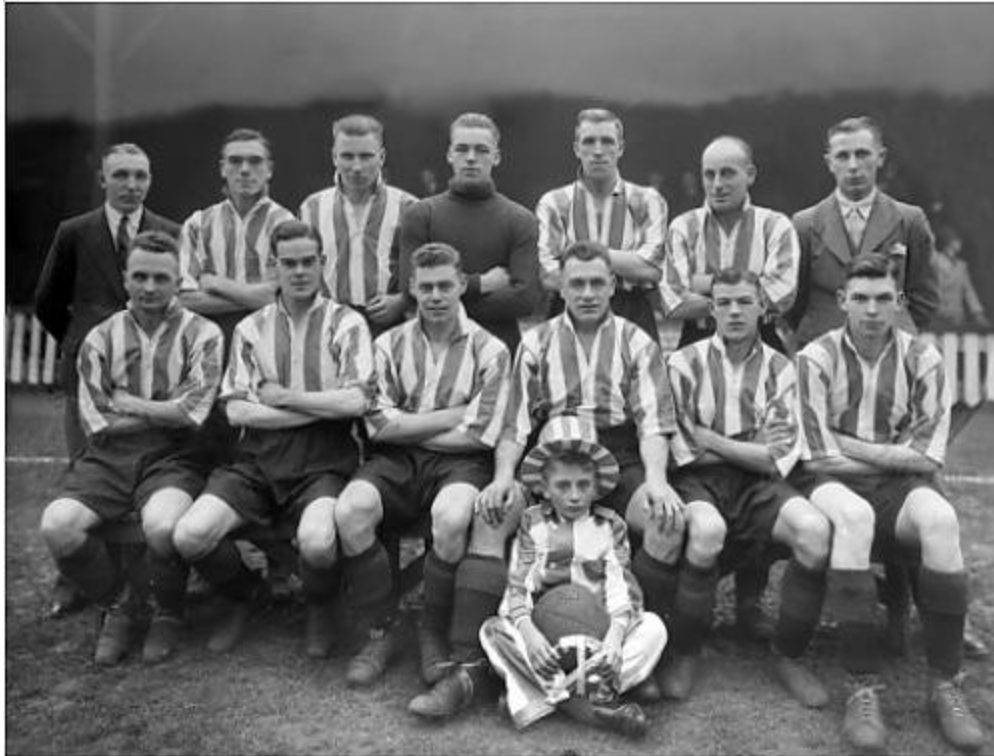 Back Row L to R –
Back Row L to R –
Ernie Park, Jimmy Anderson, Charlie Metcalf, Eddy Dawson,
Tom Freeman, Tom Young, E. Hall.
Front Row L to R –
George Hickman, Sam Gill, Albert Dunmore, Jack Kennedy,
James Robinson, Tom Carnaby.
Mascot unknown.
*Taken at Edgeley Park on Wednesday 28th November 1934 before
1-4 FA Cup 1st Round Replay defeat by Stockport County.
1934/35 –
Blyth Spartans Reserves *Taken on Saturday 13th October 1934 before 0-5 Tyneside League defeat at Percy Main Amateurs.
*Taken on Saturday 13th October 1934 before 0-5 Tyneside League defeat at Percy Main Amateurs.
1933/34 –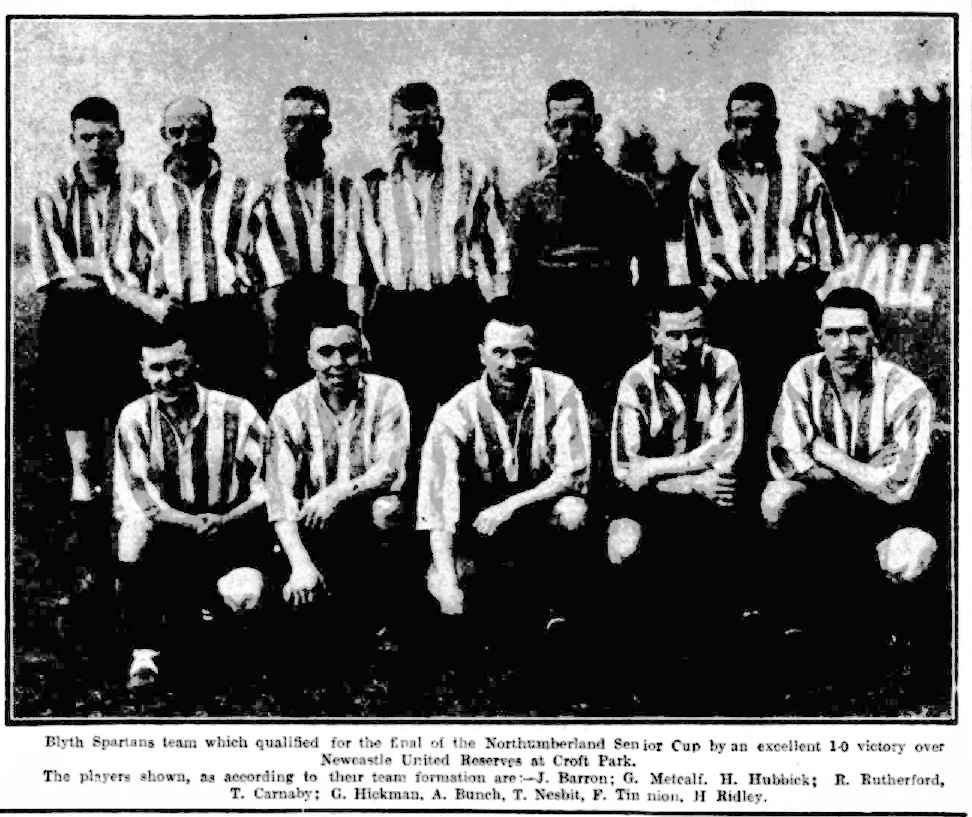 *Taken on Wednesday 24th January 1934 at Croft Park before 1-0 win over
*Taken on Wednesday 24th January 1934 at Croft Park before 1-0 win over
Newcastle United Reserves in Northumberland Senior Cup Semi Final.
1931/32 –
Blyth Spartans Reserves *Taken on Saturday 12th March 1932 at Croft Park before 1-3 defeat to New Delaval Villa
*Taken on Saturday 12th March 1932 at Croft Park before 1-3 defeat to New Delaval Villa
in Semi Final of Northumberland Aged Miners Homes Cup.
1929/30 – Back Row L to R –
Back Row L to R –
W.W Reed Secretary, William Banks, Charlie Metcalfe, George Turnbull,
Stan Bell, G. Lillistone, G. Gogle, W. Cotton Trainer.
Front Row L to R –
T. Stephenson Chairman, W.H Spry, Andy Kell, W. Taylor, Harry Hogg,
Percy Tait, W. Rowell Vice Chairman.
*Taken on Saturday 7th September 1929 at Croft Park before 2-3 defeat
to West Stanley in North Eastern League.
1928/29 – Handwritten names on reverse of this post card:
Handwritten names on reverse of this post card:
GK: Turnbull, Full Backs: Robson, Hyde.
Half back line: Taylor, Richmond, Hogg.
Forwards: Graham, Linfoot, Sanderson, Tait, Duffell.
*Taken at Croft Park, this Post Card photo has Blyth Spartans hand written
on the reverse and a list of players but not in the order they appear in the photo.
Long serving trainer Bill Lawton is on far left of image, Hugh Richmond is 5th from left,
was he was Blyth’s first professional player and with that he had other duties at the club.
He was the groundsman at Croft Park, also had to run the Spartans Wednesday team.
Blyth Wednesday team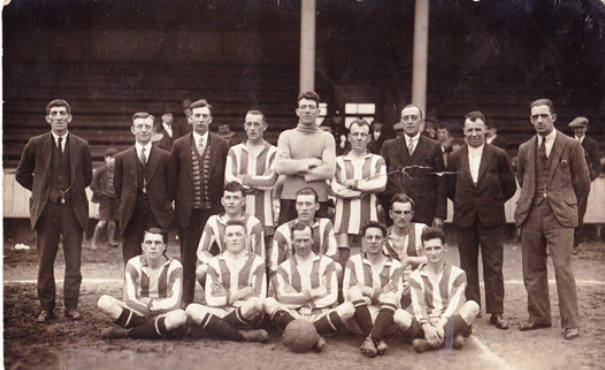 *Taken at Croft Park, it was a half day on a Wednesday for most businesses in those days
*Taken at Croft Park, it was a half day on a Wednesday for most businesses in those days
and there was several Wednesday football leagues for teams to compete in.
Blyth Wednesday team played in the Tyneside Wednesday League,
Spartans Trainer Bill Lawton (far left) and First Team player
Hugh Richmond (far right) ran the clubs Wednesday team.
1922/23 – Back Row L to R –
Back Row L to R –
Jack Blythe Trainer, Robert Park, Ian MacLachlan, Albert Telford, Jimmy Potts,
R. Taylor, Alf Fenwick, Dr. J.M MacLachlan Club Doctor.
Front Row L to R –
J. Prior, L. Pyke, George W. Pyke, Jackie Pearson, W. Watson.
*Taken behind the main Croft Park stand in build up to the FA Cup First Round
home tie with Stoke on Saturday 13th January 1923.
Lost game 0-3 in front of a then record 9,121 crowd of at Croft Park.
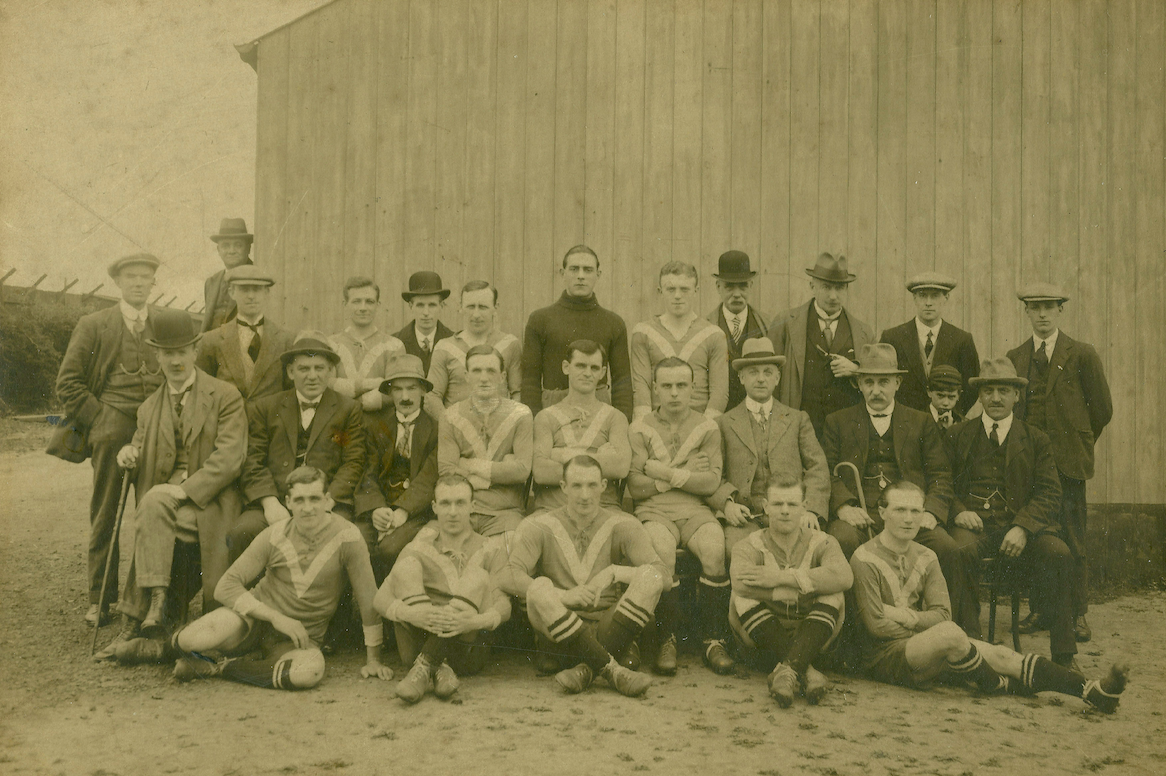
Back Row L to R –
Jack Blythe Trainer, T.W. Robson Secretary, gentleman behind in hat is unknown,
Robert Park, G. Kinnair Financial Secretary, Alfred Telford, Jimmy Potts,
Dr. Ian MacLachlan, T.C Nicholson Director, T.W Crozier Director,
F.E Barker Assistant Secretary, J. Blythe.
Middle Row L to R –
Dr. J.M MacLachlan Club Doctor, T. Stephenson Vice Chairman,
J.B Nicholson Chairman, W. Ward, Alfred Fenwick, Harry Hogg,
J.L Spence Director, J. Nicholson Director, J.G Parker Director.
Front Row L to R –
R. McGuire, J.L Pyke, George W Pyke, E. Thompson, W. Watson.
* Taken at Croft Park at side of main stand before start of the 1922/23 season.
1920/21 – Blyth Spartans Reserves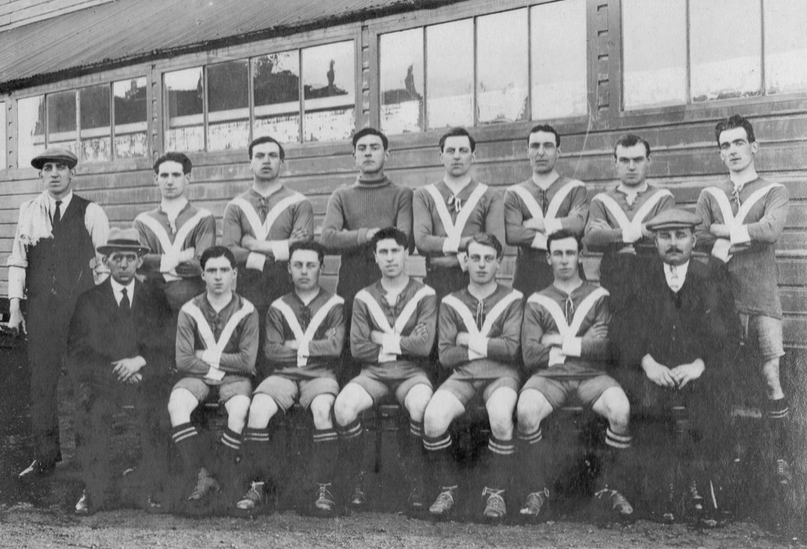 * Taken at Croft Park behind the main stand before start of the 1921/22 season.
* Taken at Croft Park behind the main stand before start of the 1921/22 season.
Unable to identify players and officials other than Billy Lawton Trainer far let of back row
and player Daniel James Barker in centre of front row.
• Please get in touch via email if you can identify any players or officials in this photo –
theblythspirit@hotmail.com
——————
1917-1918 – Blyth Spartans Munition Girls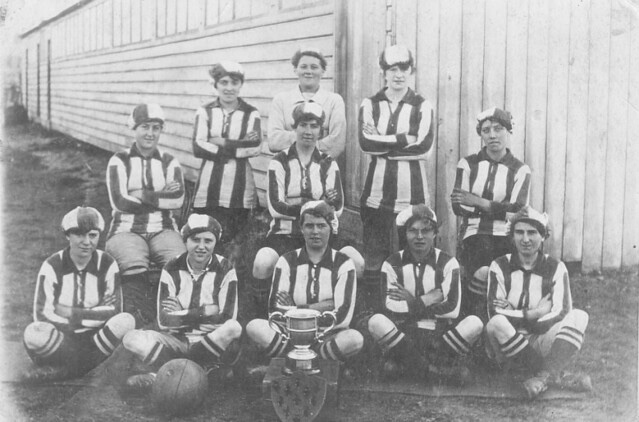
Blyth Spartans Munition Girls – Munitionette Cup Winners 1918
Back Row L to R – Hannah Weir, Lizzie James, Nellie Fairless
Middle Row L to R – Agnes Sample, Martha O’Brien, Bella Metcalfe
Front Row L to R – Dollie Allan, Annie Allan, Bella Reay, Ada Reed, Jennie Morgan
*Taken behind main stand at Croft Park following cup win.
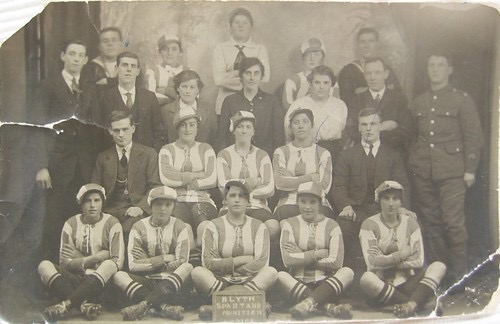 Blyth Spartans Munitionettes with club officials
Blyth Spartans Munitionettes with club officials
Back Row L to R –
“Easy” Baker, Hannah Malone, Lizzie James, Nellie Fairless, Steve (surname unknown).
Third Row L to R –
W. Fairless, G. Bird, Julia Stevens, Mrs Fawcett, M. Carr, Jim McNally, W. Campbell.
Second Row L to R –
R. Thompson, Agnes Sample, Martha O’ Brien, Bella Metcalfe, Ted Ellis.
Front Row L to R –
Dollie Summers, Annie Allen, Bella Reay, Dolly Allen, Jennie Morgan.
• The version below was taken with only the the team players.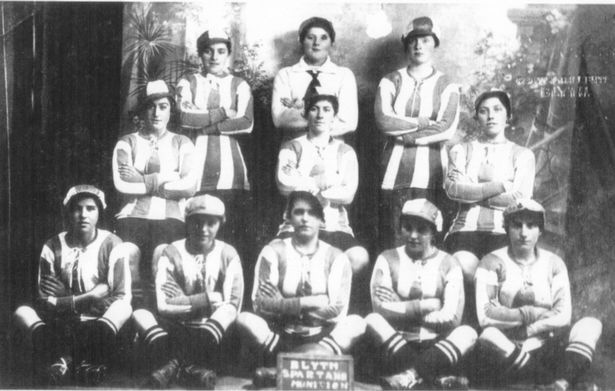
——————
1913/14 –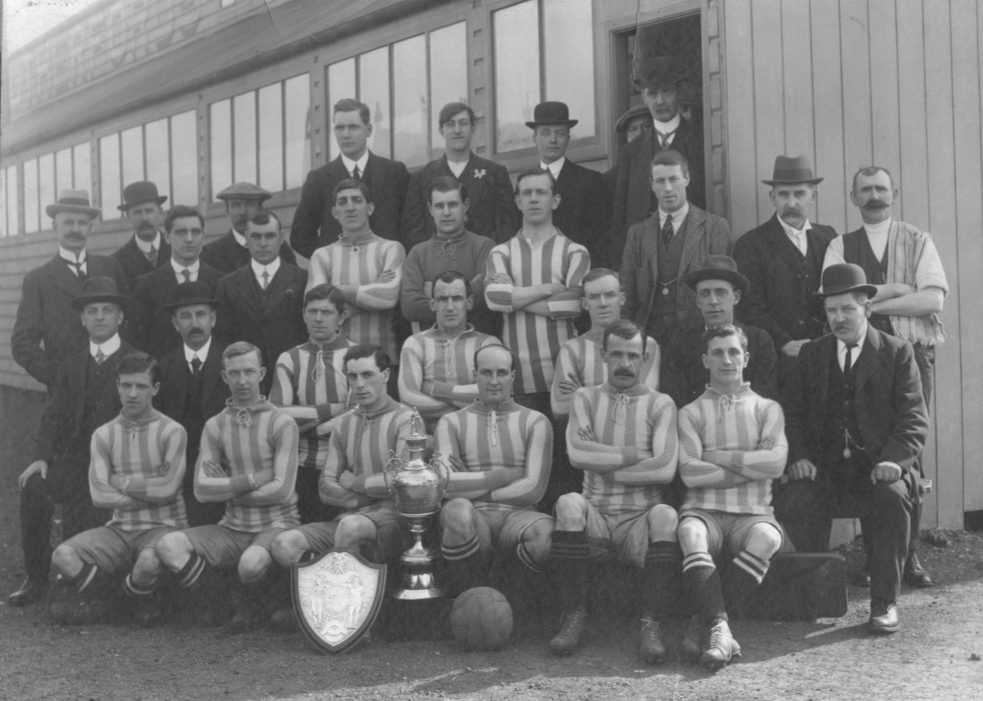
Back Row L to R –
R. Harrison Committee, Unknown, R. Shiel Committee, T. Nicholson Treasurer.
Third Row L to R –
J. Goulding President, T. Gibb Financial Secretary, W. Hickleton Committee,
F. Southern Committee, W. Fairhurst Committee, William Lawton, Norman Findlay, R. Moore,
Unknown, J. Nicholson Chairman, R. Bird Trainer.
Second Row L to R –
J.E Spence Committee, W.J Parker Secretary, R. Brown, L. Lambert, Jack Blythe,
J.Horn Committee, J. Watson Snr Committee.
Front Row L to R –
J. Watson, J. MacDonald, W. Pinchen, W.B Kelly, G. Ryder, G. Trotter.
* Taken at Croft Park at side of main stand before start of the clubs
first season in the North Eastern League. Trophy is Northern Alliance
champions trophy and shield won in 1912/13 season.
1909/10 –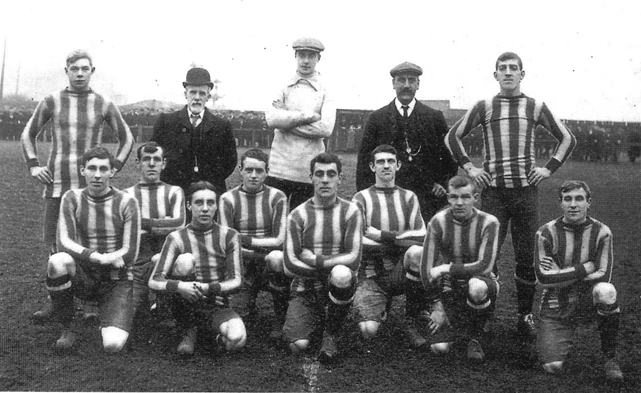 Back Row L to R –
Back Row L to R –
Clem Stephenson, Jonathan Ridley Secretary, J.W. Lee, Unknown official, Billy Lawton.
Front Row L to R –
Unknown player, Unknown player, Unknown player, Unknown player, Peter Mackin,
Jack Wright, Unknown player, Billy Spence.
* Taken on Wednesday 15th December 1909 before 3-1 Tynemouth Infirmary Cup
Quarter Final win at Bedington United.
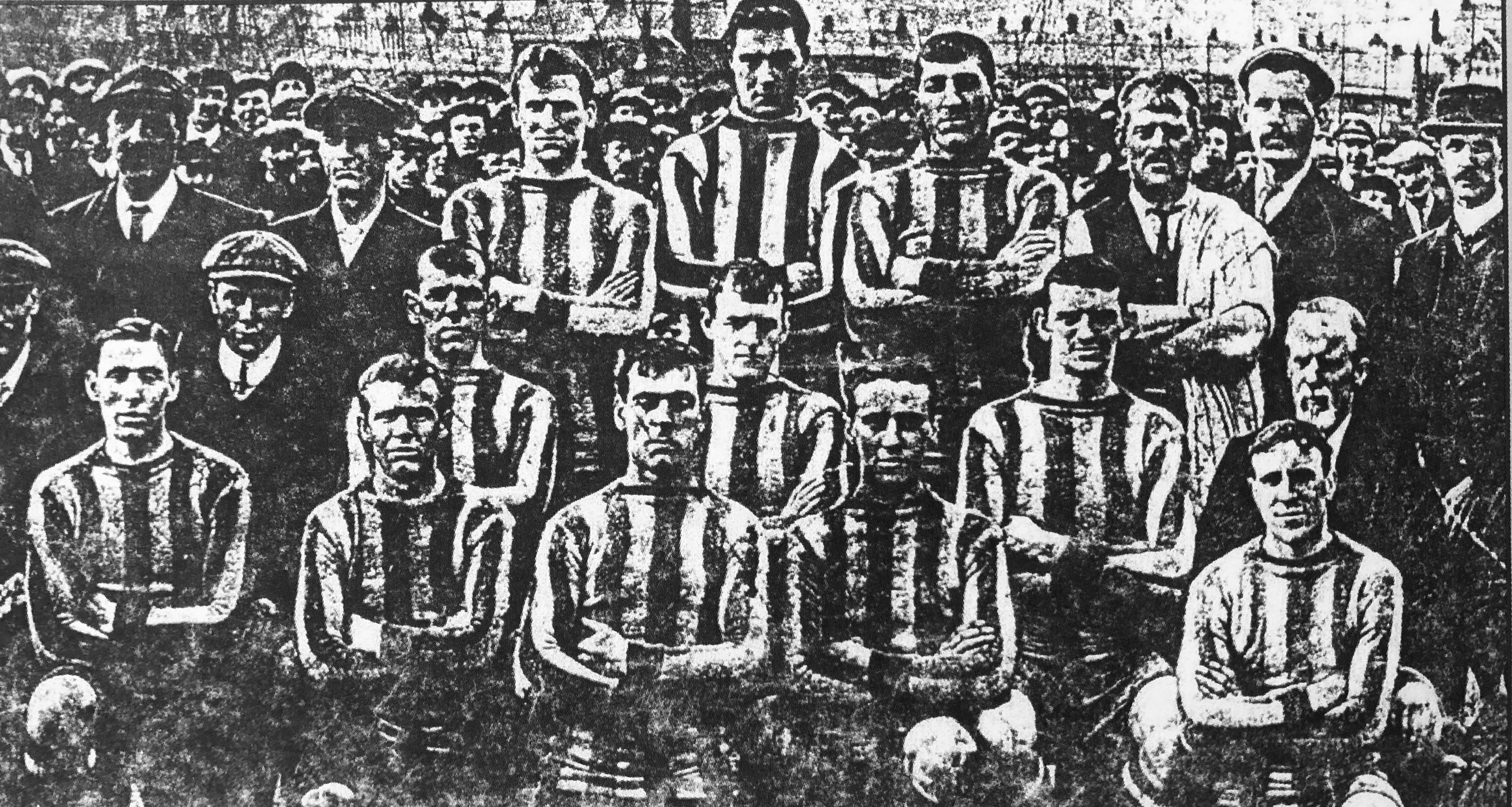 Back Row L to R –
Back Row L to R –
Unknown official, Unknown official, Unknown Player Unknown Player, Billy Lawton,
Unknown official, Unknown official, Unknown official.
Middle Row L to R –
Unknown official, Unknown official, Unknown player, Unknown player,
Jack Wright, Jonathan Ridley Secretary.
Front Row L to R –
Unknown player, Unknown player, Peter Makin, Unknown Player, Billy Spence.
* Unable to find an exact date and location of this photo but believed to
have been taken in March 1910 following Clem Stephenson’s move to Aston Villa.
• Please get in touch via email if you can identify any players or officials in this photo –
theblythspirit@hotmail.com
1905/06 –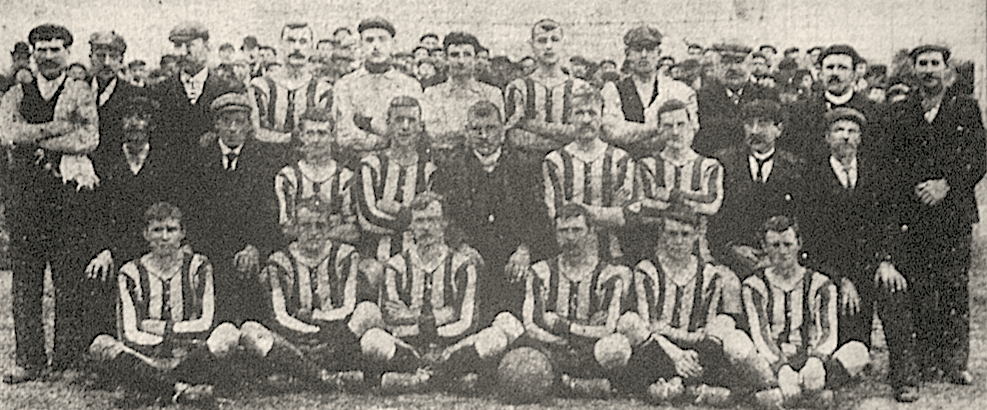
Back Row L to R –
E. Barker Trainer, W. Howard Committee, E. Riley Committee, W. Fairhurst, R. Craft,
C. Moreland, E. Parker, D. Maltman Trainer, T. Robson Committee,
W. Hogg Committee, E. Wakenshaw.
Middle Row L to R –
S. Barnes Committee, A. Thompson, H. Coundon, D. Little Captain, T. Stephenson Secretary,
W. Scott, A. Bailey, J. Parker Committee, F. Robinson Committee.
Middle Row L to R –
H. Stenhouse, N. Thompson, E. Mount, W. Todd, W. Spence, W. Scott.
* Taken on Wednesday 8th November 1905 before a Charity game against
Newcastle United for the Blyth Coble Disaster Relief Fund.
A 1,000 crowd at Croften Ground saw Blyth lose 1-7 to the Newcastle first team.
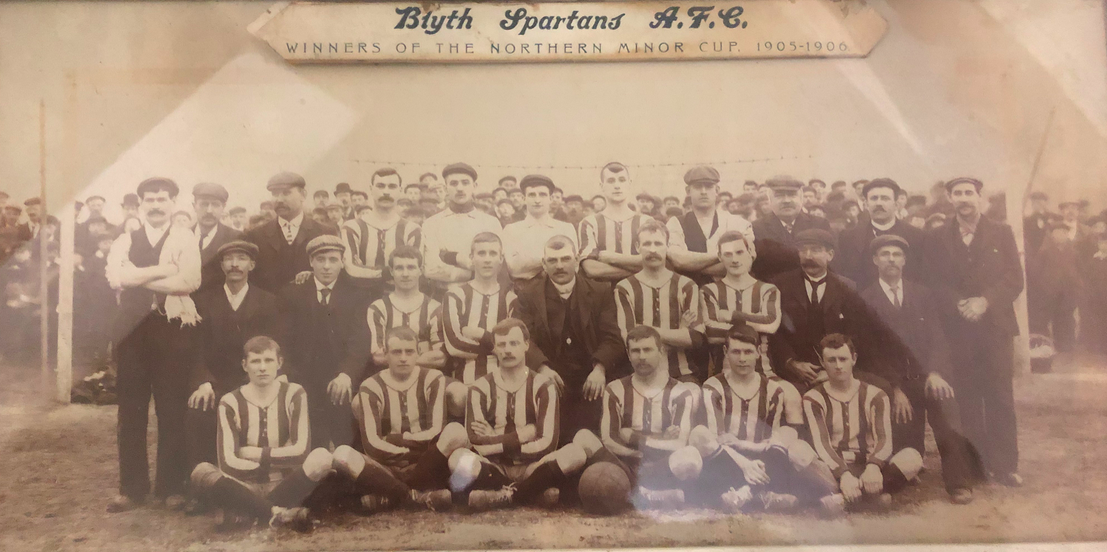 • The club owns better quality glass framed version of this team photo with a small plaque acknowledging winning the 1905/06 Northumberland FA Minor Cup.
• The club owns better quality glass framed version of this team photo with a small plaque acknowledging winning the 1905/06 Northumberland FA Minor Cup.
As shown the plaque states: ‘Winners of the Northern Minor Cup 1905/06’.
1901/02 –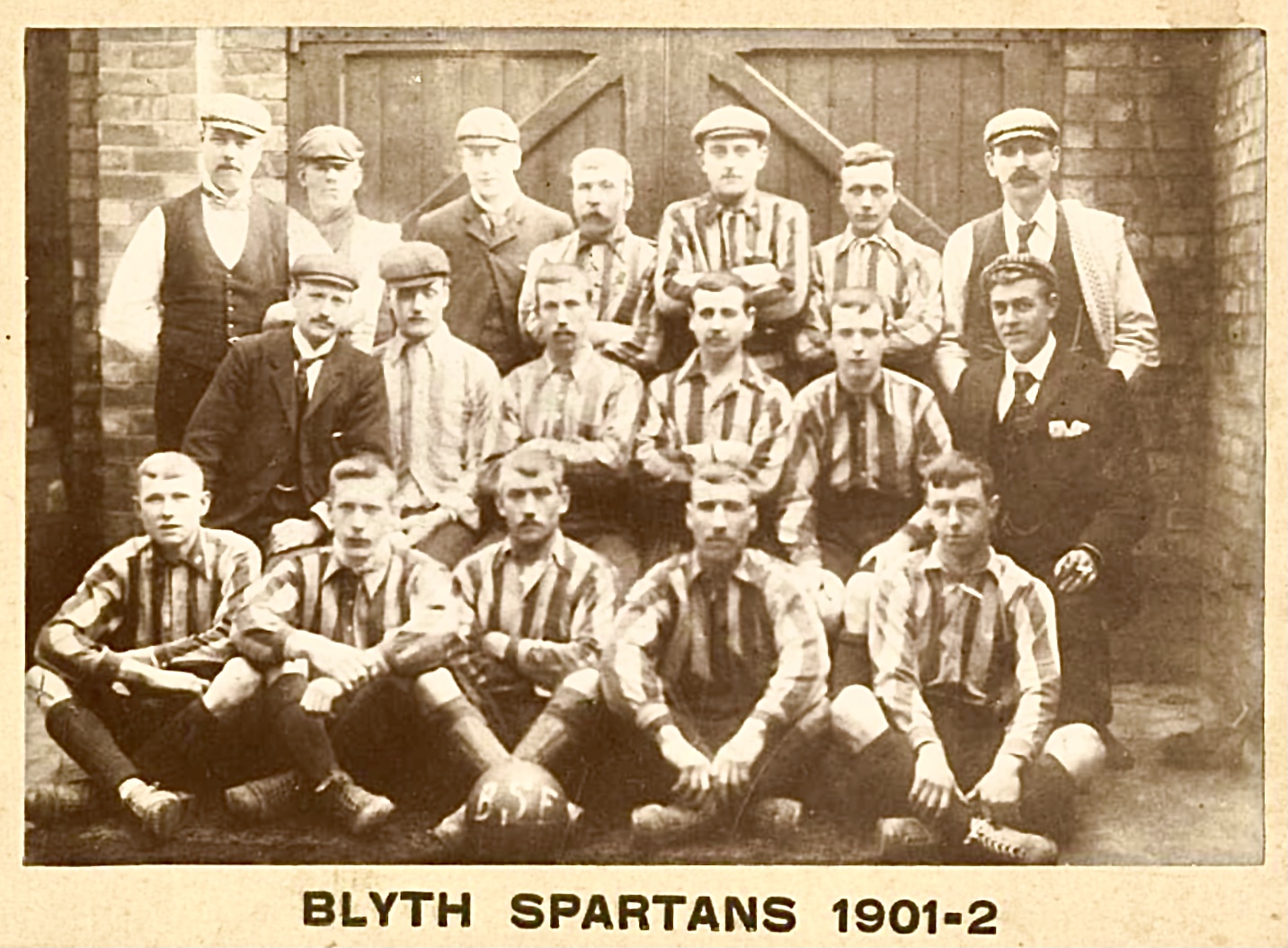 Back Row L to R –
Back Row L to R –
J. Purdy . D. Maltman, G. Robertson, F. Southern, J. Cannon, C. Fraser R. Bird
Middle Row L to R –
J. Archbold Snr, E. Mount, T. Elliot, J. Evans, W. Harvey, W. Rowell.
Front Row L to R –
H. Stenhouse, J. Baxter, R. Patton, P. McGalde, J. Archbold Jr.
* Taken at Travellers Rest public house which club used as its base then.
This is the earliest known team photo of the newly formed Blyth Spartans.
• While this image states ‘1901-2’ exact date is unclear because club started 1901/02
season wearing white shirts white shorts and red socks. The club did not
adopt the green & white stripes until start of the 1902/03 season.
— Other teams from the town’s history —
1959/60 – Blyth Villa FC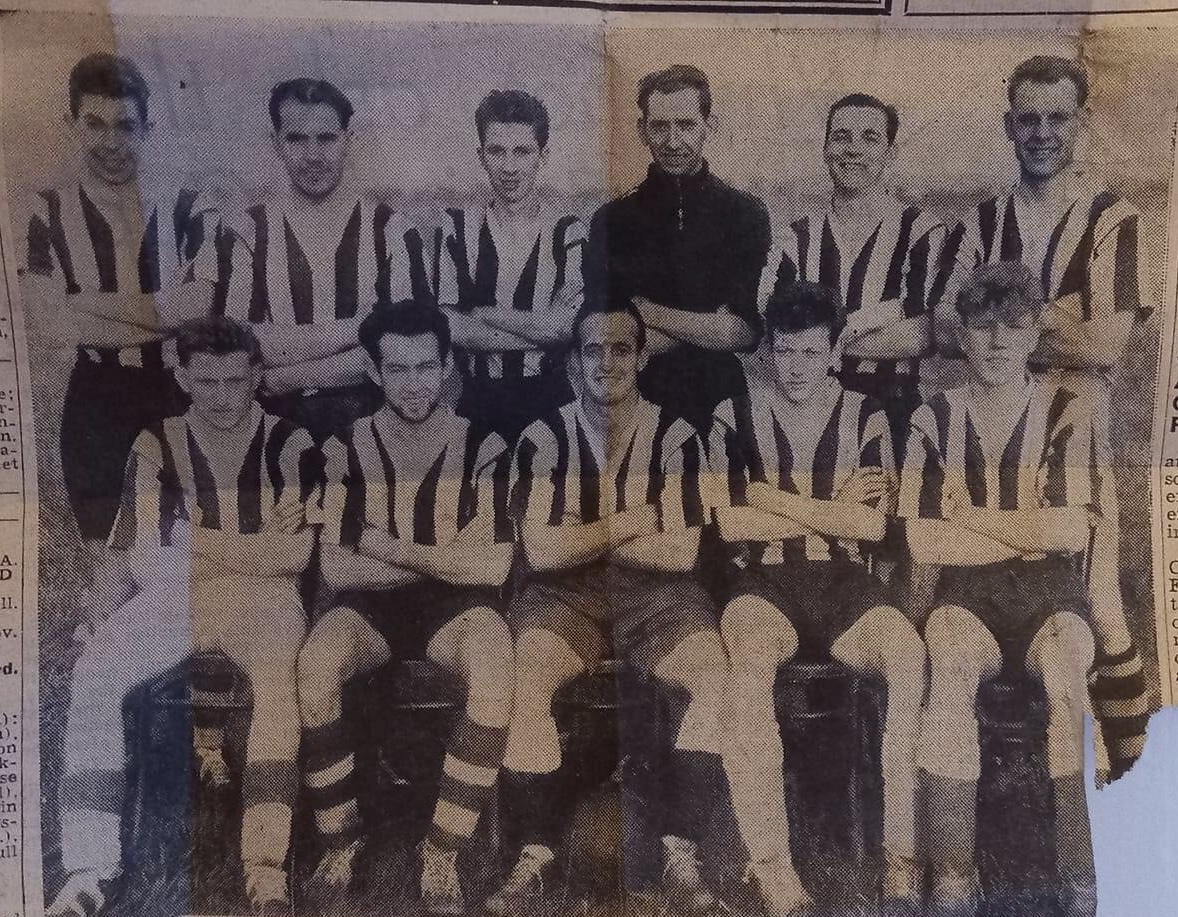 Back Row L to R –
Back Row L to R –
Patterson, James, Nesbitt, Murray, Robertson, Oliver.
Front Row L to R –
Storey, Day, Beckwith, Levy, Campbell.
* Played in East Northumberland League.
1945/46 – Blyth FC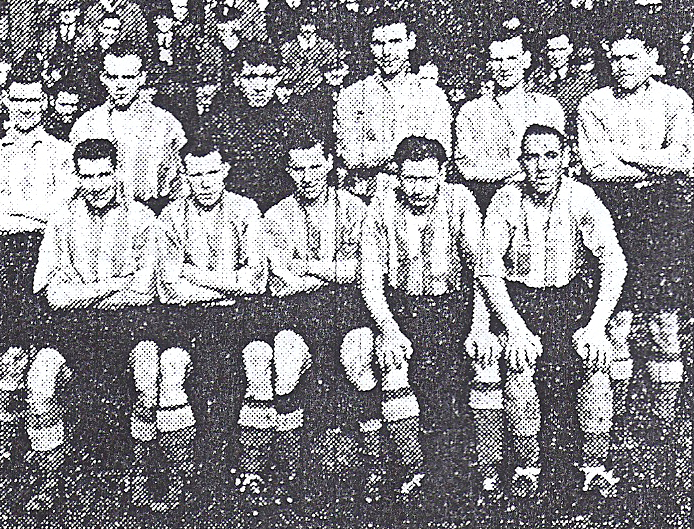 Text underneath original image states –
Text underneath original image states –
“Player shown are Easton (goalkeeper); Fairhurst and Buckham (full-backs);
Casson, Cook, McGlen (half-backs); Robinson, Fenwick, Yeowart, Barber, Dodds (forwards).
* Taken at Croft Park before 1-1 draw with Newbiggin Welfare in
Semi Final of Northumberland Senior Cup.
• Blyth FC took over from Blyth Shipyard FC for 1945/46 Nothern Combination League season as officials worked towards bringing the post war Blyth Spartans club back for the 1946/47 season.
1944/45 – Blyth Shipyard FC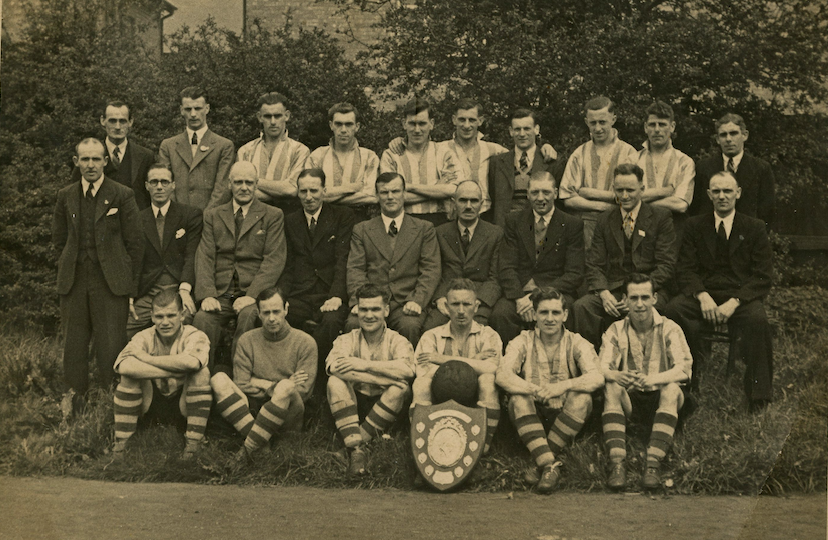
Back Row L to R –
G. Young, C. Thompson, J. Hayes, N. Gaffney, R. Gledson, R. Buckham,
E. Bell, W. Snape, J.Bird.
Middle Row L to R –
M.Bell, J. Thompson, J. Dolan, G.A Wiles, E. Ellis Chairman, W. Turnbull President,
J. Young Secretary, G. Glenworthy, T. Maughan.
Front Row L to R –
S. Dryden, W.C Brown, J. Fairhurst, D. Lewis, J. Turney, W. Cooper.
* Taken in grounds of Blyth shipyard before start of 1944/45 season showing
Northern Combination Runners Up Shield won the previous season.
It would prove to be the last season of Blyth Shipyard FC.
1943/44 – Blyth Shipyard FC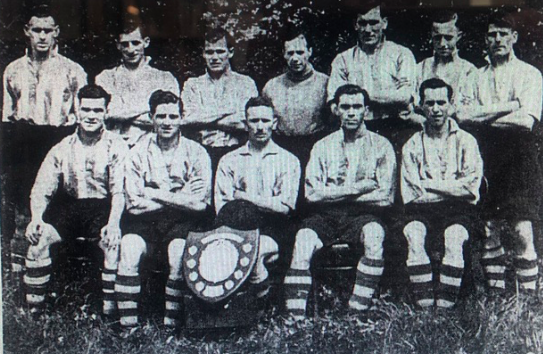 Back Row L to R –
Back Row L to R –
J. Thompson, R. Gledson, S. Dryden, W. Brown, N. Gaffney, E. Bell, L. Vince
Front Row L to R –
J. Fairhurst, J.A Turney, D.J Lewis, C.J Hayes, W. Cooper.
* Taken in grounds of Blyth shipyard following completion of 43/44 season
showing Northern Combination Runners Up Shield.
1930’s – Blyth Co Op FC possibly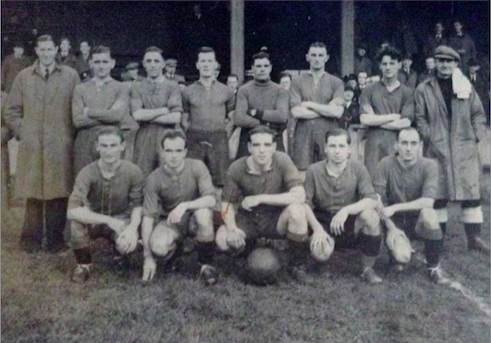 * Taken at Croft Park in front of main stand but unknown
* Taken at Croft Park in front of main stand but unknown
when exactly this photo was taken.
Believed to be the Blyth Co Op team who played
in the Blyth Wednesday League.
Players pictured include: George Summbell,
George Chapple, Eddie Farley & Carl Milson.
1931/32 – Blyth Plessey Athletic FC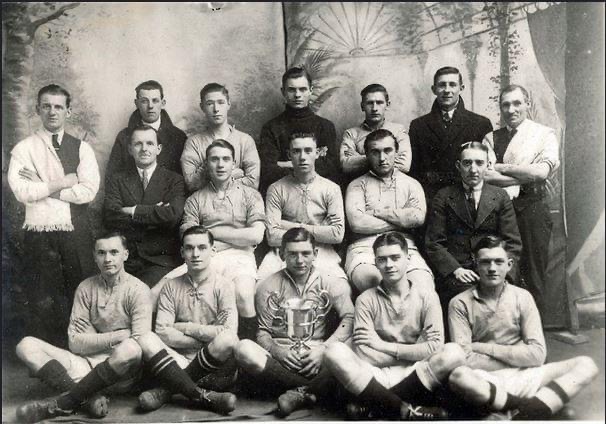
* 1931/32 Northumberland Junior Cup winners.
Unfortunately nothing else is known about this photo.
1927/28 – Blyth Gordon AFC
Back Row L to R –
N. Bone, J.W Turnbull, F. Lake, G. Hudson, T. Johnson.
Front Row L to R –
G. Brown Secretary, W. Straker, W. Ward, T. Charlton, W. Binks, J. Richardson.
Front Row L to R –
H. Tait, J. Blair, S. Wilkinson, J. Dryden, M. Rawlings.
* Blyth Gordon played in the Blyth and District League,
in 1972/28 the finished 3rd and won every
cup match they played winning 4 trophies.
The Blyth Hospital Cup was won beating
Blyth Spartans Reserves in the Final at Croft Park.
• For all the success the club folded in 1930 due to financial reasons!
1912/13 – Blyth Shamrock FC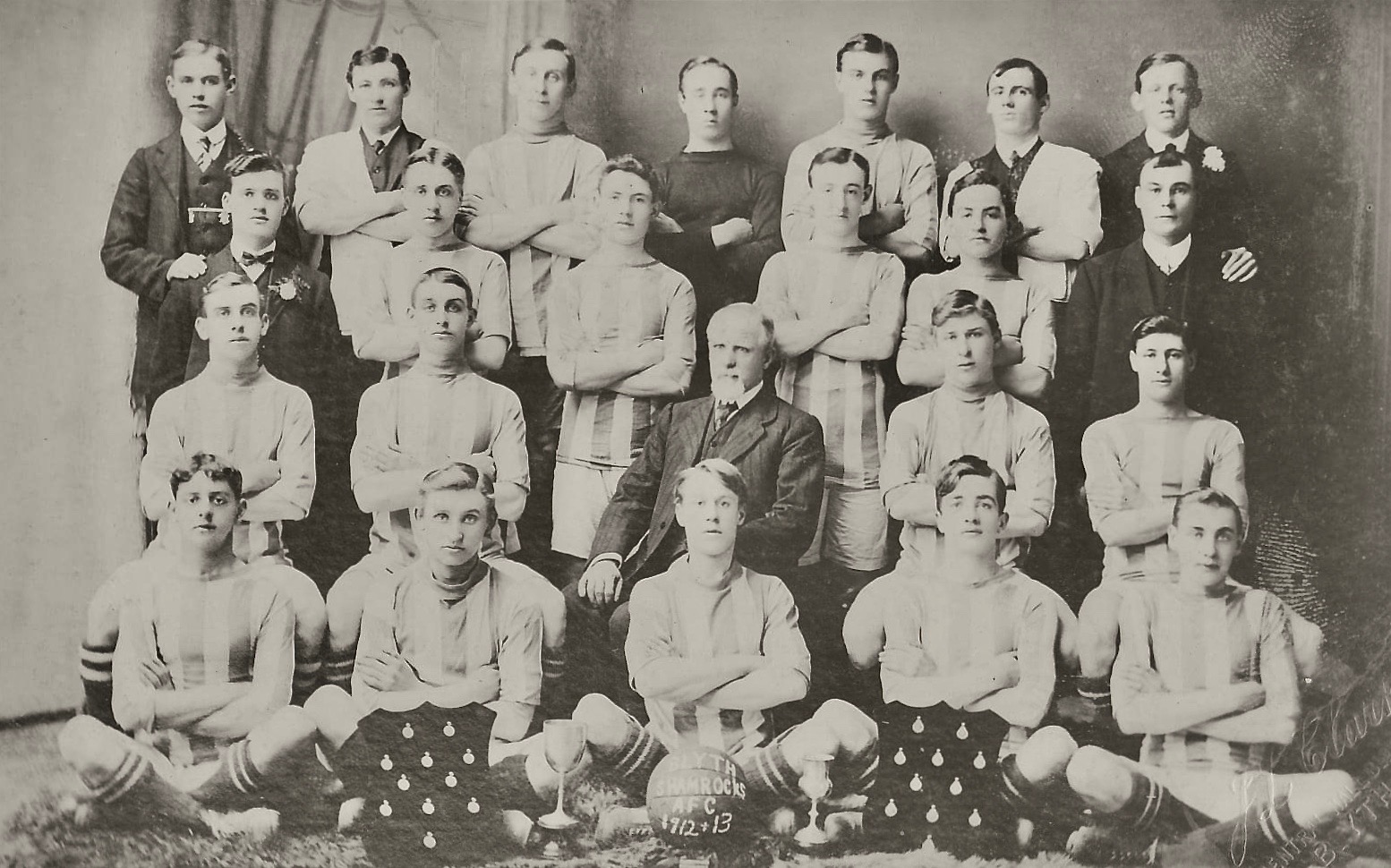
* 1912/13 Northumberland Junior Cup winners. Beat Rosehill Villa 4-3 in the Final
at St James’ Park following a 2-2 draw in first game, thus they became the first
Blyth winners of the NFA Junior Cup.
• Future Spartans Ted Ward, front row second from right,
but all others are unknown.
1911/12 – Blyth Shamrock FC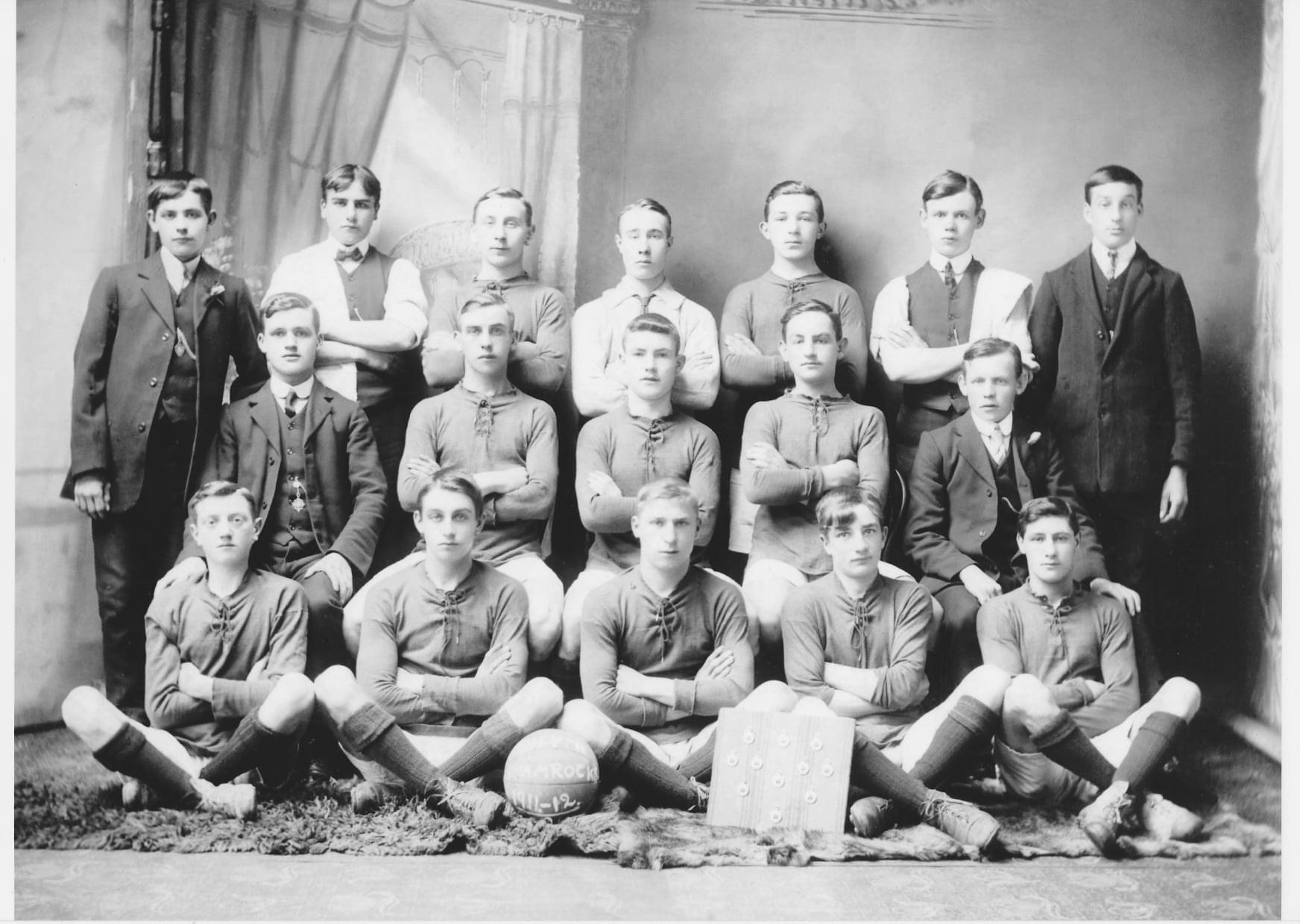 Back Row L to R –
Back Row L to R –
Andre York, George Wilkinson Trainer, Albert Telford, Arthur Howes, Wilf Mordue,
John Bower Trainer, Howard Irwin Committee.
Middle Row L to R –
Bob Thompson Secretary, Jack Dodds, Fred Hanson, Tom Lillie, George Hogg Treasurer.
Front Row L to R –
Greener Miller, Bob Thomson, Dick Summerfield, Ted Ward, George Allen.
* Runners Up in the Northumberland FA Junior Cup, lost replay 2-3 to Prudhoe Celtic
after 3-3 draw in first game, both played at St James’ Park.
• Ted Ward & Albert Telford would go on to play for Blyth Spartans.
• Secretary Bob Thompson would go onto work for Blyth News and became known as ‘Crofter’, spending many years covering all aspect of football in Blyth.
He also was involved with running of the Spartans and the Reserve side pre & post WWII.
1911/12 – Blyth Albion FC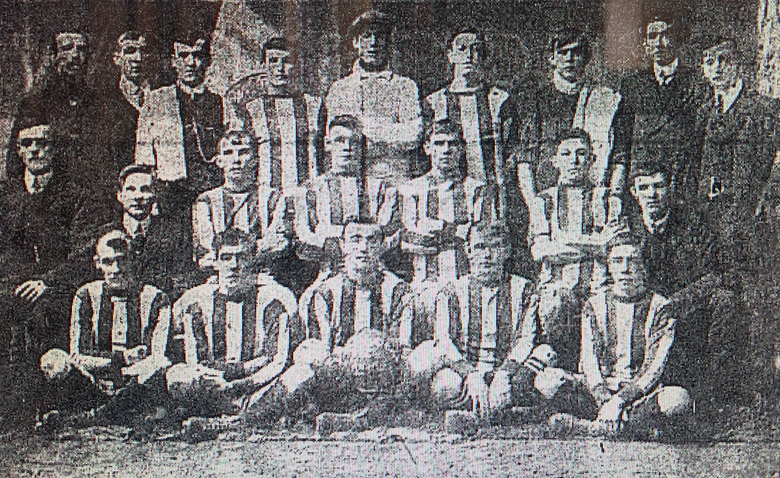
Back Row L to R –
T. Crate, J. Graham, D. Whitton, M. Delaney, C. Reid Trainer.
Middle Row L to R –
G. Taylor, J. Carr, M. Manners.
Front Row L to R –
A. Whiteman, A.B Mordue, T. Robinson, Spence, J. Holmes.
* Blyth Albion originated from Blyth FC Seconds team and played in
the Ashington and District League.
1898 – Blyth Thistle FC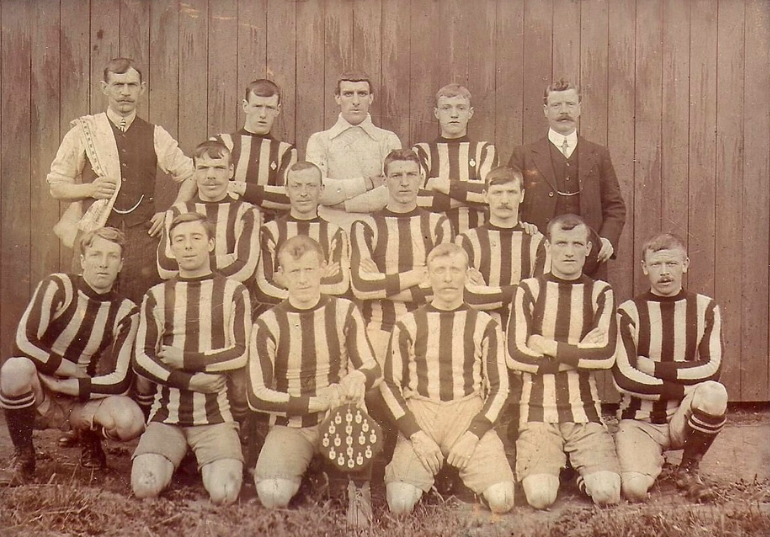 * Unknown when exactly this photo was taken but Blyth Thistle became the main team in
* Unknown when exactly this photo was taken but Blyth Thistle became the main team in
the town following Blyth FC folding and Blyth Spartans starting up.
• The black & white shirts were inherited from Blyth FC when they folded.
1898 – Blyth Albion FC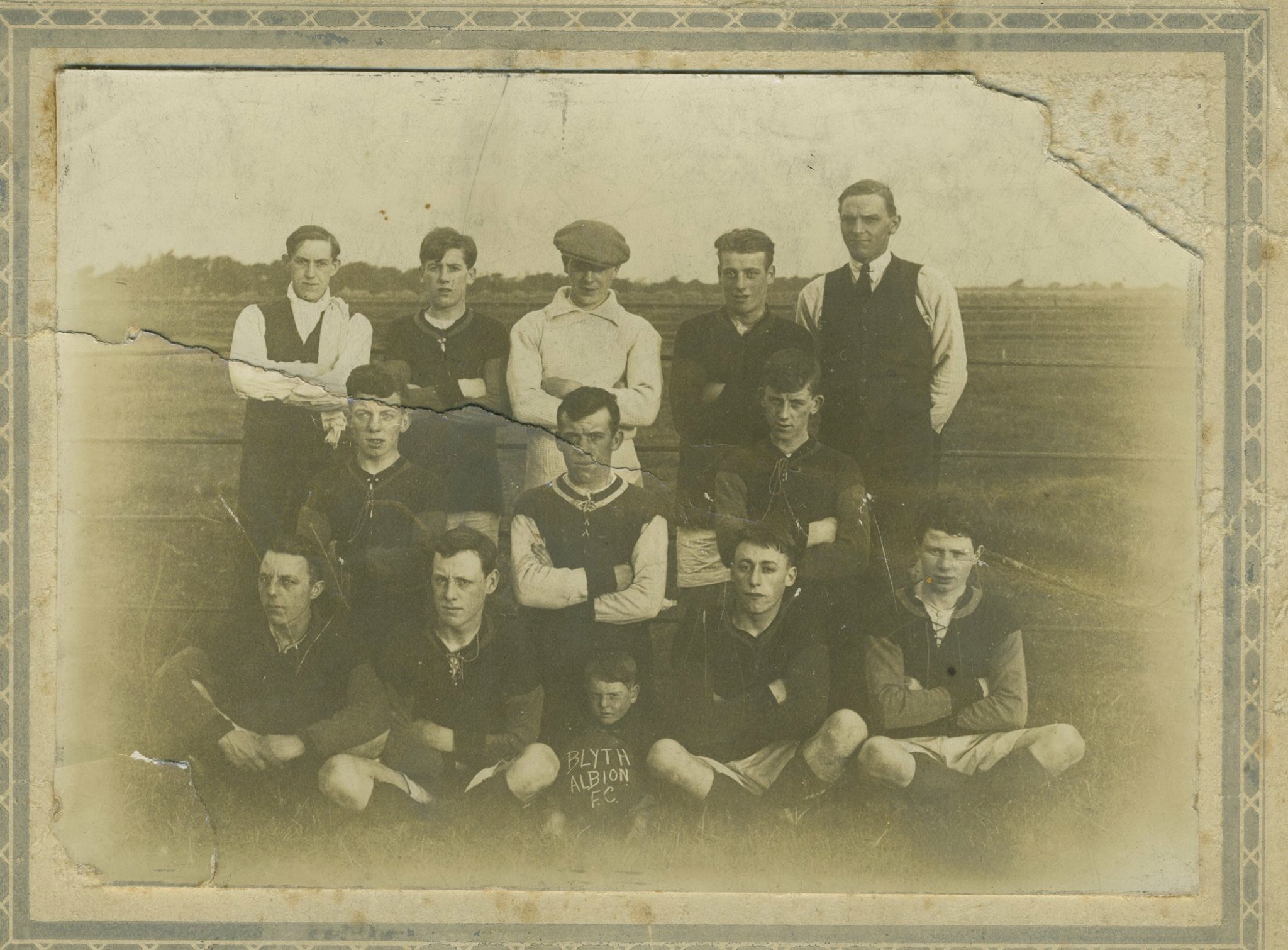
* Taken at Blyth Flats (now site of Ridley Park) date exactly when this photo was taken
is unknown but Blyth Albion played in the East Northumberland League in 1898/99.
1890’s – Blyth FC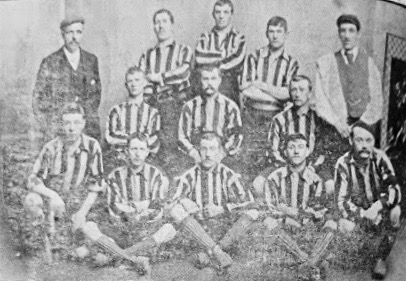
Back Row L to R –
T. Crate, J. Graham, D. Whitton, M. Delaney, C. Reid Trainer.
Middle Row L to R –
G. Taylor, J. Carr, M. Manners.
Front Row L to R –
J. McNally, W. Morton, T. Nicholson captain, R. Patton, T. Huster.
* Unknown when exactly this photo was taken but Blyth FC played in the
Northern Alliance from 1892/93 until folding early in the 1898/99 season.
• Image appeared in the Northern Athlete which was a weekly journal in 1890’s.
1895 – Blyth FC Seconds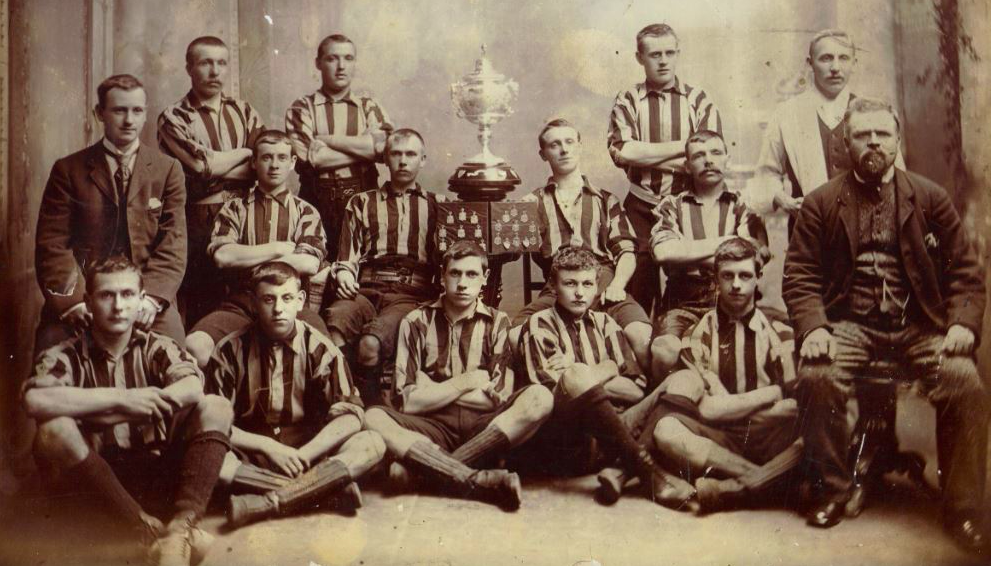 Back Row L to R –
Back Row L to R –
J. Archbold Secretary, F. Southern, Vickers, C. Rutherford, Peter Dixon.
Middle Row L to R –
J. Evans, T. Bell, W. Thompson, S. Ryce, G. Couthard.
Front Row L to R –
J. McNally, W. Morton, T. Nicholson captain, R. Patton, T. Huster.
* Trophy is Soulsby Charity Cup and Northumberland Medals.
——-
This page is not claiming ownership or credit for any of the images
that appear, it is purely an attempt to collate them in one place.
If the photographers are known they have been acknowledged/credited.
If you know whom took an image or one is your own please
get in touch so credit can be attributed.
——-
If you know of any photo’s/images of the team that do not feature
please get in touch so they can be added into the archive.
If you know of any missing players names in the photos
please get in touch so they can also be added.
Contact – theblythspirit@hotmail.com
——-
Acknowledgements, Credits and Thanks you’s –
The late Ken Sproat’s superb book ‘The History of Blyth Spartans’ was,
as ever, an important source of information.
Thanks go to the following Blyth fans for their help with collating recent team photos:
Martin Hunter, Dan Rolls, Jeff Young & Phil Castiaux.
Thanks to Club photographers –
Kris Hodgetts – https://www.khphotos.co.uk
Paul Scott – https://www.flickr.com/photos/153784279@N03/albums
Bill Broadley and former club photographer Steve White for their team images.
Thanks to Charlie Turney for use of images from the Turney Family collection.
Thanks to Steve Richmond for use of images and information from his research into his Richmond family history.
The following share images via their Twitter feeds –
FootballRetoplus – @robertmdaws
OldToonFan – @old_toon
The Famous Yorkshiremen – @NLSnapshots
Several teams images were found on https://www.flickr.com posted by the following –
Kevin Warburton, Brian Grey, @biddleofnowhere Photography,
Ron Aitchison, Michael Ripley.
Yvonne Crawford provided the images of the Blyth Munitionettes used in the original blog and again here.
Following websites contained images used –
http://prints.colorsport.co.uk
https://shop.memorylane.co.uk
https://www.alamy.com/
Several photos came from local newspapers who published the images at time they were taken –
Blyth News, Courier & The Evening Chronicle.
Several old team photos came from Blyth history Facebook pages –
Blyth Remembered & Memories and The Official Blyth Remembered.
*This will be continually updated as more images are found*

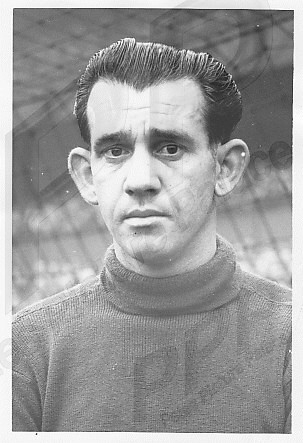 Henry Owen Mills was born in Blyth on 23rd August 1922, at Chapel Row in Cambois.
Henry Owen Mills was born in Blyth on 23rd August 1922, at Chapel Row in Cambois.
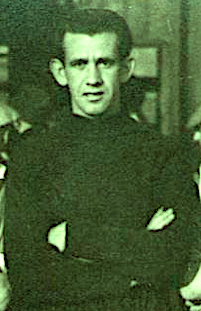 The clubs first game after reforming post war came on Saturday 31st August 1946, Harry was deservedly picked as first choice keeper playing in the 1-1 with North Shields Reserves at Croft Park while Goulding played for the Reserves in a 4-5 North East Alliance defeat at Barrington United.
The clubs first game after reforming post war came on Saturday 31st August 1946, Harry was deservedly picked as first choice keeper playing in the 1-1 with North Shields Reserves at Croft Park while Goulding played for the Reserves in a 4-5 North East Alliance defeat at Barrington United.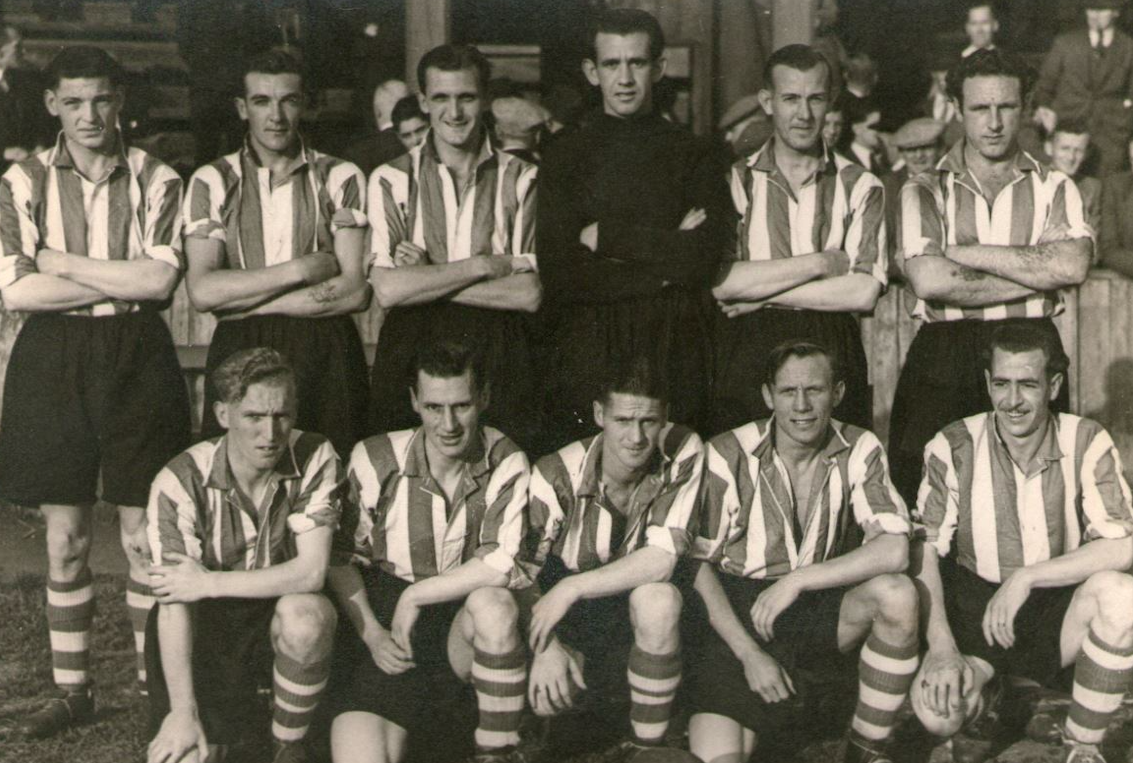 1947/48 saw Blyth return to the North Eastern League with 25 year old Harry now firmly established as first choice keeper.
1947/48 saw Blyth return to the North Eastern League with 25 year old Harry now firmly established as first choice keeper.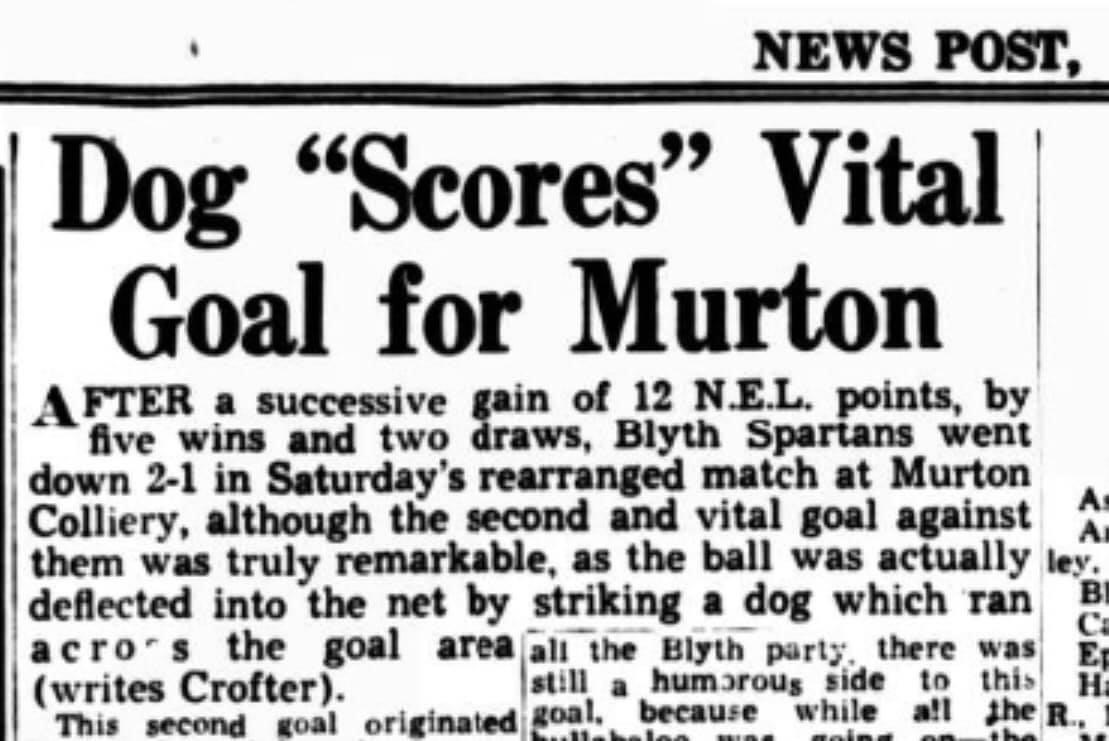 The most bizarre goal he ever conceded came on Saturday 27th December 1947 when Blyth played Murton Colliery Welfare away.
The most bizarre goal he ever conceded came on Saturday 27th December 1947 when Blyth played Murton Colliery Welfare away.
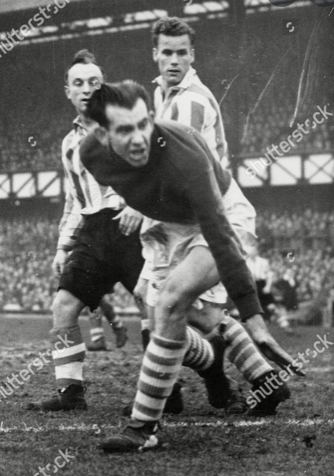 In what turned out to be his 59th and last appearance for the club he saved a penalty in a 2-1 win at Consett on Saturday 28th February. In the crowd that afternoon and suitably impressed with what they had seen were officials from First Division Huddersfield Town.
In what turned out to be his 59th and last appearance for the club he saved a penalty in a 2-1 win at Consett on Saturday 28th February. In the crowd that afternoon and suitably impressed with what they had seen were officials from First Division Huddersfield Town.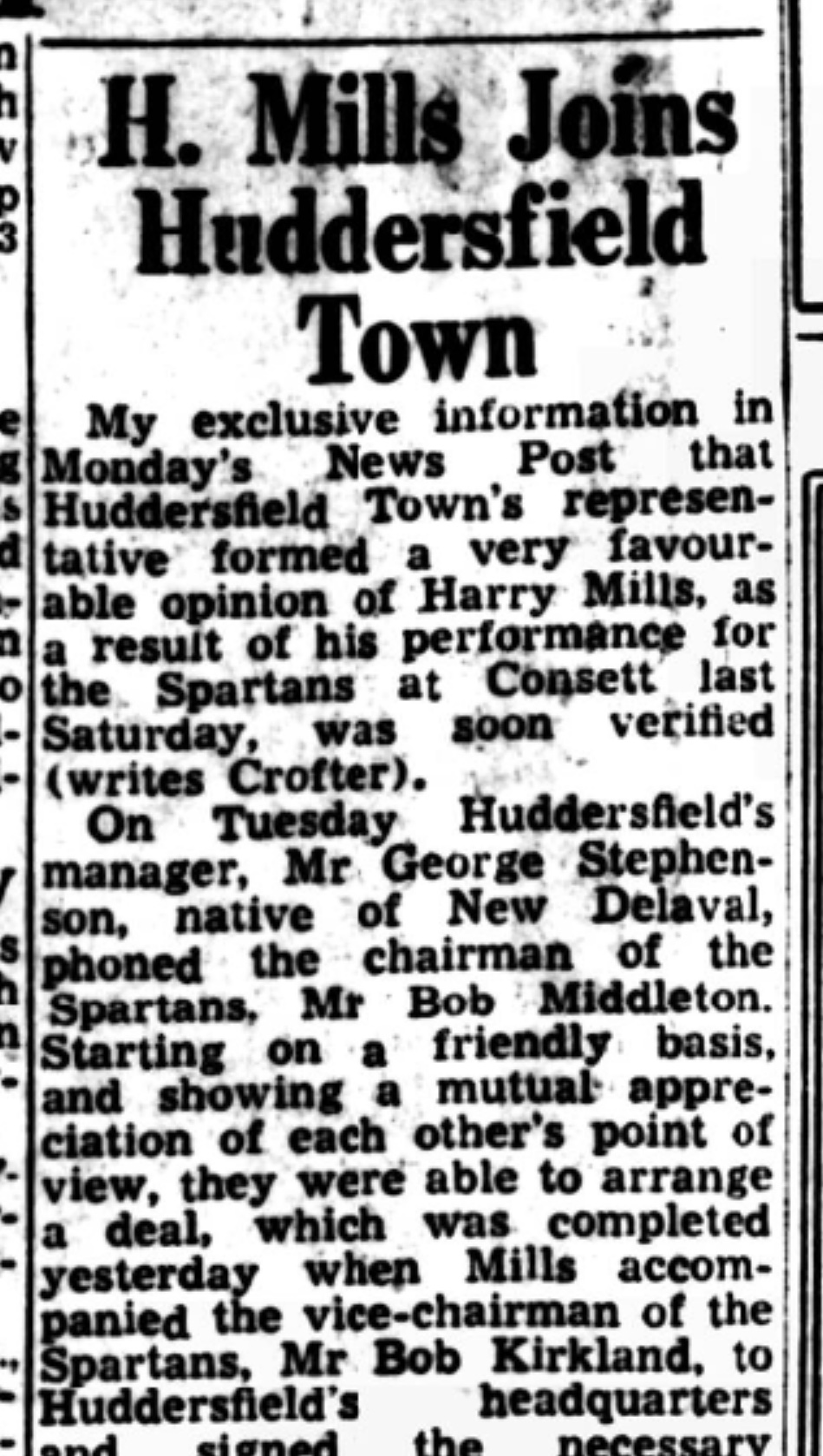 On Tuesday 2nd March, George Stephenson rang the Spartans Chairman Bob Middleton, t
On Tuesday 2nd March, George Stephenson rang the Spartans Chairman Bob Middleton, t March 1948 proved quite an eventful for him, not only signing for Huddersfield Town but five days after making this Football League debut he was back up north preparing for his ‘big day’.
March 1948 proved quite an eventful for him, not only signing for Huddersfield Town but five days after making this Football League debut he was back up north preparing for his ‘big day’.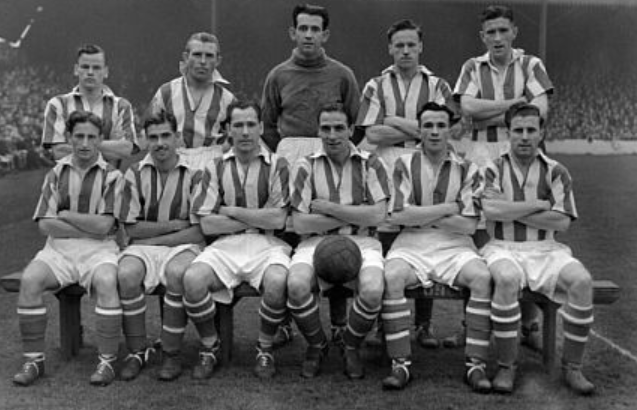 Bob Hesford was still out injured by the time 1948/49 came around, Harry retained his place in the first team playing in the first game of the season, a 1-1 draw with Arsenal at Leeds Road.
Bob Hesford was still out injured by the time 1948/49 came around, Harry retained his place in the first team playing in the first game of the season, a 1-1 draw with Arsenal at Leeds Road.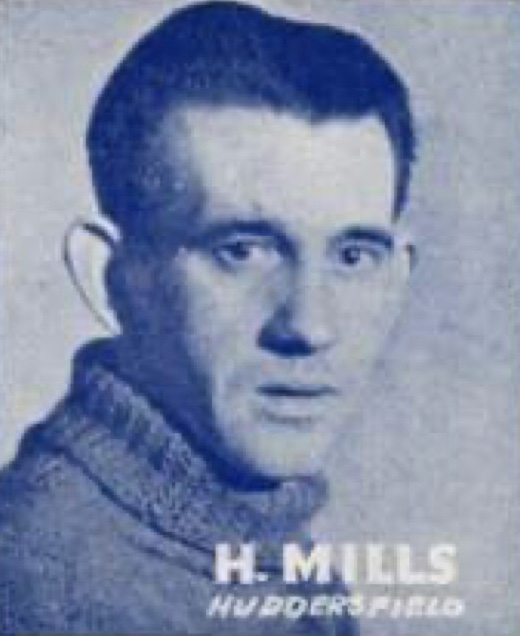 For the 1949-50 season, Harry was firmly established as the first team goalkeeper and missed just eight games, Bob Hesford eventually returned briefly in September before losing his place to Harry, Hesford would never play another game for the club and eventually departed in August 1950 to become a teacher.
For the 1949-50 season, Harry was firmly established as the first team goalkeeper and missed just eight games, Bob Hesford eventually returned briefly in September before losing his place to Harry, Hesford would never play another game for the club and eventually departed in August 1950 to become a teacher.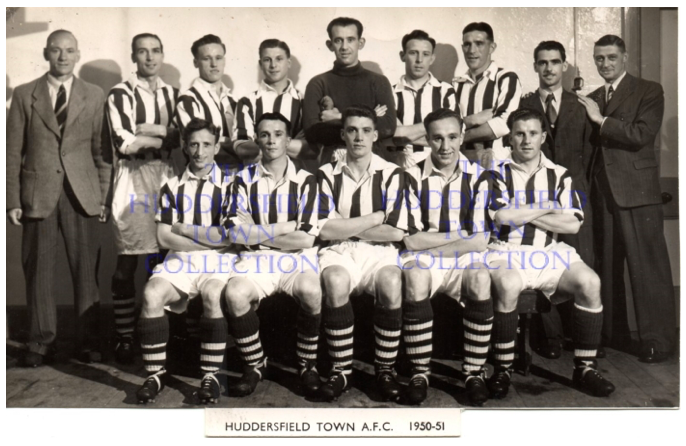 During the 1950-51 season, which Harry had started as the first choice he lost his place to Jack Wheeler after letting eight goals in a 0-8 defeat at Middlesbrough on 30th September.
During the 1950-51 season, which Harry had started as the first choice he lost his place to Jack Wheeler after letting eight goals in a 0-8 defeat at Middlesbrough on 30th September.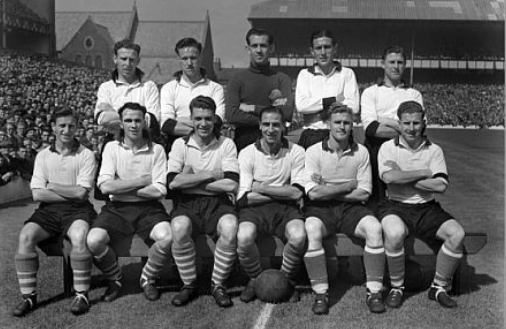 Harry briefly won his place back during 1951-52 but only for four games before being dislodged by Wheeler. In a season where Town remained in the bottom two from October onwards, it was a miserable season that was only heading one way, down.
Harry briefly won his place back during 1951-52 but only for four games before being dislodged by Wheeler. In a season where Town remained in the bottom two from October onwards, it was a miserable season that was only heading one way, down.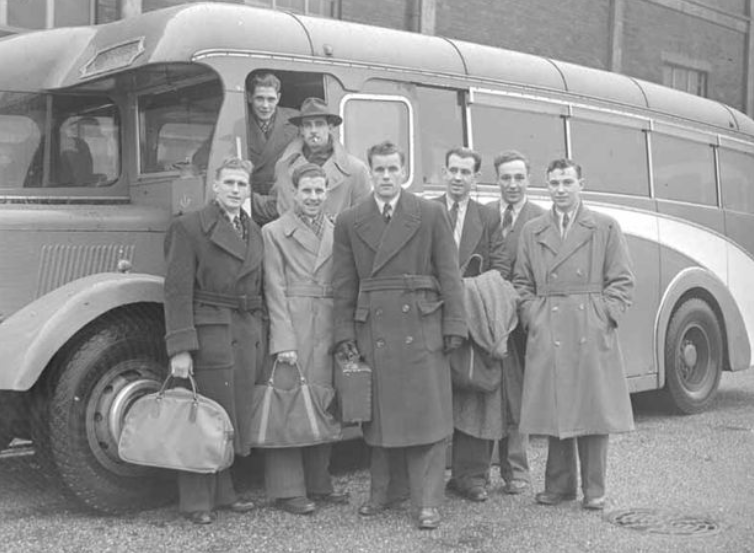
 After his season in the Reserves Harry did win his place back for the 1955-56 season, though he played just 10 games before Wheeler was reinstalled as first choice.
After his season in the Reserves Harry did win his place back for the 1955-56 season, though he played just 10 games before Wheeler was reinstalled as first choice. In December 1955, after seven years and 157 appearances Harry left Leeds Road to join Halifax Town in search of regular first team football.
In December 1955, after seven years and 157 appearances Harry left Leeds Road to join Halifax Town in search of regular first team football.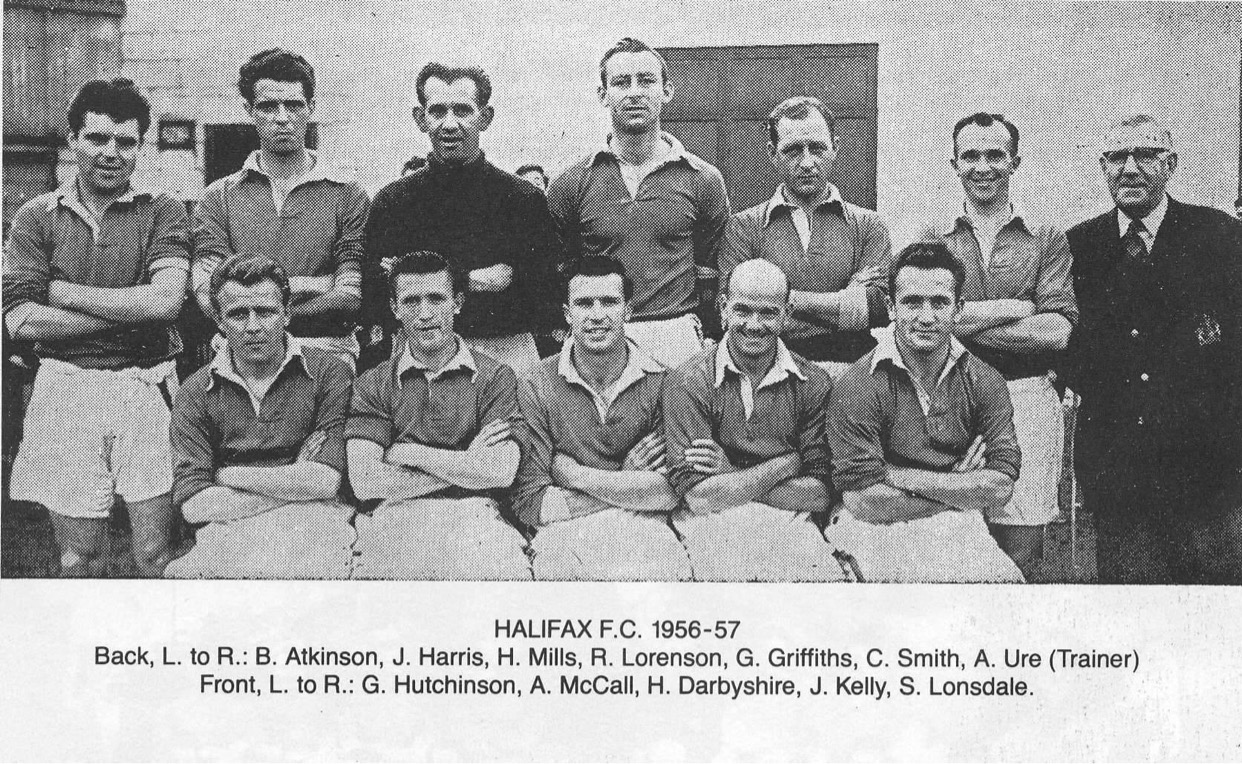 However, after only three more starts and following a 3-3 draw at home to Gateshead on 10th March, Arthur Johnson was reinstalled as first team keeper and kept his place for the rest of the season.
However, after only three more starts and following a 3-3 draw at home to Gateshead on 10th March, Arthur Johnson was reinstalled as first team keeper and kept his place for the rest of the season.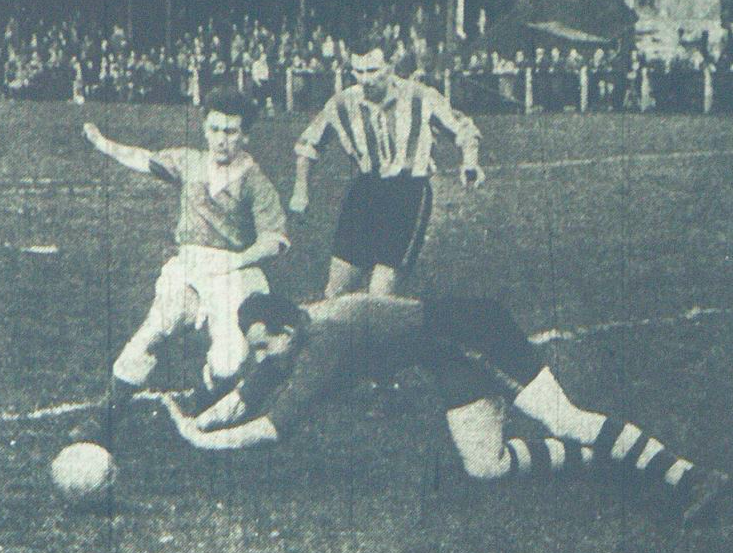 He made his return debut on Saturday 24th August 1957 but couldn’t prevent the Spartans falling to a 1-2 home defeat to Consett. He played in 36 consecutive games in that first season back before missing the last three games of the season, Tommy Orr replaced him.
He made his return debut on Saturday 24th August 1957 but couldn’t prevent the Spartans falling to a 1-2 home defeat to Consett. He played in 36 consecutive games in that first season back before missing the last three games of the season, Tommy Orr replaced him. 1958/59 brought him his first winners medal in mens football, Blyth fought their way to the Northumberland Senior Cup Final.
1958/59 brought him his first winners medal in mens football, Blyth fought their way to the Northumberland Senior Cup Final.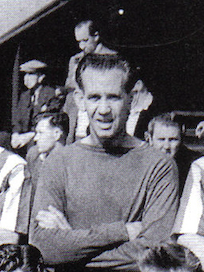 The following 1960/61 season saw Harry play in yet another new league for him and the Spartans.
The following 1960/61 season saw Harry play in yet another new league for him and the Spartans.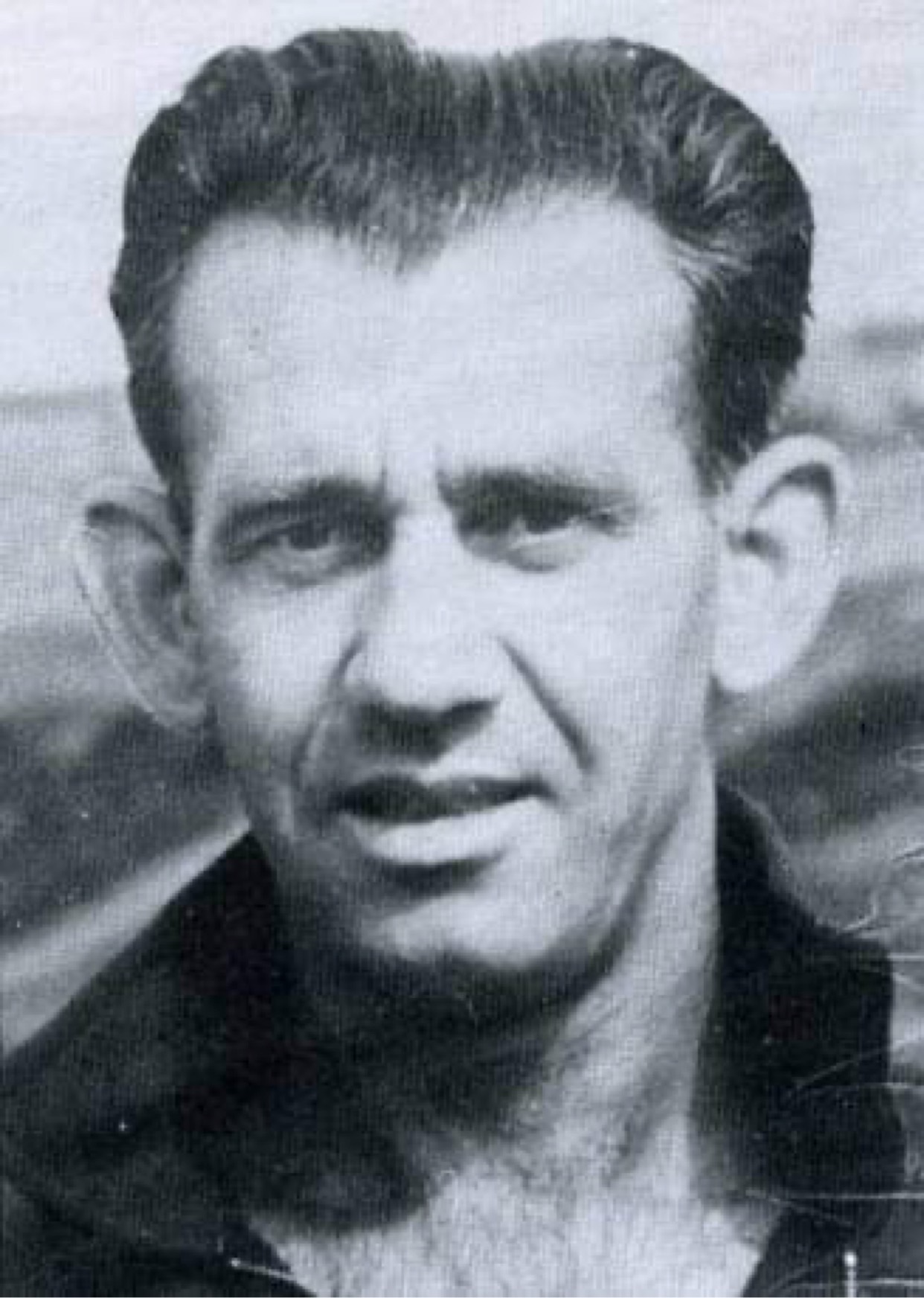 The 1961/62 campaign proved to be the final one for Harry, now aged 38 he made 23 appearances before hanging up his gloves.
The 1961/62 campaign proved to be the final one for Harry, now aged 38 he made 23 appearances before hanging up his gloves.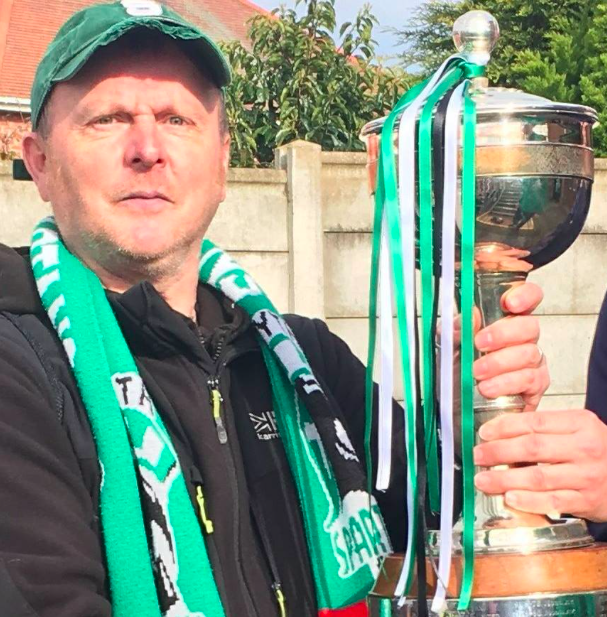 It’s taken him 26 years to achieve his feat and reckons in doing so has clocked up enough miles to have traveled around the world 30 times!
It’s taken him 26 years to achieve his feat and reckons in doing so has clocked up enough miles to have traveled around the world 30 times!
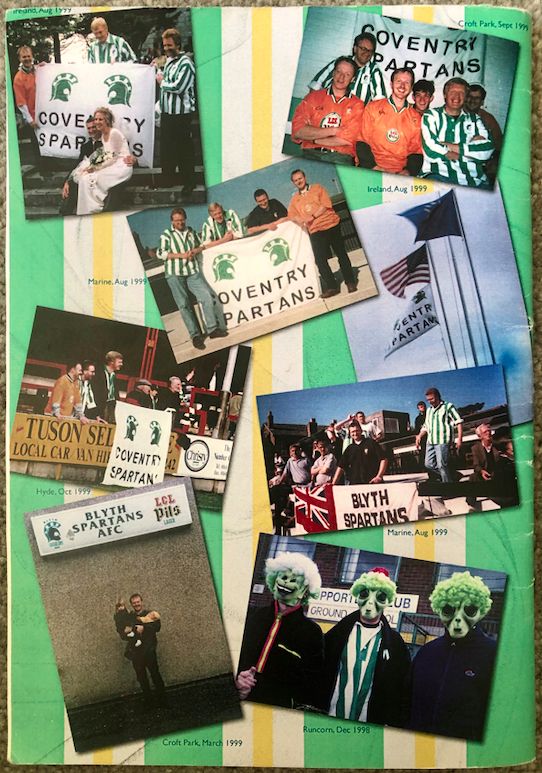
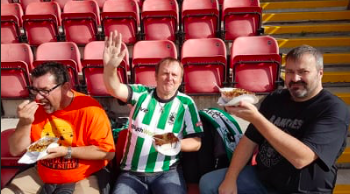 His dedication shown when taking time off work to attend a midweek county cup game because it’s being played at a ground he hasn’t seen the Spartans play at before.
His dedication shown when taking time off work to attend a midweek county cup game because it’s being played at a ground he hasn’t seen the Spartans play at before. In the early years of the Coventry Spartans Mark soon released just how many miles they were clocking up each season so in the build up to the clubs 1999/2000 season he came up with a plan to record their travels.
In the early years of the Coventry Spartans Mark soon released just how many miles they were clocking up each season so in the build up to the clubs 1999/2000 season he came up with a plan to record their travels.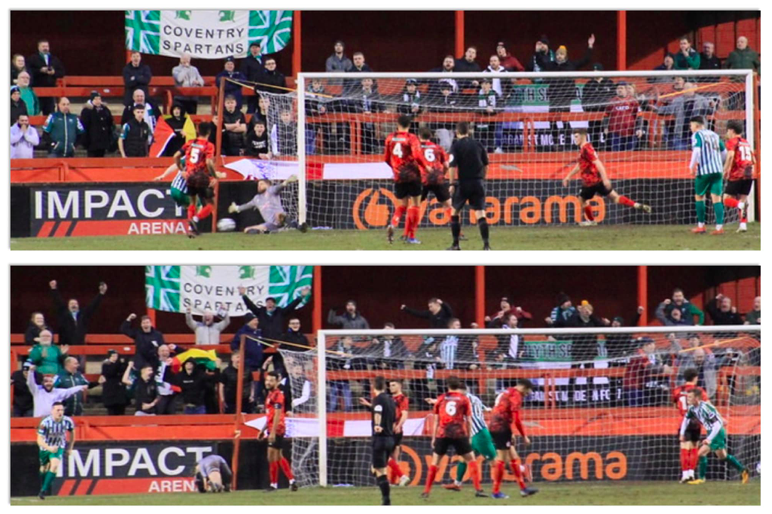 Mark has listed the grounds he’s visited over the years along with his memory of that ground –
Mark has listed the grounds he’s visited over the years along with his memory of that ground –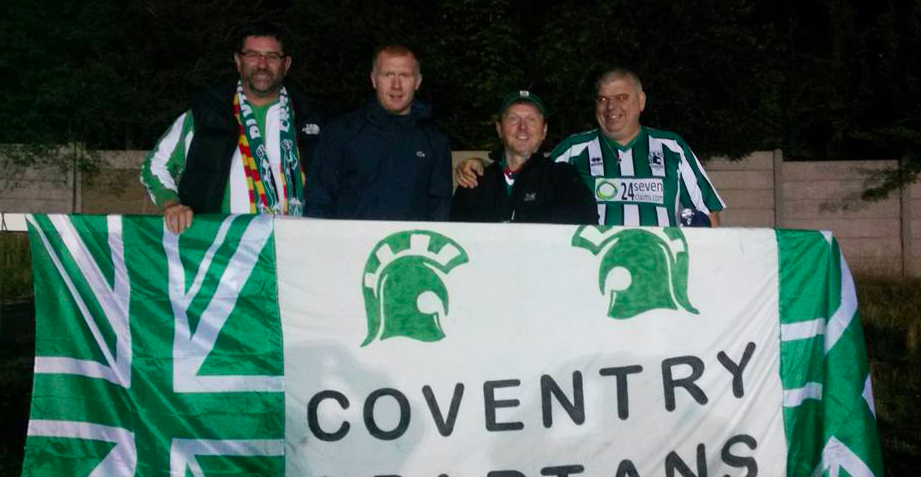
 From humble beginnings in a tiny miners cottage, Clem went onto become the first Blyth born footballer to represent his country.
From humble beginnings in a tiny miners cottage, Clem went onto become the first Blyth born footballer to represent his country.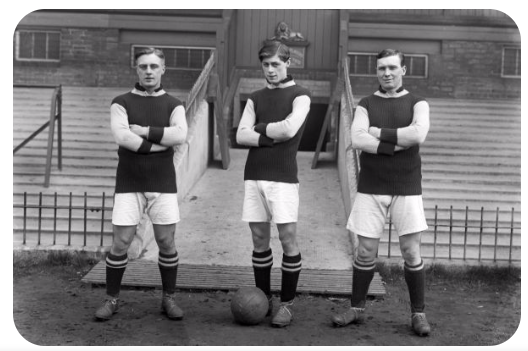 Clem, Jimmy & George are without doubt the most successful footballing family the town has ever produced.
Clem, Jimmy & George are without doubt the most successful footballing family the town has ever produced.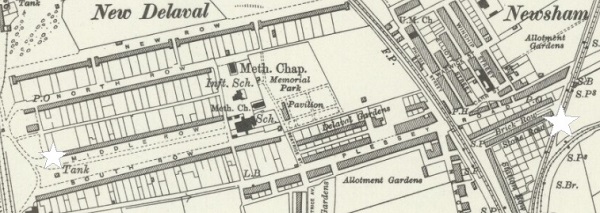
 Clem, pictured making his debut for Blyth at Bedlington United on Saturday 15th December, scored twice in the 3-1 Tynemouth Infirmary Cup Quarter Final win.
Clem, pictured making his debut for Blyth at Bedlington United on Saturday 15th December, scored twice in the 3-1 Tynemouth Infirmary Cup Quarter Final win.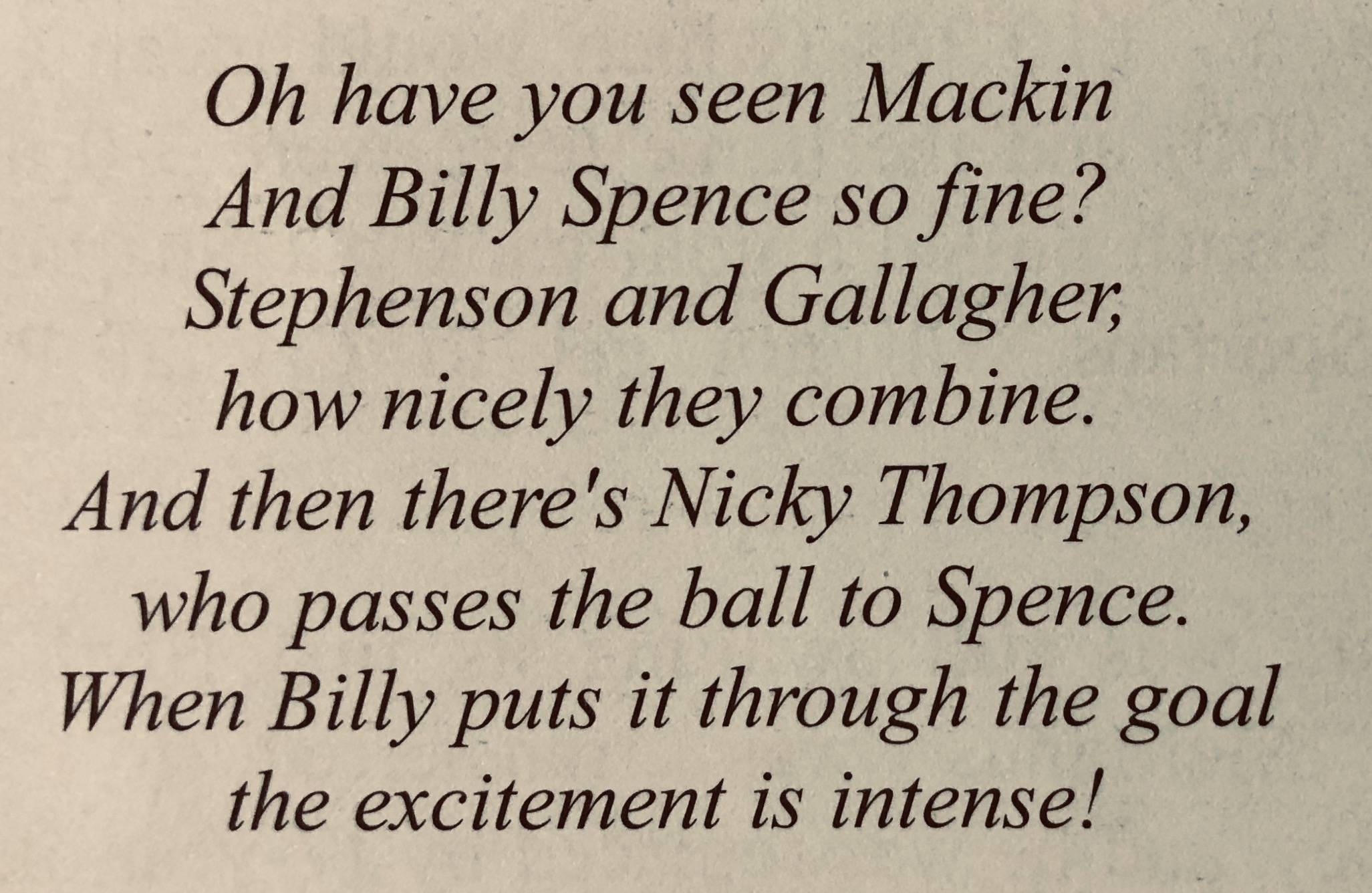
 Having won 2-0, Clem scored the second goal, the players and officials celebrated afterwards in the nearby Coxlodge Hotel pub.
Having won 2-0, Clem scored the second goal, the players and officials celebrated afterwards in the nearby Coxlodge Hotel pub.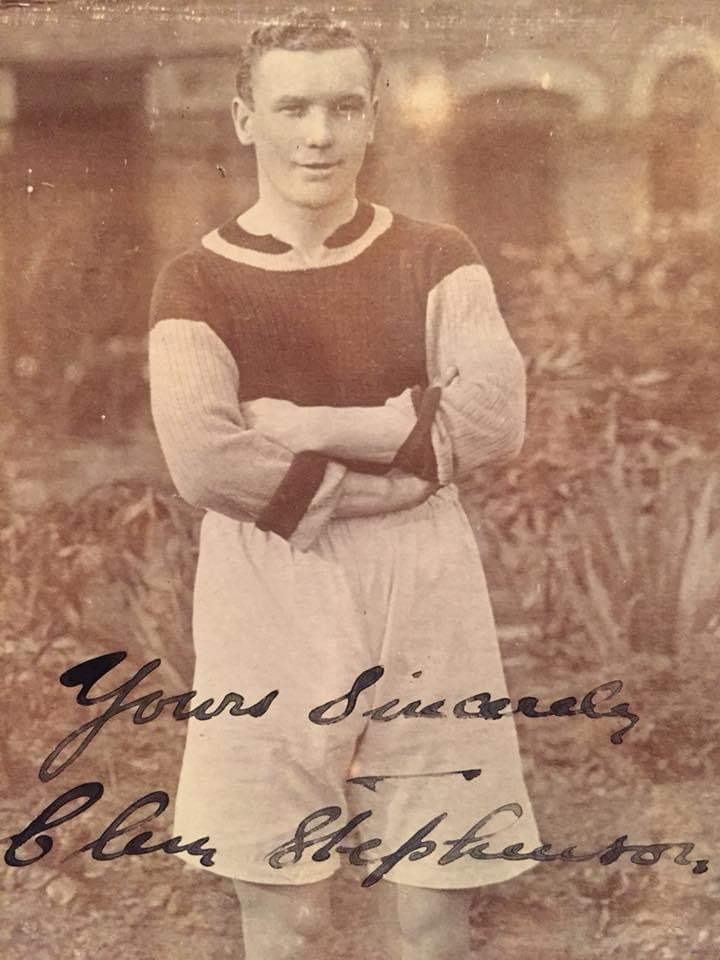 His Villa debut came on 25th February aged 21, he scored the third goal in a 4-0 home win over Tottenham Hotspur.
His Villa debut came on 25th February aged 21, he scored the third goal in a 4-0 home win over Tottenham Hotspur.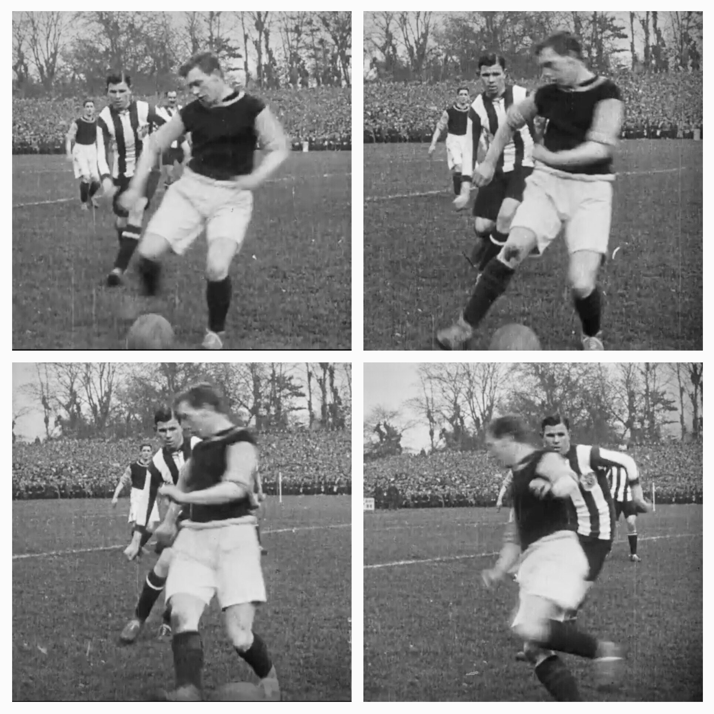
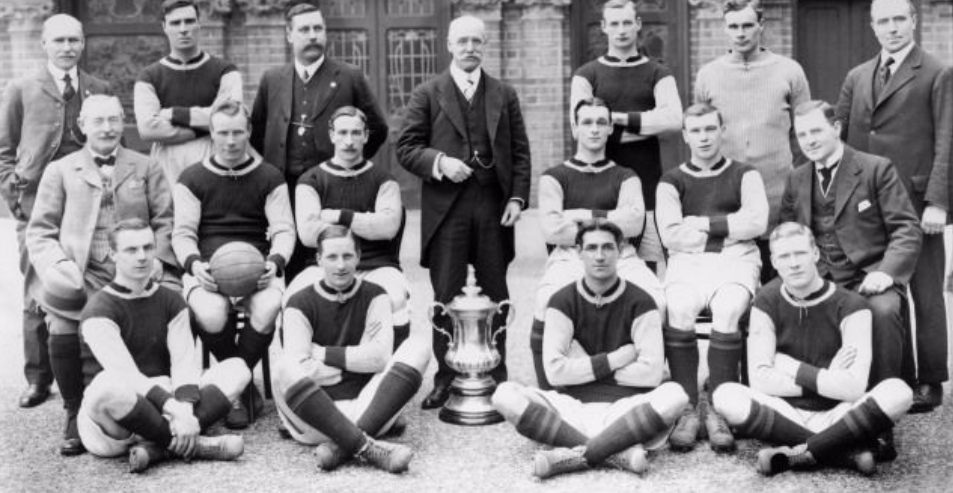 In a bad tempered final, he wound up Sunderland’s Charlie Buchan during the match with his dream claim, and was unceremoniously pushed aside:
In a bad tempered final, he wound up Sunderland’s Charlie Buchan during the match with his dream claim, and was unceremoniously pushed aside:
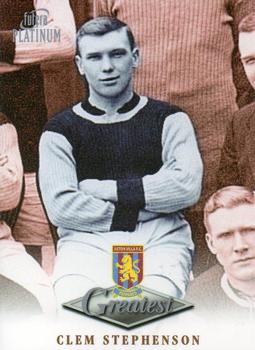 Clem’s contribution to Villa and football in general was recognised by his nomination to the top 100 players in English league history. This accolade is held by only five other Villa players; Sam Hardy, Archie Hunter, Trevor Ford, Danny Blanchflower and Paul McGrath.
Clem’s contribution to Villa and football in general was recognised by his nomination to the top 100 players in English league history. This accolade is held by only five other Villa players; Sam Hardy, Archie Hunter, Trevor Ford, Danny Blanchflower and Paul McGrath. Herbert Chapman, now the Manager of Huddersfield Town, knew the player he wanted telling the board upon being appointed:
Herbert Chapman, now the Manager of Huddersfield Town, knew the player he wanted telling the board upon being appointed: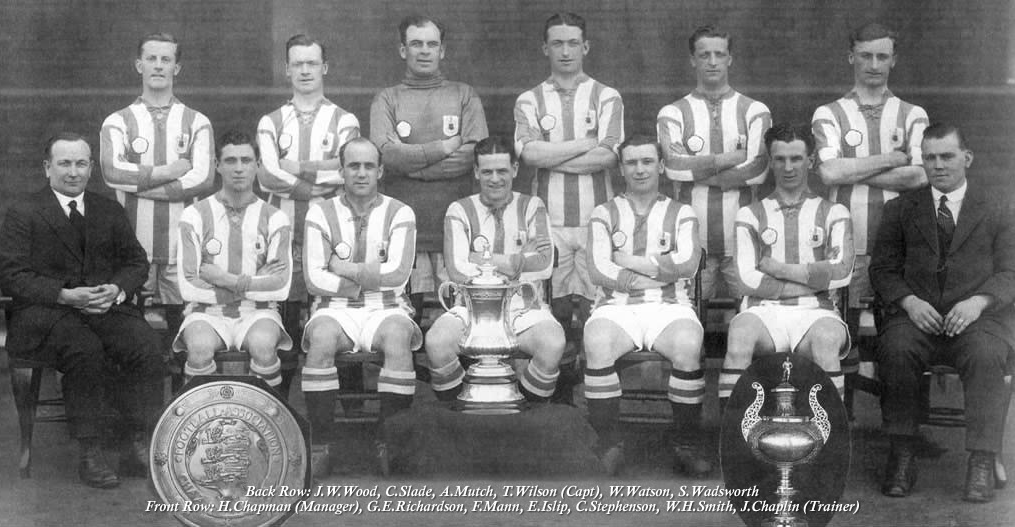

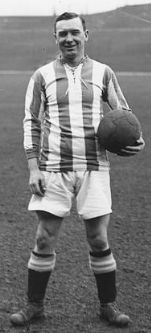
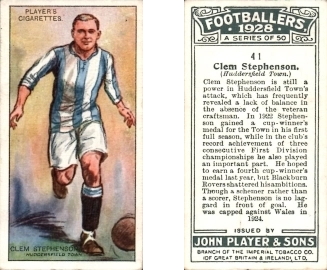
 On the 27th November 1928 he announced his intention to retire at the end of the season.
On the 27th November 1928 he announced his intention to retire at the end of the season. Rightly regarded as a Huddersfield Town legend Clem sadly died on 24th October 1961, aged 71 and he is still honoured to this day by the club.
Rightly regarded as a Huddersfield Town legend Clem sadly died on 24th October 1961, aged 71 and he is still honoured to this day by the club. In 2010 he was inducted into the National Football Museum’s Hall of Fame in honour of his contribution to the game.
In 2010 he was inducted into the National Football Museum’s Hall of Fame in honour of his contribution to the game.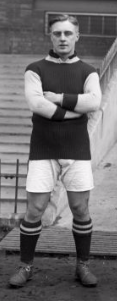 Following in his older brothers footsteps James started with New Delaval Villa, before joining him at First Division Aston Villa in 1914.
Following in his older brothers footsteps James started with New Delaval Villa, before joining him at First Division Aston Villa in 1914. Unsurprisingly he also started playing for junior club New Delaval Villa in 1918 before joining Leeds City in 1919.
Unsurprisingly he also started playing for junior club New Delaval Villa in 1918 before joining Leeds City in 1919.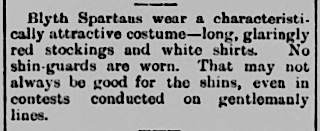 It consisted of white shirts, white shorts and red socks, the reason for that choice is unknown.
It consisted of white shirts, white shorts and red socks, the reason for that choice is unknown.
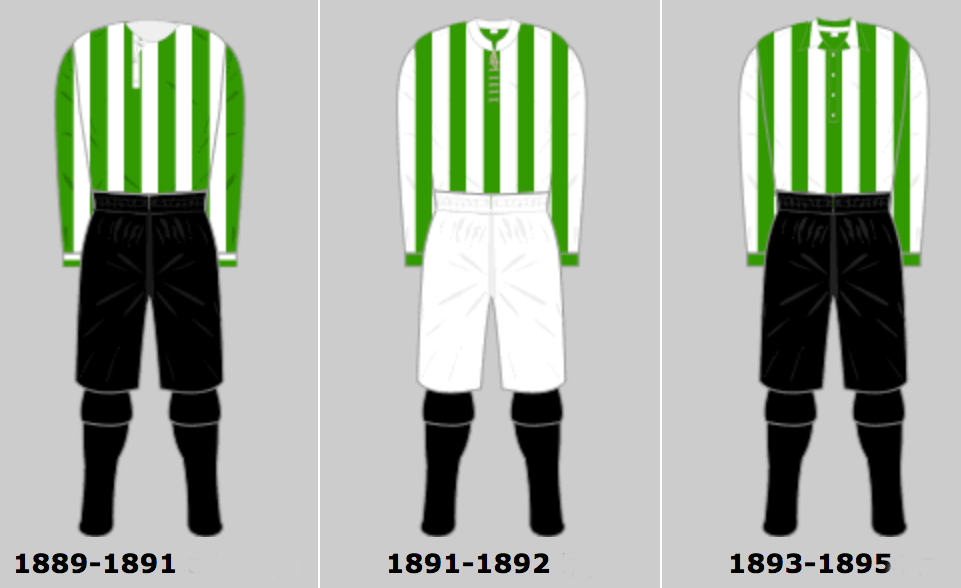 Between 1889 and 1903 Celtic had worn green & white striped tops before adopting their now famous hoops.
Between 1889 and 1903 Celtic had worn green & white striped tops before adopting their now famous hoops.
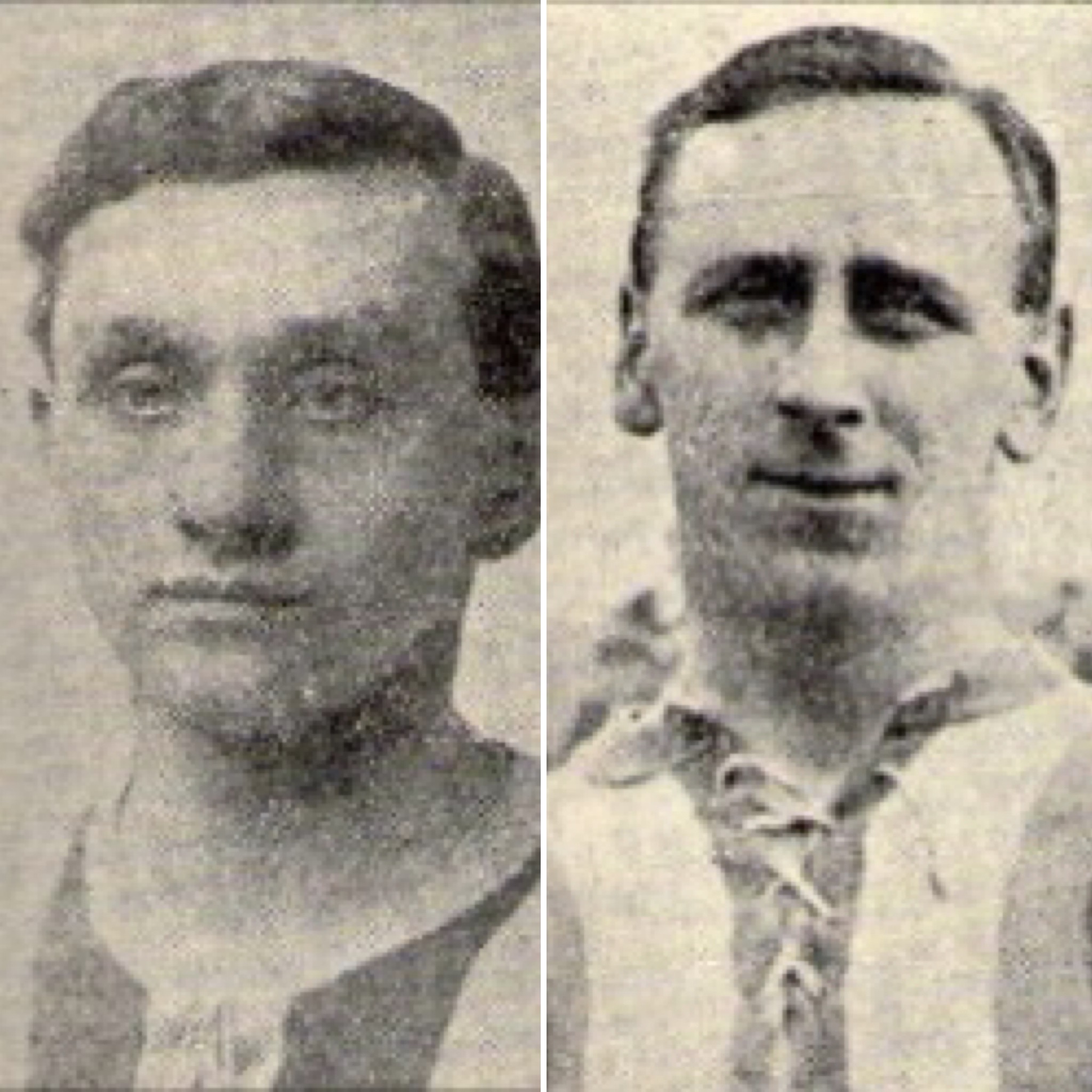 From 1902 to 1925 the club wore many styles of green & white stripes as the fashions of football tops changed with the times. Along with changes to the width and position of the stripes the other main change was to the neck/collar of the shirts, varying from buttons to string tied.
From 1902 to 1925 the club wore many styles of green & white stripes as the fashions of football tops changed with the times. Along with changes to the width and position of the stripes the other main change was to the neck/collar of the shirts, varying from buttons to string tied.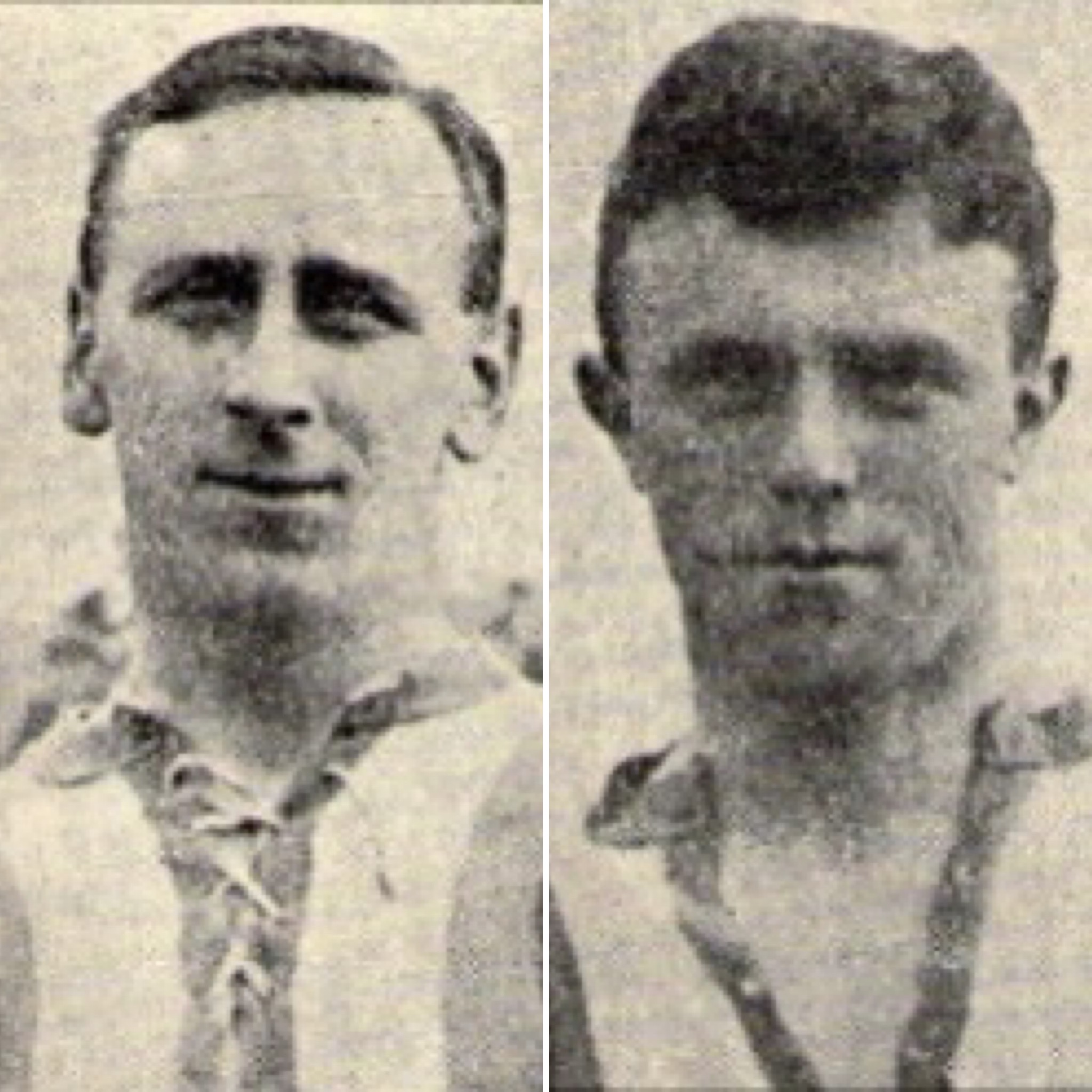
 The first ever action photo of the Spartans taken at the
The first ever action photo of the Spartans taken at the  For the club’s first season after WWII, 1946/47, brand new white & green quartered shirts were worn for the single season in the Northern Alliance.
For the club’s first season after WWII, 1946/47, brand new white & green quartered shirts were worn for the single season in the Northern Alliance.
 That new shirt was the ever first to carry a crest, it wasn’t specifically the clubs own badge
That new shirt was the ever first to carry a crest, it wasn’t specifically the clubs own badge 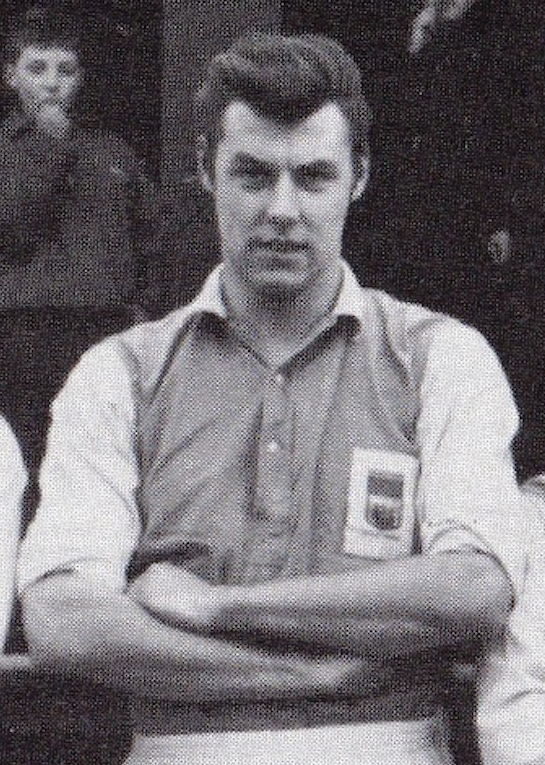 but the towns official crest with the club name underneath.
but the towns official crest with the club name underneath.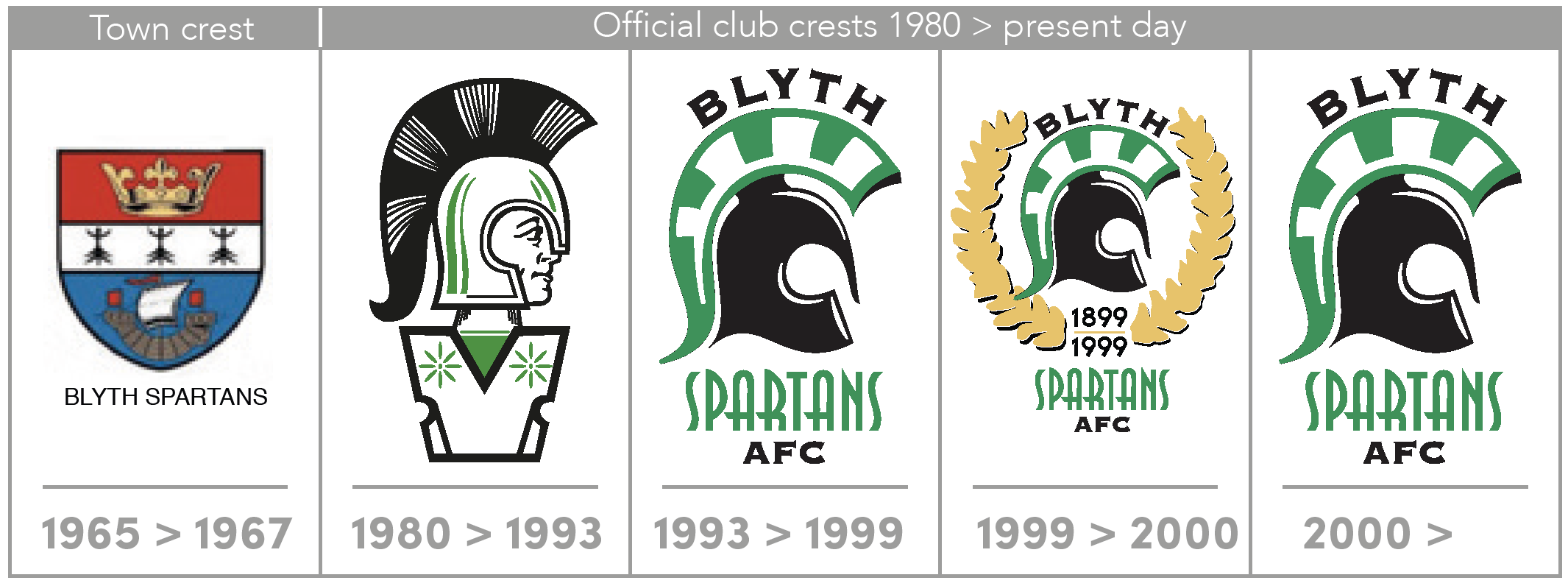 The first came about at the beginning of 1980 when Chairman Jim Turney and newly appointed commercial manager, Mike Turnbull, decided the club needed its own identity.
The first came about at the beginning of 1980 when Chairman Jim Turney and newly appointed commercial manager, Mike Turnbull, decided the club needed its own identity.
 The first ever kit to carry the makers branding came in the 74/75 season, the Umbro kit came about due to a special occasion.
The first ever kit to carry the makers branding came in the 74/75 season, the Umbro kit came about due to a special occasion.

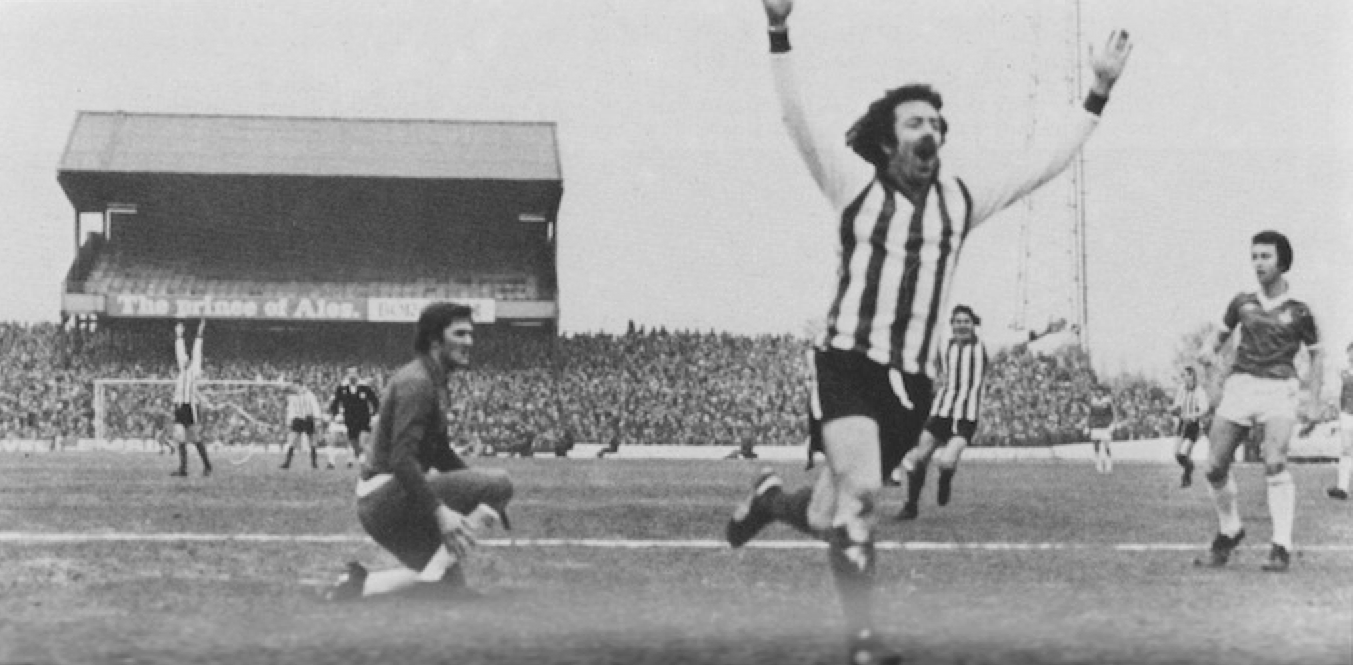 The clubs
The clubs 

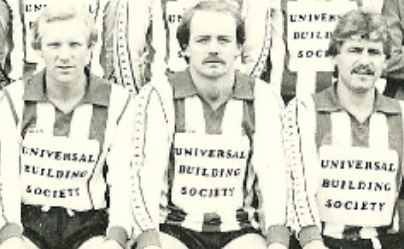
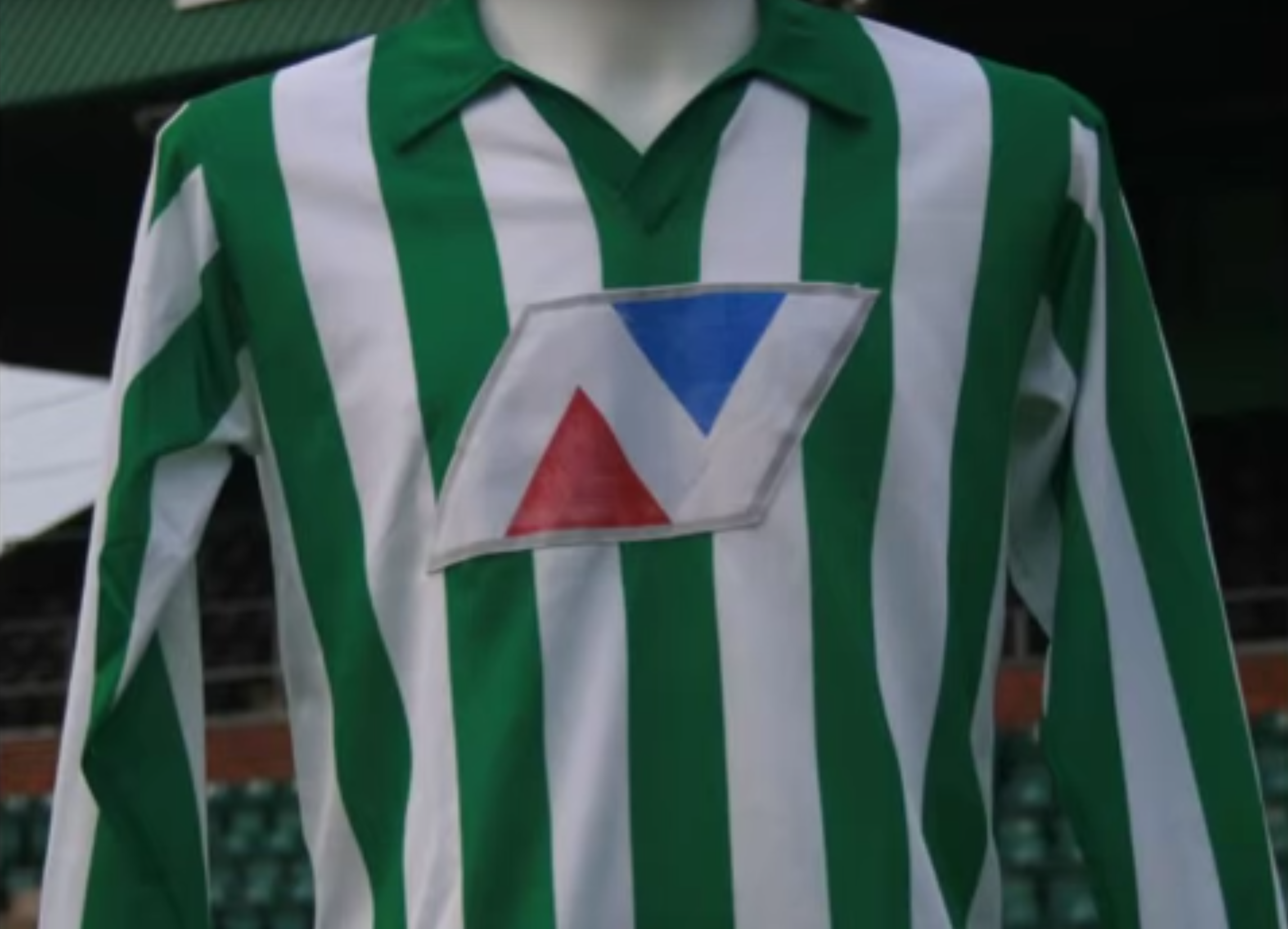 A new sponsorship deal was signed in 1988 with Northumbria Bus Company and their
A new sponsorship deal was signed in 1988 with Northumbria Bus Company and their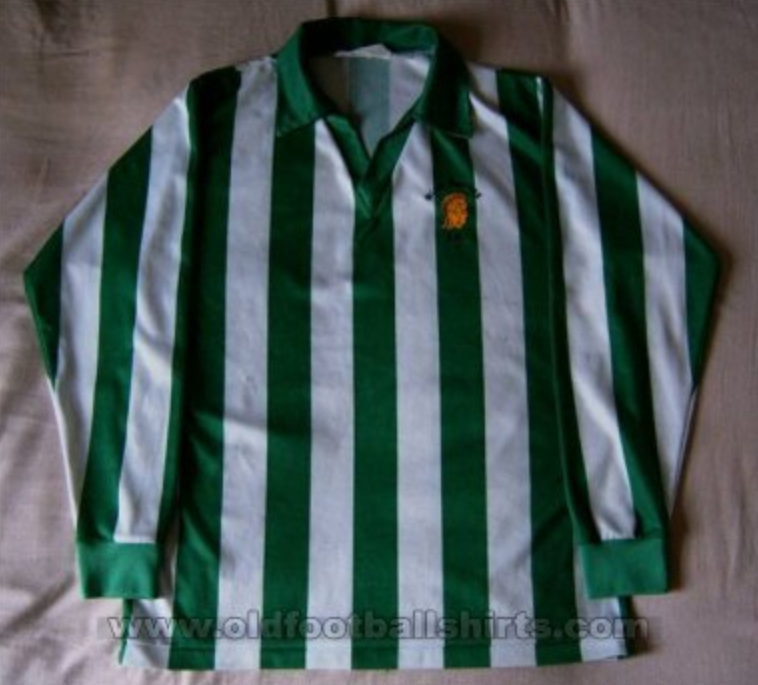
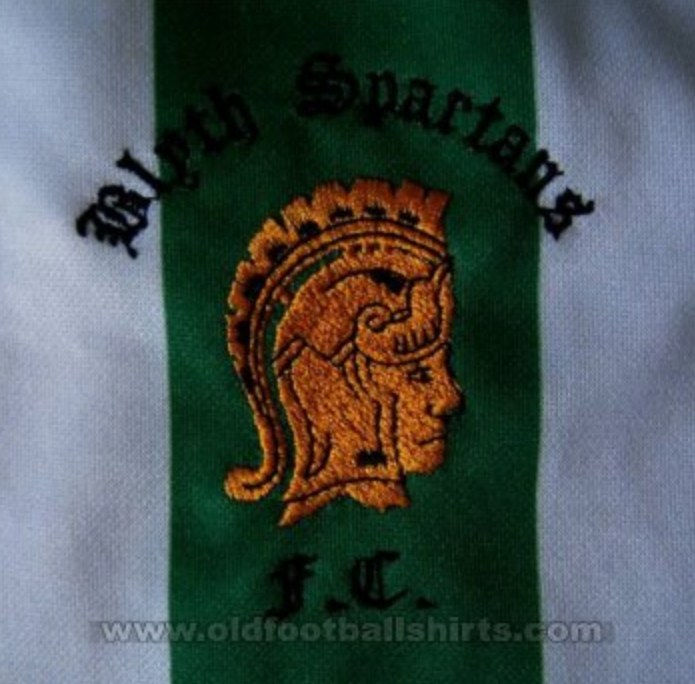
 Contrary to what many believe the VIZ logo first appeared on the clubs kit at the end of the 1991/92 season.
Contrary to what many believe the VIZ logo first appeared on the clubs kit at the end of the 1991/92 season. On Saturday 2nd May 1992 Blyth beat North Shields at St James’ Park in the Northumberland Senior Cup Final wearing the VIZ logo for the first time.
On Saturday 2nd May 1992 Blyth beat North Shields at St James’ Park in the Northumberland Senior Cup Final wearing the VIZ logo for the first time. For the new 92/93 season Activity provided new shirt with a printed black club crest and also supplied a new yellow away kit. Both kits survived for a few years as the club did its usual changing of kits randomly from game to game.
For the new 92/93 season Activity provided new shirt with a printed black club crest and also supplied a new yellow away kit. Both kits survived for a few years as the club did its usual changing of kits randomly from game to game. Activity also supplied shirts specifically for the Supporters Club to sell, they produce the same shirt in black & white and red & white stripes.
Activity also supplied shirts specifically for the Supporters Club to sell, they produce the same shirt in black & white and red & white stripes. County Durham firm Hogger Sports stepped in to help supplying identical shirts. The shirt featured a bigger club badge and had a fleece like backing to the material and only seemed to
County Durham firm Hogger Sports stepped in to help supplying identical shirts. The shirt featured a bigger club badge and had a fleece like backing to the material and only seemed to be worn by the team when it was cold.
be worn by the team when it was cold. Hero Athletic & Sports stated they were: ‘Pioneering a return to a classically styled kits’, however the old fashioned tie string collar design had been already been introduced by Umbro!
Hero Athletic & Sports stated they were: ‘Pioneering a return to a classically styled kits’, however the old fashioned tie string collar design had been already been introduced by Umbro!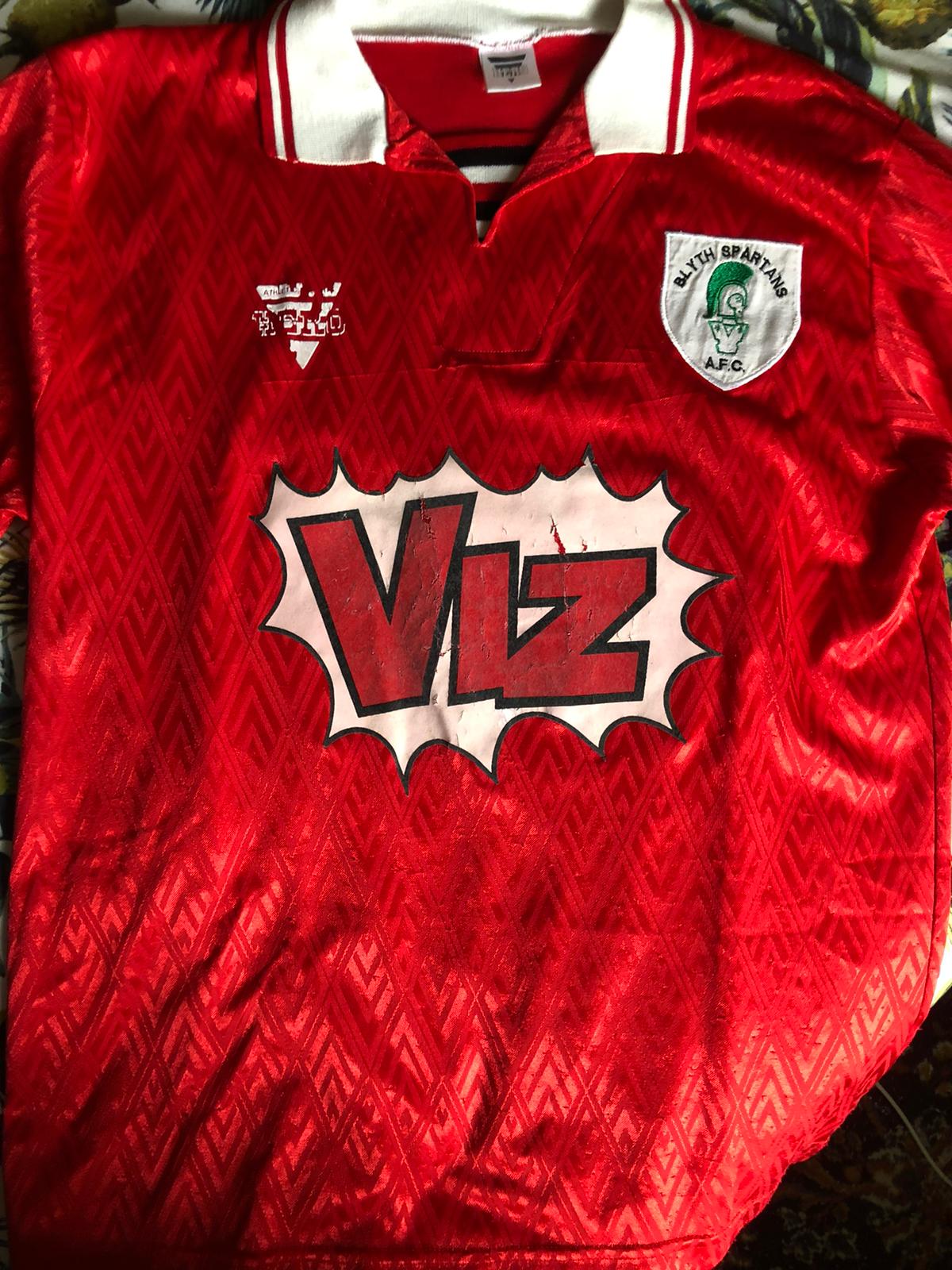 Throughout the 93/94 season the club randomly interchanged the Hero shirts with the long sleeved Hogger tops when the weather suited long sleeves and they also used the Activity shirt on odd occasions.
Throughout the 93/94 season the club randomly interchanged the Hero shirts with the long sleeved Hogger tops when the weather suited long sleeves and they also used the Activity shirt on odd occasions. A new all white away shirts was introduced and was worn for the first time in the 1-1 draw away at Netherfield on 27th August 1994.
A new all white away shirts was introduced and was worn for the first time in the 1-1 draw away at Netherfield on 27th August 1994.
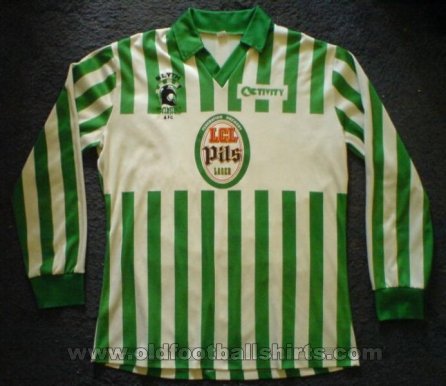
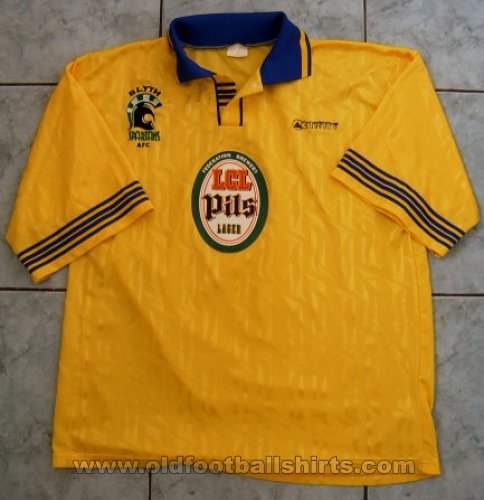 The 94/95 season home shirt saw a slight change with the collar and cuffs now being green but otherwise it was identical.
The 94/95 season home shirt saw a slight change with the collar and cuffs now being green but otherwise it was identical. for the tie at Third Division Bury the club were supplied a special commemorative all red kit by Activity, it carried ‘FA Cup 1995/96’ embroidered under the Acitivty logo.
for the tie at Third Division Bury the club were supplied a special commemorative all red kit by Activity, it carried ‘FA Cup 1995/96’ embroidered under the Acitivty logo. Activity’s UK Managing Director
Activity’s UK Managing Director 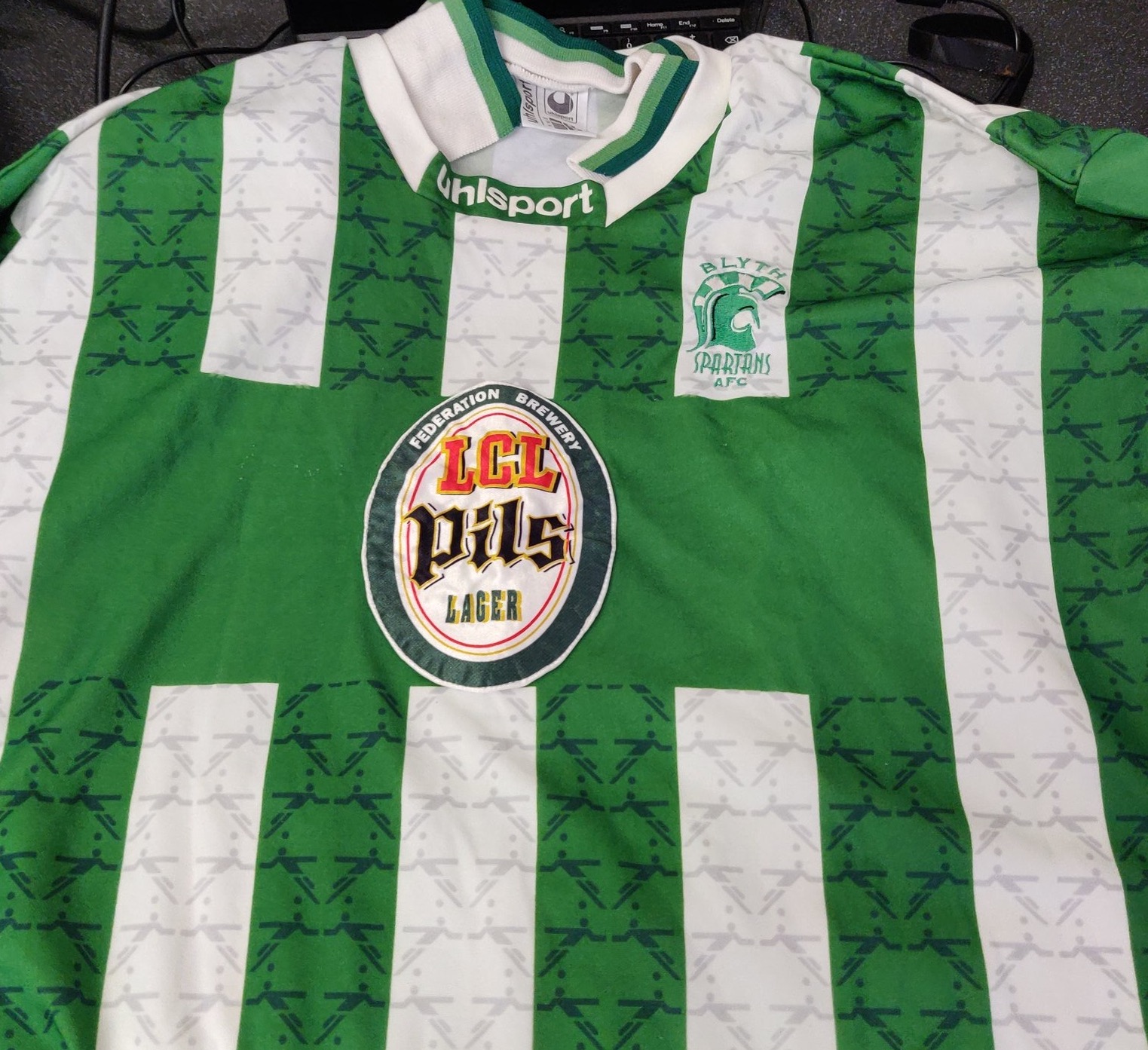


 For the next two seasons the clubs kit was supplied by local firm Logitog, they carried the LCL Pils logo on the front of the home kit but not on the yellow away kit.
For the next two seasons the clubs kit was supplied by local firm Logitog, they carried the LCL Pils logo on the front of the home kit but not on the yellow away kit.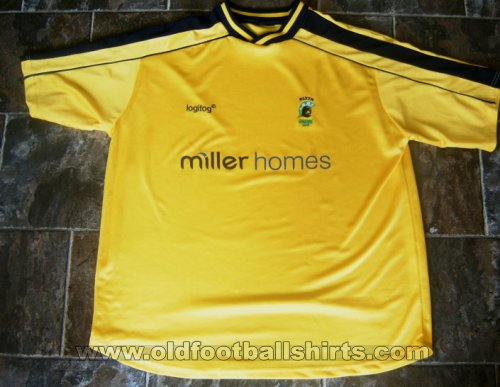 For the first time there was a different away kit sponsor, Miller Homes were building new houses in the town and were approached by club officials about being a shirt sponsor.
For the first time there was a different away kit sponsor, Miller Homes were building new houses in the town and were approached by club officials about being a shirt sponsor.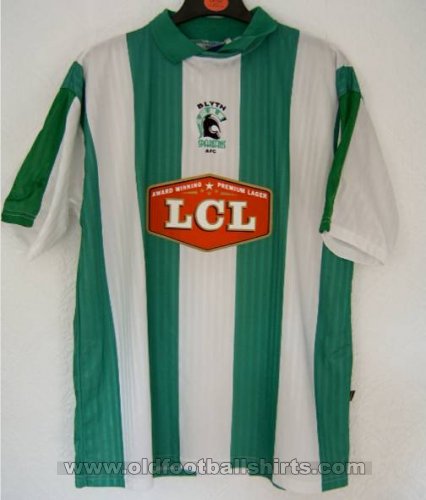 In 2002/03 & 03/04 the club used kit supplied by Moette Sportswear and it carried the new rebranded LCL logo. There were also occasions a long sleeve top were worn that no sponsors on them!
In 2002/03 & 03/04 the club used kit supplied by Moette Sportswear and it carried the new rebranded LCL logo. There were also occasions a long sleeve top were worn that no sponsors on them!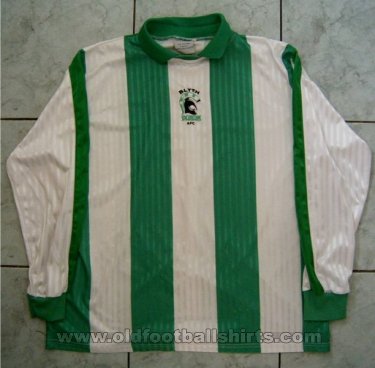

 2004/05 saw a return to Nike kits but this time it was purely down to them having a green & white striped kit in their generic kit catalogue. There was also a new yellow Nike away kit that featuring blue collar and blue arms.
2004/05 saw a return to Nike kits but this time it was purely down to them having a green & white striped kit in their generic kit catalogue. There was also a new yellow Nike away kit that featuring blue collar and blue arms.

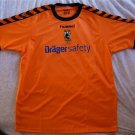

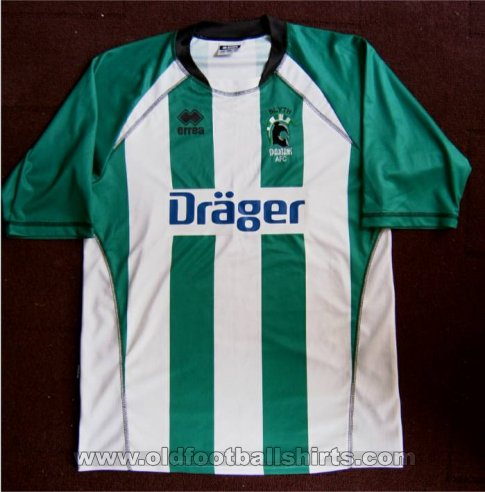 In 2008/09 the club started to use Errea kit, the Italian companies kits were supplied by a local sportswear firm.
In 2008/09 the club started to use Errea kit, the Italian companies kits were supplied by a local sportswear firm.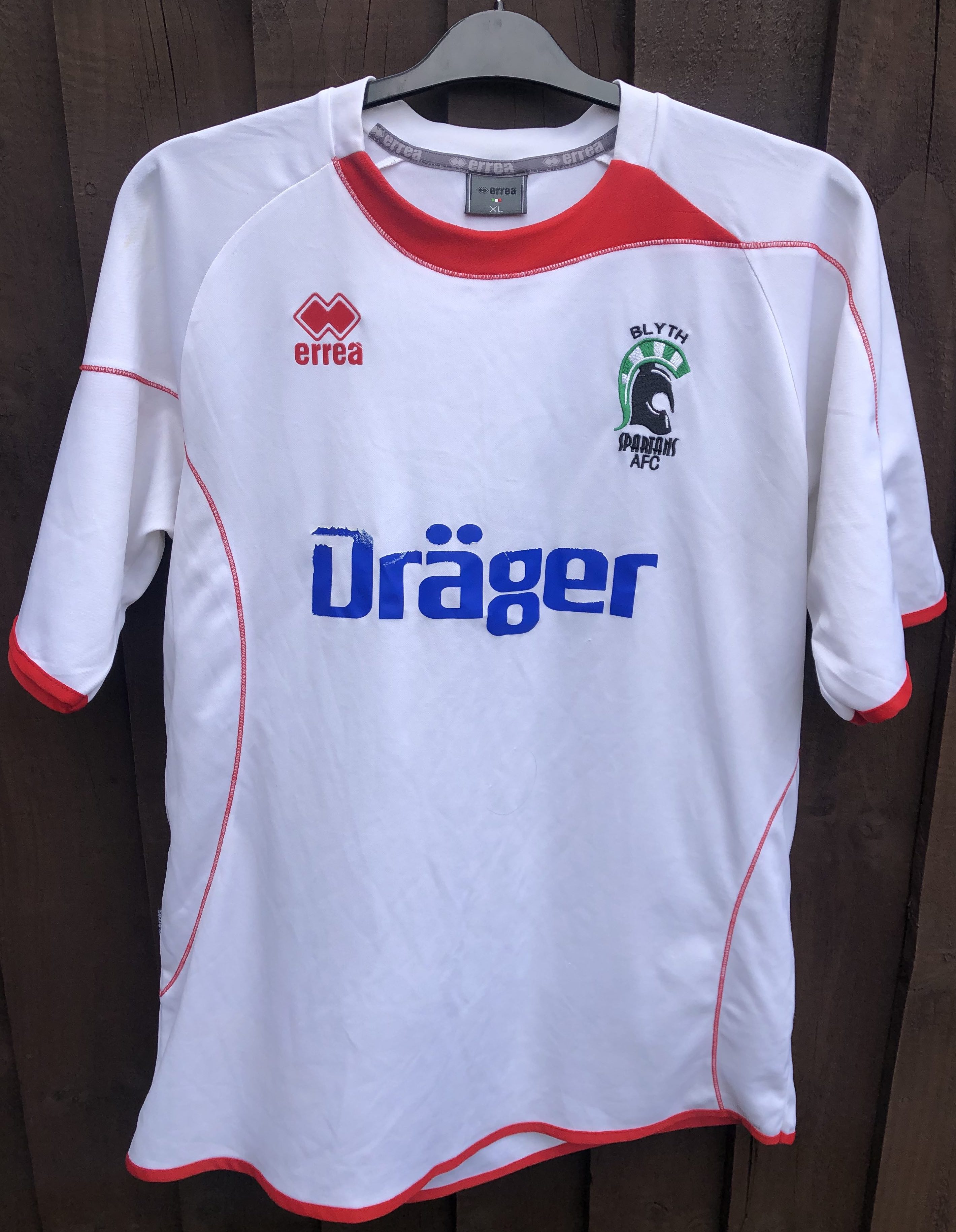 2010 saw the first ever acknowledgment to the club’s past with a new white away kit. Despite having had two white away shirts in recent years it was announced that the white shirt, white shorts and red socks kit was specifically based on the clubs first ever colours.
2010 saw the first ever acknowledgment to the club’s past with a new white away kit. Despite having had two white away shirts in recent years it was announced that the white shirt, white shorts and red socks kit was specifically based on the clubs first ever colours. 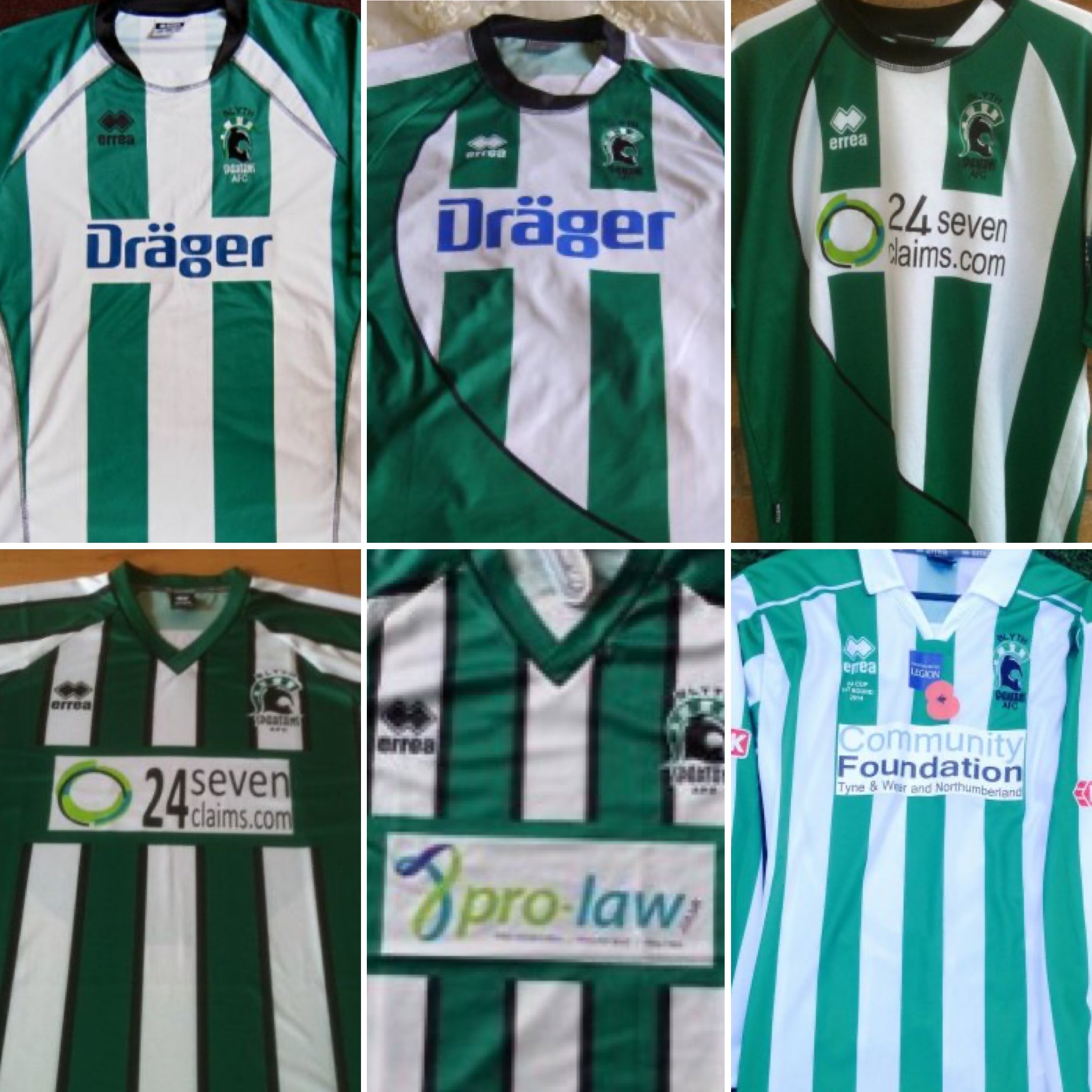

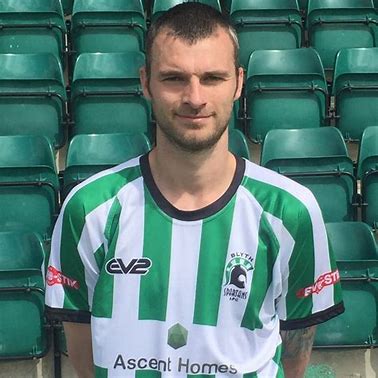
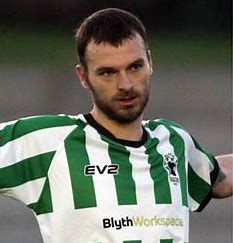 2015/16 season saw the club use Yorkshire based sportswear company EV2.
2015/16 season saw the club use Yorkshire based sportswear company EV2.  Prior to 2017/18 the club announced it had returned to their former kit and merchandise partners Errea and S08 Sportswear. While the home kit would change every season the Supporters Club stated it aimed to keep the same away kit for two seasons.
Prior to 2017/18 the club announced it had returned to their former kit and merchandise partners Errea and S08 Sportswear. While the home kit would change every season the Supporters Club stated it aimed to keep the same away kit for two seasons.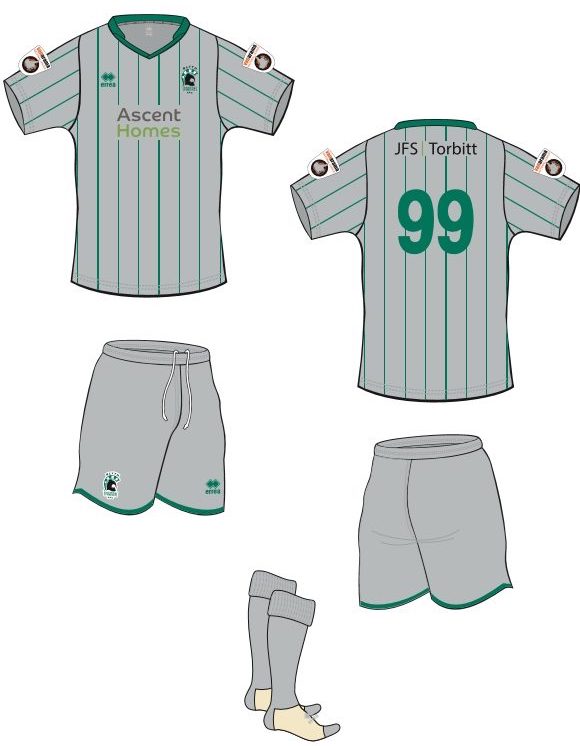
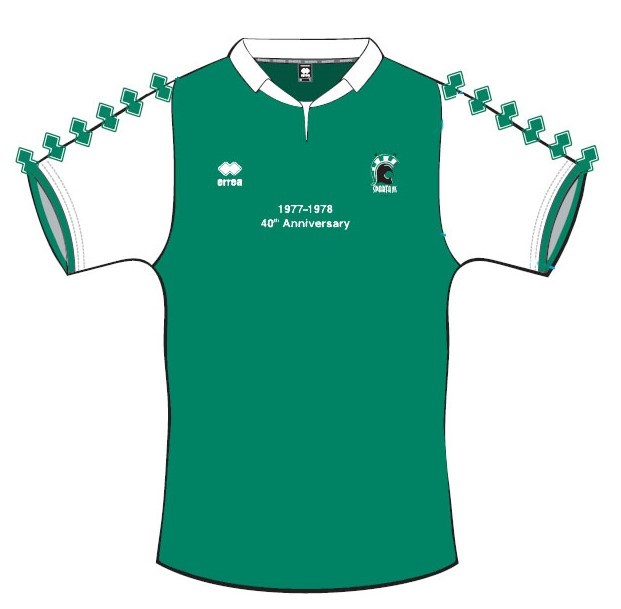 In December 2017 it was announced that as part of a series of events marking that
In December 2017 it was announced that as part of a series of events marking that  In keeping with recent designs the new bespoke home shirt for 2018/19 was also a nod to the clubs past.
In keeping with recent designs the new bespoke home shirt for 2018/19 was also a nod to the clubs past. 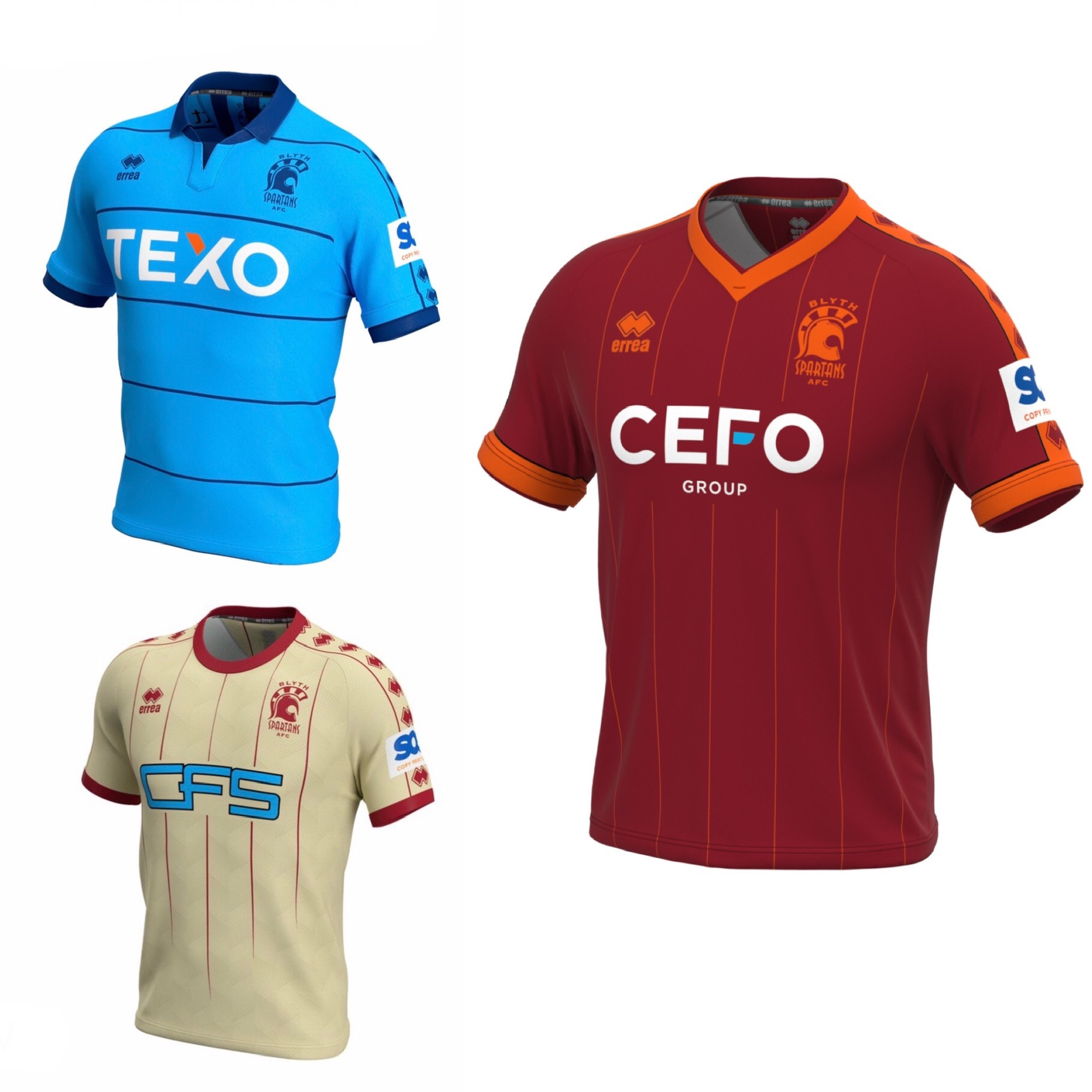
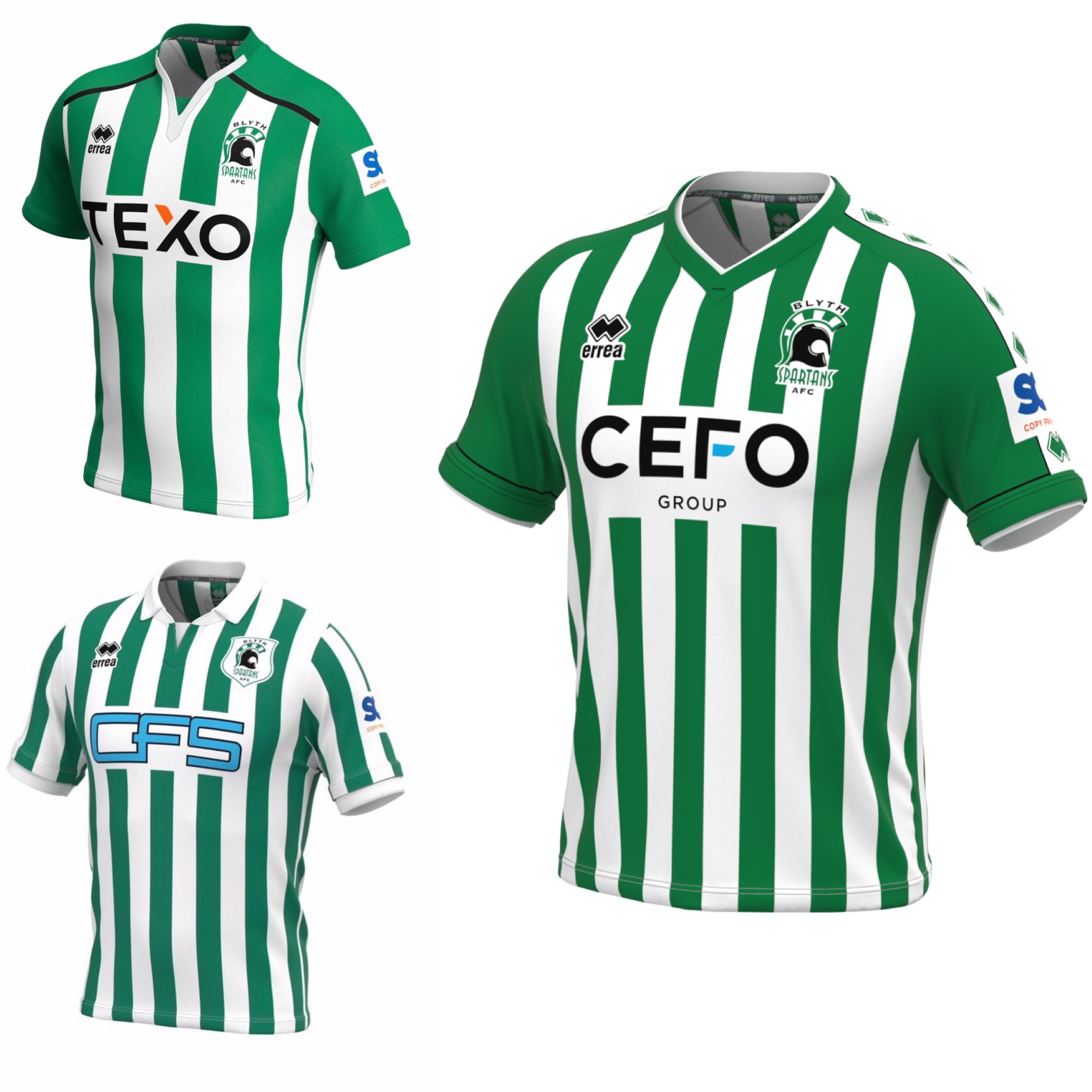

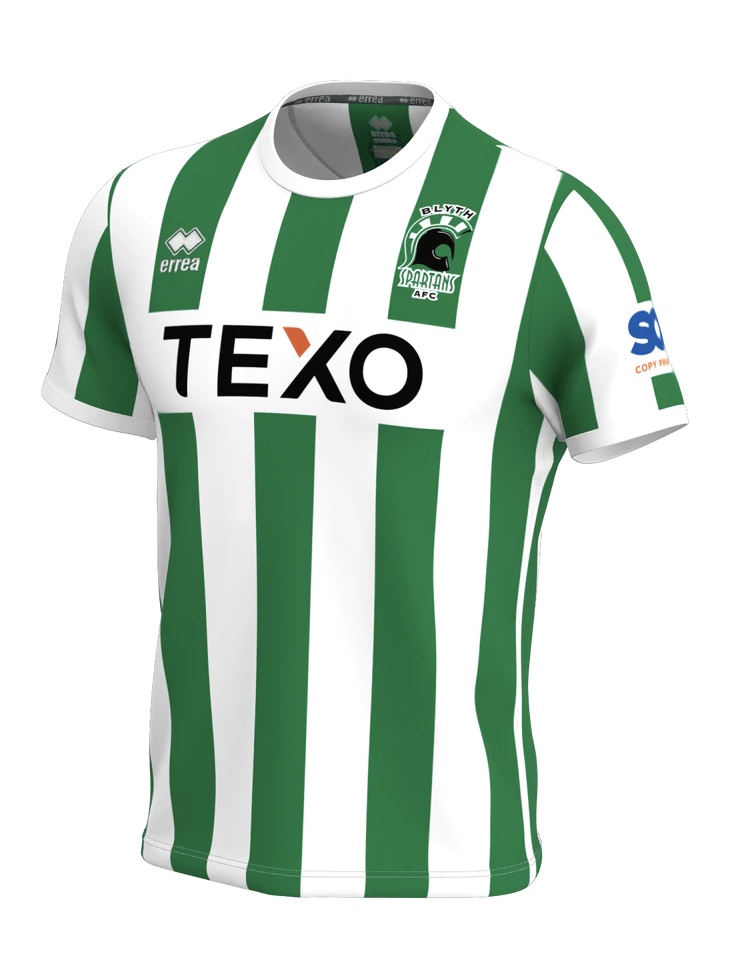 In May 2022 the club announced it had signed a 3 year deal sponsorship deal with TEXO and they would to return as shirt sponsor.
In May 2022 the club announced it had signed a 3 year deal sponsorship deal with TEXO and they would to return as shirt sponsor. 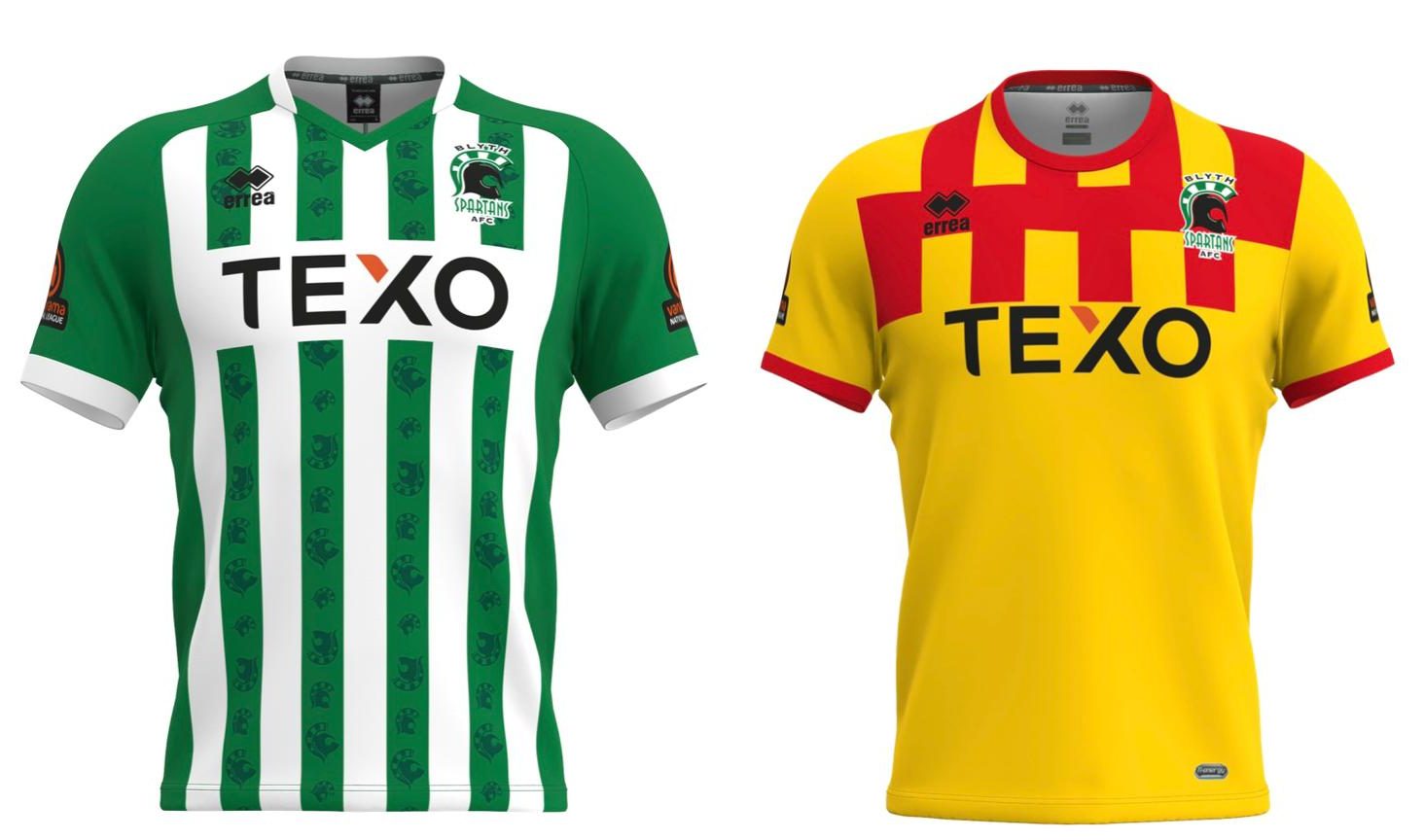
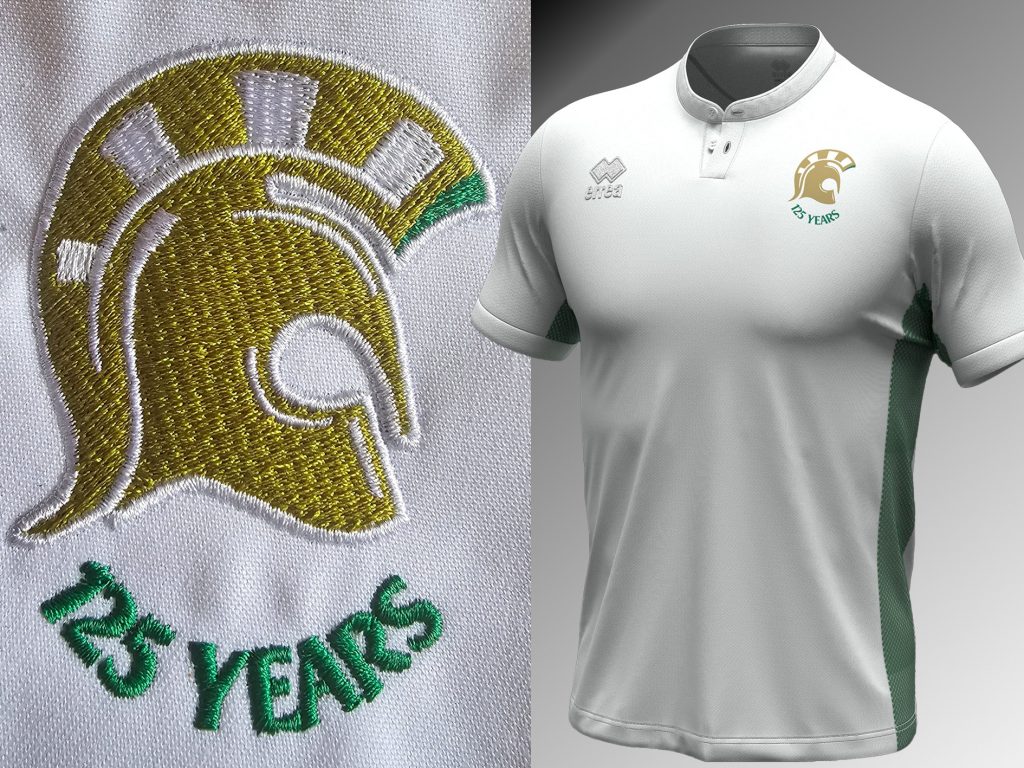 .
. 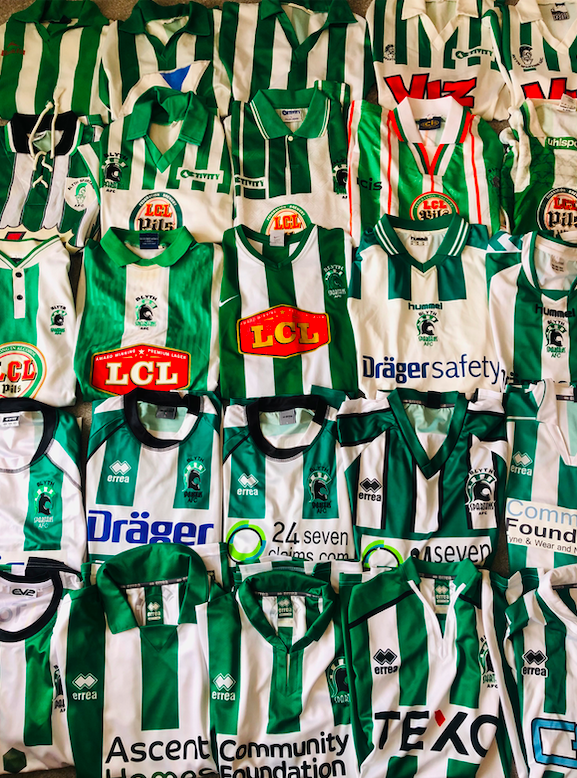 List
List Albert Lawrence Juliussen was born Friday 20th February 1920 to Norwegian parents, his father was a sailor who had settled in Blyth.
Albert Lawrence Juliussen was born Friday 20th February 1920 to Norwegian parents, his father was a sailor who had settled in Blyth. With the family living in Ninth Avenue he attended
With the family living in Ninth Avenue he attended
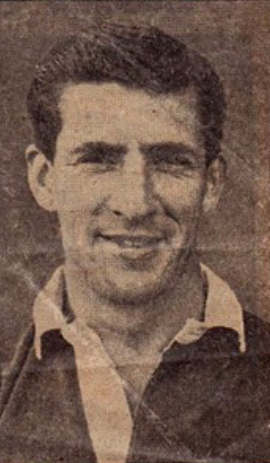 In 1941 as the war intensified he joined the Duke of Wellington Regiments and was enlisted and stationed in Dundee and Perth with the Black Watch as a PT instructor, it was during his time in Scotland that he really made a name for himself.
In 1941 as the war intensified he joined the Duke of Wellington Regiments and was enlisted and stationed in Dundee and Perth with the Black Watch as a PT instructor, it was during his time in Scotland that he really made a name for himself.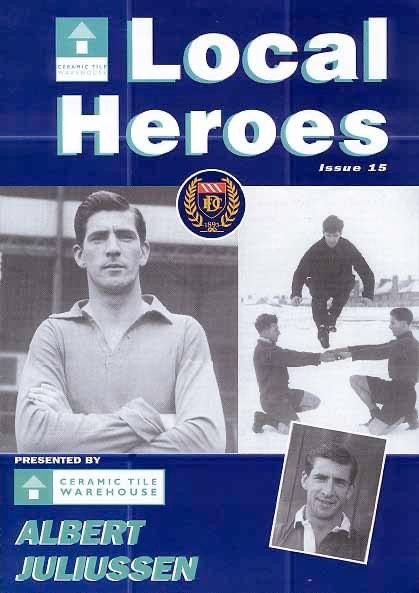 They had been relegated to the second tier on the eve of the Second World War but the first full season back upon the cessation of hostilities was considered by the Scottish League to be unofficial as clubs were given a year’s grace to ‘put their house in order’.
They had been relegated to the second tier on the eve of the Second World War but the first full season back upon the cessation of hostilities was considered by the Scottish League to be unofficial as clubs were given a year’s grace to ‘put their house in order’. Towards the end of the season he had indicated to manager George Anderson that he wished to return back south and just after scoring in his last game against Falkirk in March, he signed for Portsmouth for a fee of £10,000.
Towards the end of the season he had indicated to manager George Anderson that he wished to return back south and just after scoring in his last game against Falkirk in March, he signed for Portsmouth for a fee of £10,000.  1947 they were married. Such was his star status in the town news of their marriage ceremony taking place drew a crowd of 300 fans to greet them as they left registrars office in City Square.
1947 they were married. Such was his star status in the town news of their marriage ceremony taking place drew a crowd of 300 fans to greet them as they left registrars office in City Square. 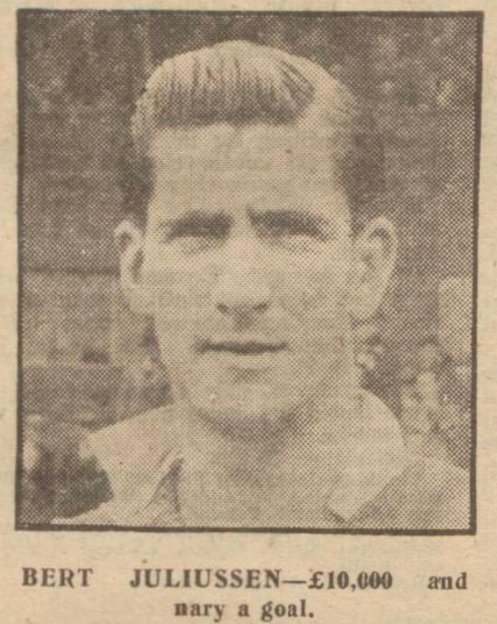 In September 1948 New Toffee’s boss, Cliff Britton having been impressed when he encountered him against his former club Burnley, decided to pay a then club record for ‘Bert‘.
In September 1948 New Toffee’s boss, Cliff Britton having been impressed when he encountered him against his former club Burnley, decided to pay a then club record for ‘Bert‘. Blyth Spartans stepped in straight away making him an offer to join them for the 49/50 North Eastern League campaign. It was the best offer the club had ever made to a player and despite being confident of bringing
Blyth Spartans stepped in straight away making him an offer to join them for the 49/50 North Eastern League campaign. It was the best offer the club had ever made to a player and despite being confident of bringing 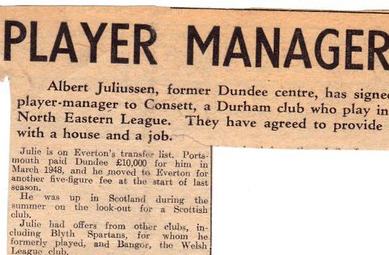
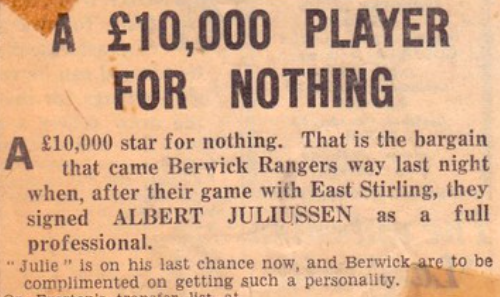 In August 1951 he got back into the professional game when Berwick Rangers struck a deal with Everton who still had him on their transfer list valued at £10,000.
In August 1951 he got back into the professional game when Berwick Rangers struck a deal with Everton who still had him on their transfer list valued at £10,000.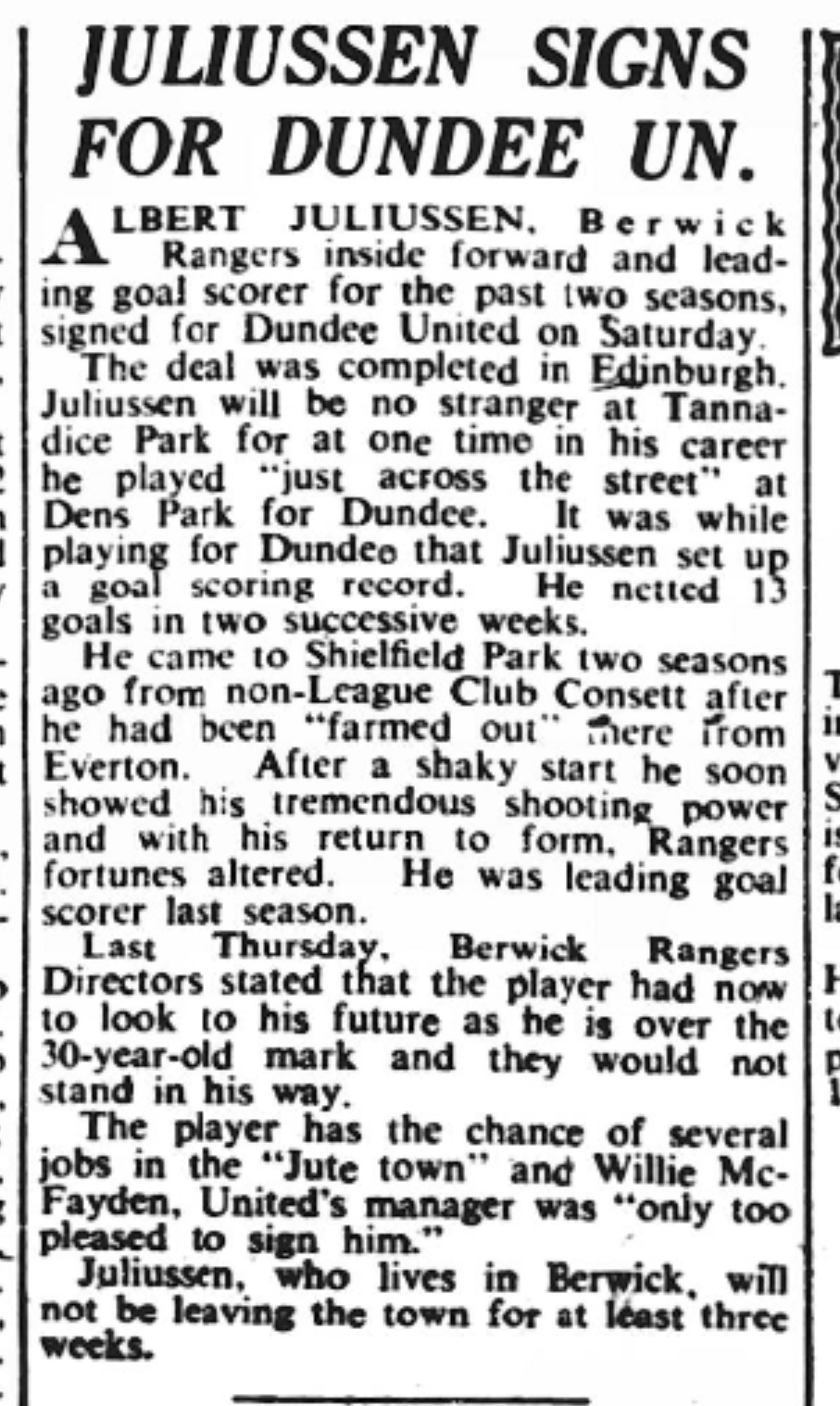 In June 1953 it was announced that he had signed for Dundee United. He left Berwick having been a huge success in his two years, he
In June 1953 it was announced that he had signed for Dundee United. He left Berwick having been a huge success in his two years, he  Sadly he passed away on 6th April 1982 aged only 62.
Sadly he passed away on 6th April 1982 aged only 62. Born Monday 27th April 1970.
Born Monday 27th April 1970.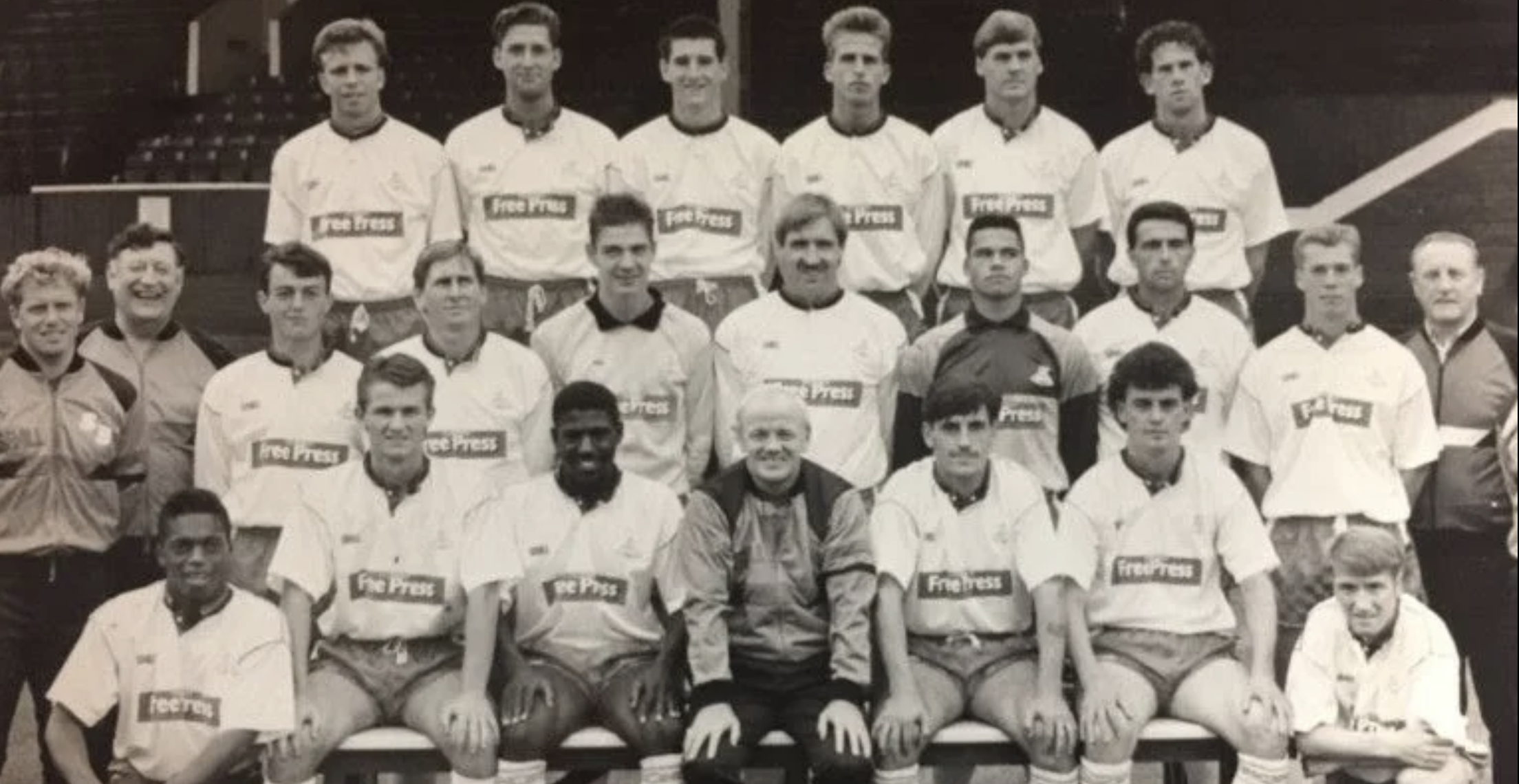

 In 93/94 season under the new management of Peter Feenan he played in 45 of the 49 games in the club’s final season in the Northern League.
In 93/94 season under the new management of Peter Feenan he played in 45 of the 49 games in the club’s final season in the Northern League.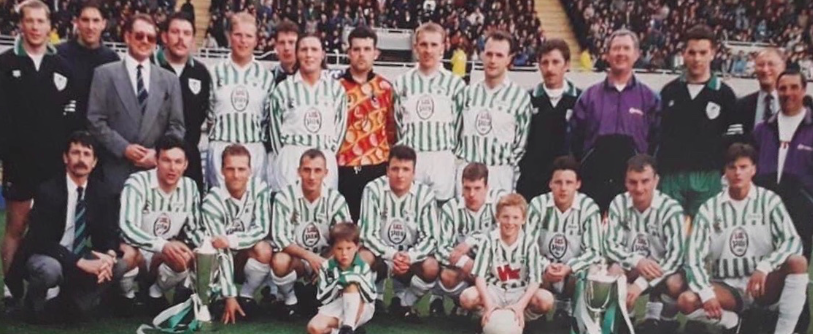
 On 15th November 2000 Stephen took up his other great sporting love, rugby.
On 15th November 2000 Stephen took up his other great sporting love, rugby.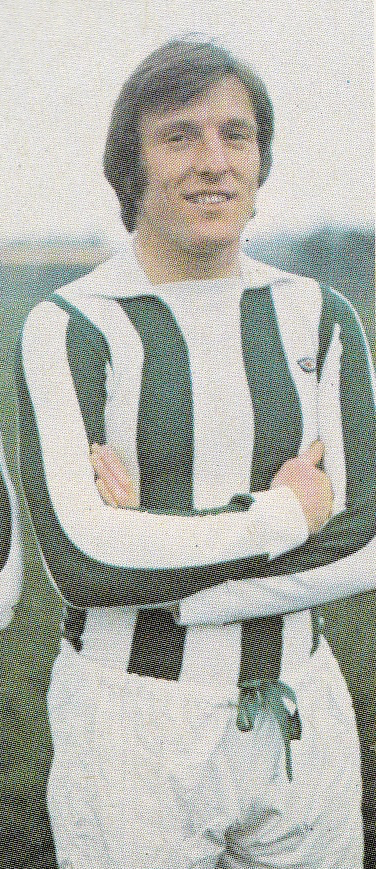
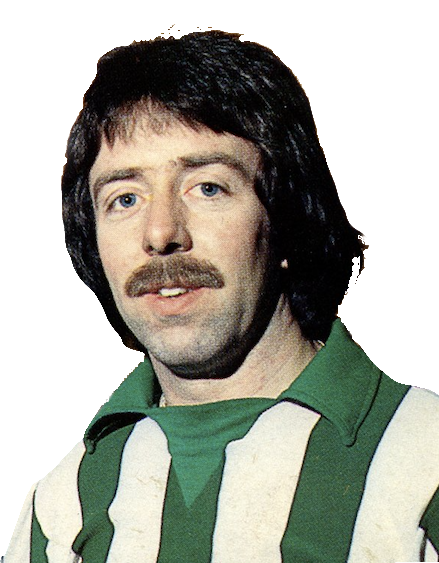 Certain names are synonymous with specific events in the history of this great club.
Certain names are synonymous with specific events in the history of this great club.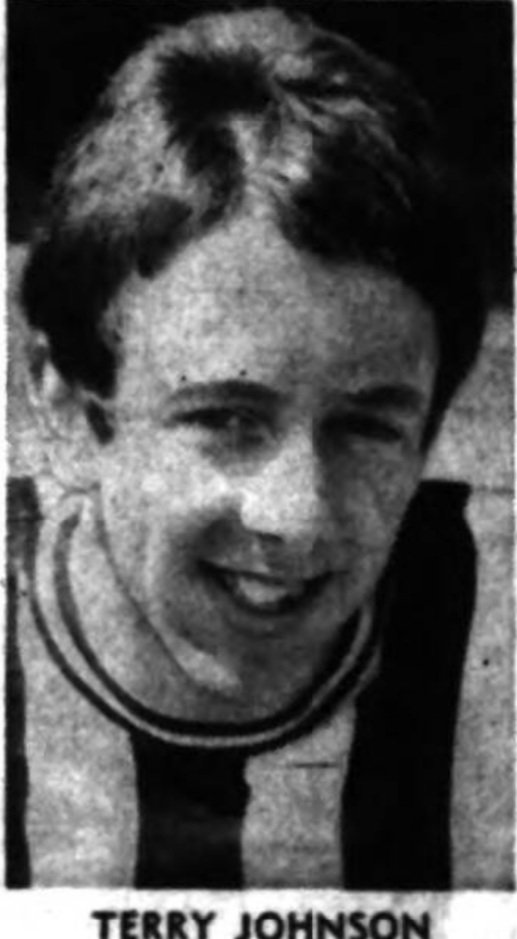 Born 30th August 1949 in Benton, Newcastle Terry had started playing for his school team and then South East Northumberland Boys when he was spotted by United.
Born 30th August 1949 in Benton, Newcastle Terry had started playing for his school team and then South East Northumberland Boys when he was spotted by United. He had been training with the first team since the start of the 68/69 season.
He had been training with the first team since the start of the 68/69 season.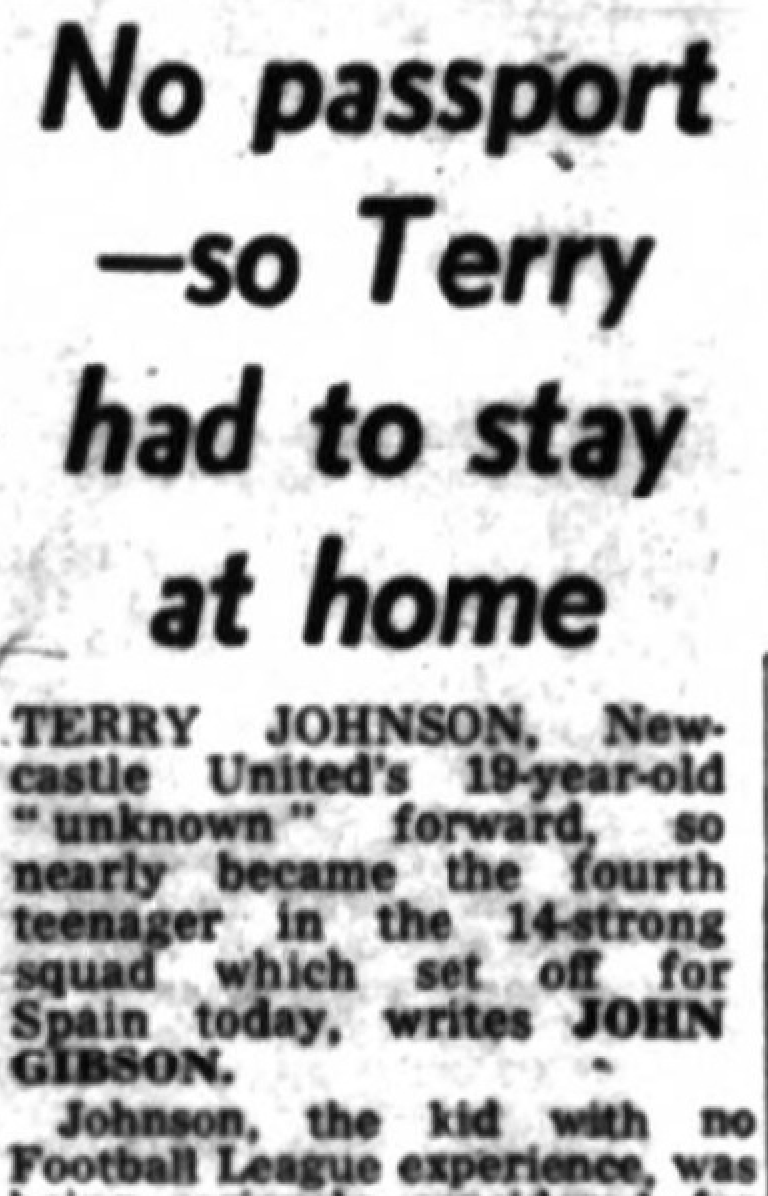 Being picked ahead of £75,000 summer signing Jackie Sinclair for the 1st Leg tie at Real Zaragoza was his big opportunity.
Being picked ahead of £75,000 summer signing Jackie Sinclair for the 1st Leg tie at Real Zaragoza was his big opportunity.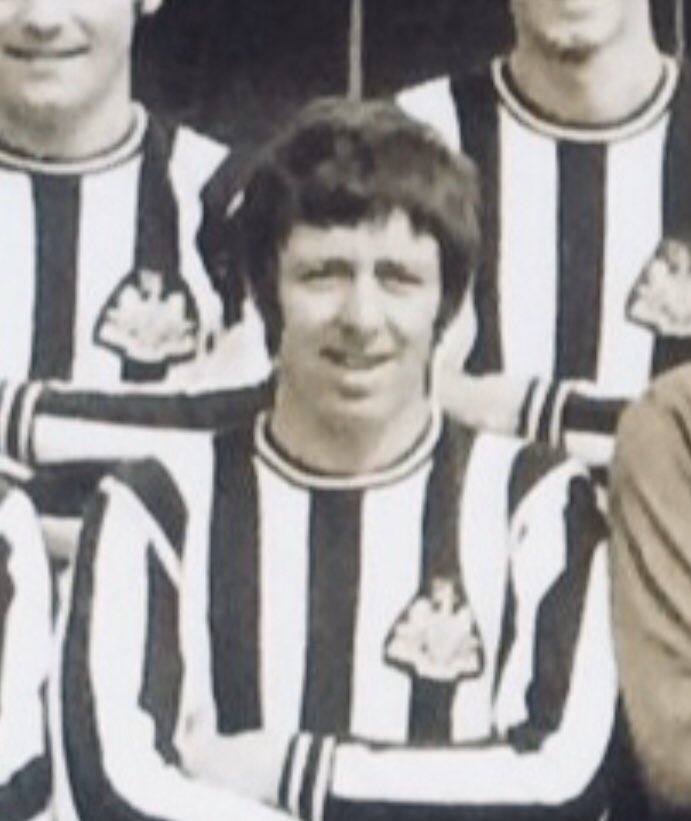
 A month on and Joe Harvey felt Terry needed the experience he would gain from a loan playing in the Football League.
A month on and Joe Harvey felt Terry needed the experience he would gain from a loan playing in the Football League. 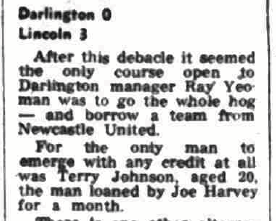
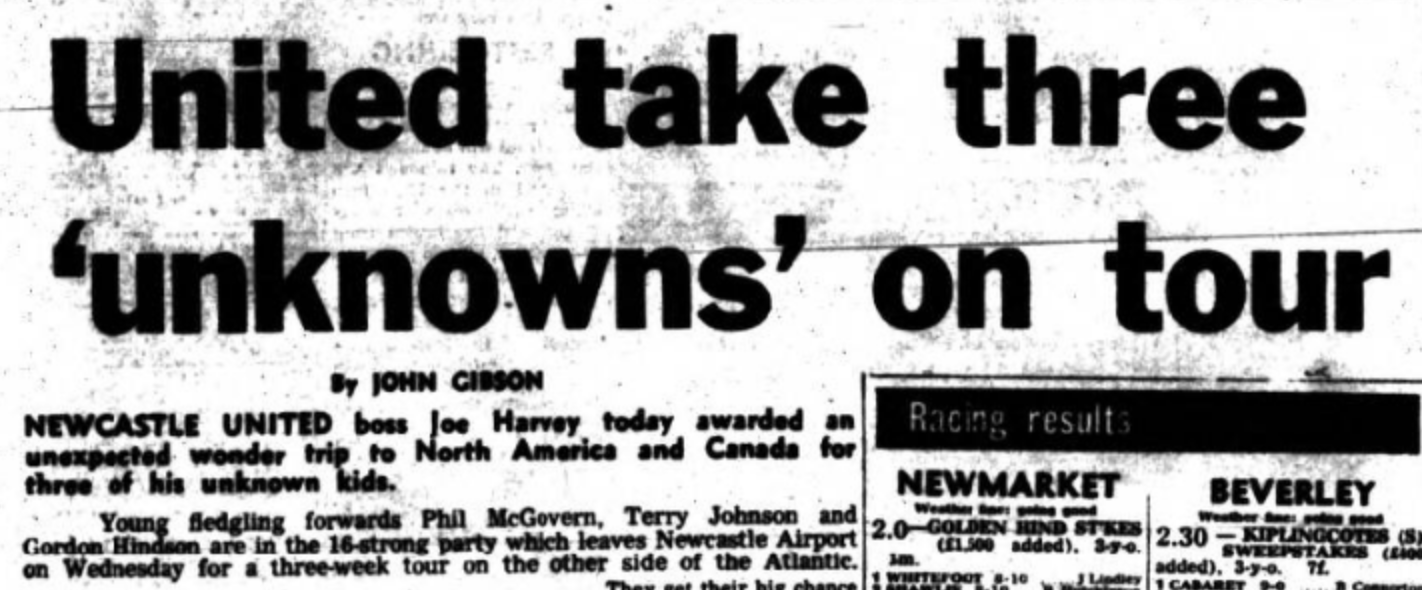 Now the owner of a passport, he was included in the squad for United’s end season tour of North America & Canada.
Now the owner of a passport, he was included in the squad for United’s end season tour of North America & Canada.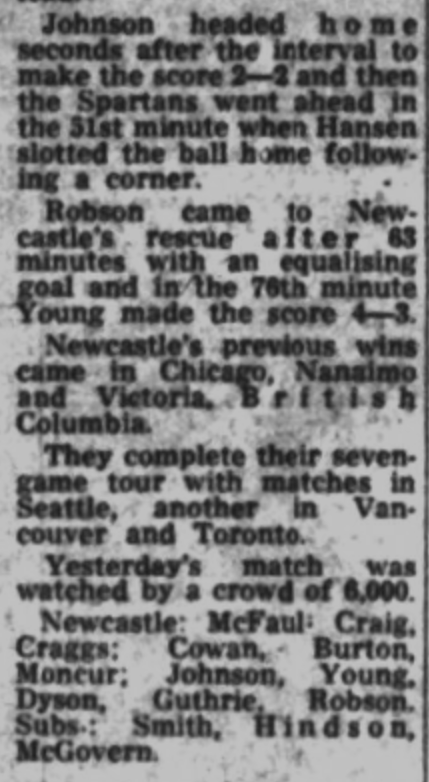 It proved a great success for Terry, he got games on the three week tour and even scored in the 4-3 win over Vancouver Spartans on 18th May.
It proved a great success for Terry, he got games on the three week tour and even scored in the 4-3 win over Vancouver Spartans on 18th May.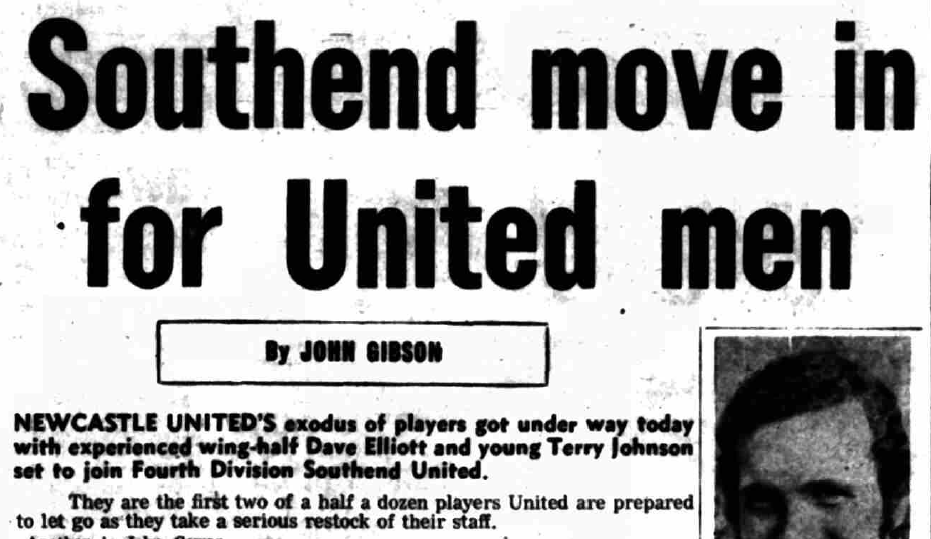 United were not short of offers for their players and Terry was on the radar of an unlikely Fourth Division club.
United were not short of offers for their players and Terry was on the radar of an unlikely Fourth Division club. On Tuesday 19th January Rowley drove up to Wolverhampton to watch Terry play for United’s reserves, despite the 0-2 defeat he was suitably impressed with the 21 year old.
On Tuesday 19th January Rowley drove up to Wolverhampton to watch Terry play for United’s reserves, despite the 0-2 defeat he was suitably impressed with the 21 year old.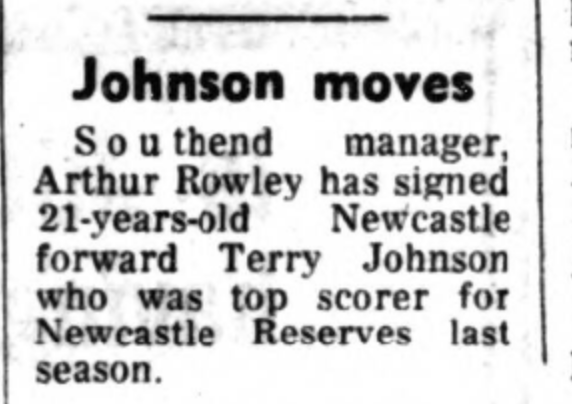 Having taken advice from the legendary Jackie Milburn he had already decided to leave and forge a career elsewhere, accepting the move straight away with a £7,000 fee being agreed between the clubs.
Having taken advice from the legendary Jackie Milburn he had already decided to leave and forge a career elsewhere, accepting the move straight away with a £7,000 fee being agreed between the clubs. Terry and he was an instant hit, three days after signing, Friday 29th January, he was handed his debut.
Terry and he was an instant hit, three days after signing, Friday 29th January, he was handed his debut. 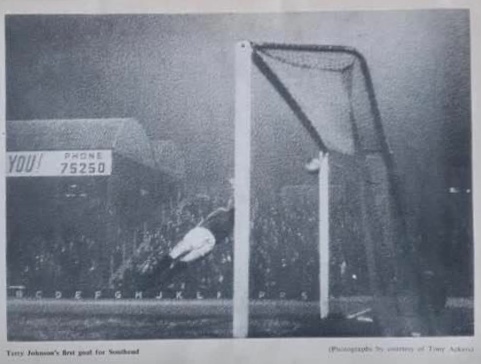
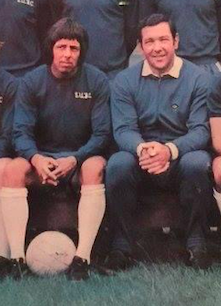
 They played four games against Soviet teams and in return Shahkter Donesk would visit England in the November to help cover the cost of the trip behind the Iron Curtain.
They played four games against Soviet teams and in return Shahkter Donesk would visit England in the November to help cover the cost of the trip behind the Iron Curtain. The 1971/72 season proved to be a great one for the club, Terry was a virtual ever present playing as a winger scoring vital goals as they finished Runners Up and gained the club’s first ever promotion.
The 1971/72 season proved to be a great one for the club, Terry was a virtual ever present playing as a winger scoring vital goals as they finished Runners Up and gained the club’s first ever promotion.
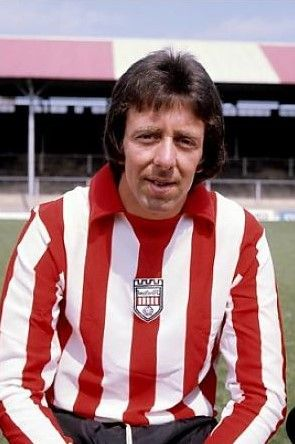 Football wise the move proved a good one, moving to live in Greater London less so. In February 76 he asked to be placed on the transfer list with the view to hopefully moving closer to home.
Football wise the move proved a good one, moving to live in Greater London less so. In February 76 he asked to be placed on the transfer list with the view to hopefully moving closer to home.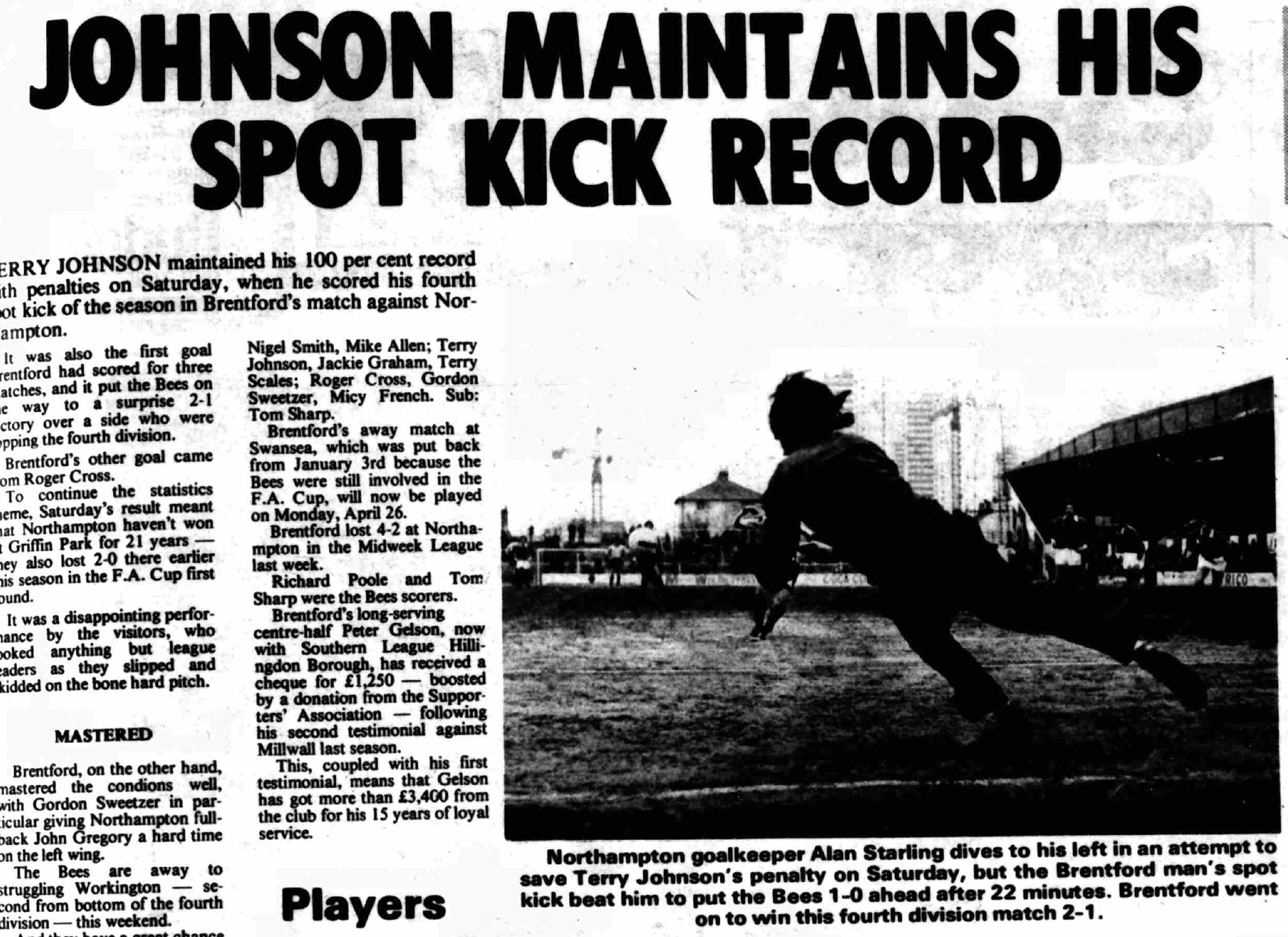 From a wide midfield birth he scored 8 in 25 appearances, with 3 penalties he had a 100% record from the spot.
From a wide midfield birth he scored 8 in 25 appearances, with 3 penalties he had a 100% record from the spot.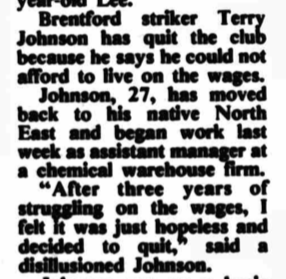 Knowing he was still under contract Terry feared Dodgin may be somewhat annoyed, even vindictive when he asked if he would be allowed to play for a local side. Terry was grateful of his managers understanding whole of the situation, they agreed on the provision they kept his registration.
Knowing he was still under contract Terry feared Dodgin may be somewhat annoyed, even vindictive when he asked if he would be allowed to play for a local side. Terry was grateful of his managers understanding whole of the situation, they agreed on the provision they kept his registration. 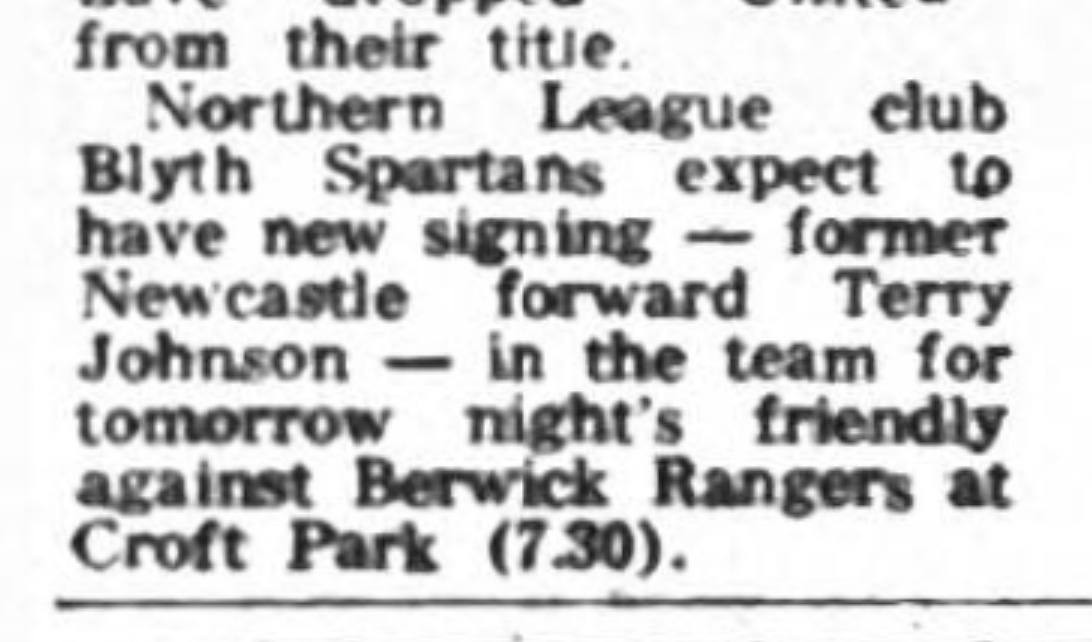 He made his debut in the friendly against Berwick Rangers on Friday 5th August and scored his first goal 4 days later in the 5-2 home friendly win over Wallsend Town.
He made his debut in the friendly against Berwick Rangers on Friday 5th August and scored his first goal 4 days later in the 5-2 home friendly win over Wallsend Town.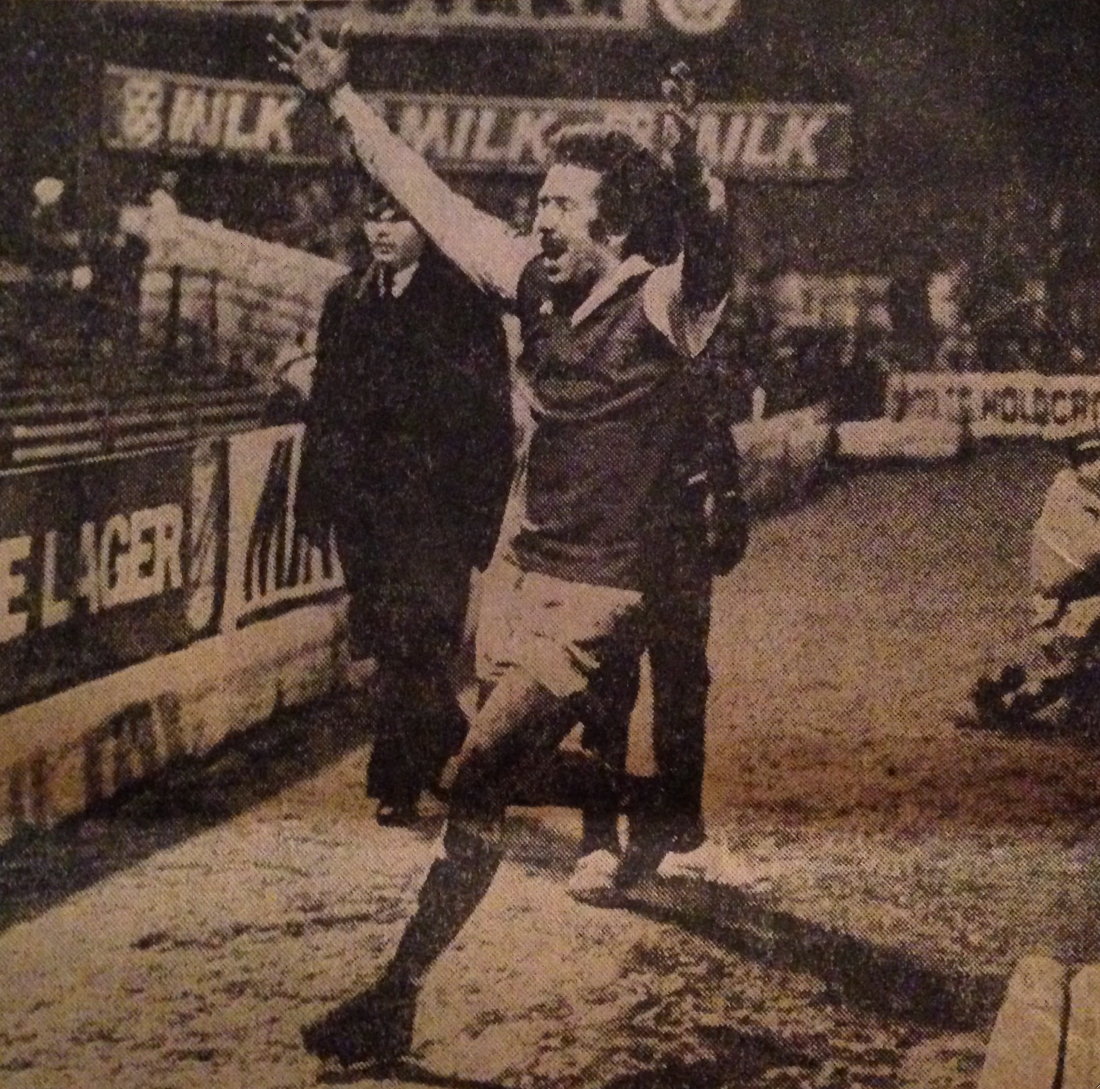 By the time Blyth played Stoke City away in a delayed FA Cup 4th round tie he had scored another 10 goals.
By the time Blyth played Stoke City away in a delayed FA Cup 4th round tie he had scored another 10 goals.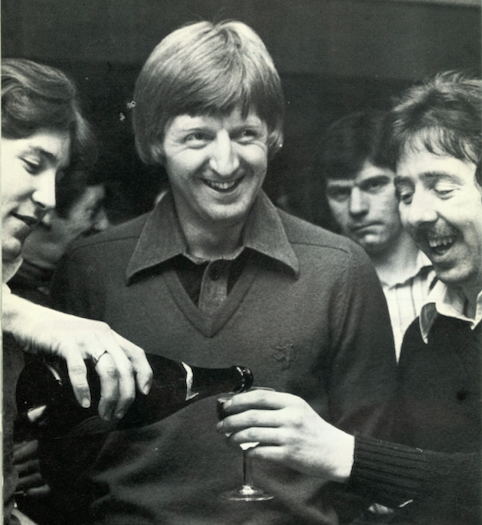 home until 2.30am in morning he was up at 7.30am to drive to his work.
home until 2.30am in morning he was up at 7.30am to drive to his work.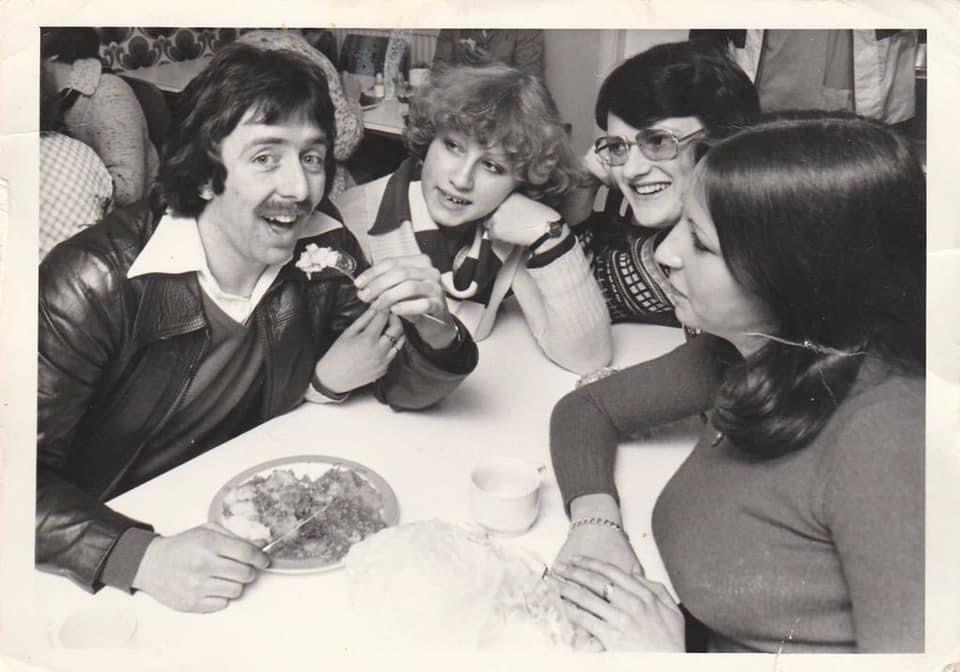 Having taken a job as a storeman at the Jackel factory in Blyth the press wanted a photo of the hero at his place of work.
Having taken a job as a storeman at the Jackel factory in Blyth the press wanted a photo of the hero at his place of work.
 On Saturday 21st February 78, Terry finally made a return to St James’. Blyth manager Brian Slane contacted United officials to ask if his players could visit the St James’ before the game to get a feel for the ground. United’s hieracy went one better and invited the Blyth players & officials to be guests of honour at the home game with Ipswich on Saturday 21st February.
On Saturday 21st February 78, Terry finally made a return to St James’. Blyth manager Brian Slane contacted United officials to ask if his players could visit the St James’ before the game to get a feel for the ground. United’s hieracy went one better and invited the Blyth players & officials to be guests of honour at the home game with Ipswich on Saturday 21st February.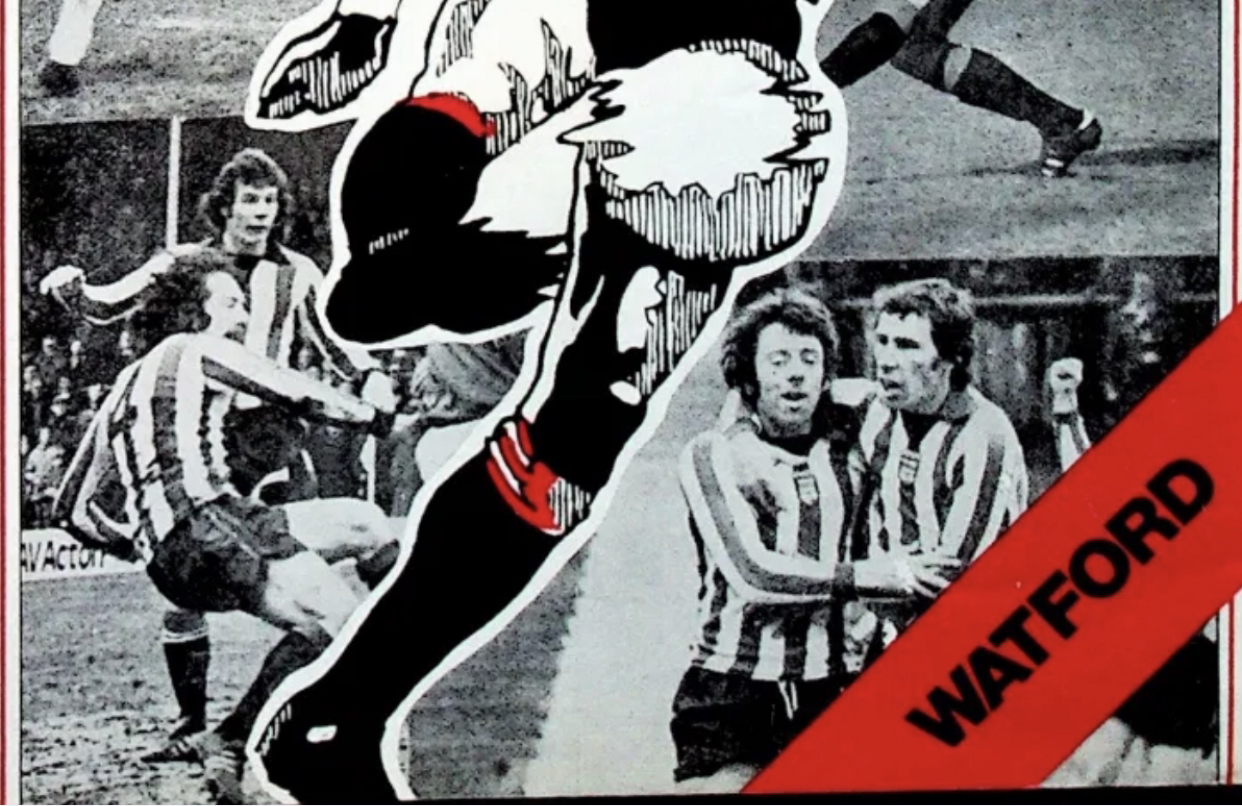 Having featured on the cover of Brentford’s programme for the 76/77 season, once again he was graced a match day programme.
Having featured on the cover of Brentford’s programme for the 76/77 season, once again he was graced a match day programme. 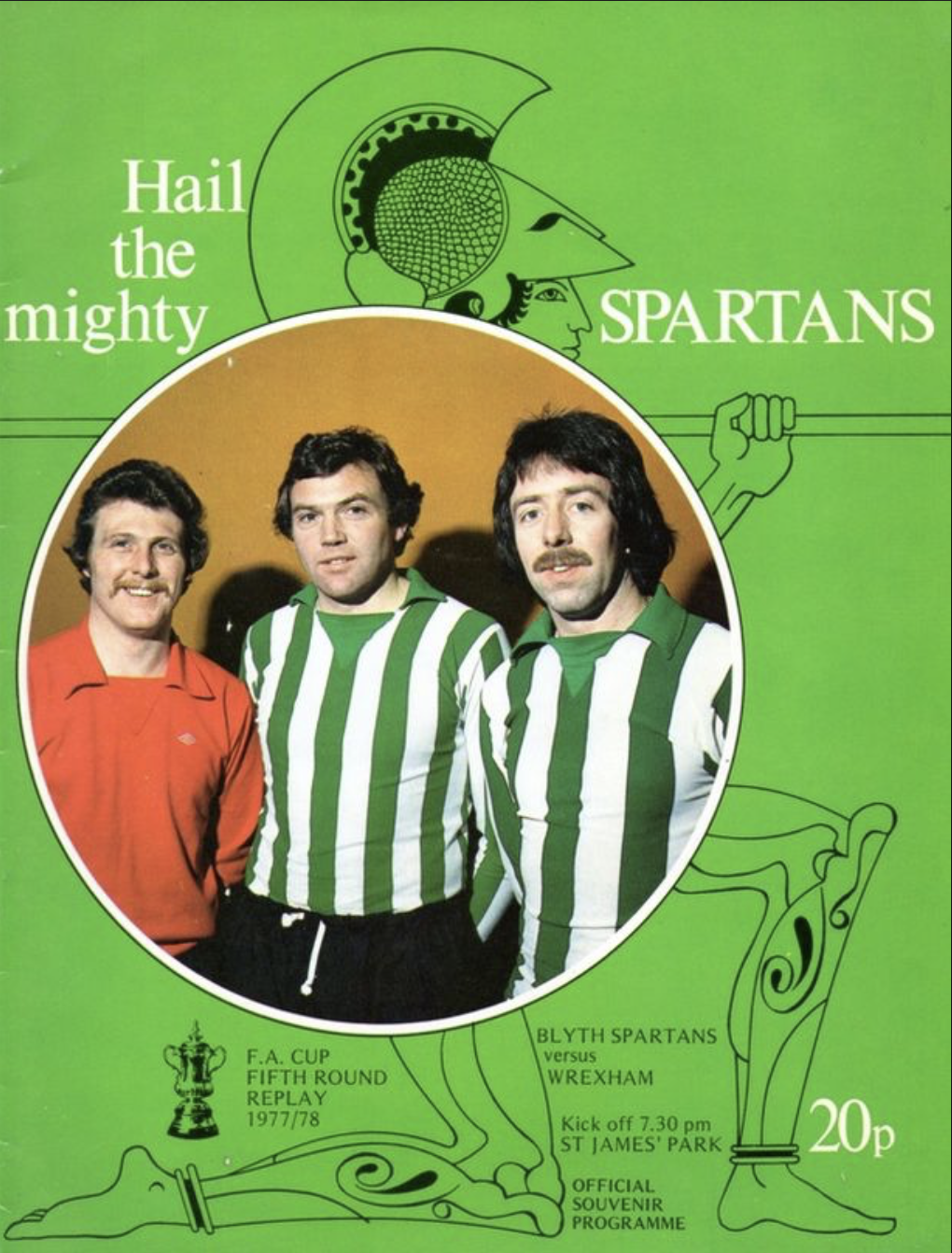
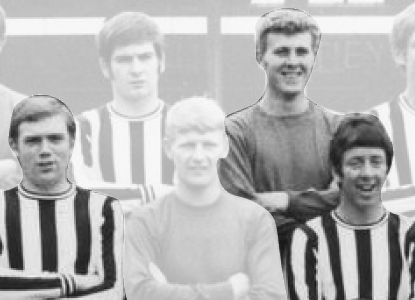 replay featured only three of the Spartans heroes; Terry, Dave Clarke & Ron Guthrie.
replay featured only three of the Spartans heroes; Terry, Dave Clarke & Ron Guthrie. On the night of the legendary replay, Terry was the darling of the packed St James’ Park crowd that he had once worked so hard to play in front of.
On the night of the legendary replay, Terry was the darling of the packed St James’ Park crowd that he had once worked so hard to play in front of. After a decade of trying to make a name for himself in the professional game with only moderate success in the lower reaches of the Football League, after only 28 games as a part time player he had achieved national fame.
After a decade of trying to make a name for himself in the professional game with only moderate success in the lower reaches of the Football League, after only 28 games as a part time player he had achieved national fame.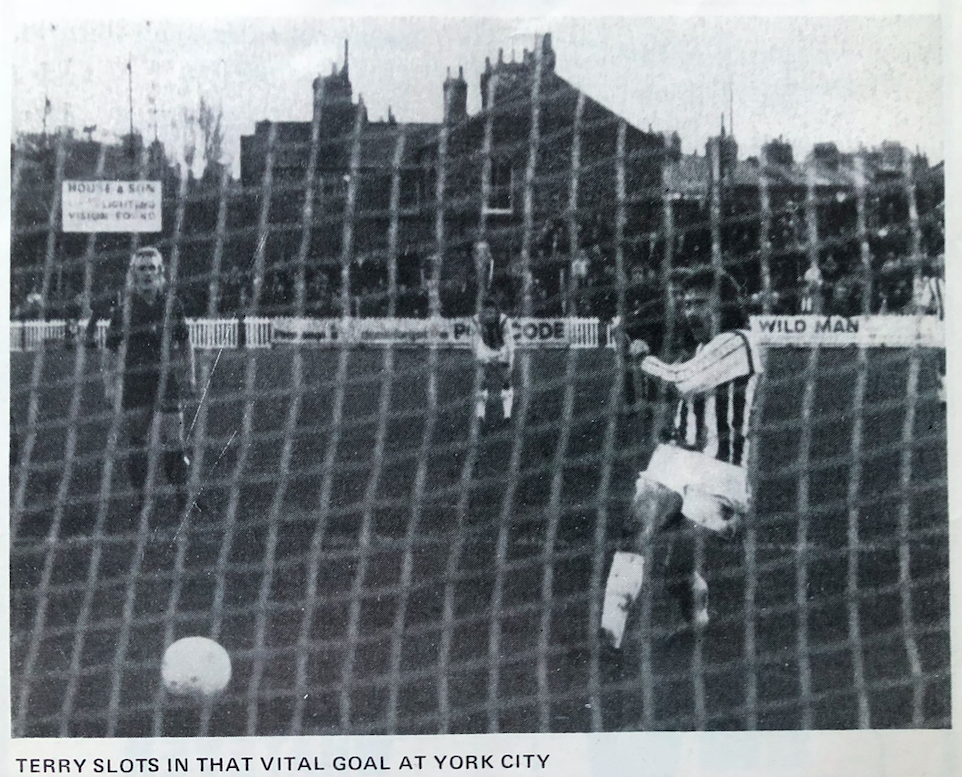 He started the new 78/79 season in great style, Saturday 19th August he hit a hat trick in the open day 5-1 home win over Horden CW. His next goals also came in a 5-1 win, bagging a brace in the home win over Willington on Tuesday 29th August.
He started the new 78/79 season in great style, Saturday 19th August he hit a hat trick in the open day 5-1 home win over Horden CW. His next goals also came in a 5-1 win, bagging a brace in the home win over Willington on Tuesday 29th August.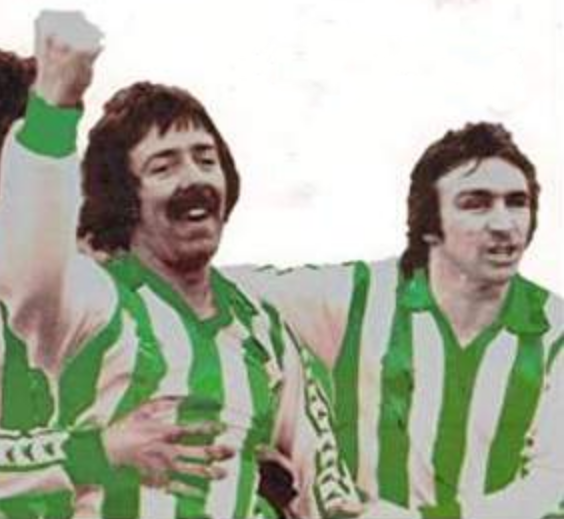 By the time he returned to action on the 22nd January his strike partner
By the time he returned to action on the 22nd January his strike partner 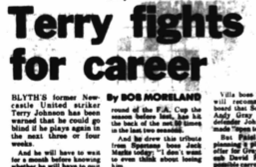 The 79/80 campaign was the start of the worst run of injuries he’d ever had in the game.
The 79/80 campaign was the start of the worst run of injuries he’d ever had in the game. After 12 months of injury misery in January 1980 he decided it was time to quit the game, sadly the competition that had made him famous had ended his career.
After 12 months of injury misery in January 1980 he decided it was time to quit the game, sadly the competition that had made him famous had ended his career.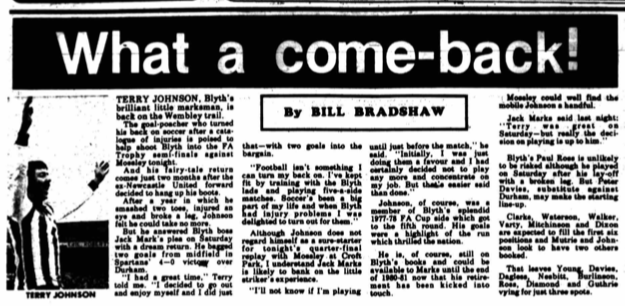
 Ahead of the FA Trophy Quarter Final replay, The Journal’s reporter Bill Bradshaw quizzed Terry on his future plans:
Ahead of the FA Trophy Quarter Final replay, The Journal’s reporter Bill Bradshaw quizzed Terry on his future plans: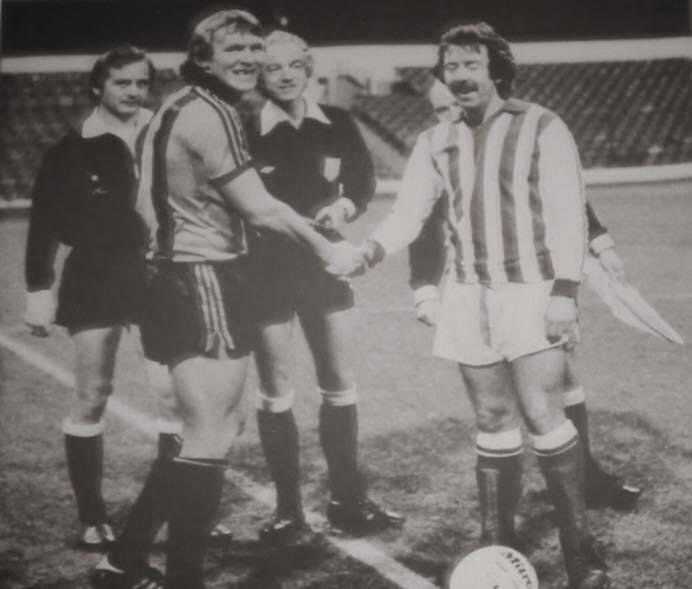 He returned to action on 17th September as Blyth were in the middle of a 17 game unbeaten run and is first goal of the season came in the 1-1 draw at home to Crook Town on 23rd September.
He returned to action on 17th September as Blyth were in the middle of a 17 game unbeaten run and is first goal of the season came in the 1-1 draw at home to Crook Town on 23rd September.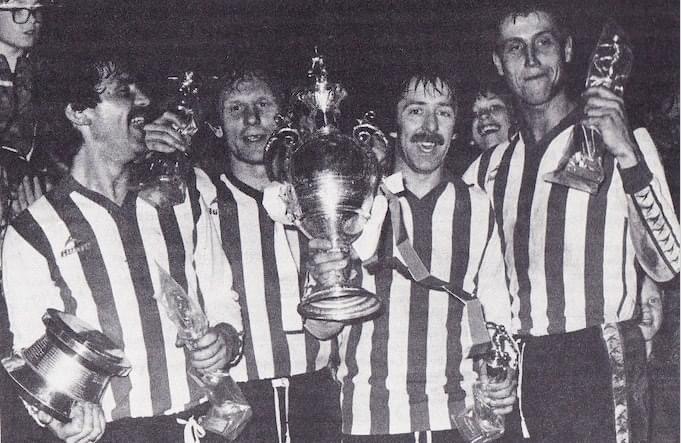
 In the summer of 1981 he was made redundant from his job at Jackel International.
In the summer of 1981 he was made redundant from his job at Jackel International.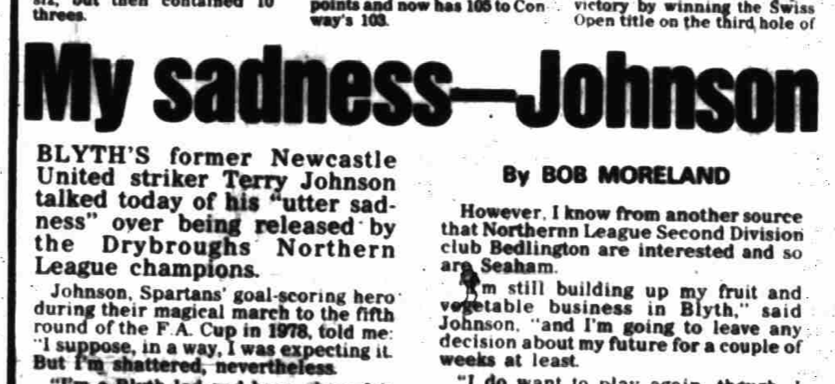 Terry spoke of his sadness:
Terry spoke of his sadness:
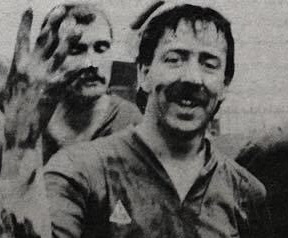
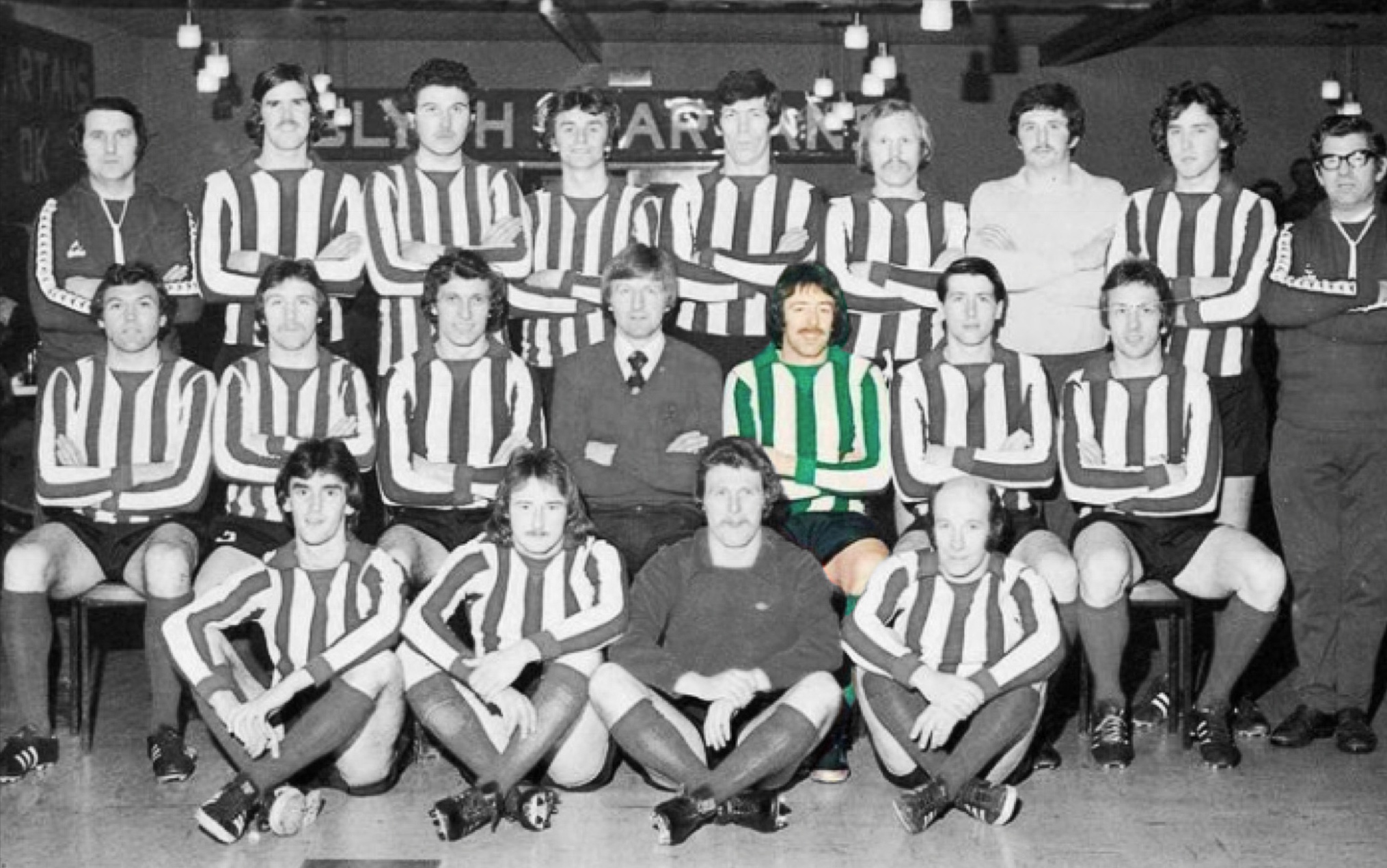 Every one of those 77/78 players are legends for what they achieved, they will never be forgotten even now their names are still revered in Non League football.
Every one of those 77/78 players are legends for what they achieved, they will never be forgotten even now their names are still revered in Non League football.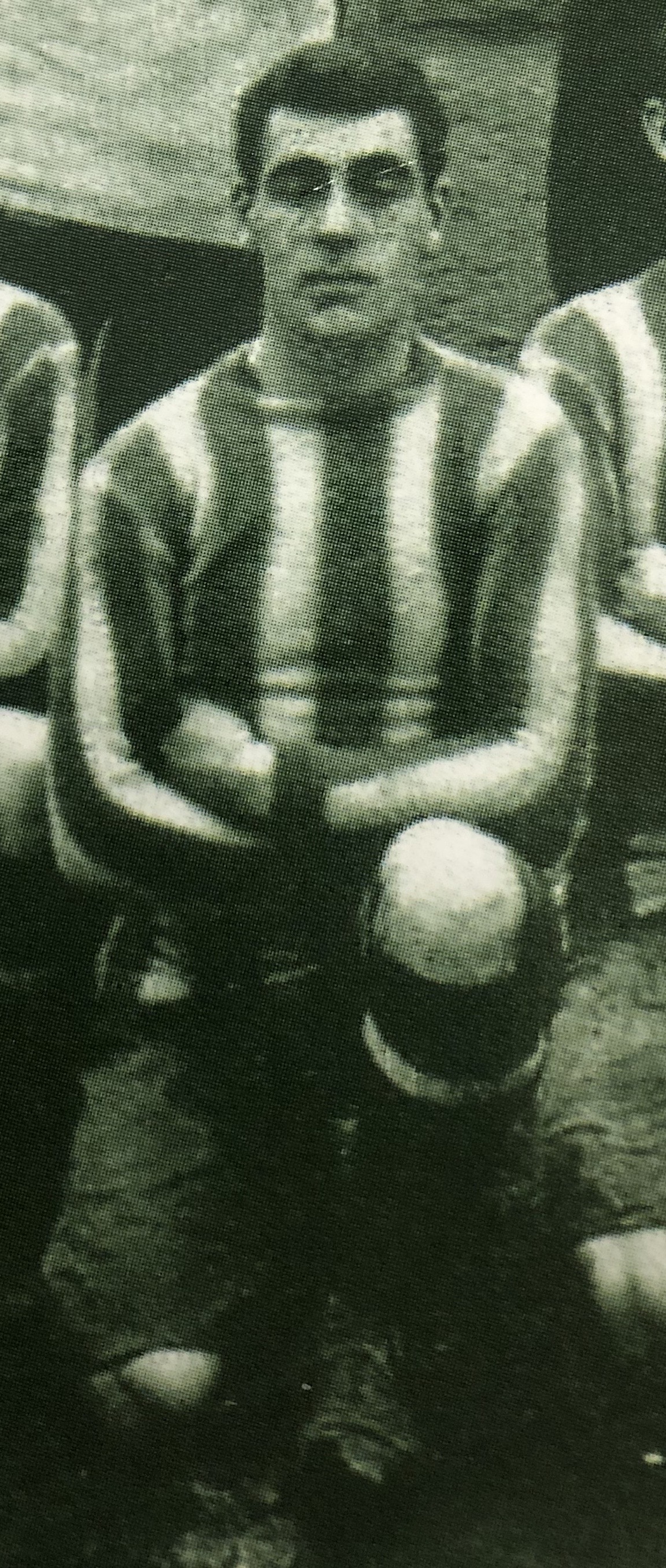 The Spartans had already been playing for seven seasons before Peter joined, there had been standout players in those early years such as the likes of Billy Gallagher, Billy Spence and the Thompson brothers; Andrew & Nixon.
The Spartans had already been playing for seven seasons before Peter joined, there had been standout players in those early years such as the likes of Billy Gallagher, Billy Spence and the Thompson brothers; Andrew & Nixon.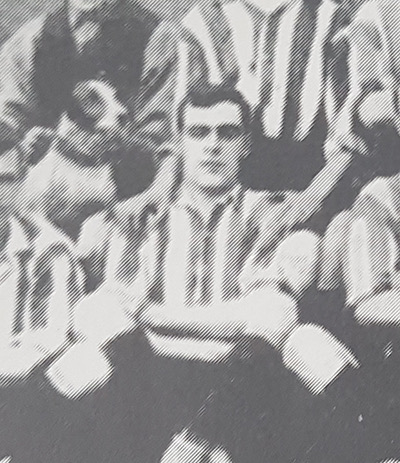
 His role in helping the club to the title had earned him hero status with the supporters but on Wednesday 28th April 1909 he took his fame to a new level, virtually singled handily sealing a trophy double.
His role in helping the club to the title had earned him hero status with the supporters but on Wednesday 28th April 1909 he took his fame to a new level, virtually singled handily sealing a trophy double.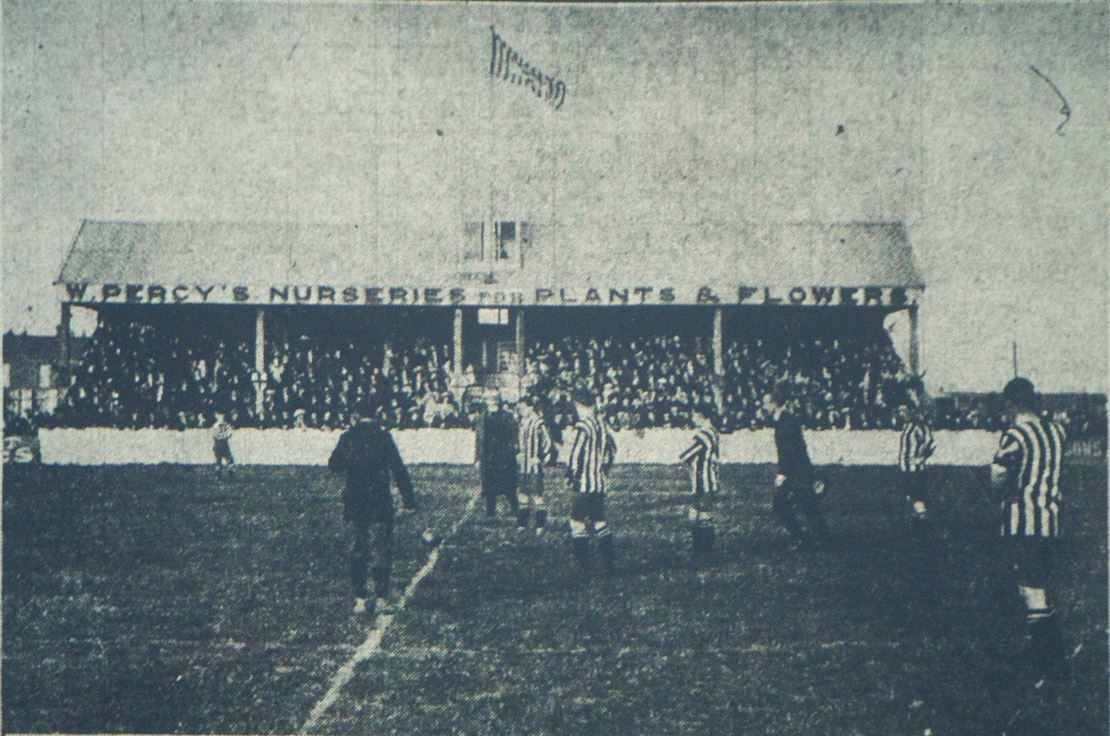
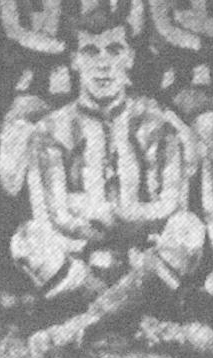 For his achievement the club awarded him with a set of presentation carving knives from a renowned ironmongers in Bridge Street, Blyth; Dalston Brothers.
For his achievement the club awarded him with a set of presentation carving knives from a renowned ironmongers in Bridge Street, Blyth; Dalston Brothers.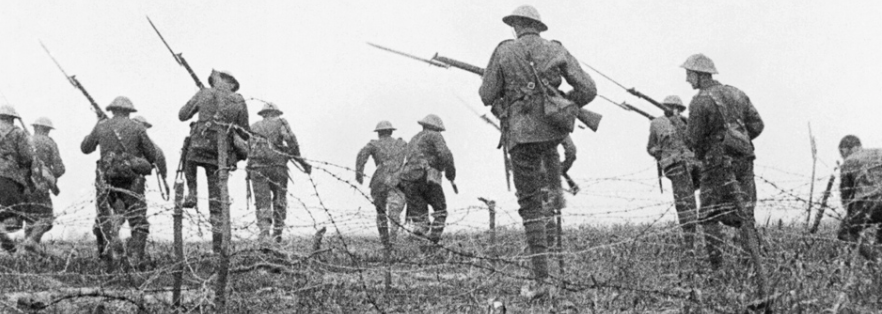 Sadly Peter’s brother younger Thomas, who was in the 3rd Tyneside Irish 26th Battalion, lost his life on that fateful day on the Somme.
Sadly Peter’s brother younger Thomas, who was in the 3rd Tyneside Irish 26th Battalion, lost his life on that fateful day on the Somme. Roclincourt Military Cemetery, Pas de Calais, France is the Commonwealth War Grave of Private P. Mackin.
Roclincourt Military Cemetery, Pas de Calais, France is the Commonwealth War Grave of Private P. Mackin. There is also a family headstone in Cowpen Cemetery, Blyth which reads:
There is also a family headstone in Cowpen Cemetery, Blyth which reads: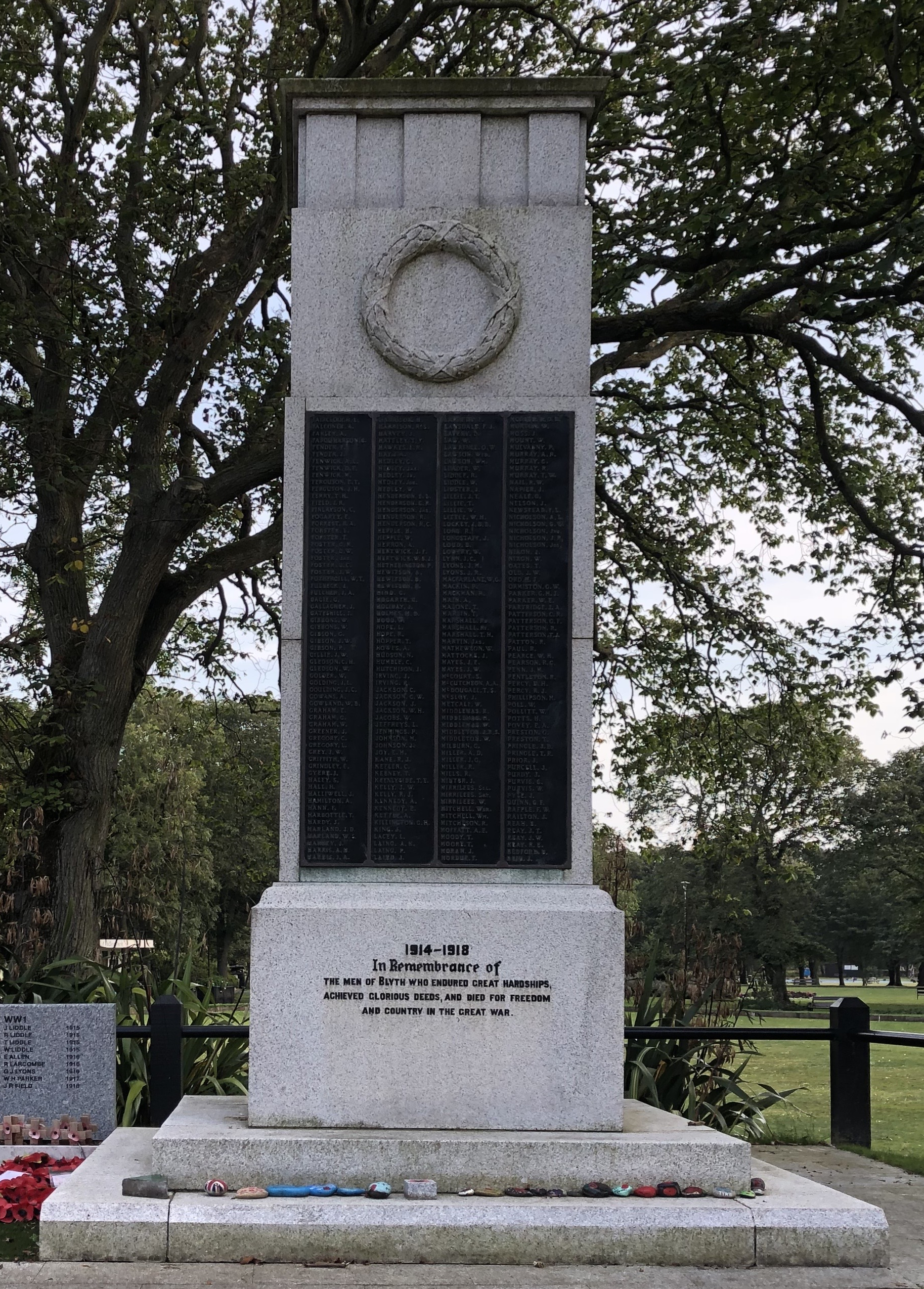

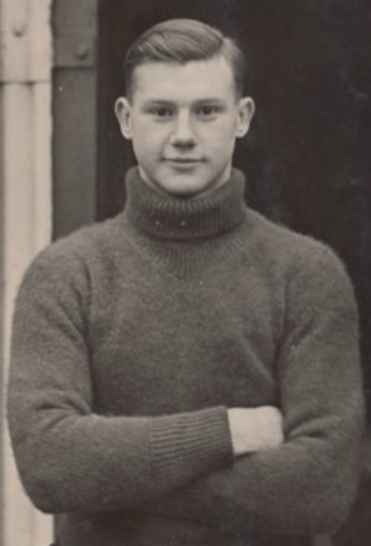 Francis Oliver King was born on 13th April 1917 in Radcliffe, Northumberland.
Francis Oliver King was born on 13th April 1917 in Radcliffe, Northumberland.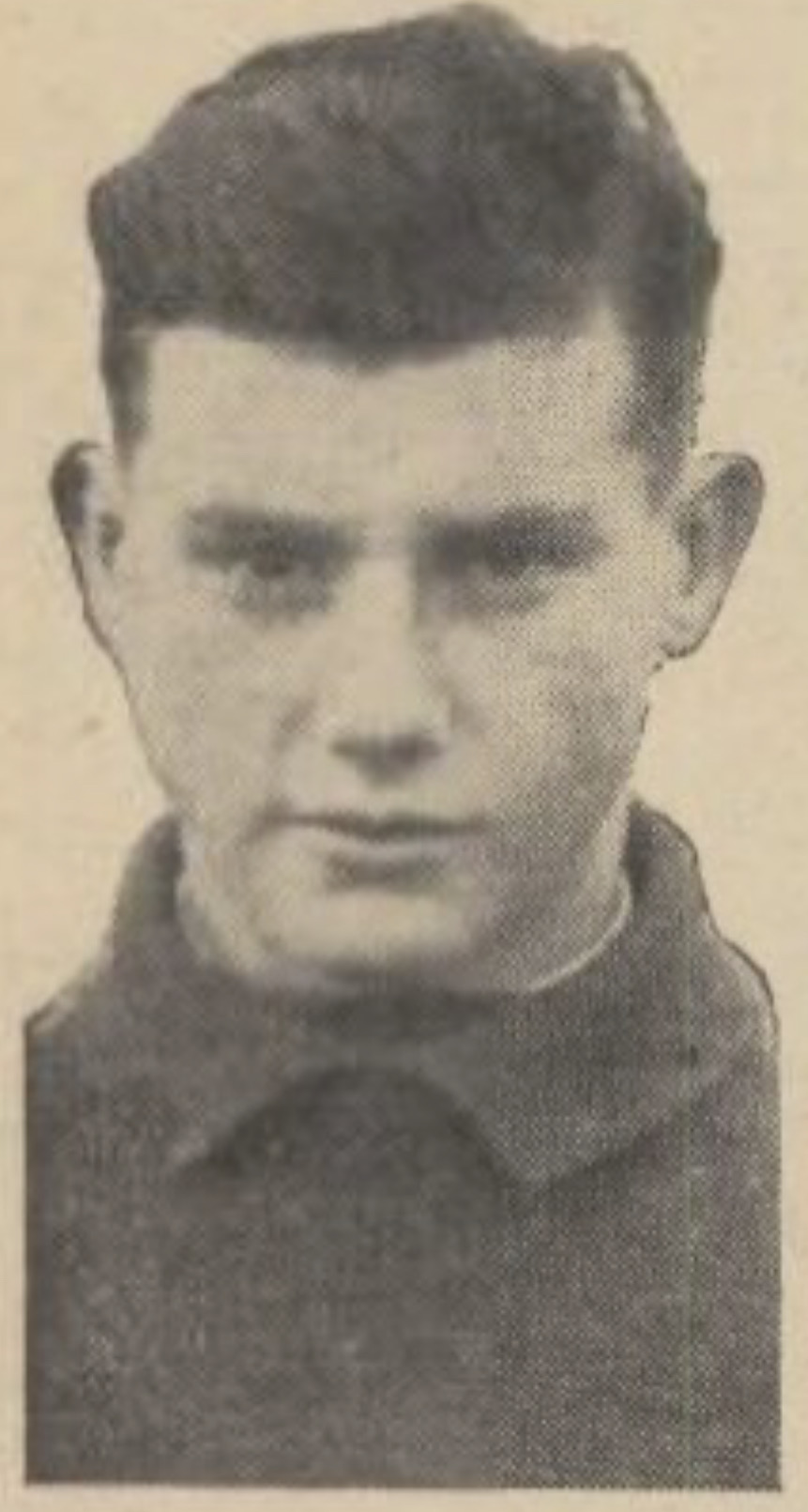 It was Blyth’s first official manager, Ernie Hoffman, that brought 16 year old Frank to Croft Park. Signing him from Amble with the intention of playing him in the Reserves to develop.
It was Blyth’s first official manager, Ernie Hoffman, that brought 16 year old Frank to Croft Park. Signing him from Amble with the intention of playing him in the Reserves to develop.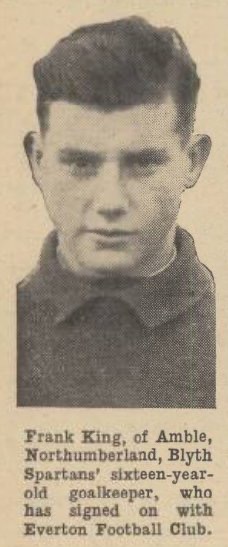 On Wednesday 22nd November Frank officially signed for the Toffees.
On Wednesday 22nd November Frank officially signed for the Toffees.
 It was seen as a shrewd signing by the Rams.
It was seen as a shrewd signing by the Rams. Between 1941/42 and 43/44 Frank made 23 appearances while still serving as a policeman. Having been out the game for over two years, his return wasn’t as successful.
Between 1941/42 and 43/44 Frank made 23 appearances while still serving as a policeman. Having been out the game for over two years, his return wasn’t as successful. In 1958 he accepted on offer to move to Luton Town to be their trainer. He was part of their infamous ‘selection team’ when the club reached Wembley for the first time in 1959.
In 1958 he accepted on offer to move to Luton Town to be their trainer. He was part of their infamous ‘selection team’ when the club reached Wembley for the first time in 1959.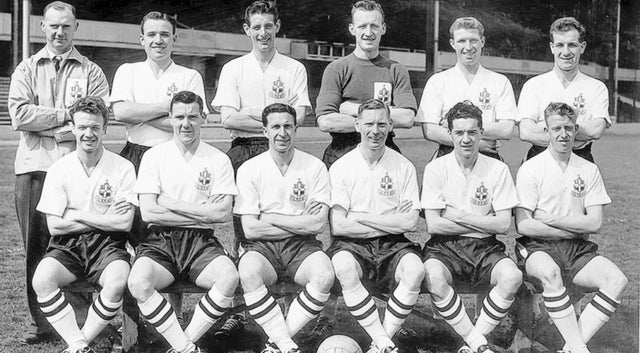 They used the same 11 players in the nine games to reach Wembley.
They used the same 11 players in the nine games to reach Wembley. Edward was born on 14th June 1895 in Whitehaven Cumberland to parents John and Catherine.
Edward was born on 14th June 1895 in Whitehaven Cumberland to parents John and Catherine.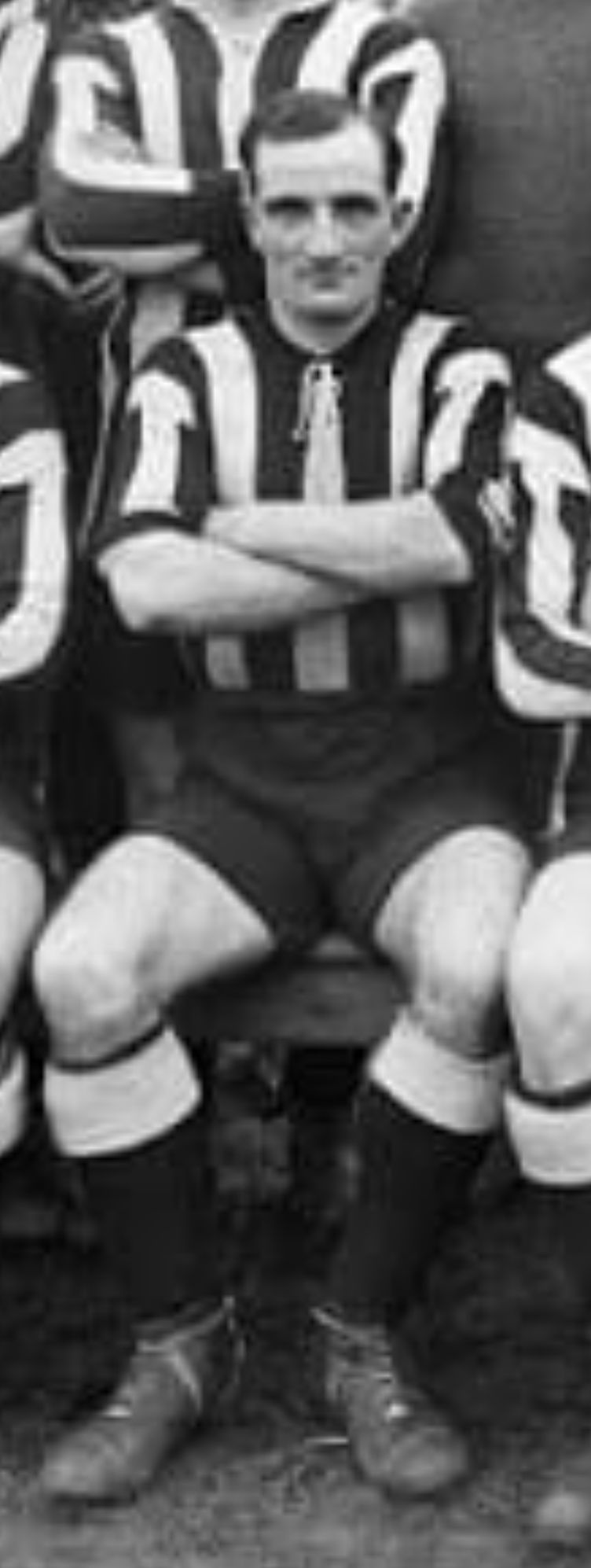 He joined Blyth in 1914 when New Hartley Rovers disbanded fearing the impact WWI might have on the club, he scored 13 goals in his first season at Croft Park. In January 1915 Ted scored 6 goals in 3 games, on Saturday 23rd January he scored all the goals in a 4-0 Senior Cup home win over Mickley.
He joined Blyth in 1914 when New Hartley Rovers disbanded fearing the impact WWI might have on the club, he scored 13 goals in his first season at Croft Park. In January 1915 Ted scored 6 goals in 3 games, on Saturday 23rd January he scored all the goals in a 4-0 Senior Cup home win over Mickley.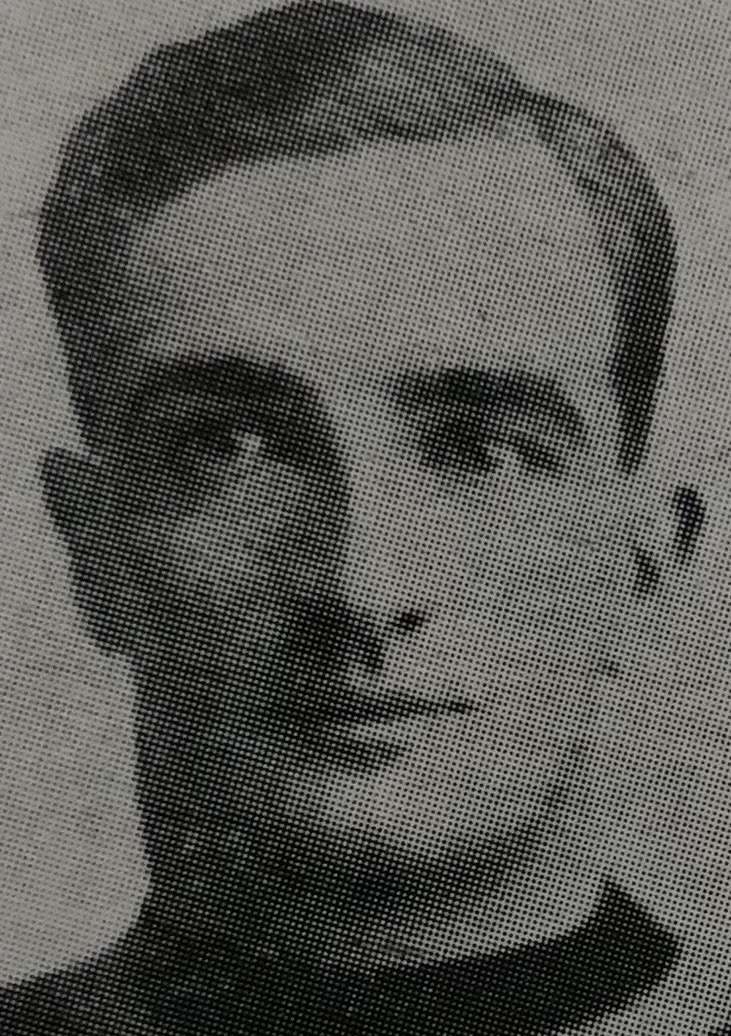 Ted made his debut on 28th August at SJP in front of 61,080 in the 0-0 draw with WBA.
Ted made his debut on 28th August at SJP in front of 61,080 in the 0-0 draw with WBA.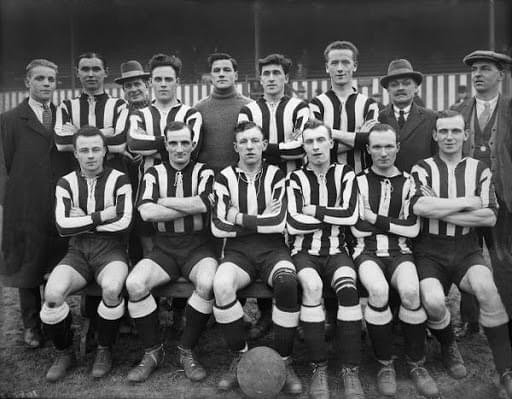

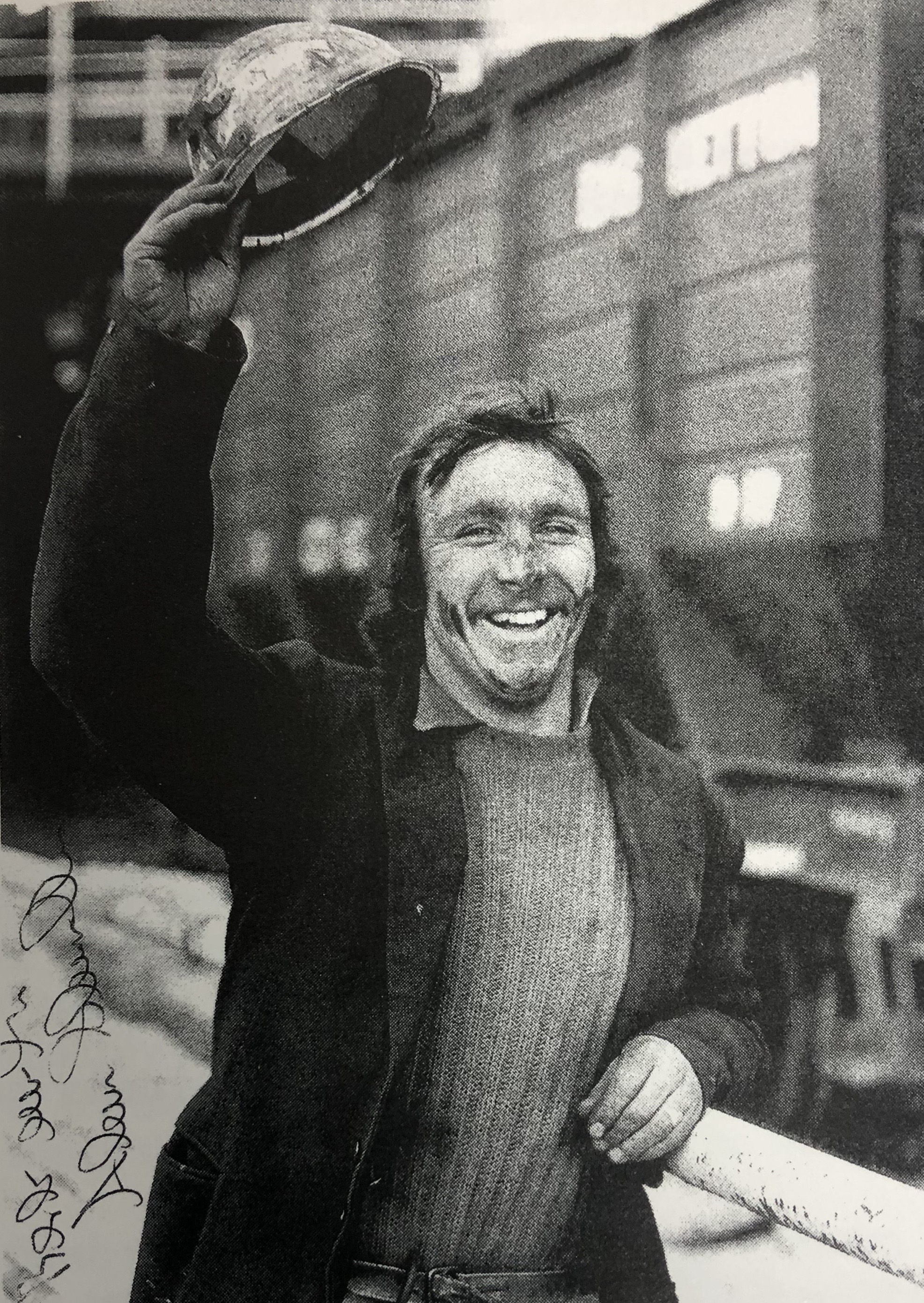 playing for a town so steeped in mining tradition Alan’s hero status was guaranteed.
playing for a town so steeped in mining tradition Alan’s hero status was guaranteed.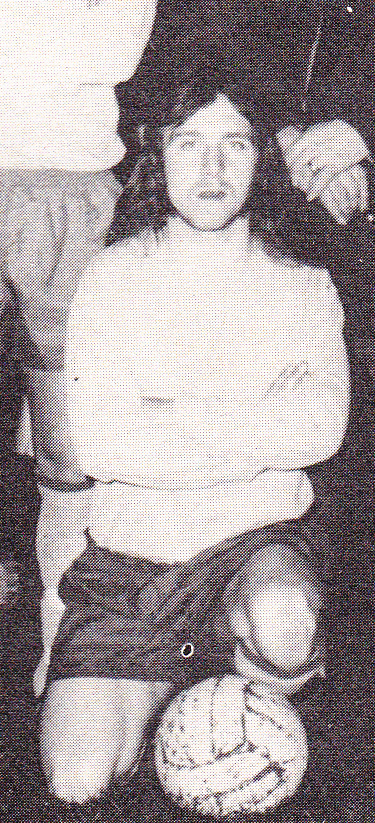 action style and goalscoring exploits for Leeholme Juniors soon drew the attentions of Northern League teams.
action style and goalscoring exploits for Leeholme Juniors soon drew the attentions of Northern League teams.
 After 5 years at Kingsway the 77/78 season started with him in dispute with the club which resulted in him refusing to play.
After 5 years at Kingsway the 77/78 season started with him in dispute with the club which resulted in him refusing to play.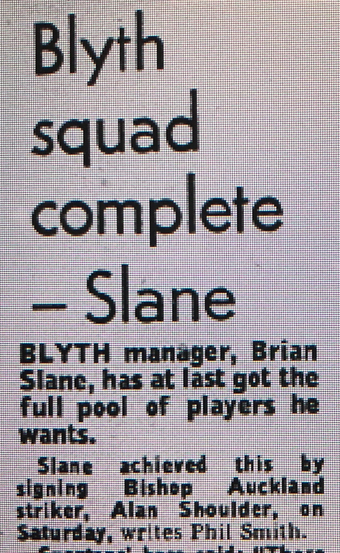 It took until 6th December before Brian finally managed to strike a deal to sign Alan after agreeing to pay Bishops £200.
It took until 6th December before Brian finally managed to strike a deal to sign Alan after agreeing to pay Bishops £200.
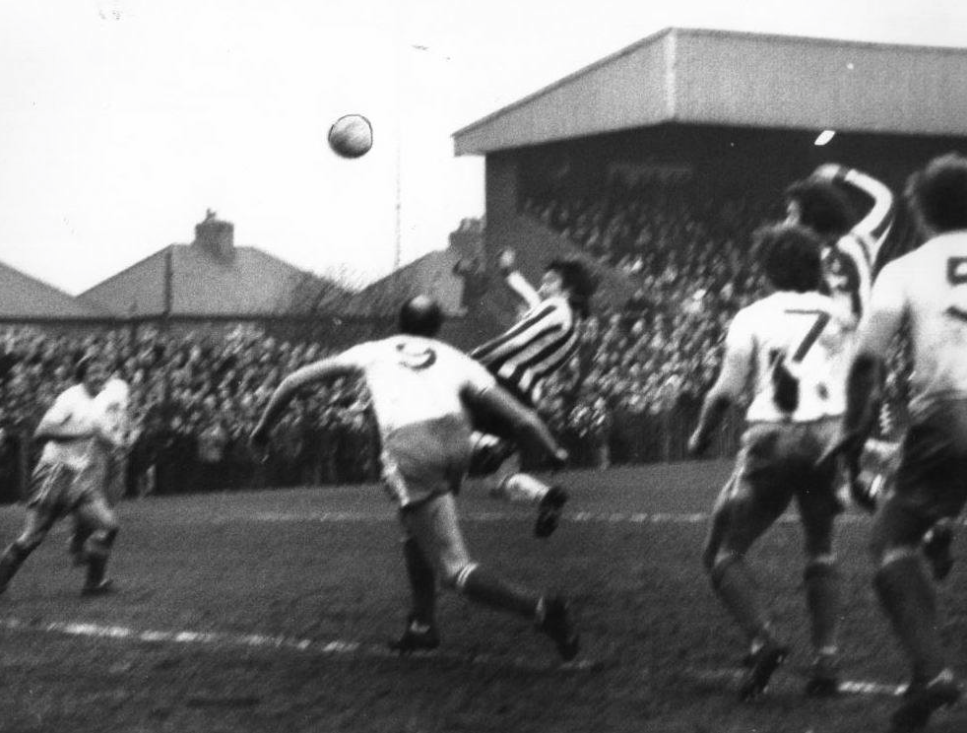
 The new 78/79 campaign started with the club on a high, however despite starting well things didn’t quite work out as hoped.
The new 78/79 campaign started with the club on a high, however despite starting well things didn’t quite work out as hoped.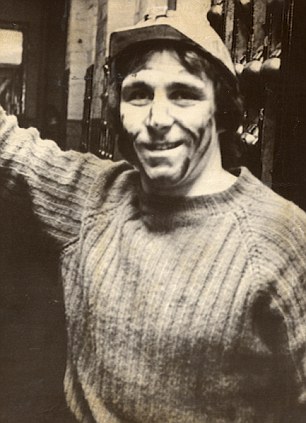 He informed the club that he wanted to move closer to his Durham home, stating the travelling had become too much since recently moving pits to Horden Colliery:
He informed the club that he wanted to move closer to his Durham home, stating the travelling had become too much since recently moving pits to Horden Colliery: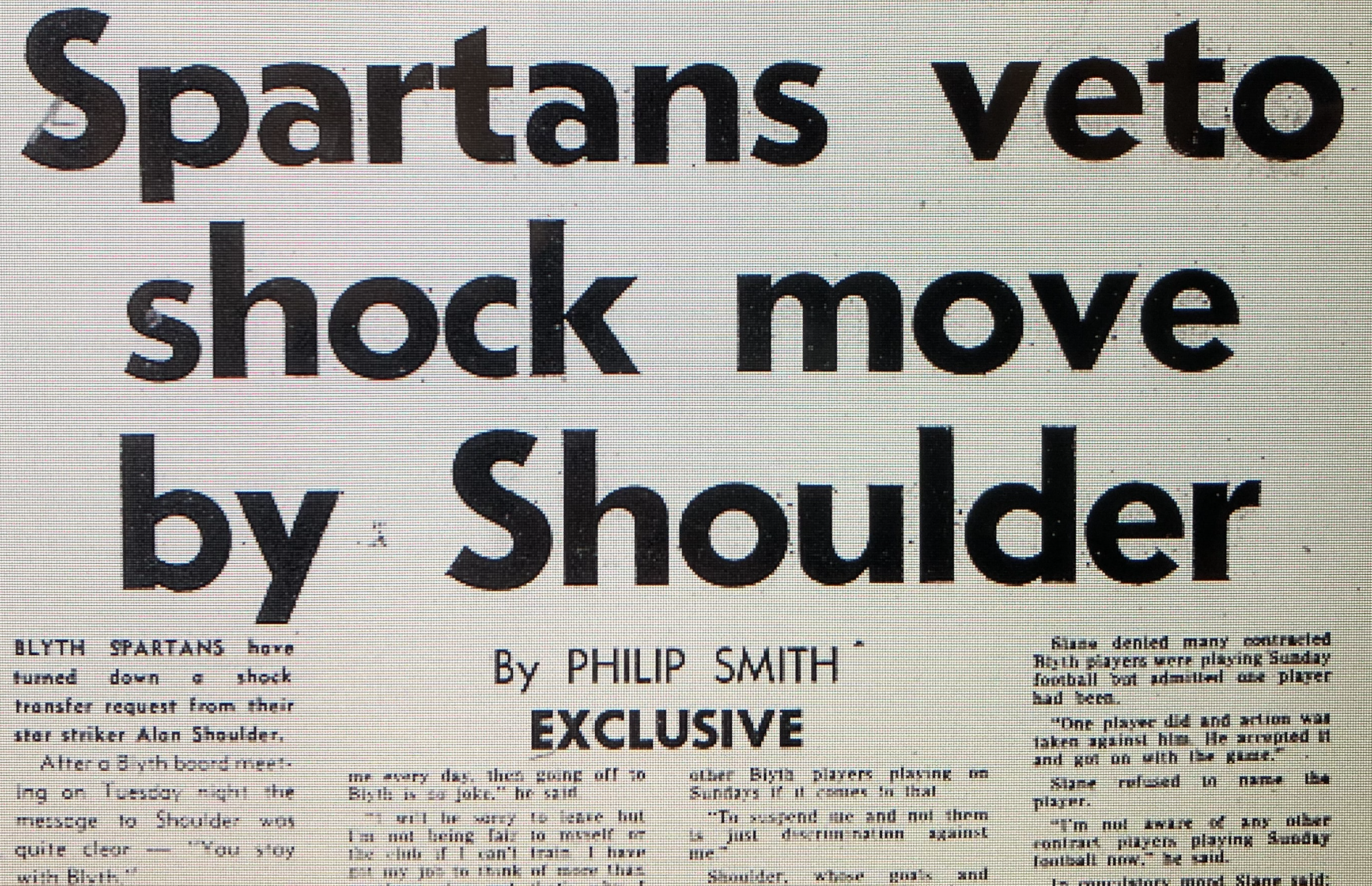
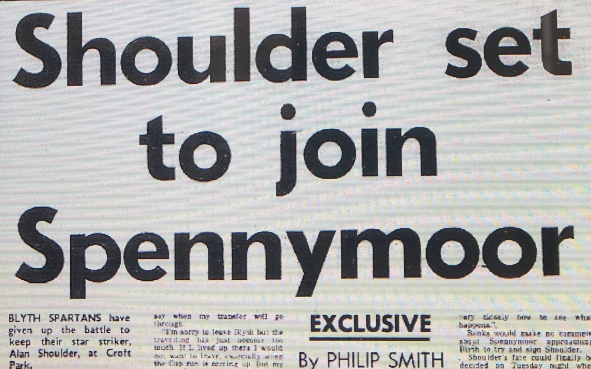 He submitted a second transfer request in an attempt to force the clubs hand, it was discussed at another board meeting.
He submitted a second transfer request in an attempt to force the clubs hand, it was discussed at another board meeting.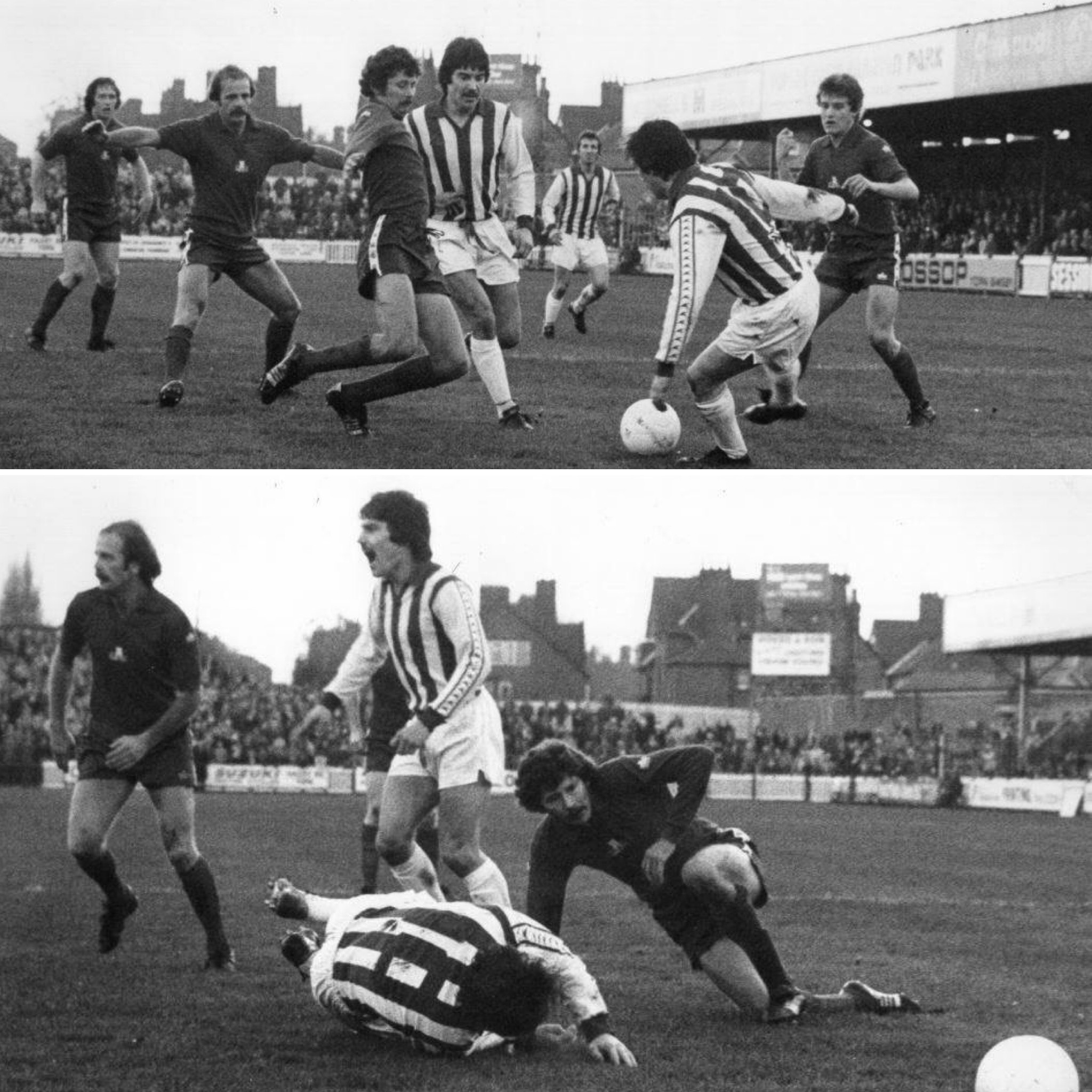
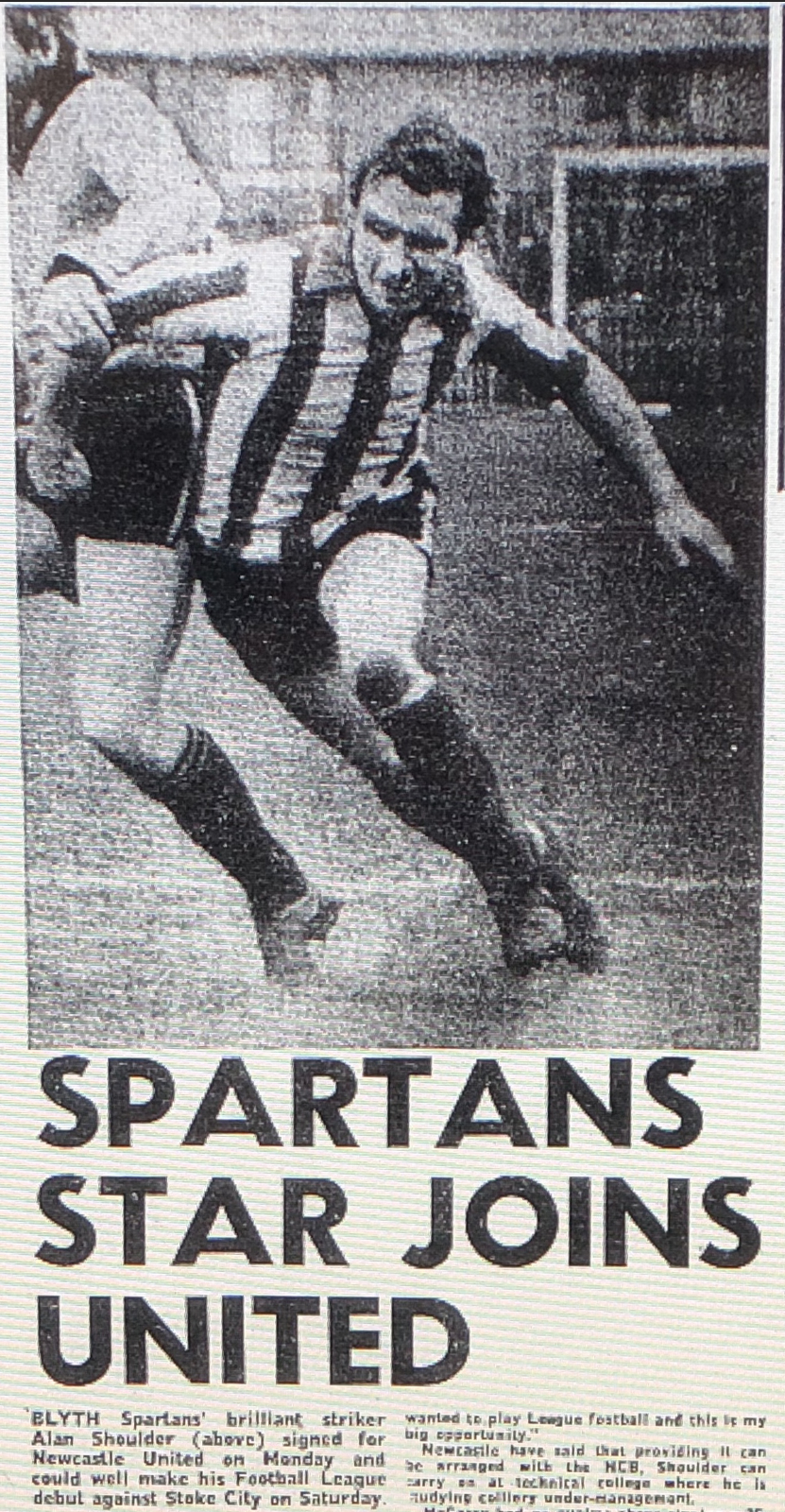 After only 48 games for the Spartans in which he scored 29 goals he was suddenly a professional footballer.
After only 48 games for the Spartans in which he scored 29 goals he was suddenly a professional footballer. He scored a very creditable 11 goals in 28 appearances that first season as United’s finished 7th in the Second Division.
He scored a very creditable 11 goals in 28 appearances that first season as United’s finished 7th in the Second Division.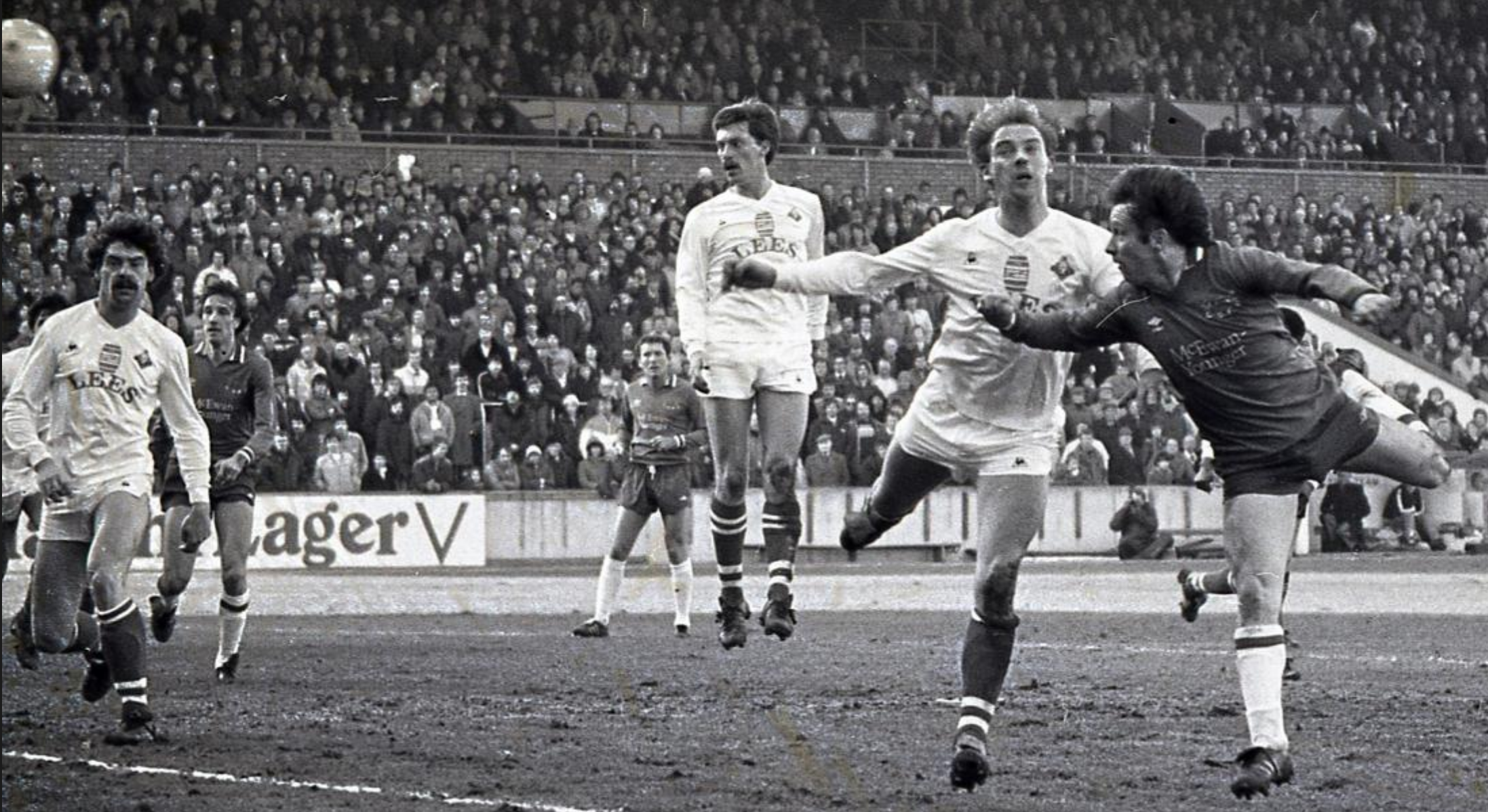 His first season at Brunton Park was a great success, in 46 appearances he scored 21 goals.
His first season at Brunton Park was a great success, in 46 appearances he scored 21 goals.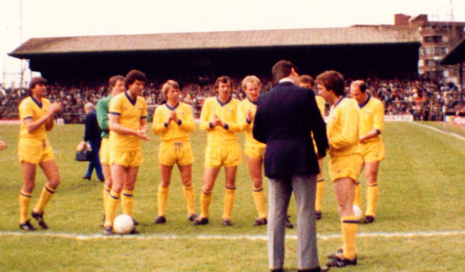
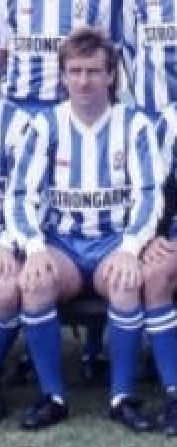
 He was one of five players from that
He was one of five players from that 

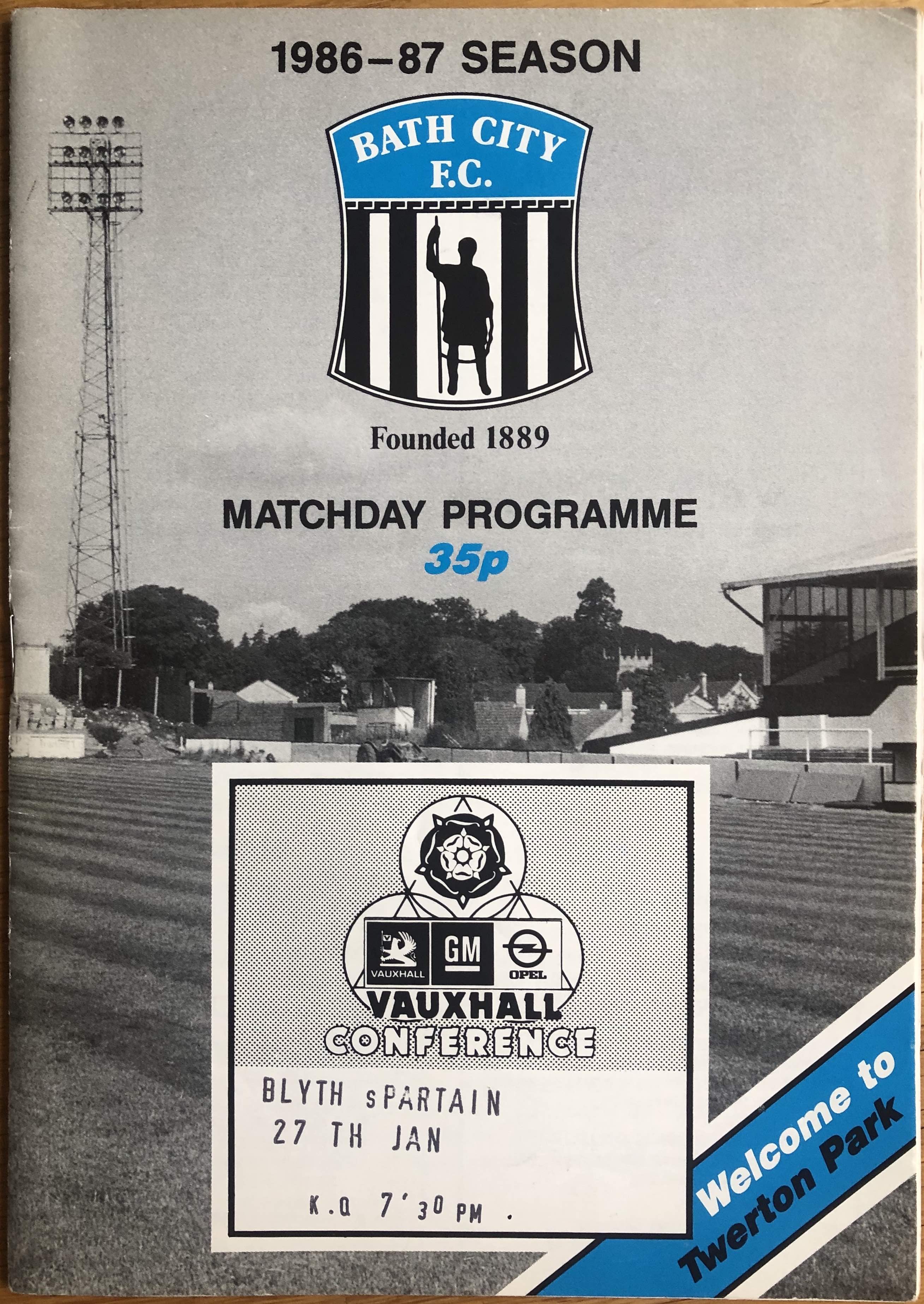

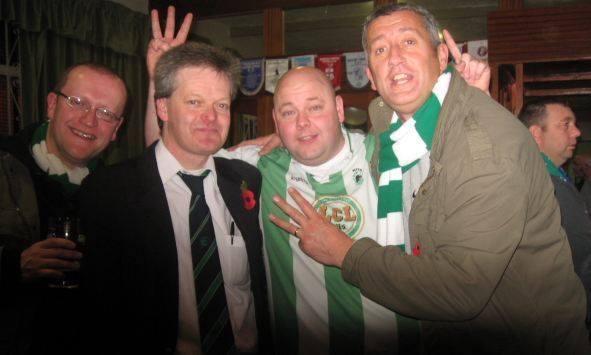
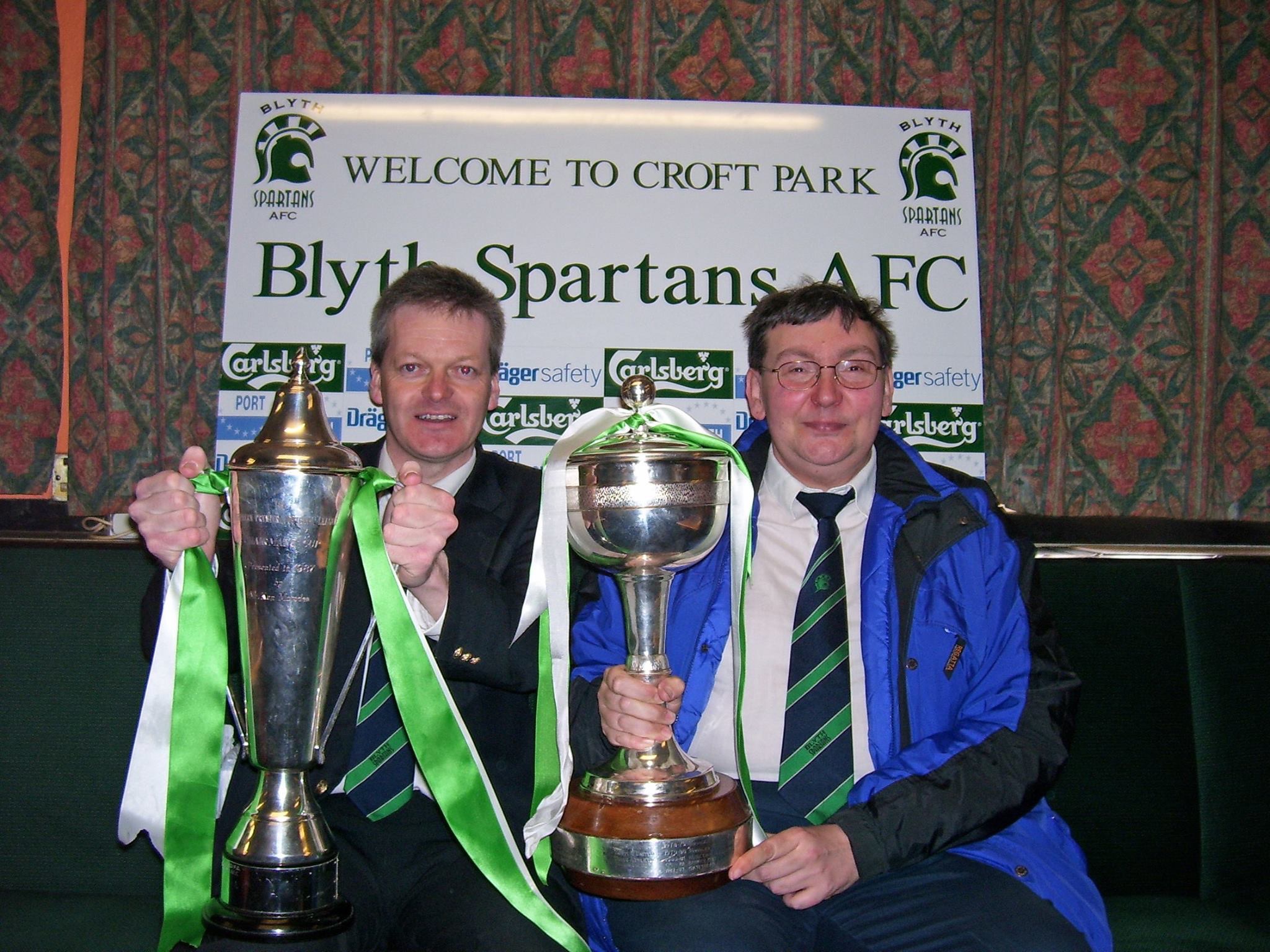

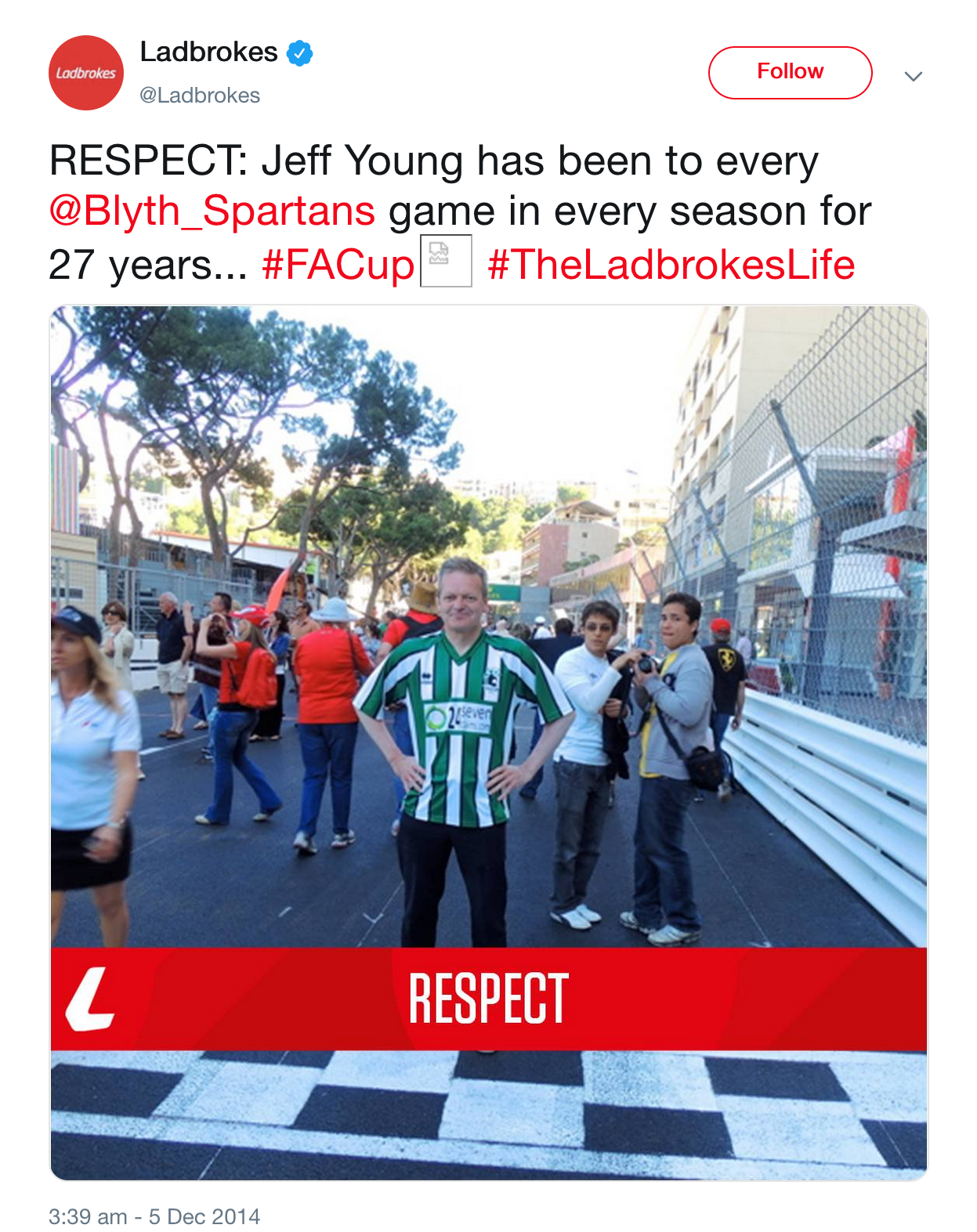
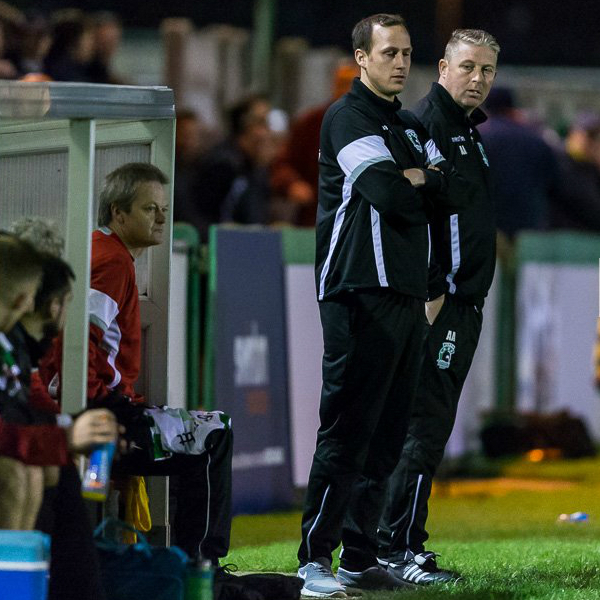
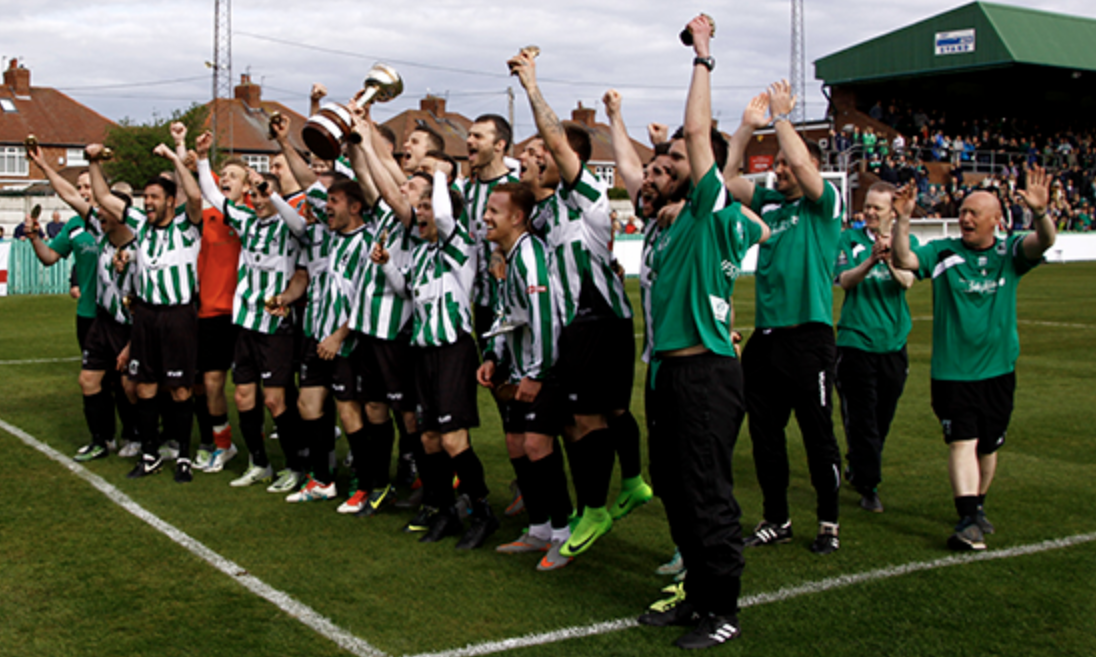
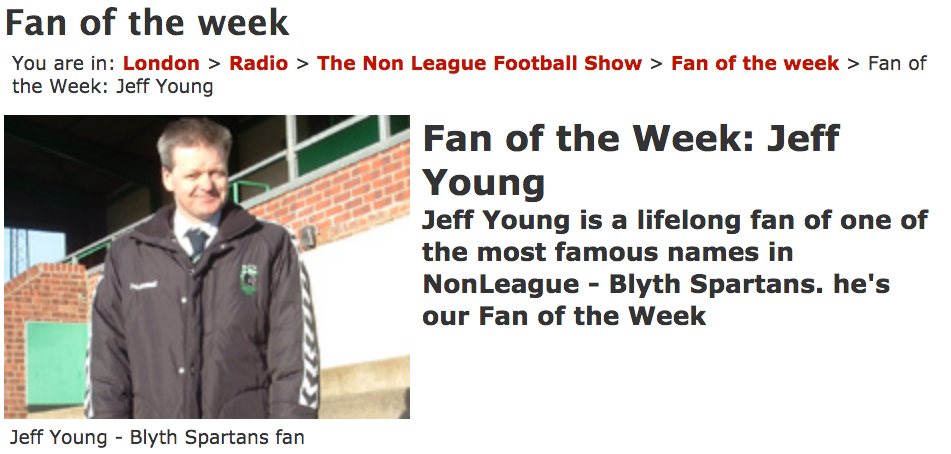
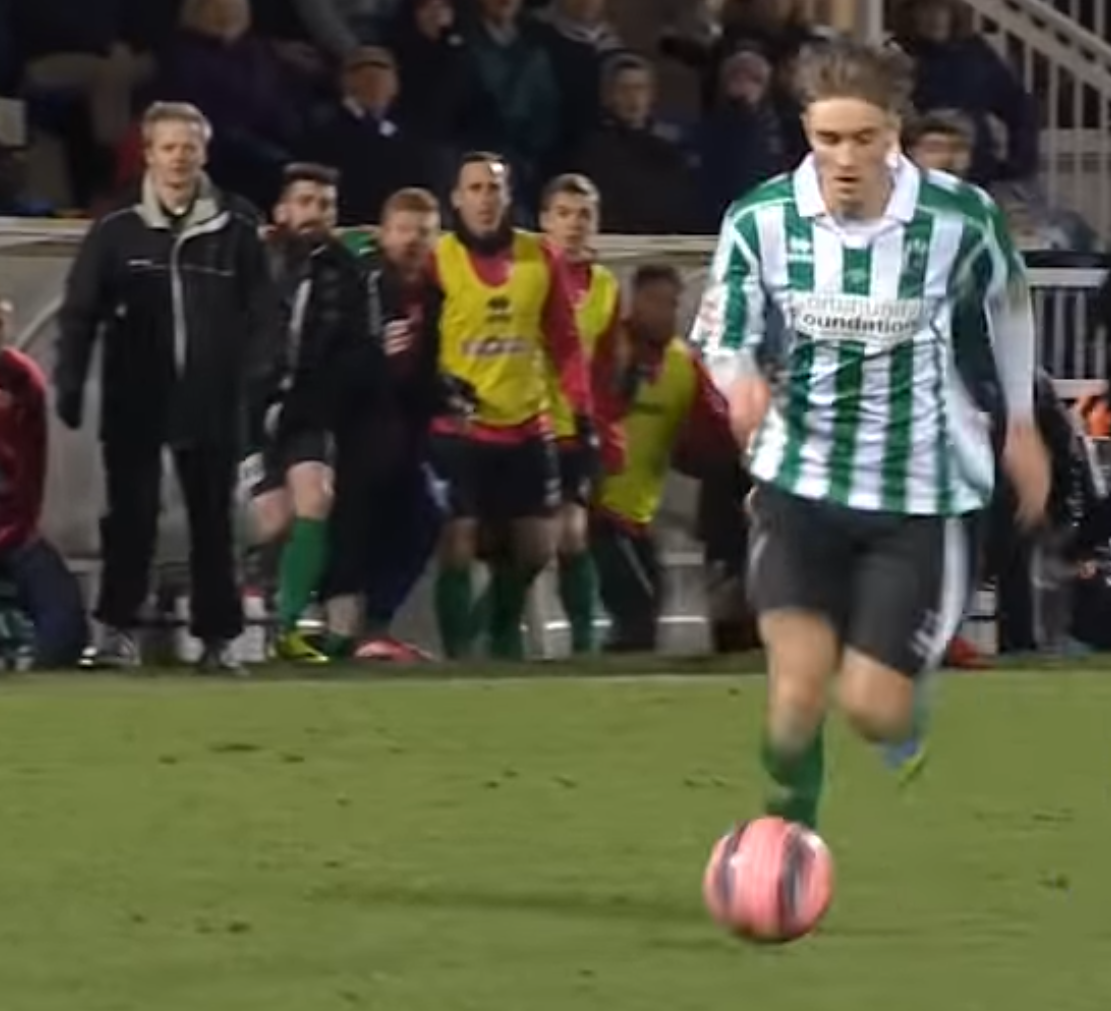
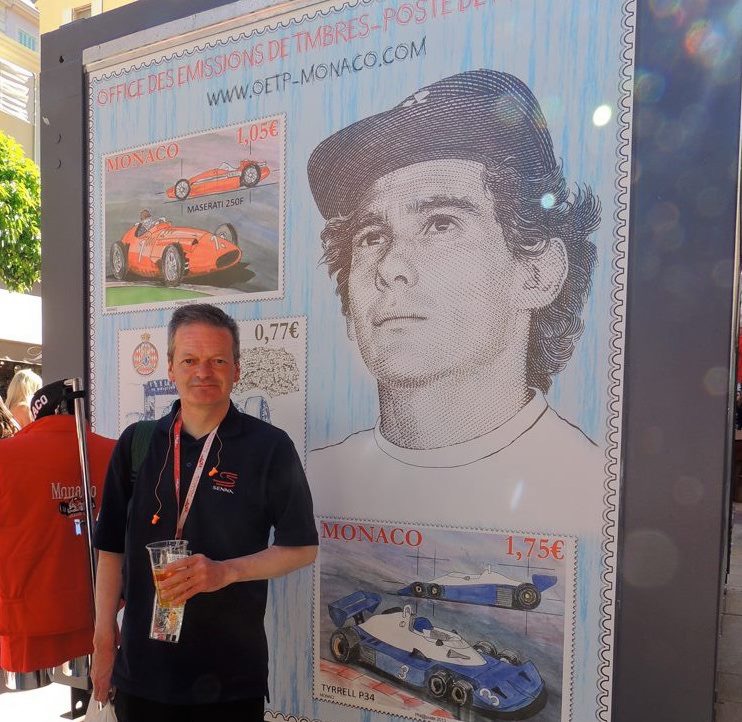
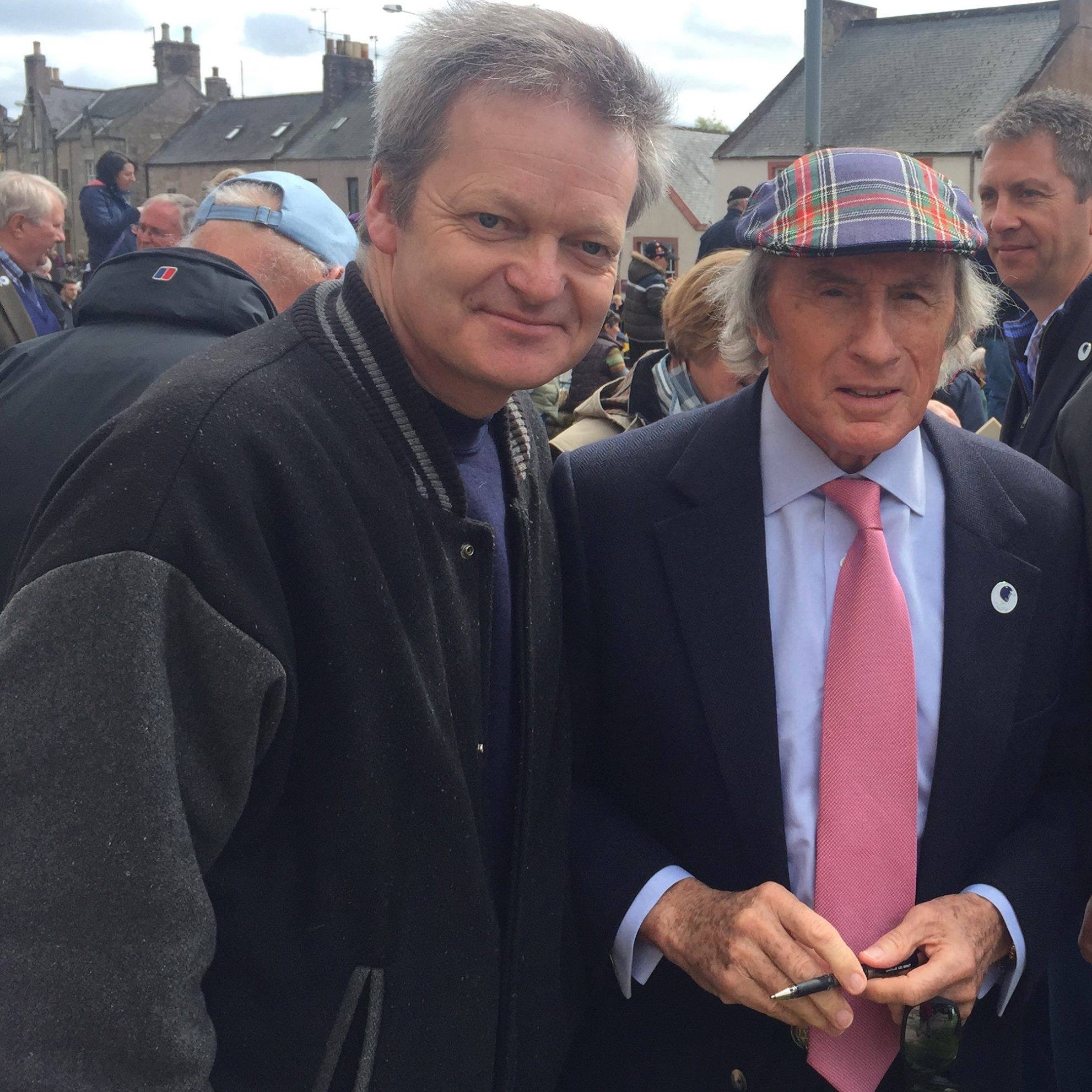
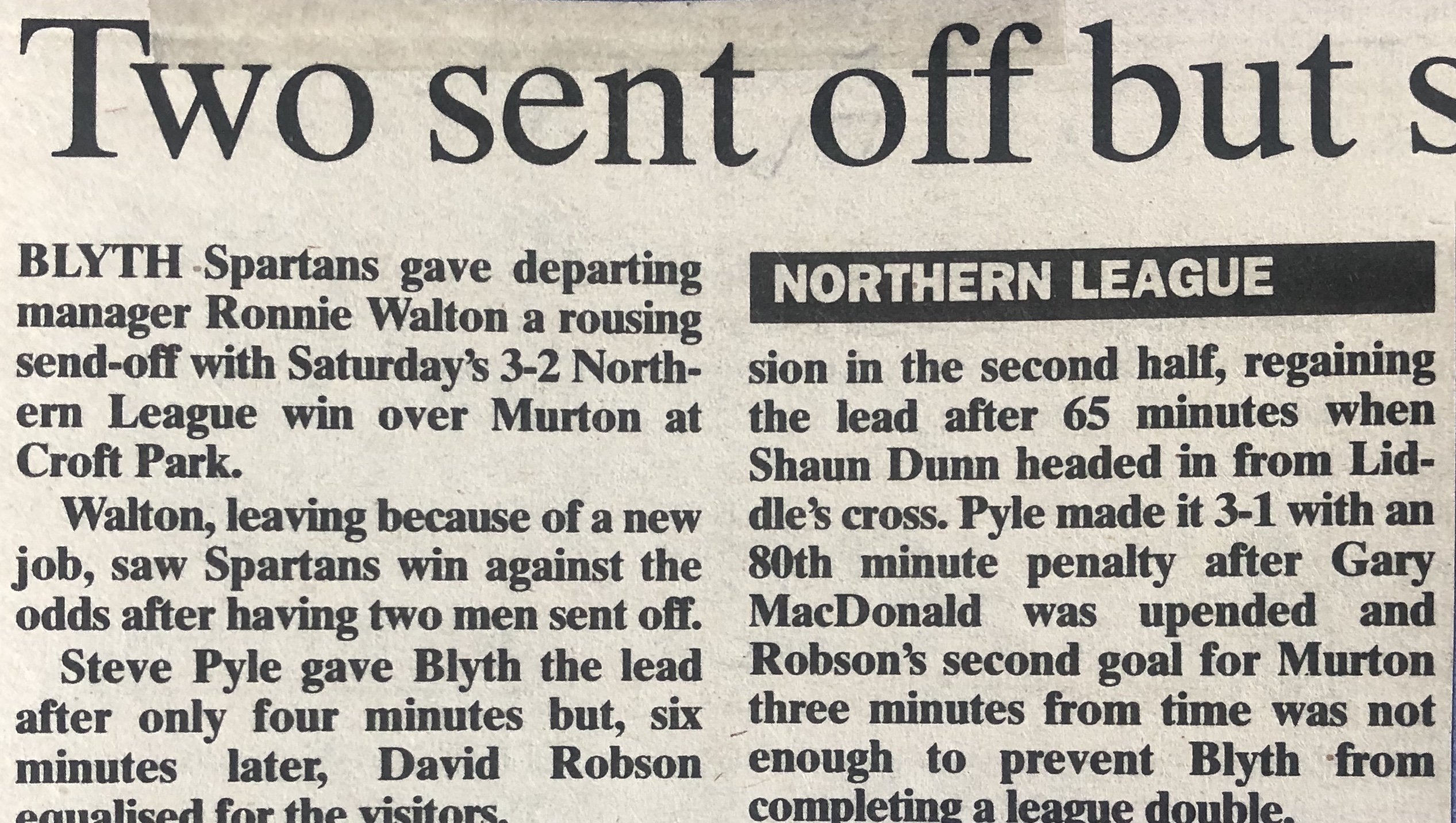
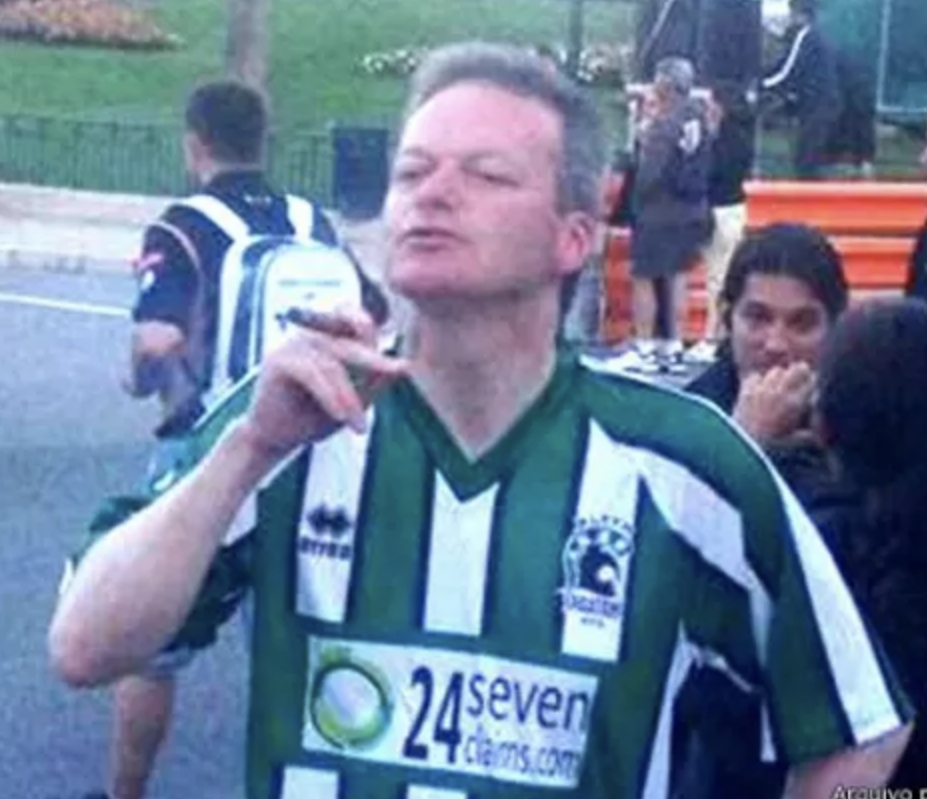
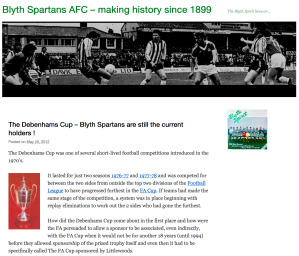



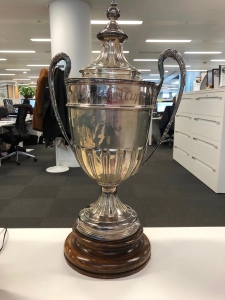
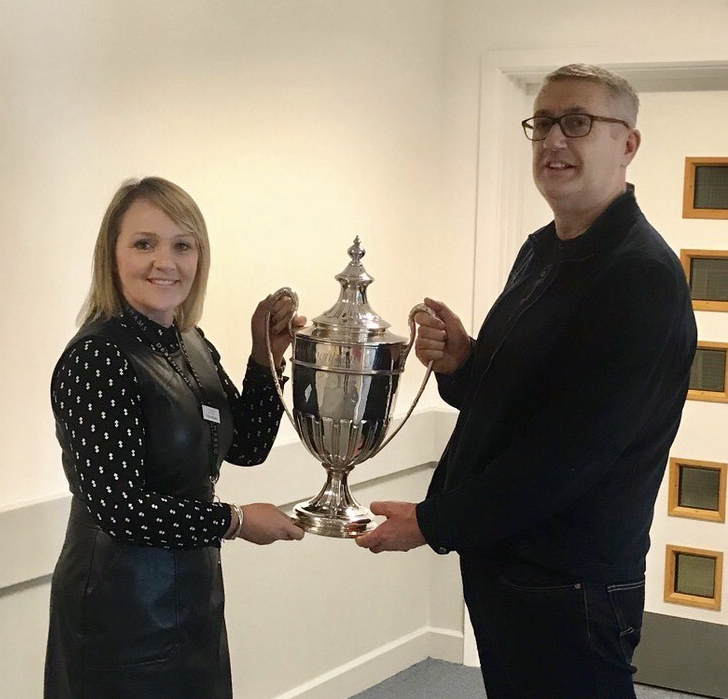
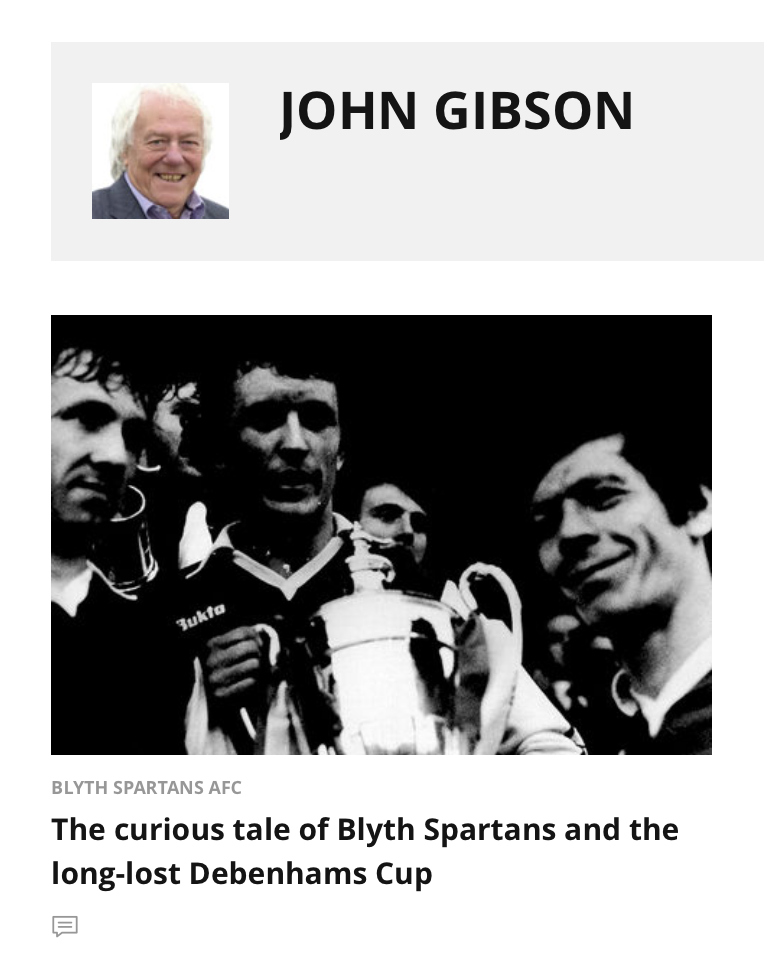 th East Footballer writer, John Gibson picked up on the trophy’s reappearance.
th East Footballer writer, John Gibson picked up on the trophy’s reappearance.

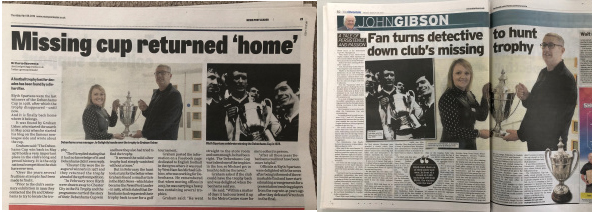
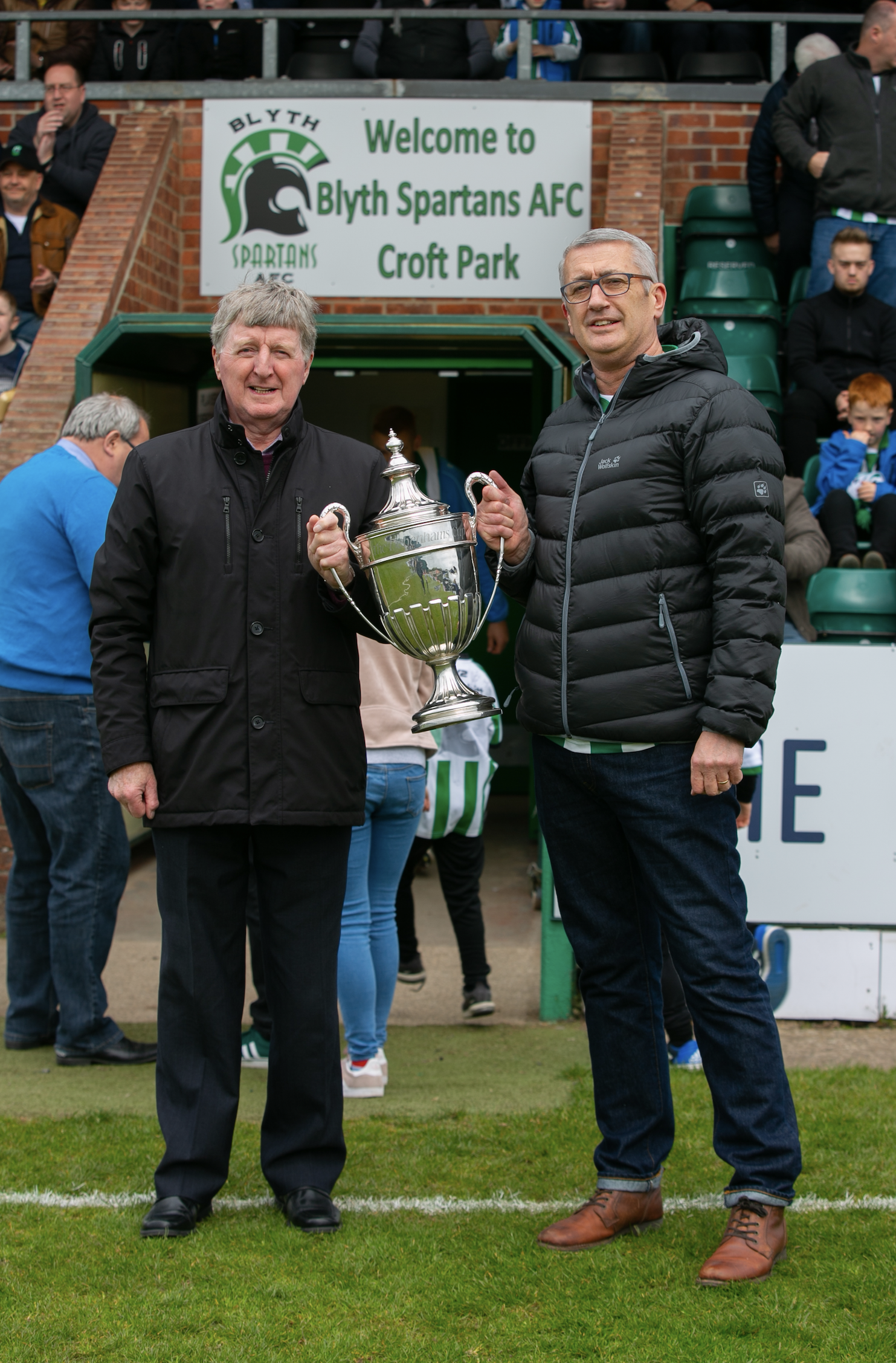
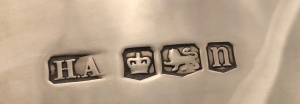
 Having a London office led to them supplying cutlery and silverware to Debenhams from 1928 onwards. In 1930 they were tasked with producing the trophy, however there is no record of why it was originally commissioned or its use in the intervening years.
Having a London office led to them supplying cutlery and silverware to Debenhams from 1928 onwards. In 1930 they were tasked with producing the trophy, however there is no record of why it was originally commissioned or its use in the intervening years.